- +91-7579161064
- [email protected]


20 Most Beautiful Images of Kedarkantha Trek
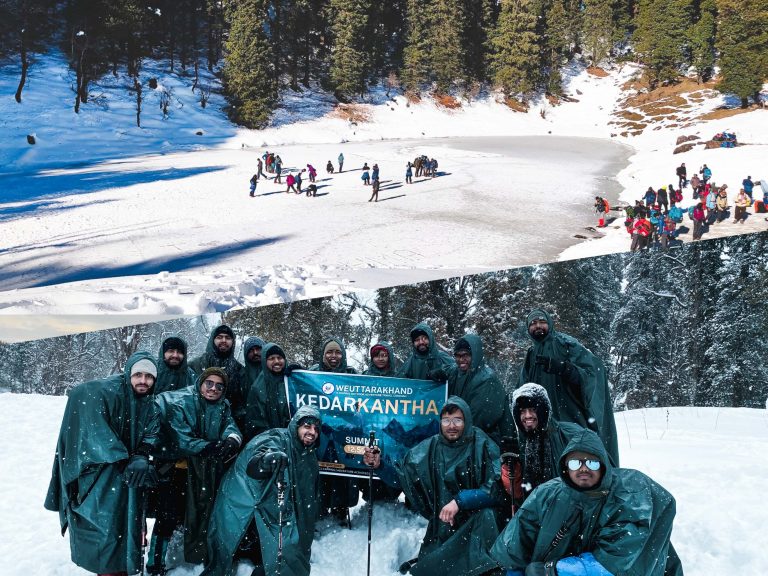
Kedarkantha Trek Photos/images: Kedarkantha Trek is one of the most beautiful winter trek in Uttarakhand. It is a snuggly retreat beautifully concealed in the heart of Uttarakhand. Base Camp of Kedarkantha Trek ‘Sankri’ is famous for offering trekking and camping expeditions to the novice travellers, who like to taste the flavour of Himalayan air. If you haven’t been here, then you have missed one of the best experiences you could ever have in your life. Visiting here is not only cheap but the peaceful surroundings of Kedarkantha Trek will elate your heart to a thousand fold.
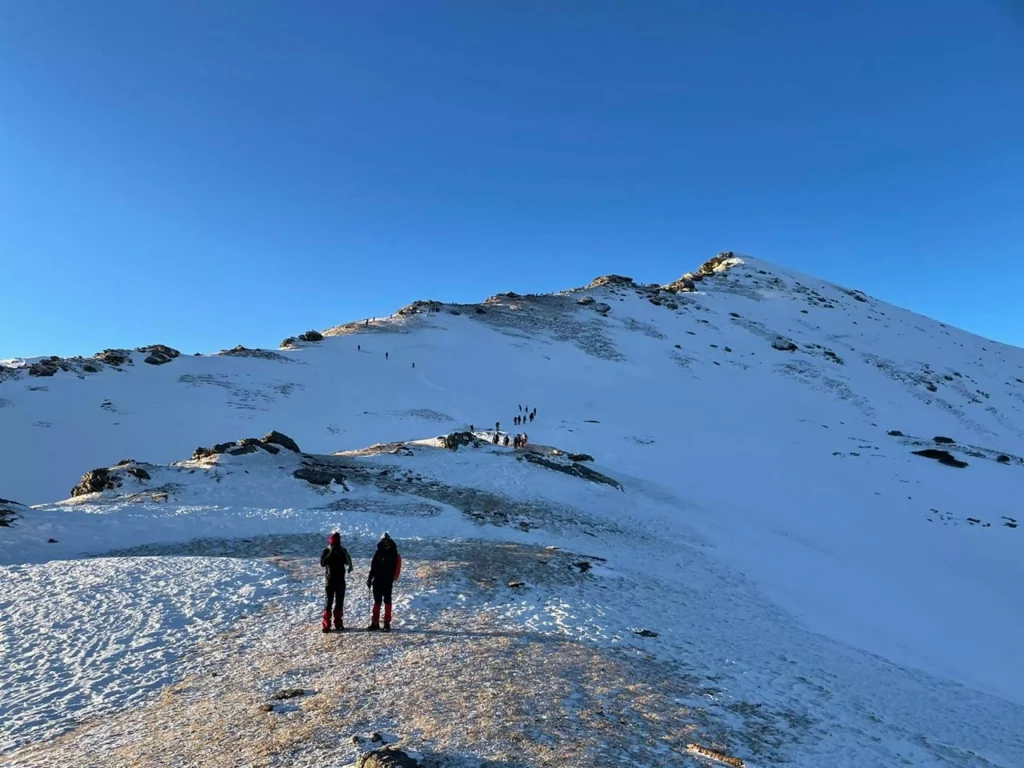
The Kedarkantha trek covers a total distance of approx 20 Km distance in four days, making it a beautiful and adventurous way of spending a peaceful time away from hustle-bustle of city life. During the trek we cover some serene locations like Sankri village, Juda Ka Talab and Kedarkantha base Camp to reach the Kedarkantha Summit. Sankri, base camp of many beautiful Himalayan trek in including Kedarkantha Trek, is almost 200 kilometres away from Dehradun. One can get car, taxi, bus to reach Sankri.
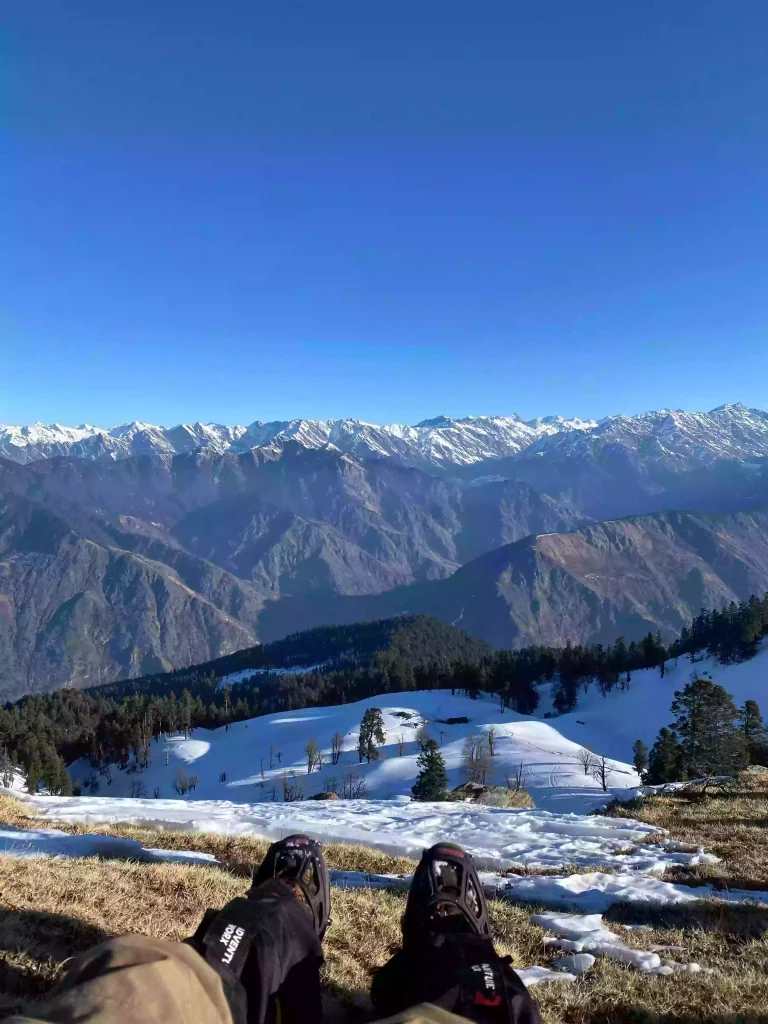
The actual trekking experience begins once you reach Sankri. The total trek distance from Sankri to the Kedarkantha peak (12,500 ft.) and back to Sankri is 20 kilometres. While you don’t need any prior experience to go on this trek, a small period of physical exercise is both, beneficial and advised for trekkers. Camping during the Kedarkantha Trek is dreamlike in the lap of the snow wonderland, and a absolute amzing experience on its own.
The drive to Kedarkantha is amazing as it cross many famous places like: Mussoorie, Kempty Falls, Naugaon, Purola Valley and Mori.. You’ll drive along Yamuna and Tons river, which are two of the famous rivers of Uttarakhand. Enjoy the scintillating views of the mountain Queen and feast your eyes on the warm hospitality and culture of Garhwal.
During Kedarkantha Trek vegetation goes dry from lush and coniferous as elevation rises. In the summer, temprature during the trek ranges between 20°C and 6°C. while in winter time, it can drop as low as -10 or -15 degrees. Kedarkantha Trek reamins covered in snow from December till March and April. In winters vast meadows of Kedarkantha remain dunked in snow.
During this period of time one can also try learning skiing here. Skiing in Kedarkantha winter trek is an adventurous experience of lifetime.
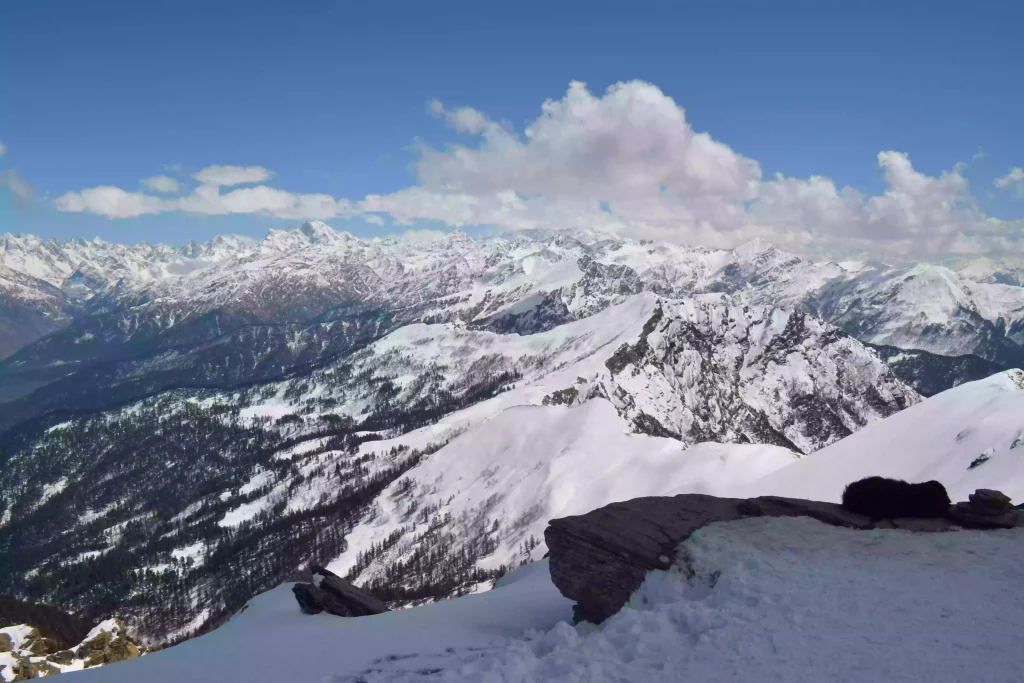
We are dead sure by now, you might be craving to check out Kedarkantha images, which place are we talking about. So ladies and gentleman treat your sore eyes on the sumptuous beauty of Kedarkantha Trek. Here we present you with- the Top 20 Kedarkantha Trek Images, a treat for your sore eyes.
Check out most beautiful Kedarkantha Trek Images Gallery:
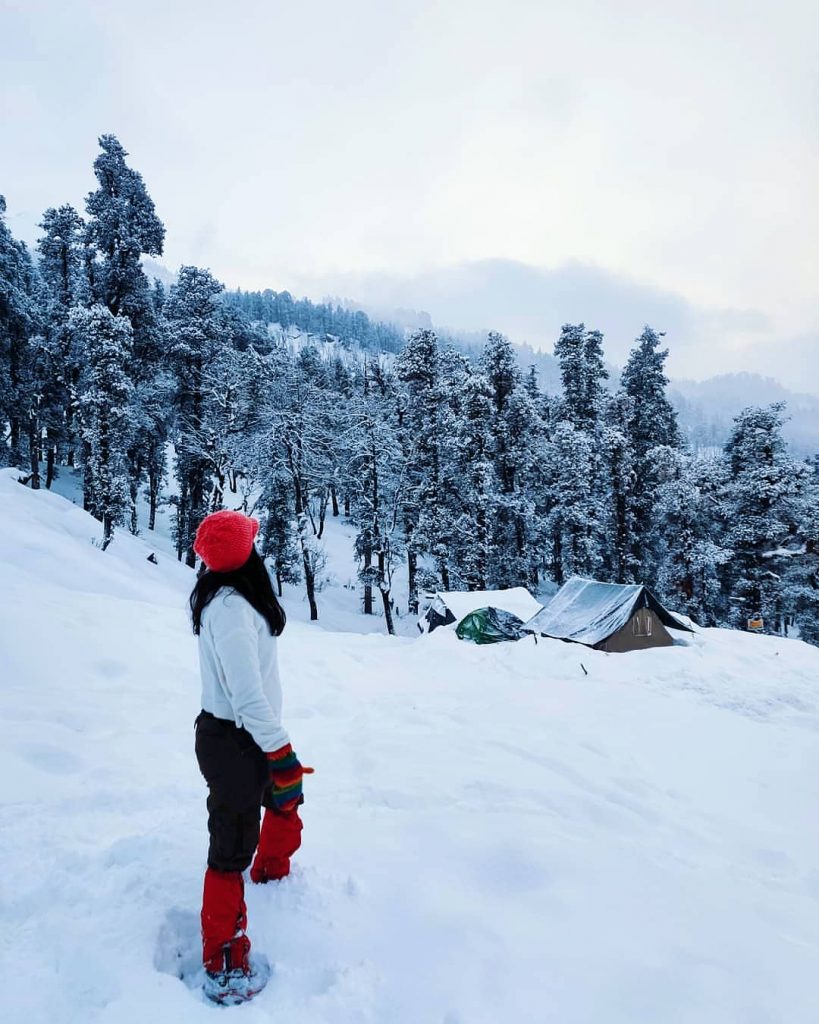
Kedarkantha Trek Images
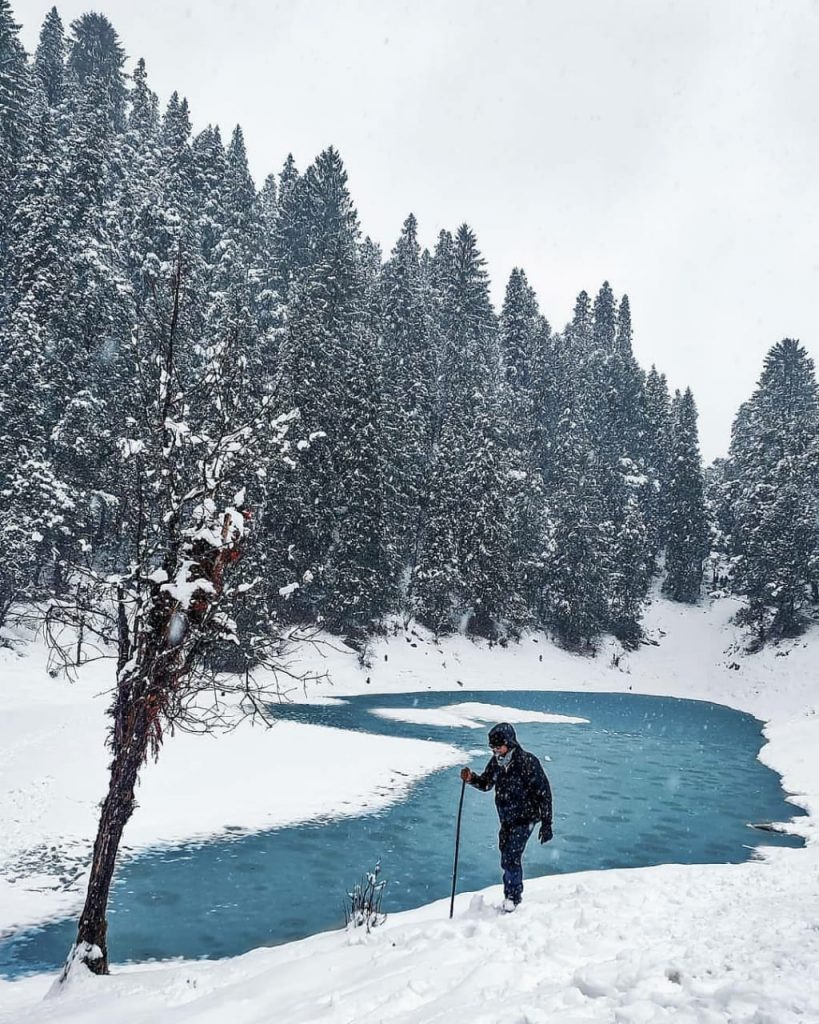
Kedarkantha Trek Images:
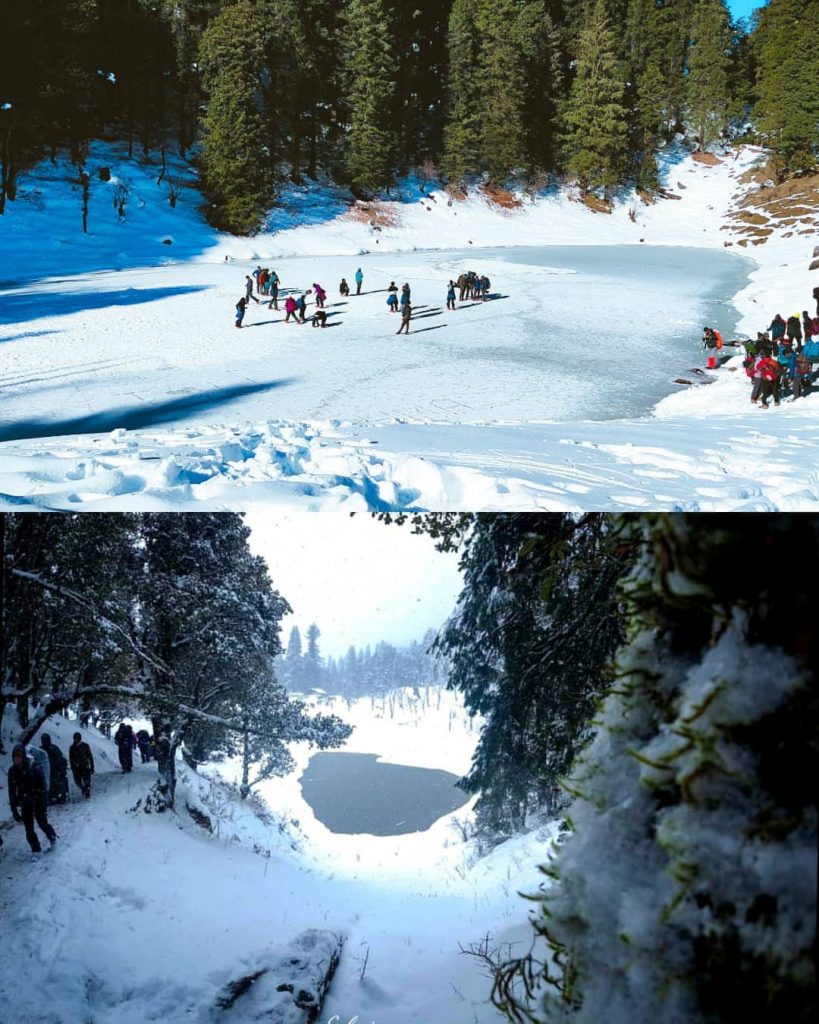
At a staggering height of 12,500 feet, where the air is thin and the heartbeats are loud, stands a symbol of pride and unity – the Indian flag. This captivating image, captured by the lens of @wanderlustejas, speaks volumes about the spirit of exploration and patriotism. As the tricolor flutters against the backdrop of the majestic Himalayas, it’s a reminder of the vastness of our nation and the heights we can achieve when we unite in passion and purpose. This photograph isn’t just about reaching the summit; it’s about carrying with us the essence of India, no matter where our journeys take us.
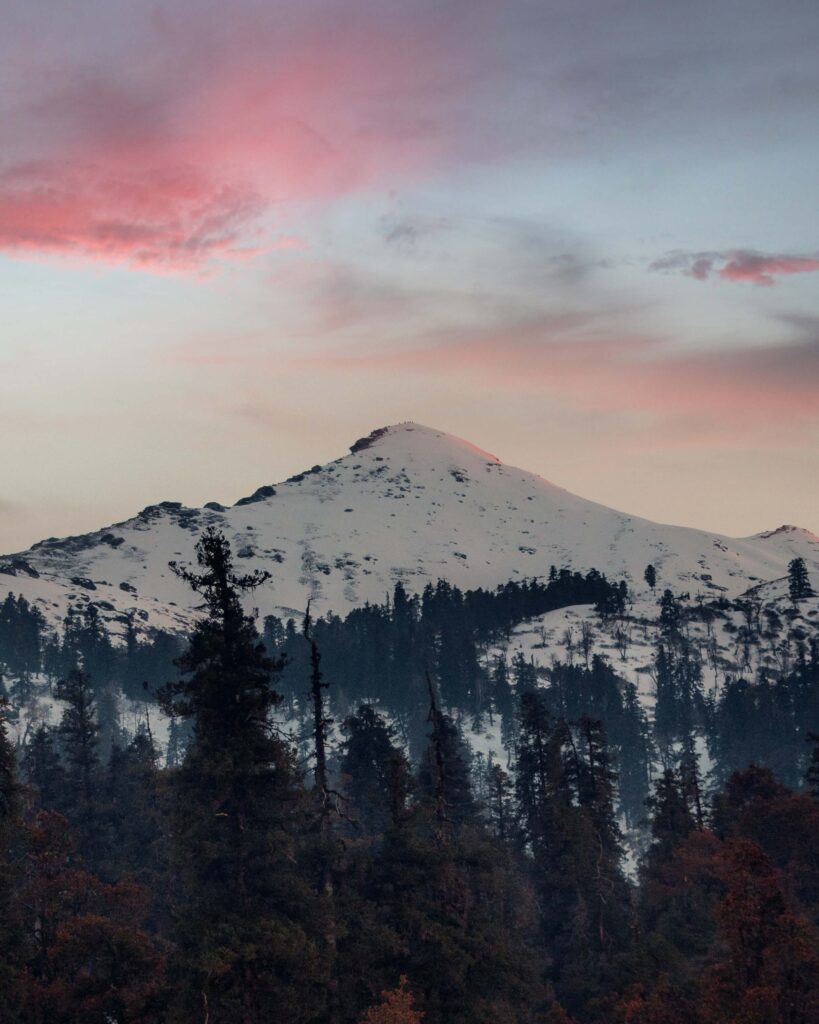
Gazing upon Mayur V Bhat’s capture of the sunrise from Kedarkantha Peak is like embracing a symphony of colors, serenity, and wonder. The way the first light of dawn pierces through the velvety darkness, casting a golden hue over the pristine snow and painting the skies in shades of amber, pink, and violet, is nothing short of magical. This photograph is not just a visual delight; it’s a moment frozen in time, echoing the stillness of the world at daybreak and the promise of new beginnings. As you lose yourself in its beauty, let it remind you of the unparalleled rewards that come from scaling peaks, both literally and metaphorically.
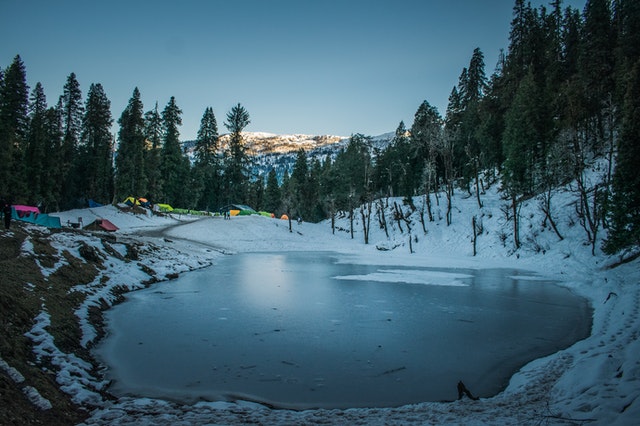
Amidst the winding trails of the Kedarkantha Trek, lies a sight that can make one’s heart skip a beat – Juda Ka Talab. In this breathtaking photograph captured by the talented Sanket Barik, we are offered a glimpse of this serene Himalayan lake, frozen in time. The silvery sheen of the ice contrasts beautifully with the surrounding snow-draped trees, painting a scene straight out of a winter fairy tale. As you gaze upon this masterpiece, it’s almost as if you can feel the crisp mountain air and hear the muted sounds of nature, echoing in the vast silence of the frozen expanse. A testament to both the beauty of Kedarkantha and the skill of the photographer.
Kedarkantha Trek: Photos/Images/Gallery
Uttarakhand, often referred to as the ‘Devbhoomi’ or ‘Land of the Gods’, is not just a place; it’s an emotion, a feeling, a tale waiting to be told. Nestled amidst its ethereal landscapes is the Kedarkantha Trek, a gem that brings together the beauty of snowy peaks, verdant meadows, and the simple life of the villages dotting its trail. While words often fall short of capturing the sheer majesty of this trek, pictures can do justice, offering a window into the heart of this mesmerizing journey.
We, at WeUttarakhand , have always believed in not just exploring the unseen but also in sharing the stories of our escapades with fellow wanderers. In this article, we’ve curated an exquisite collection of photographs from the Kedarkantha Trek, each one narrating a unique tale of nature, adventure, and camaraderie.
You might wonder, what makes the Kedarkantha Trek so special? Why do people from all walks of life and corners of the world come to experience it? It’s the way the first rays of the sun kiss the snowy peaks, the thrill of making your way through thick pine forests, and the warmth of a campfire amidst the cold mountain air. It’s about the challenge, the friendships forged, and the memories created.
But more than that, it’s the personal journey each trekker undertakes – the inner reflections, the overcoming of physical and mental barriers, and the sheer joy of standing atop the Kedarkantha peak, realizing the vastness of the world and the tiny, yet significant place we hold within it.
As you scroll through these Kedarkantha Trek photos, we invite you to not just see, but feel. Dive deep into each image, let it transport you to the high-altitude realms of Uttarakhand, and join us, even if just virtually, in this unforgettable trekking adventure. So, lace up your imaginary trekking boots, wrap yourself in a cozy mental blanket, and come explore the Kedarkantha Trek with us – through the lens of our experiences and the heartbeats of our adventures.
Want to get featured on our blog DM us your pictures on Instagram @weuttarakhand
Kedarkantha Trek Images – Pictures – Photos

Did not find what you are looking for? No worries!
Fill the form and get a callback from our travel experts
WeUttarakhand is Uttarakhand based leading Tourism and News/Media Company. We have around 5 lakh+ audience base all over the social media. Our Travel and Adventure packages are planned and organised by the best in the industry by keeping in mind the client’s comfort and saftey.
Populor Treks
- Kedarkantha
- Tungnath-Chandrashila
- Gulabi Kantha
Important Links
- Privacy Policy
- Address: Lane No. 5, Alaknanda Enclave, Nakraunda, Balawala, Dehradun, Uttarakhand 248008
- Contact Number: +91-7579161064 | 9557711931
- email: [email protected]
© All rights reserved to WeUttarakhand Group.
Made with ❤ in Uttarakhand
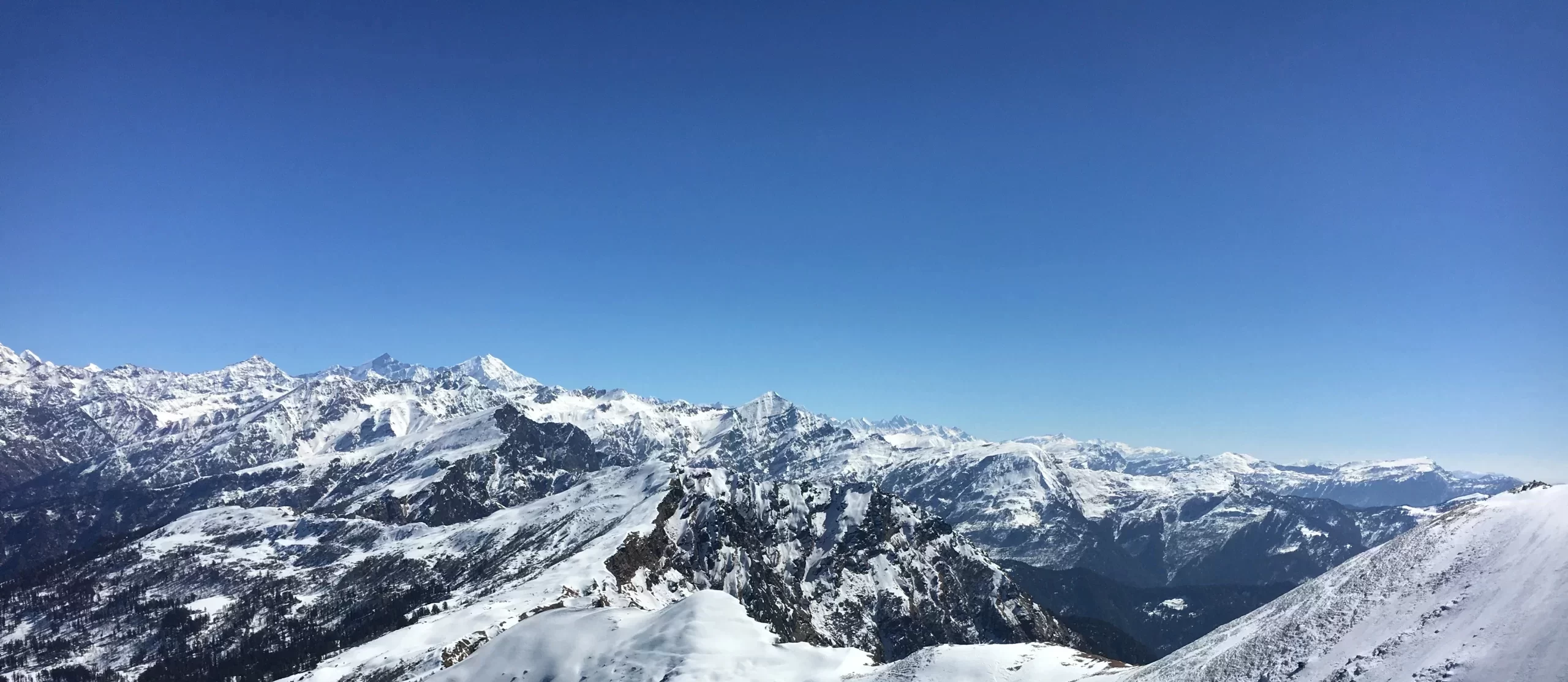
Kedarkantha Trek
The most popular winter trek in india, rated 4.9/5.0 on tripadvisor. 837 reviews, customize your himalayan trip or join our fixed departures, kedarkantha trek overview, the meaning of "kedarkantha", best time to visit kedarkantha trek.
Kedarkantha Trek from September to November months
Kedarkantha trek from december, january, february, march.
Kedarkantha Trek from April to June
About Sankri, the Kedarkantha Trek base
Juda ka talab.

The frozen Juda ka Talab lake.
Kedarkantha Base Camp
Kedarkantha trek difficulty level, kedarkantha trek route map:.
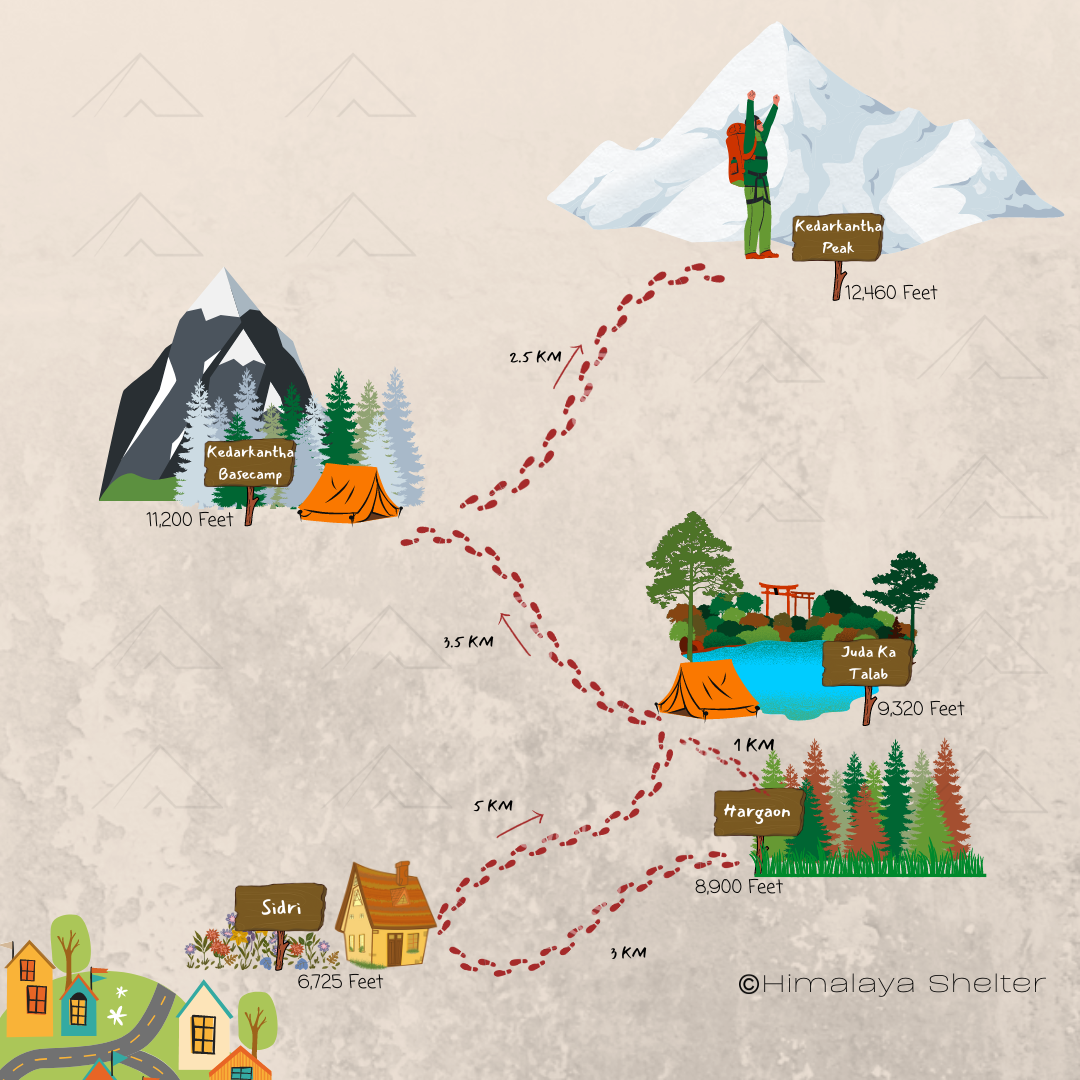
Kedakantha Reviews
Kedarkantha Trekking Itinerary
Day 1 dehradun to sankri (1,920 m): 187 km drive in 8 hours.
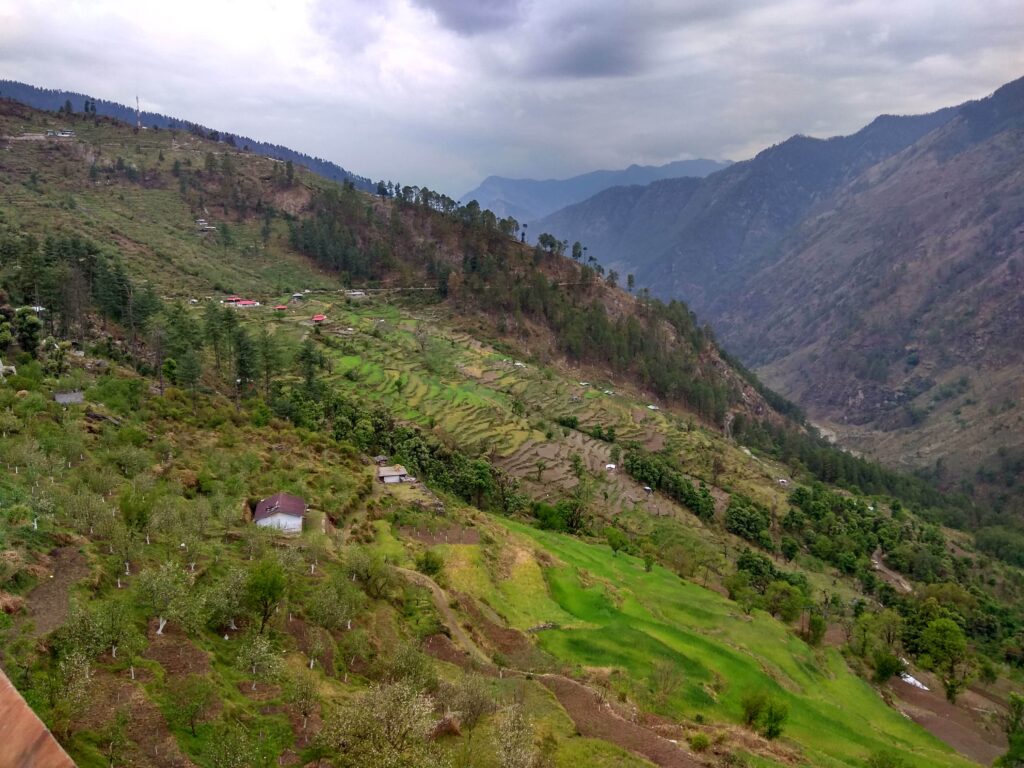
The drive from Dehradun to Sankri takes you through picturesque towns and villages like Mussoorie, Nowgaon, Purola, and Mori. The route is scenic and takes you through a dense pine forest, filling the air with the sweet aroma of pines. After driving through the forests, you’ll reach Mori, where the Tons River joins you on the route. The Tons River is the biggest tributary of Yamuna and is well-known for rafting activities. The 190 km long drive typically takes 8-9 hours to complete, so it’s advisable to start early to reach Sankri by evening. You’ll spend the night at a guesthouse before starting your hike the next day.
Day 2 Sankri to Juda Ka Talab (2,774 m): 4 km trek in 3 to 4 hours
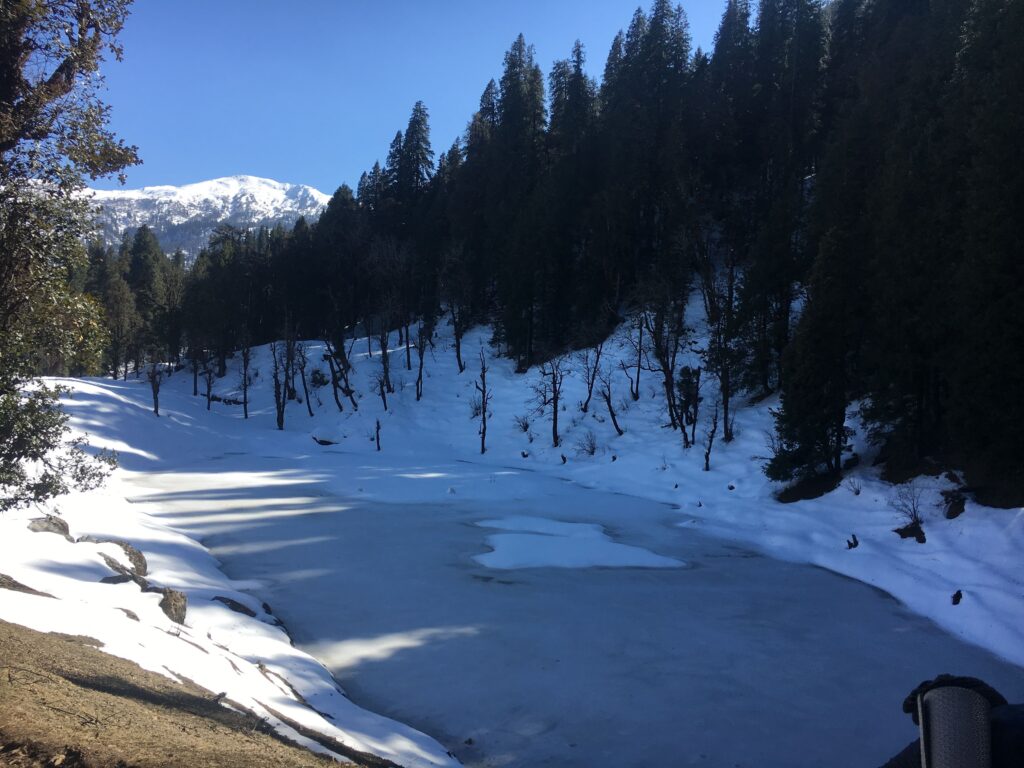
We start our trek towards Juda Ka Talab early in the morning after breakfast from Sankri. The trek is an eventful one as we pass through local villages, such as Saud, and encounter kids heading to school and women starting their daily chores. The trail takes us through a dense pine forest, which gradually steepens until we reach a ridge. After walking on the ridge for a while, the trail evens out and widens. The thick forest provides a cool environment, shielding us from the sun’s heat. Finally, we reach the famous Juda Ka Talab, a small lake adorned with three floating landmasses. We camp by the lake, savoring a starry dinner.
Day 3 Juda Ka Talab to Kedarkantha Base Camp (3,429 m): 4 km in 3 hours
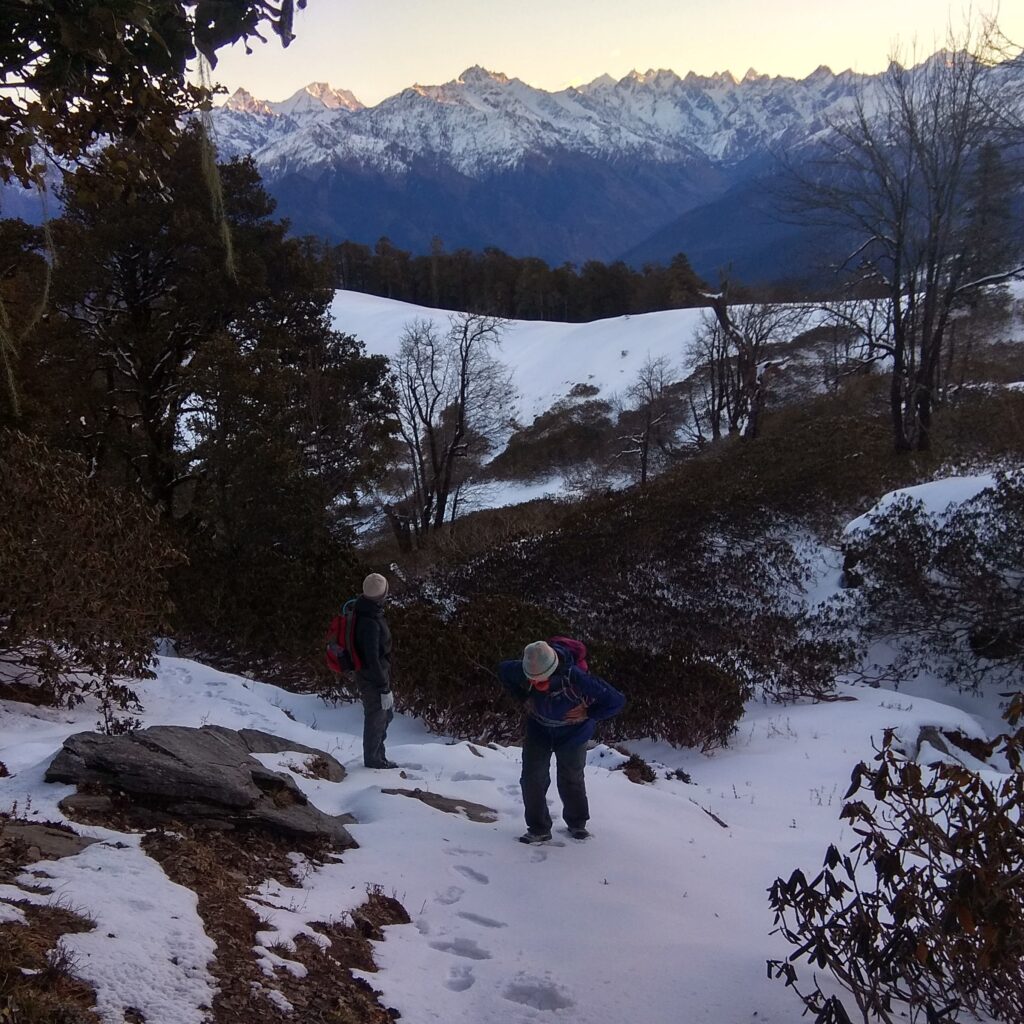
From Juda Ka Talab, the trail leads deeper into dense pine forests until reaching a meadow with shepherd’s huts. Climbing further for another thousand feet, trekkers will finally reach the Kedarkantha base camp, taking around 2-3 hours to complete. The trail from Juda Ka Talab to the base camp is incredibly stunning, providing an ideal setting for photographers and nature enthusiasts alike. Despite being a bit colder due to the lack of insulation, the base camp offers panoramic views of the famous peaks of Uttarakhand, making it an ideal spot for camping.
Day 4 Kedarkantha base camp to Kedarkantha Summit (3,810 m) and back to Hargaon (2,713 m): 8 km in 5-6 hours
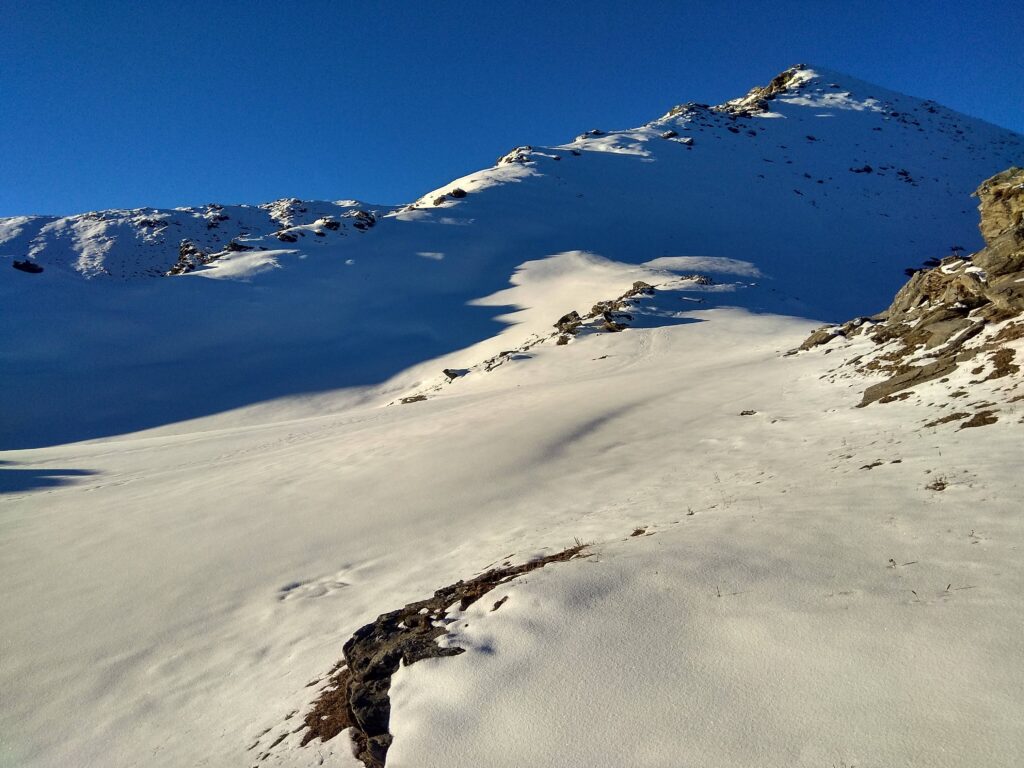
Day 4 is the day you’ve been waiting for! The trek to the summit from the base camp is not long, and upon reaching the top, you’ll be rewarded with a jaw-dropping 360-degree view of the Uttarakhand peaks, the Chaainsheel Pass, and the Kailash ranges of Himachal. You can even see the Har Ki Dun valley below. The Kedarkantha summit is marked by an arrangement of stones with a Trishul pointing to the sky. Legend has it that the peak was meant to be the original Kedarnath temple, but Lord Shiva, who was disguised as a cow hiding from the Pandavas, was disturbed during meditation by the villagers. The interruption made him change his location to the present Kedarnath temple.
After spending time on the summit, we hike back to the base camp and head towards Hargaon (2 km trail) post-lunch. Hargaon is a large camping area en route to Sankri, where we will spend the night before bidding farewell to this beautiful place.
Day 5 Hargaon to Sankri: 4 km trek in 2 to 3 hours
Today is the final day of our trek and we will descend from Kedarkantha to Sankri, which is a 4 km trek taking 2-3 hours. Once we reach Sankri, you can take the rest of the day to explore the charming village and nearby villages like Gangad and Osla, which are known for their warm hospitality and traditional Pahari culture. Sankri is also the last road head to the Govind Balabh Pant Wildlife Sanctuary.
Day 6 Sankri to Dehradun: 187 km drive in 7 to 8 hours

Going back home is always a bittersweet moment, but the journey is made easier by taking the same picturesque road back to Dehradun. As we leave behind the dense pine forests and descend towards the city, the landscape slowly changes and opens up into wider roads. Finally, we arrive in the bustling city, bidding farewell to the serene mountains and valleys of Uttarakhand.
Day 2 How difficult is the trek & what are the challenges?
Kedarkantha trek photos:.

Upcoming Treks
- November 2, 2024 open
- November 3, 2024 open
- November 9, 2024 open
- November 10, 2024 open
- November 16, 2024 open
- November 17, 2024 open
- November 23, 2024 open
- November 24, 2024 open
- December 1, 2024 open
- December 2, 2024 open
- December 3, 2024 open
- December 4, 2024 open
- December 5, 2024 open
- December 6, 2024 open
- December 7, 2024 open
- December 8, 2024 open
- December 9, 2024 open
- December 11, 2024 open
- December 12, 2024 open
- December 13, 2024 open
- December 14, 2024 open
- December 15, 2024 open
- December 16, 2024 open
- December 17, 2024 open
- December 18, 2024 open
- December 19, 2024 open
- December 20, 2024 open
- December 21, 2024 open
- December 22, 2024 open
- December 23, 2024 open
- December 24, 2024 open
- December 25, 2024 open
- December 26, 2024 open
- December 27, 2024 open
- December 28, 2024 open
- December 29, 2024 open
- December 30, 2024 open
- December 31, 2024 open
FAQ's about Kedarkantha Trek
What is the best time for kedarkantha trek.
The best time to visit Kedarkantha:-
The Kedarkantha trek is feasible for most of the year, except during peak monsoon season. Although there may be temporary halts due to heavy snowfall for 2-3 days on average during late December or early January. The trek can still be attempted during the peak winter season, from December to mid-February, when the snowfall is at its highest. The Kearkantha trek best time is from January to March. The Juda Ka Talab Lake freezes over during this period, creating a surreal experience for trekkers. However, campsites can be extremely cold during this time, and the number of trekkers starts to decrease from the second week of January. For a more solitary experience, plan your trek in late January or February for less crowded trails with ongoing snowfall.
The trek is equally beautiful in the summer months of May and June, and in September when the flora is in full bloom. You can also combine the Kedarkantha trek with the Phulara Ridge trek for a unique and unforgettable experience during the summer season.
What are the things to carry for trek to Kedarkantha peak?
Kedarkantha Peak in Winters:-
Adequate Clothing Includes –
- Appropriate Base Layers – i.e. Warmers (avoid cotton warmers/inner wear and choose synthetic or woolen base layers)
- Warm Layer including One Padded or Down Jacket and a fleece or sweater
- A Thin waterproof jacket to protect from Snow, Rain, or wind (Alternatively you can carry a waterproof warm jacket such as a Snow Hiking Jacket which serves the purpose of being warm and waterproof both)
- Two Synthetic Trek Pant/Lowers (avoid jeans, cotton lowers)
- Waterproof Pants (Optional, if using gaiters)
- 1 Warm lower (preferably fleece) for overnight wearing in camp
Equipment & Protective Clothing such as
- Waterproof and Warm Gloves
- Trekking Pole
- Micro Spike (Provided by us)
- Gaiters (Provided by us)
- Woolen Cap/ Scarf
- Neck Gaiter/Balaclava
- Sunglasses (Preferably Polarized if trekking in winter)
- Waterproof High Ankle Shoes
- 3-4 pairs quick drying socks
- 1-2 pairs of woolen socks
- Quick Drying Towel
What is Kedarkantha trek height?
The Kedarkantha altitude is approximately 12,460 feet above sea level.
What is the difficulty level for Kedarkantha trek?
The Kedarkantha trek is a short but steep trail, making it an easy to moderate difficulty trek. However, during winters, the trail can be challenging due to the presence of snow and sub-zero temperatures from the Juda Talab campsite onwards. Adjusting to the extreme cold can be tough for those who are not used to it. Additionally, there are certain sections of the trail with verglass formations, which can make it difficult to walk. It is highly recommended to use Micro Spikes and Trekking poles to navigate these sections.
On the other hand, the trek is easier during summers and autumn, as the trail is less steep and temperatures are pleasant. If you are looking for a unique experience, you can consider combining the Kedarkantha trek with the Phulara Ridge trek.
Why trek with Himalaya Shelter?
“ I have been doing treks with Himalaya Shelter for the last two years and they are awesome people with pure humbleness. “
Writes Priyesh.
We at Himalaya Shelter consider our trekkers part of our community, a family of sorts and really understand the efforts that you put into taking that much-needed break and setting off to the mountains. Some of you may wait for months and even a year to plan out that perfect excursion. That’s why we want it to be “a perfect excursion” for you.
Our testimonials (read below) are a testament to our service-oriented mindset.
We take safety into great consideration and ensure our team is trained to handle emergency situations.
For a better experience, we provide accommodation on Twin Sharing throughout the trek. With most trekking operators you would get triple or even quad sharing accommodation.
Our Accommodation will have attached washrooms
(In Sankri on 1st and 5th Night)
Furthermore, we provide the essential safety gear for your trek – – Crampons – Gaiters Without any additional charges.
We pamper you with great food which keeps you going on the trek. (On our google maps out of 300 reviews over 80 Trekkers mention great food😋)
We do not outsource services to ensure topmost quality throughout your journey. We use our own fleet of Vehicles to ferry you to the base camp and return.
Lastly, being a local operator we are direct stakeholders in the economic and social development of Uttarakhand. Employing locals and helping them progress in their lives goes hand in hand with work. Thus choosing Himalaya Shelter, is a step in helping us help locals progress by ensuring financial independence and social progress.
What will be the pickup point and pickup time from Dehradun on Day 1?
The trek pickup point will be near Dehradun railway station. The exact location will be shared with you prior to departure day.
The departure time remains 7 AM sharp for every group departure.
Trekkers arriving by Flight should ideally arrive 1 day in prior. The Airport (Jolly Grant) is situated at least 1 hour drive away from Dehradun Railway Station in the opposite direction. If you’re arriving by flight it is thus advised to travel a day prior due to lack of early morning flights.
When snowfall starts in Kedarkantha?
Snowfall in Kedarkantha typically starts in late November or early December and continues through the winter months until February.
What is Kedarkantha trek starting point?
The Kedarkantha trek’s starting point is Sankri, a picturesque village located in the Uttarkashi district of Uttarakhand, India.
Is Kedarkantha trek safe in January?
Yes, the Kedarkantha trek in January can be safe, but it also comes with certain challenges due to the winter conditions. The weather can be extremely cold and snowy, so it’s crucial to be cautious and informed before attempting the trek in January.
What is Kedarkantha to kedarnath distance?
The Kedarkantha to Kedarnath distance is approximately 396 kilometers. This distance includes 360 km of driving and 26 km of trekking.
- Kedarkantha summit to Sankri trekking:- 10 km
- Sankri to Gauri kund driving:- 360 km
- Gauri kund to Kedarnath:- 16 km
What is the lowest temperature in Kedarkantha?
The lowest temperature recorded in Kedarkantha was around -12°C (10°F).
What is Kedarkantha Trek route?
The Kedarkantha trek typically starts from the Sankri village to Juda Ka Talab. It is about 4-5 km. From Juda Ka Talab to Kedarkantha Base Camp, it is around 4-5 km. The trail leads through meadows with panoramic mountain views. Then, Kedarkantha Base Camp to Summit is roughly 6-7 km. And finally, Hargaon to Sankri is about 4-5 km. The total trek distance is approximately 20-24 km.
What is the Kedarkantha trek cost?
The Kedarkantha trek price is influenced by various factors such as the time of year, trek duration, group size, and preferences in accommodation and services. You can expect a budget between INR 6,000 and INR 12,000 per person for a 4-5 day trek.
This cost typically covers:
- Transportation to and from the trek’s starting and ending points
- All meals & Accommodation throughout the trek
- Trekking equipment like Kitchen tent, Dining tent, Toilet tent, etc
- Sleeping bags, Mattresses, Camping stools,
- Trekking permits and fees
- Services of an experienced trek guide and support staff
- Basic First Aid kit
Opting for a group trek is an alternative approach. It’s an effective way to cut down on transportation and accommodation expenses. Furthermore, certain operators extend discounts, catering to budget-conscious travelers.
How to reach Kedarkantha trek from Delhi?
The distance from Delhi to Kedarkantha is about 433 km. It takes about 11 to 12 hours of driving from Delhi to Sankri and 10 km of trekking from Sankri to Kedarkantha Peak.
There are three ways to reach the Sankri trek from Delhi.
Kedarkantha from Delhi by Road:-
Bus: Direct buses run between Delhi and Dehradun. They depart from the central bus station in Delhi and arrive at the main depot in Dehradun. Upon reaching Dehradun, you can board another bus that will take you directly to Sankri. After arriving in Sankri, you’ll need to start a 10 km trek to reach Kedarkantha Peak, a journey that typically spans 1 to 2 days.
Kedarkantha from Delhi by Air:-
To reach Kedarkantha from Delhi by air, simply catch a direct flight from Delhi Airport to Jolly Grant Airport in Dehradun. Upon arrival at Jolly Grant Airport, you’ll find a multitude of taxi services available at the exit, ready to take you to Dehradun. From Dehradun to Sankri drive takes around 7 to 8 hrs. Upon reaching Dehradun, you can board another bus that will take you directly to Sankri. After arriving in Sankri, you’ll need to start a 10 km trek to reach Kedarkantha Peak, a journey that typically spans 1 to 2 days.
Kedarkantha from Delhi by Rail:-

It’s recommended to opt for the overnight Kota Express, also known as Nanda Devi Express, departing at 11:50 PM, and arriving in Dehradun at 5:45 AM, aligning with other transportation schedules from Dehradun to Sankri.
How is the Kedarkantha trek route map?
How is the climate of kedarkantha in march.
In March, the weather in Kedarkantha is quite chilly. During the day, temperatures range from about 15 to 10 degrees Celsius, while at night, it can drop to about 10 to 5 degrees Celsius. Sometimes, there might be unexpected snowfall and strong winds. However, for the most part, the sky is clear and sunny, providing stunning views of the snow-covered mountains.
What is the distance of Kedarkantha summit from Sankri basecamp?
The Kedarkantha summit is only about 10 km from Sankri and can be covered in approximately 6 to 7 hours. Most trekkers complete this distance of 10 km in two days, with a daily distance of 4 to 5 km.
Is Kedarkantha trek open in December?
Yes, you can go for the Kedarkantha trek in December. It’s a popular winter trek in India. From December to March, the trek is all covered in snow, making it very special.
But, it can be a bit hard, especially if you’re new to trekking. Kedarkantha weather in December might suddenly change, and there could be a lot of snow and strong winds. The paths can also be slippery.
If you’re thinking of going on this trek in December, it’s really important to be well-prepared and go with a good trekking group. Bring warm clothes, strong shoes, and other things you’ll need for trekking.
How to reach Kedarkantha from Dehradun?
To get to Kedarkantha from Dehradun, first, you need to reach Sankri. Once you arrive in Sankri, begin the trek to Kedarkantha summit, which is approximately 10 km away from Sankri.
How to Reach Sankri from Dehradun :-
Every morning, a limited number of shared cabs and buses depart for Sankri from the vicinity of Dehradun Railway Station.
Govt. Buses and Private Buses-
Only one government bus departs from Dehradun Railway Station to Sankri at 8:00 am. Additionally, two private buses leave around 7:00 am from just outside the Dehradun Railway Station heading to Sankri town. The fare for this journey is approximately Rs. 400 per person, which is roughly the same for both the government and private buses.
Private Cab or Taxies-
You can easily locate shared taxis near Hotel Milan or Hotel Grand, merely a 2-3 minute walk from Dehradun Railway Station. These taxis operate up to Purola, which is 54 kilometers away from Sankri. The journey lasts approximately 5 to 6 hours, with a fare of Rs. 400.
From Purola, you’ll find shared cabs to take you directly to Sankri. However, it’s crucial to bear in mind that these cabs typically depart before noon. Hence, plan to reach Purola in the morning if you choose this route . The cab fare from Purola to Sankri ranges from 200 to 300 rupees. (This fare is applicable only when the taxi is full of passengers; otherwise, the cost may vary based on the number of participants.)
In case you miss the buses or taxis from Dehradun for any reason, or due to personal preference, you also have the option to book a private taxi from the same location or near Prince Chowk, approximately 100 meters away from the Railway Station. This would amount to approximately Rs. 6,000 to Rs. 7,000 for booking a Maxx or Bolero.
Shared or Private Vehicle arranged by Himalaya Shelter-
Himalaya Shelter offers both shared and private transport services directly to Sankri for trekkers. Please note that for shared vehicles, we have fixed departure dates, and it is advisable to book your seats at least a week in advance of the departure from Dehradun. We also offer pickup and drop facilities for your hotel stay in Dehradun.
What is the best time to do the trek and how is the weather?
What are the top highlights of the trek, 45 reviews for kedarkantha trek.
Riona Dagli – March 18, 2021
This trek was the best one i have gone for till now. Himalaya Shelter was perfect with everything. go for it
Akanksha Rautela – March 28, 2021
I did the Kedarkantha Trek with Himalaya Shelter in March 2021. The experience was amazing, with breathtaking views at the summit. Our trek guide Deepak was amazing , he guided the group well , navigating us through the difficult stretches with ease.
Raunak – March 29, 2021
My friend and I went to Kedarkantha in peak winters to experience the best of the snow trail. Thanks to Himalaya Shelter, it could not have been any better. All the facilities, from Dehradoon to the summit and back, were very well managed and coordinated.
The entire team, from the back-end team, drivers, cooks, guides to Bacchan sir himself, were so supportive and high-spirited, always there to help in whatever way they could. Like, one time, we had an issue with our tent, and the team immediately came to help and provided us with another one. Since our group finished the trek before time, we decided to come back to Sankri a day prior, and despite the short notice and lack of accommodation, they arranged for alternate rooms for us without complaining. From motivating us to finish the summit climb to looking after our smallest of needs- they made the trip very comfortable. It was a delight to see Bacchan Sir, as humble as he is, to travel with the mules to ensure the safety of our luggage.
Their passion and dedication reflected in their work. Perhaps, that’s why we could enjoy ourselves so much. Special thanks to our guides, Rishabh and Vinay, who made the trek less tiring and more fun with their amazing experiences and conversations. They were both absolutely wonderful!
The food was served hot and fresh; we especially looked forward to enjoying the evening tea and snacks with a view. the gears and trekking equipment (tents, headlights, crampons, etc.) were all in great shape.
As for the summit, you have to go there and experience it yourself to understand just how breath-taking the view from above is. And oh, the slide down on the way back is an absolute winner- my favourite part of the trip!
A few tips I wish to share from my experience would be:
1. The summit climb takes times, patience and perseverance but try and reach the top before sunrise. It is absolutely breath-taking (in every sense). 2. Carry light. Irrespective of whether you carry your luggage or the mules, don’t take more than two pairs of clothes. Especially in winters because you will hardly have the time or energy to change. 3. Sometimes, at the summit, due to the temperature, phones’ batteries freeze. See if you can carry a light-weight camera as an alternate. 4. Try and keep your shoes dry at all times. Often after playing in the snow, shoes and socks would get wet. Based on our guide’s amazing hack: stuff toilet paper in them and leave them to dry. 5. The toilets might be a little inconvenient for first-timers as there are only dry toilets. The only tip for this would be to be mentally prepared and carry tissue rolls. For girls on their periods: carry disposable bags and bring your sanitary waste with you (yes, it might sound gross) but don’t dispose it in the pit.
We thoroughly enjoyed our experience with the company and could not have had a better trip. Eagerly waiting to have more such experiences with Himalaya Shelter!
Sharat K – March 30, 2021
Kedarkantha trek i have done along with my friends and I could say Himalayashelter people made us to remember the trip forever by giving utmost facility and support throughout the trek since from beginning to Sumit. Trek made me to understand that life outside social media is much more beautiful than what we think 🤗 so take your time and explore India
Prachi – April 15, 2021
Kedarkantha was our (Me and my friend) first trek. Initially, we were quite underconfident thinking will we be able to complete it or not. But hats off to Himalaya Shelter for providing us with the best food, accommodation and overall arrangements through out. And special thumbs up for our guide, Deepak Kanojiya sir for being patient and fun, both. They treated us like family and our every need was taken care of. From our safety while we trek to motivating us when we thought we won’t be able to complete it. Kedarkantha is a beautiful and a must visit. Looking forward to more such amazing memorable treks with Himalaya Shelter and our guide. 10/10.👏❤
Abhishek Mahajan – November 1, 2021
Kedarkantha is my one of the favorite treks in Himalayas. Its very difficult to arrange all the things like food, Stay , Tents, Accessories at this altitude and Himalaya Shelter did a wonderful job. A special thank to Bachan Rana sir and Shiva (Our Guide) for their guidance and support. Looking forward to many more treks with the team..
Dinesh Rathod – November 9, 2021
The Trek guide and the people who are all have been accompanies you to all the duration of trek are very nice and polite. Always supportive and motivates you to believe in oneself. And please listen to them carefully whatever they says to you about whole trek. Food is very homely. They give you as much as comfort they can provide on mountains. Best organized.
Sanjeev shri – November 22, 2021
I did Kedarkantha trek with Himalaya shelter. My experience with the team was excellent. The entire team is very professional and skillful (right from CEO to cook)…Trek lead Subodh ,Ast lead Gopi are passionate mountaineers and understand treks & its requirements very well… I will strongly suggest Himalayan shelter since the entire team is expert mountaineers and helpful at every stage to all trekers( whether somebody is expert or first timer) ..Lead like Subodh & Gopi go extra to help . Subodh : Trek lead has immense knowledge,maturity ,experience & love for mountains and it is one of a kind experience to trek with him. Gopi ,Asst lead is passionate mountaineer and develops individual bonding with everybody to make them comfort on trek.
Special thanks to cooking &support team Jaiveer & Suginee to help us ,provide healthy ,hot food &tea at mountains…
Overall if you want safe ,professional & excellent experience on mountains ,choose this company.
Yahkoob Ayappally – November 22, 2021
Peak at Kedarkantha with Himalaya Shelter One of the best trip ever I had in my life. Myself and my friend completed the Kedarkantha trek on Nov 6-11 and it was simply awesome. Some feelings in the real world, you cant pass to your next one, it should feel it. Kedarkkantha is one of the place you can get the same feeling and you should choose right team or expert for the proper guideline and luckily I made the right choice with Himalaya Shelter. The way Himalaya Shelters treated us was beyond the words. Subash Sir you help me to get the real feel of this trip and you helped alot during the entire trekking.
I strongly recommended to go with Himalaya Shelter if you are planning for kedarkkantha trekking.
chandan patel – November 22, 2021
Kedarkantha Trek – Awesome experience with these experienced ones First of all the Food – They offer the best food. The parathas, popcorn and kadhi-chawal offered by them are one of my favorites. The hospitality and staff behavior is also very good. You can reach Peak with any of the operator but how happily you reach that matters a lot. So overall a great experience with Himalaya Shelter Team. Wish to go on another trek with them soon.
venkatesh – November 22, 2021
Dehradun to Sankri
– Pickup and smooth travel in tempo – badluck I was not keeping well that day. But Sanju bhai(Driver) stopped at multiple places whenever I’ve requested. ✌️ Reached Sankri safely and got good rest at their guest house. They’ve welcomed us with hot veg pakora and chai😋
Day 2 From Sankri – Day 5 back to Sankri
Sankri can’t explain the experience anyone should enjoy and feel it 😇, Had a wonderful time with the group and trek team. Himalaya shelter gave us an unforgettable trip with yummy food and hospitality. Their food throughout the trip was mouthwatering, I thought of taking the cook with me even 😅. During the trek both the guides @Gopinathpatrudu Anna and @mukesh bhai(their pictures attached below) were taking care of each and everyone and making sure everyone is safe and doing well.
Was not in mood of coming back as Himalayas always been Nostalgic. Planning Har Ki Dun with them again for sure… How can I miss Bachan bhai man behind Himalaya Shelter who organises and support the entire team. Thank you 🙏🏻
Ayush Soni – November 22, 2021
Kedarkantha trek… Wonderful experience First of all the hospitality and quality of food Himalaya shelter offers is kind of next level we can’t even imagine having such good taste in food at such extreme conditions. I really appreciate and thank to all the cooks and the swagger owner itself Mr Bachhan sir. This was really a wonderful experience with Himalaya shelter more specifically with Mr Subodh Chaudhary Sir. He was so nice and helpful during the whole trek be it in any situation. Overall I liked it very much and this is kind of lifelong remembering wala time. Thanks alot subodh sir and all team of Himalaya shelter. I’m looking forward for more trips with you guys.
Sanjay Chouhan – November 22, 2021
5⭐ Rating to Himalaya Shelter for Kedarkantha Trek Awesome… Superb…. Excellent… Management by Himalaya Shelter.
Pickup & Drop-5⭐ Driver’s Experience-5⭐ Accommodation & Food-5⭐ Trek Guide-5⭐ Food during Trek-5⭐ Tent at Trek-5⭐ Sleeping Bags-5⭐ Mule Service-5⭐ Staff Behaviour-5⭐ Punctuality-5⭐ Hygiene-5⭐
I will prefer to go with HS only if I plan another trek. They are very supportive, polite behaved, well managed and disciplined.
Thank You Himalaya Shelter for gifting me a super experience and made my trip very very comfortable.
Akshay Kumar – December 5, 2021
I visited the trek in month of December. The beauty of nature , the forest trails and the morning 3am climb to the summit was all captivating . Having done quite a few treks before but what caught my attention and what I loved the most was how Himalayan Shelter made this trip more so memorable. Special mention for this goes to our trek leader – Saurabh who as a true leader kept pushing us to our limits , made sure that all the 25 people in our group successfully climb the summit with ease. And on the way his motivation and his friendly gestures did calm our breaths. Also his evening informative session in the campsite about the flora and fauna of the Himalayas , his experiences and stories were something that made this trek all the more special. Secondly, although we don’t expect much when it comes to food in the campsite but to my astonishment it was really delicious. One in all- Thanks to the Himalayan Shelter team for making this tour so memorable.
Shivangi Tiwari – December 5, 2021
I just got back from the trek and I must say this was a very memorable experience. My trek guidr Mr. Saurabh is such and amazing human and guide who gave us insights about not ony the places but also the flora and fauna in the area. He helped me get to the top even though I was lagging behind from the group. He made sure we had no problems during the trek. The food provided throughtout was hot homemade cooked by some amazing cooks. Would definetly recommend Himalayan Shelters for your unique adventure
Somraj Banerjee – December 6, 2021
I have done my first trek with Himalayan shelter.It is a very good organization and having very good trek leaders and members who helps you through out whole trek.the members are very caring and helpful.Thanks to Sourav Ji, Bacchan Sir and Ayus and Soaib for helping and guiding us in this trek. Special thanks to Sourav Ji who is our main guide in this trek. He is a very good guide and trek leader.It’s a very good experience for me.
Vaibhav Khatri – January 9, 2022
From the starting of the trip from Dehradun to Summit and back to Dehradun. I would say, I had the best days of my life. I was taken in a world where I got to know more and more about myself, my friends, about nature, about history, about mountains, about the real Indian lifestyle etc. and all this was possible with a proper combination of support and reliability on the team that never let us feel about the thing that we are far away from our home. I show my gratitude to the Himalaya Shelter team who was very cautious yet fun providing team in the whole trip. I would also say a special thanks to Mr. Suresh Chauhan who was so sweet, humble and a great guide from day 1. I swear, Suresh was like a brother to me and to my whole group. He provided us everything that we had asked for. Also, he knows about the genre of people with whom he is trekking. He is really good at analyzing things and the situation. Very supportive and a fun person to be with. I wish Mr. Suresh Chauhan a great life ahead. I would also thanks to the management of the team, thanks to the caters who gave us the best home like food at every camp and at every stay. Hence, I give 4 stars out of 5 to the team. Reason behind giving 4 stars is: Although the drivers are really good at their driving skills. However, I would suggest to please ask the drivers to go a bit slow at turns and drive a little bit slowly in mountains. Else, drivers were great. Drivers were also providing some information about the route and about the place. A very great thanks to Mr. Bachhan Rana as well, because of whom we had such a great team to complete our beautiful trip.
Ankita Ray – January 21, 2022
First of all would like to start with a big thank you to the entire team of Himalaya Shelter for such professional, hustle free & excellent trek arrangements. Special mention for Gopinath Anna, Mukesh bhaiya & Bhachan Rana bhaiya. In this entire 6days trip,they were more like a family to us. I have been doing treks since quite a time and usually people try to cost cut in lot of amenities especially stay & food. But in Himalaya Shelter I absolutely loved the food & stay was pretty good with quite spacious & clean rooms. The cleanliness & hygiene was met perfectly at each point by the team members. The tents properly cleaned & placed, all the required services were provided on time. Our trek lead Gopinath Anna & Mukesh bhaiya were absolutely amazing & caring. They were constantly motivating us, even if some members were slow in trek, one of them would always remain with them. I would definitely love to continue many more trkes with Himalaya Shelter.
Dhara Mane – January 26, 2022
This is the 2nd time I had trek with Himalayan Shelters and the reason why I choose them again was the services they provide and the way they make your trekking experience awesome. Special thanks to the cooks, staff and the trek guides Mr. Gopinath, Mr. Nitin and other names I remember Saurabh, Subodh, Tripal ji and many more who takes efforts to make your trekking experience smooth. Accommodation is always good, food is like homemade and very healthy, trek guides are always supportive according to the trekkers ability, specially Gopinath who is an awesome person I’ve met. And finally thanks to Bachhan Sir who takes care of their staff and their needs.
Mitesh gajjar – January 26, 2022
Awesome experience of kedarkantha trek. * We did kedarkantha trek between 1 jan-6 jan. * Batch of 20 people only + 2 guide from organization. * Food was awesome at hotel and tent, too. * 2 night stay in Sankari hotel and 3 night in tent. * Hotel and Rooms were neat and clean. * They only provide hot Drinking water due to temperature. * we did all activities on time to time with fun and joy.
Overall it was a good and memorable moments of my life.
Thank you Virender and Rajinder Pajji for continues guidance and support throughout trekking. They guyz were made our trekking simply, funny and adventurous. 🤩
Thank you Himalaya Shelter. ❤
Harsheen – February 26, 2022
There is a lot you learn when you go on treks. You get to meet new people, learn new things, make new friends along the journey, push your limits beyond what you thought was achievable, get to watch beautiful scenery of nature, and the list is endless. I went for Kedarkantha trek and it was hands down one of my best experiences. And what made the experience so pleasant were the amazing Guides, finger-licking food, and hustle free trekking arrangements that Himalayan Shelter offered. A big shout out to our guides, Saurabh sir and Sanju, for being supportive and encouraging throughout. They sure made this trip truly memorable. Himalayan Shelters is highly recommended.
Nikunj Mendapara – March 15, 2022
Best trekking experience. Explored self and nature beautifully with guidance of Subodh and suresh sir. Wonderful camp sites, cams and food arrangement. Teachings of nature, Subodh sir and suresh sir will last life long
Ritik Kakkar – March 22, 2022
Excellent Experience. Suresh Chauhan is the best guide ever 10 out of 10 marks Good Nature Very Supportive
Shubham Kankani – March 23, 2022
Had an amazing experience of kedarkantha trek. The hospitality, food, etc are unmatchable and awesome. I would suggest all the travellers to book their trip with himalaya shelter. It will surely be an unforgettable experience.
Dhananjay Paliwal – March 28, 2022
Kedarkantha was my first Trek. I was very curious about the stories of Kedarkantha along with the challenges we face while climbing and I must say all my doubts and problems were cleared very quickly and in the best way possible.
The Trek Leaders are very well knowledgeable and friendly at Himalya Shelter and if we talk about the Leaders than we should not miss the CEO of this company Bachan Rana sir, the most humble person I have ever met who runs the company very smoothly and trusts his members so much.
Everyone things of one thing while Trek and that’s about the food, but don’t worry you will get the best food both in terms of variety and taste. No one would believe that one can get such a good food and hospitality in mountains that though while doing a Trek.
If you plan to do a Trek in Uttarakhand than blindly go with the Himalya Shelter
Amitkumar Suthar – December 19, 2022
The nice experience of this trek with Himalaya Shelter. – Well-knowledgeable guide. (especially Nitin and Suresh) – Awesome food which we can’t forget. They are carrying like a child. Each and every problem we discussed with friendly to them. – during the trek, guides stand around the group like a shield. – I must say to plan with Himalaya Shelter for your next trek. I m ensure that you will never go with another. – The owner is also cool and down to earth for entire trekkers. he is always ready to listen to your problems and he tried with his 100% effort to resolve them.
Thank you to the entire team for your guidance and support. loves you guys.
Hardik purohit – January 14, 2023
The service provided was one of the best ever experienced. The food, accomodation, the environment provided was very nice. Especially the guide assigned was just awesome ( Rocky Rana ) if you have more people like Rocky bhai Your business will just become more successful. He’s like a big brother to every trekker who is in his group. He helps and motivates everyone to reach the summit. Best Guide ever. Other than this the transport provided was also good. Will book again soon
zoritoler imol – January 26, 2023
I believe this internet site contains very great composed subject matter posts.
Sneha Dubey – March 3, 2023
I had an amazing experience of Kedarkantha trek with Himalaya shelter. Our trek guide Rocky Rana was very supportive through out the trek and also shared stories and information related to trek. Rocky ji was very friendly with us and made sure everyone complete the trek. The food and hospitality was really amazing. Special thanks to Arjun ji who kept on motivating entire group through out the trek
graliontorile – June 6, 2023
I have not checked in here for a while as I thought it was getting boring, but the last few posts are great quality so I guess I’ll add you back to my daily bloglist. You deserve it my friend 🙂
Morgan Nicley – June 25, 2023
I’d incessantly want to be update on new blog posts on this internet site, saved to favorites! .
jasa backlink pbn – July 26, 2023
I think that is one of the so much significant info for me. And i’m satisfied reading your article. However should remark on some general things, The web site taste is wonderful, the articles is really great : D. Good activity, cheers
Vaishali Rathore – November 30, 2023
Kedarkantha trek with Himalayan Shelter was fantastic! Stunning views, well-organized, experienced guides, and safe. Highly recommend for a memorable Himalayan trek.
Anand – December 4, 2023
It was an amazing experience to trek with Himalaya Shelter. Extremely amazing food, hospitality. Support staff was always there to help. One should surely try Himalaya Shelter if you want to have a great experience in the mountains.
tlover tonet – December 20, 2023
I conceive you have mentioned some very interesting points, thanks for the post.
Hari – December 29, 2023
Best experience in life ever..Well organized and adventurous programme.Transportaion from dehradun to sankri and back, stay in sankri and stay in tents also provided by company is clean and good.Best thing is food, it is simple and tasty.. Staffs are trained supportive who helps to keep participants morale high..Must try once, which will help you to get know how physically fit you are…
Utkarsh Singh – December 30, 2023
Recently done (28/12/2023) Kedarkantha trek with Himalaya Shelter along with Bachan Rana (owner). Best experience, great food, excellent guidance, support and camping location, and cooperative staff. There are no boundations, they will let you freely enjoy the location as per your will. It will be worth doing another one with Himalaya Shelter.
Yogesh Vishwakarma – January 1, 2024
It was great experience to track Kedarkantha with Himalaya shalters. Your services are amazing transport, support and food I love it you guys manage all the things very well and your guides They are amazing and supportive
Subodh sir – he is really supportive and motivating person and his personality ❤️ I like it
Priyanka mam – she is also supportive and friendly and her stories amazing 😃 (bagh waali)
Surendra Negi (Sonu bhai) – He is friendly and give us all advices and our silly question’s answer 😅 he is amazing guy
Paras Gupta – January 13, 2024
Kedarkantha winter trek with Himalaya Shelter: The trek was beautiful with nature at its best. The landscape looked as if it were from one of those Hollywood fairy tale movie set! It my first snow trek and it was a spellbinding experience. The best part of trek was the summit climb. The arrangements were on mark and our preparation was well guided. I have an awesome, memorable, most wonderful and inspiring trekking experience with Himalaya Shelter. I would like to thanks to Ritik Bro and Thoiba Bro taking care one to one for every trekker of all the small things. Willing to go my next Trek with Himalaya Shelter again.
Bharath – January 13, 2024
Had an amazing trek with Himalaya shelter. The trek leaders Rocky and Surendra sir genuinely cared about making our experience outstanding. Would highly recommend HS to anyone looking for a memorable trekking experience.
Naman – January 13, 2024
Everything was totally fine with the trek guide,food,tents. We had the best time with everyone and made new friends.
Rajneesh Das – January 20, 2024
We had an absolutely terrific time on our Kedarkantha Trek with Himalaya Shelter. We were treated with chai and pakoda on arrival in Sankri and then were given a briefing as to how our trek would go.
Sonu Bhai(Surendra) was assigned as our trek leader, and he fulfilled his role to perfection. Very friendly, very responsible, made sure that every one of us enjoyed our trek to the fullest. Always kept checking on every member if we needed any help with our equipment or the load.
Rocky Da accompanied us on our final day during the summit trek and his experience and knowledge of the terrain showed in the short time that he was with us. Made a quick decision to get rid of our micro spikes during the descent on ice, which helped us a lot to make better grip.
The tents were clean, sleeping bags very comfortable. Food was simple yet so tasty. The views that greet you along the trails are something to remember over a lifetime!!
All in all, we had an amazing time with Himalaya Shelter and definitely would recommend others to trek with them as well.
Jesu – January 21, 2024
Awesome trek. Good food. Star guide (Sonu) 🌟 . Couldn’t ask for better.
Sagar Jogi – February 3, 2024
Recently did my Kedarkantha trek with Himalayan shelter and I must say it was one of the best experiences I ever had. The Beauty of nature along with great company makes this experience magical. The quality of food provided at that height is just unbelievable. The food was just very good. The guides we had Suresh and surrender were very good with their knowledge and were assisting us on every step. We got to learn various new things from them. Thank you for making our experience so good. Himalayan shelter rocks 👍🏻
Mariogop – April 11, 2024
Bitcoin (BTC) might just be the golden opportunity of our era, poised to skyrocket to $200,000 in the upcoming year or the one following. In the past year alone, BTC has witnessed a staggering 20-fold increase, while other cryptocurrencies have surged by an astounding 800 times! Consider this: a mere few years ago, Bitcoin was valued at just $2. Now is the time to seize this unparalleled chance in life. Join Binance, the world’s largest and most secure digital currency exchange, and unlock free rewards. Don’t let this pivotal moment slip through your fingers! Click the link below to enjoy a lifetime 10% discount on all your trades. https://swiy.co/LgSv
Your email address will not be published. Required fields are marked *
Your review *
Name *
Email *
Save my name, email, and website in this browser for the next time I comment.
Kedarkantha Trek Package Inclusions
- Transport support from Dehradun to Dehradun
- Pick-up location: Prince Chowk, near Dehradun Railway Station Pick-up Time: Around 7:30 am
- All vegetarian meals starting from dinner on day 1 to breakfast on the last day
- Professional Guide, Cook and Support staff
- First-Aid kit with Oximeter and Portable Oxygen Cylinder
- Kitchen tents, common tents, toilet tents with portable toilet seats
- Rent for camping equipment like Clean sleeping bags and foam mattresses, Good quality ‘A’ shaped or dome tents, Camping stools, Table and Crampons and gaiters if required
- Forest entry charges for Indian nationals (Additional charges will be applicable for international tourists)
- Porter and mule support to carry camping equipment and personal luggage
- Accommodation throughout the trek on a triple-sharing basis
- Guesthouse accommodation on the first and second last day on a triple-sharing basis
- All applicable taxes
- Your designated hotels may not reopen by the time you reach there. While we are making alternate arrangements, do understand that things may not be as “tip-top” as our designated hotels.
- The gurudwara, Hemkund Sahib may not be open. While we are trying to take permission to go to Hemkund Sahib, if it does not happen, then do understand that the pandemic has put restrictions beyond our control.
Kedarkantha Trek Package Exclusions
- Personal expenses like tips, personal medicines, phone calls etc.
- Any transport support during the trek apart from what is included above
- Any cost or services not mentioned in the Inclusions
- Accommodation in Dehradun
- Adventure Insurance
- Cost arising due to unforeseen incidents like bad weather, medical evacuation, roadblocks etc
- Porter and mule support to carry personal Luggage can be arranged at an additional cost of INR 350 per bag per day (weighing up to 12 kg)
- Please carry a lunch box for packed lunch/breakfast to avoid using polythenes and Aluminium foils. Keeping the Himalayas clean is our own responsibility. Reduce the use of Plastic when you are in the abode of the Sacred Himalaya. 🌱
- 17-07-2021 to 23-07-2021 open
- 17-07-2021 to 23-07-2021 close
Send Request
Your query has been successfully registered. we will contact you within 24 hours., something went wrong.try after sometime..
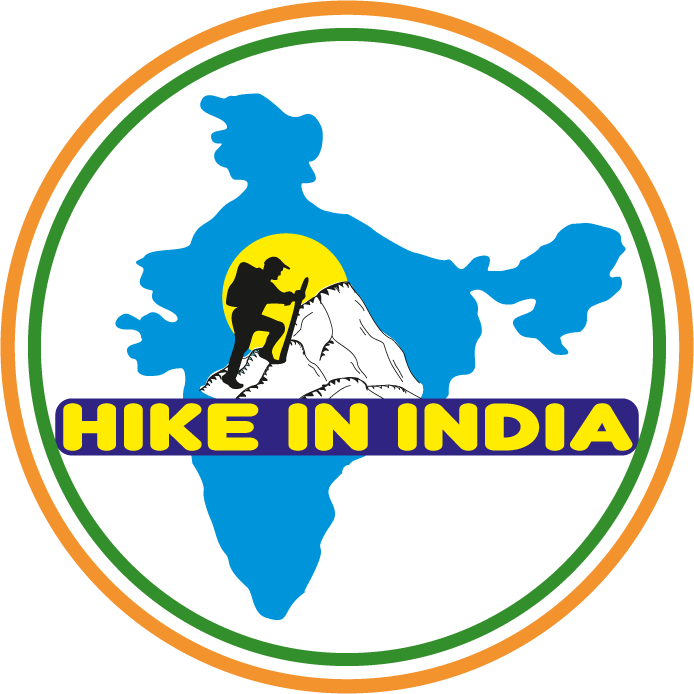
- Upcoming Treks
Experience the adventures Kedarkantha Trek
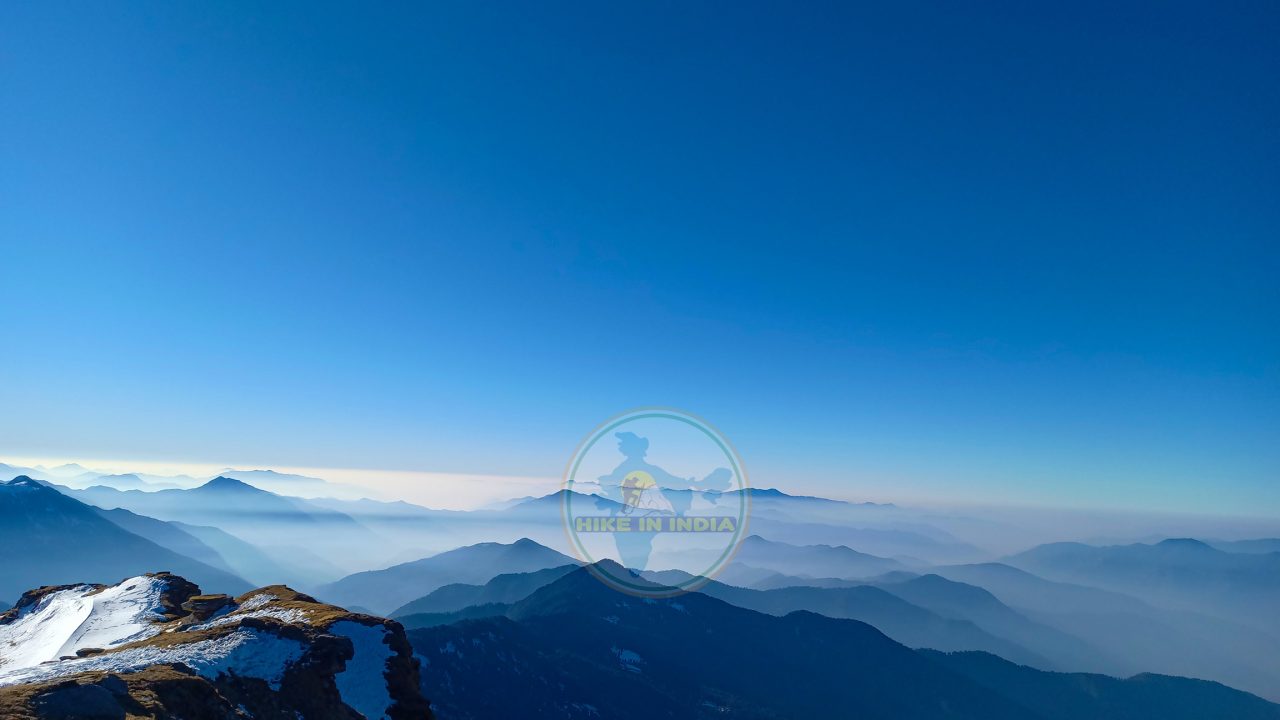
The Kedarkantha trek is a paradise for trekkers and adventure enthusiasts in the Uttarkashi District of Uttarakhand state of India. With its awe-inspiring landscapes, pristine wilderness, and the opportunity to witness the raw beauty of the Himalayas, this trek has become a favorite among both beginners and seasoned trekkers. In this comprehensive guide, we’ll take you on a virtual journey through the Kedarkantha trek, offering insights into its mesmerizing beauty and practical tips to make your adventure unforgettable.
Before we dive into the nitty-gritty details, let’s get acquainted with the Kedarkantha trek itself. We’ll discuss the trek’s significance, the best time to visit, and the essentials you should pack for a successful journey.
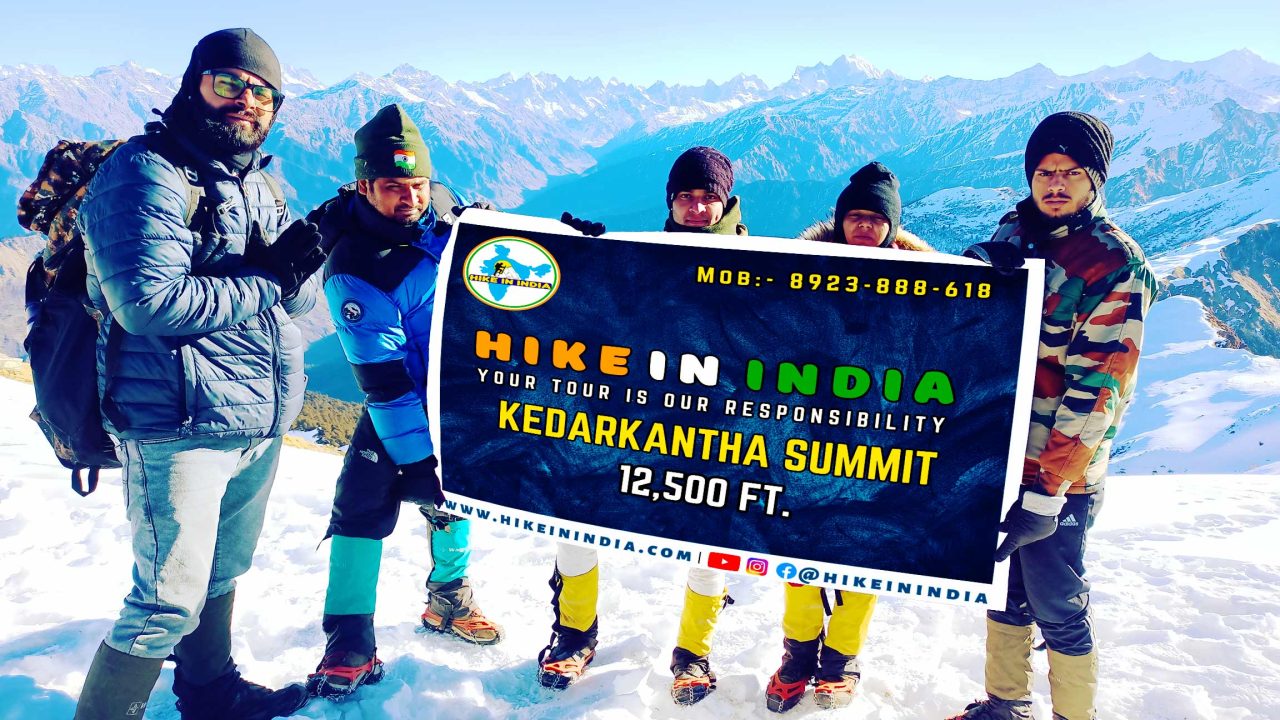
The Kedarkantha Trek – An Overview
The Significance of Kedarkantha : Kedarkantha is a sacred peak in the Garhwal region, named after Lord Shiva. It holds cultural and religious importance and also a favorite trek among trekkers with beautiful scenic views.
Best Time to Trek: The best time to embark on the Kedarkantha trek is during the winter months, from November to April. The snow-covered landscapes during this time are a sight to behold.
Essential Gear: Packing the right gear is crucial. We’ll cover clothing, trekking equipment, and personal essentials to help you prepare for the adventure.
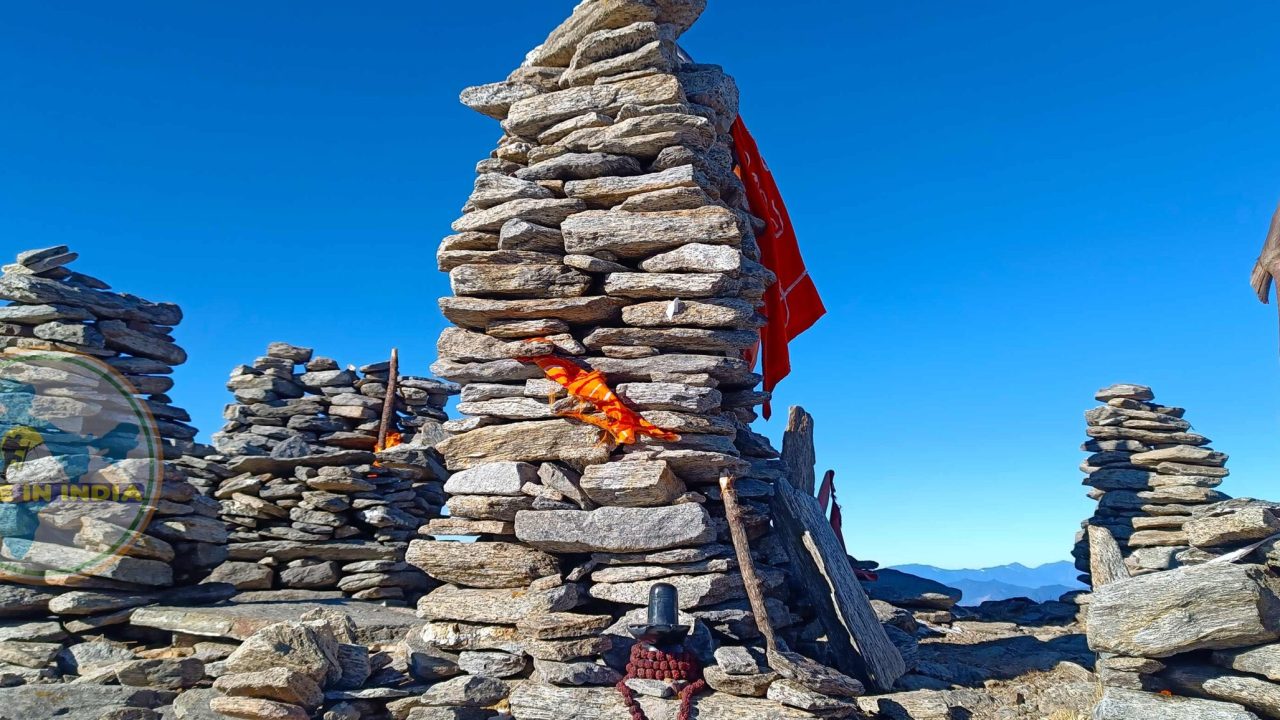
Planning Your Trek
We will discuss how to summit KedarKantha Trek, documents for permits and accommodations and the story behind KedarKantha.
Reaching the Trek Point : You can start the Kedarkantha trek from Sankri, which is well-connected to Dehradun. We’ll provide transportation options for which is included in the Package, Dehradun to Sankri is about 220 kms.
Permits and Documentation : You’ll need to obtain permits for the trek. You have to gave a photocopy of your Aadhar Card and must carry original with you to verify it and a passport size photo, we will do all the further process.
Accommodations: There are two types of options available for accommodation at the KedarKantha trek. In the Sankri village you have to stay in Guest House or Homestay. During the trek we’ll provide camp and the mat under the sleeping bag to sleep.
Story : In the last of blog.
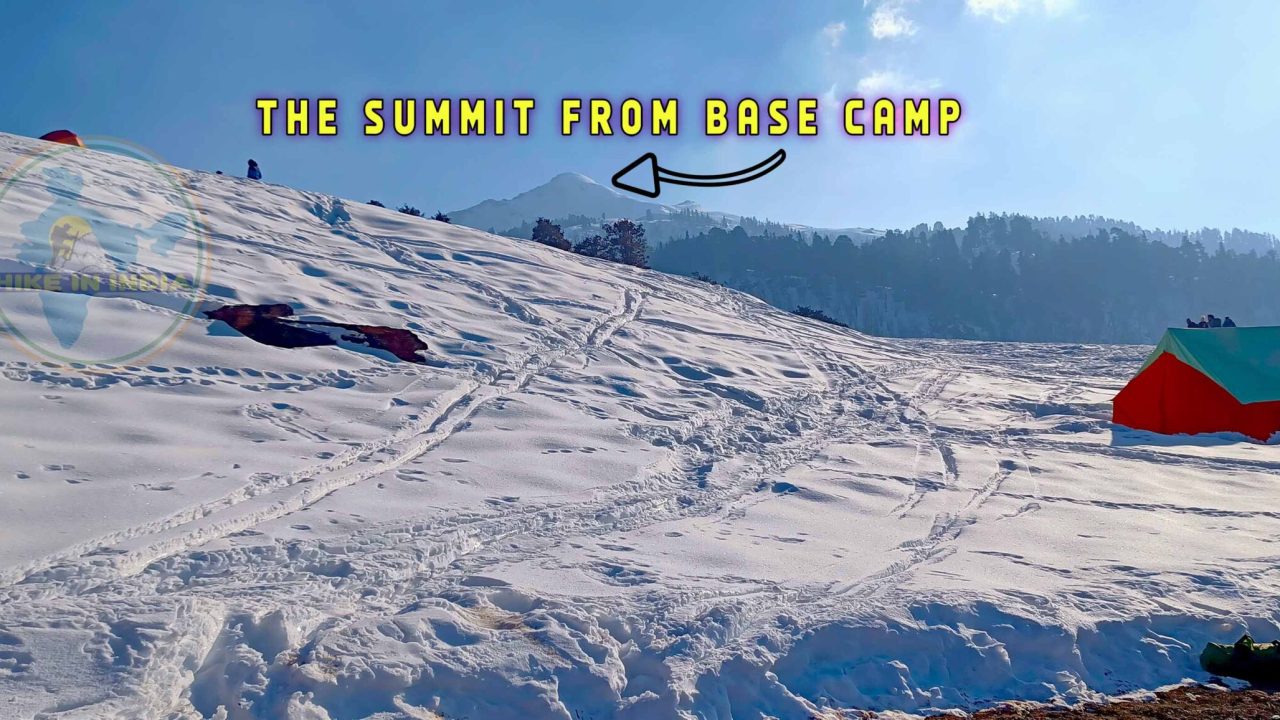
In the heart of the majestic Himalayan range lies a hidden gem, the Kedarkantha trek, where nature weaves its magic and adventure awaits those willing to explore. This enchanting trek takes you through a myriad of experiences, each more captivating than the last.
The journey commences at Sankri, a quaint village that feels like a portal to a different world. The locals welcome you with warmth, sharing tales of the mountains and their revered deity, Lord Kedarkantha. As you ascend, you can’t help but be entranced by the colorful rhododendron forests, an awe-inspiring backdrop to your trek.
The trail winds through meadows adorned with vibrant wildflowers, invoking the feeling of walking through a picturesque dream. Your footsteps are accompanied by the symphony of birdcalls, echoing the eternal harmony of nature.
The highlight of the trek is, of course, the Kedarkantha summit. At 12,500 feet above sea level, you’re met with panoramic views of snow-capped peaks that stretch as far as the eye can see. The summit feels like a sacred altar, a place where you connect with the spiritual energy of the mountains.
Camping amidst the Himalayan wilderness is an adventure of its own. The crisp mountain air, the flickering campfire, and the millions of stars above transport you to a world far removed from the hustle and bustle of city life.
But Kedarkantha’s allure doesn’t end with its natural beauty. It’s also a place where you discover your inner strength. The trek presents challenges, from steep ascents to freezing temperatures, and conquering them instills a sense of accomplishment and self-discovery.
As you descend, the mountains seem to bid you farewell, promising to remain etched in your memories. You return to civilization with a heart full of gratitude for the Himalayas and the incredible journey you’ve undertaken.
The Kedarkantha trek isn’t just about reaching a summit; it’s about the journey, the connection with nature, and the self-transformation it offers. It’s a story that beckons adventure seekers to explore the Himalayan mystique, leaving them forever changed by its beauty and grandeur.
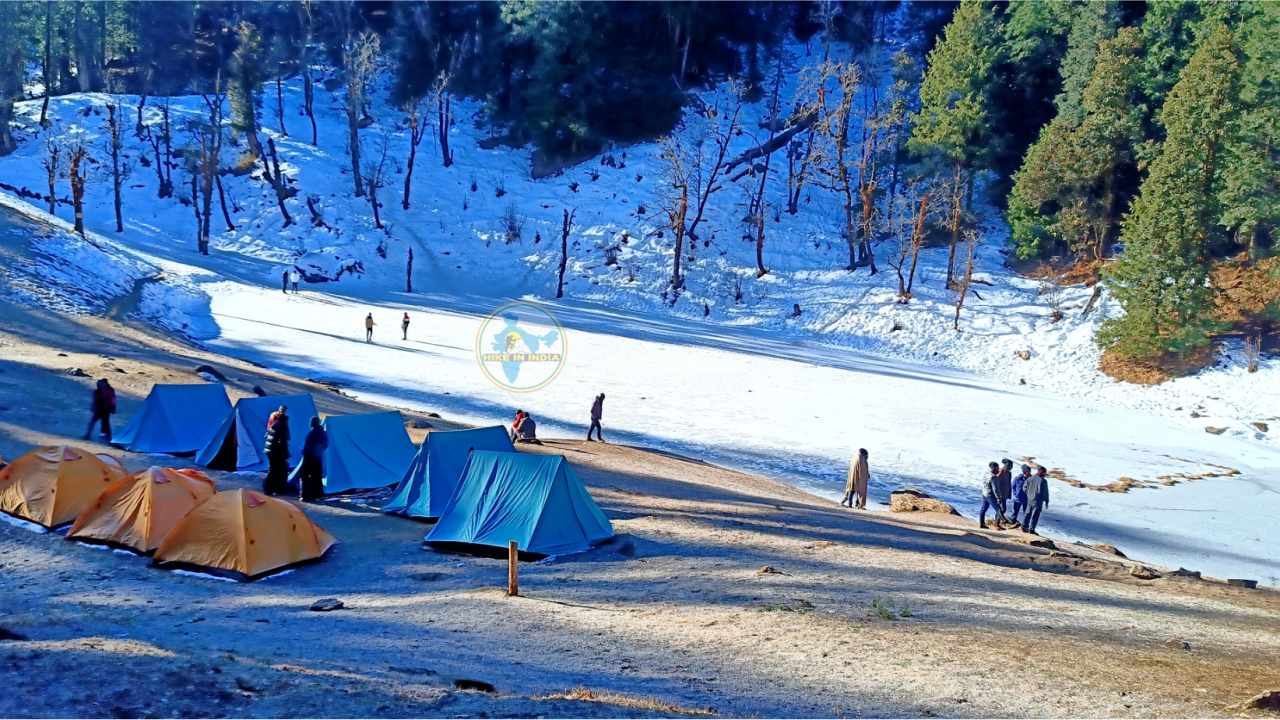
The Trekking Itinerary
Kedarkantha trek can be done in to 5 to 6 days, depends on the stamina of the group. We’ll break down the trekking itinerary day by day. You’ll get a glimpse of the beautiful landscapes and the distances to be covered at each stage.
- Day 1: Dehradun to Sankri – You’ll be picked up from Dehradun Railway Station or ISBT and drive around 220 km and it takes around 7-8 hours to reach Sankri. Sankri altitude is 6,455 ft.
- Day 2: Sankri to Juda Ka Talab – Start your trek from Sankri to reach Juda ka Talab (Frozen Lake during winter). We have to Trek around 3 km to reach Juda ka Talab at 9,100 ft altitude, Overnight stay at Camp.
- Day 3: Juda Ka Talab to Kedarkantha Base camp – Enjoy your Breakfast at Juda ka Talab, and head towards the KedarKantha Base camp at 11,250 ft altitude and we have to trek around 3 km to reach there, overnight stay at camp.
- Day 4: Kedarkantha Base Camp to Kedarkantha Summit and Back to Juda Ka Talab – After breakfast, get ready for the ultimate Adventure. Wake up early around 1:30 or 2:00 Am in the Morning, have breakfast then start your trek towards summit at 12,500 ft altitude and it takes around 4-7 hours to reach the summit. After enjoy the Sunrise from the Gangotri or Yamunotri mountain ranges. Descend back to Juda Ka Talab overnight stay at camp.
- Day 5: Juda ka talab to Sankri, Sankri to Dehradun – Enjoy your delicious breakfast, then ready to descend towards Sankri village. After arrival on Sankri feshed up and Drive to Dehradun.
Note: The above itinerary is based on 5 days regular tour package, If you want then we can customize it for 6 days.
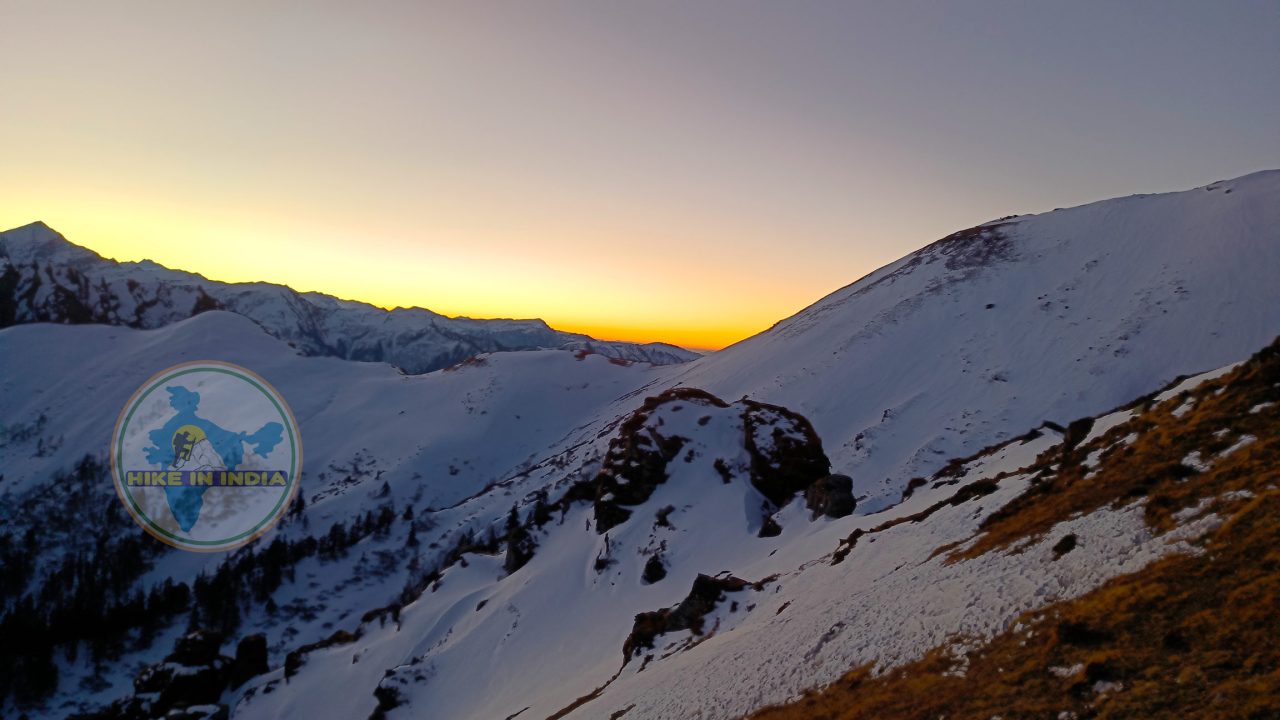
Responsible Trekking and Safety Measures
Responsible trekking is not only about experiencing the natural beauty of the great outdoors but also ensuring the preservation of these fragile ecosystems and the safety of trekkers. Here are a few lines on responsible trekking and safety measures:
Leave No Trace: Responsible trekkers follow the “Leave No Trace” principle, meaning they leave nature as they found it. This involves carrying out all trash, using designated camping areas, and minimizing their impact on the environment.
Plan and Prepare: Thoroughly plan your trek, considering factors like weather, terrain, and the skill level of your group. Inform someone of your itinerary and expected return time.
Pack Essentials: Bring essential items like appropriate clothing to handle changing weather conditions.
Respect Wildlife: Keep a safe distance from wildlife and refrain from feeding or approaching animals. Your presence should not disrupt their natural behaviors.
Stick to Established Trails: Stay on designated paths to avoid damaging fragile ecosystems and to ensure your own safety. Venturing off-trail can lead to accidents and environmental harm.
Camp Responsibly: Follow all camping regulations. Minimize campfire use and opt for a camp stove to reduce the risk of forest fires.
Leave No Mark of Your Presence: Avoid graffiti, littering, or any other activities that harm the environment. Remember, you’re a guest in nature.
Consider Local Culture: When trekking in different regions, respect local customs and traditions, and be mindful of how your actions might affect the local community.
In summary, responsible trekking is a balance between enjoying the outdoors and preserving it for future generations. Safety measures are integral to this, ensuring that you have an enjoyable and secure experience while minimizing your impact on the environment.
The Kedarkantha trek is a thrilling adventure that will leave you with memories to cherish for a lifetime. From the sacred significance of the peak to the incredible landscapes and the challenges of trekking in the Himalayas, this journey is a rewarding experience for those who seek the beauty and serenity of the mountains. By following this comprehensive guide, you’ll be well-prepared to embark on this incredible Himalayan adventure. So, lace up your trekking boots and get ready to explore the mesmerizing Kedarkantha trek!
Blog Suggestions
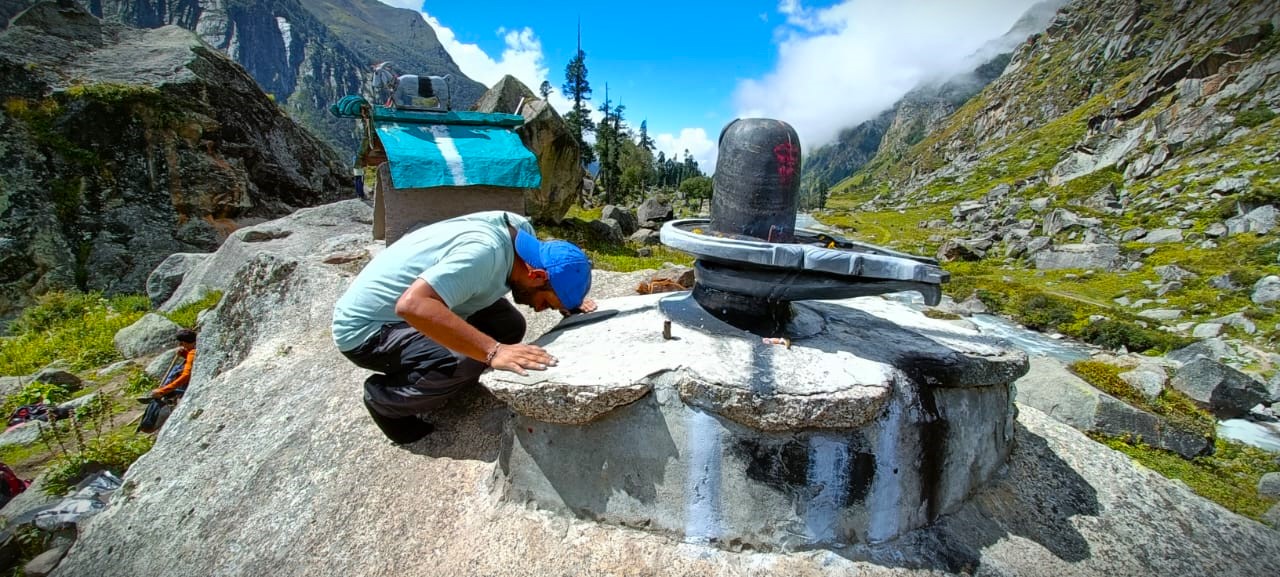
Har ki Doon Trek
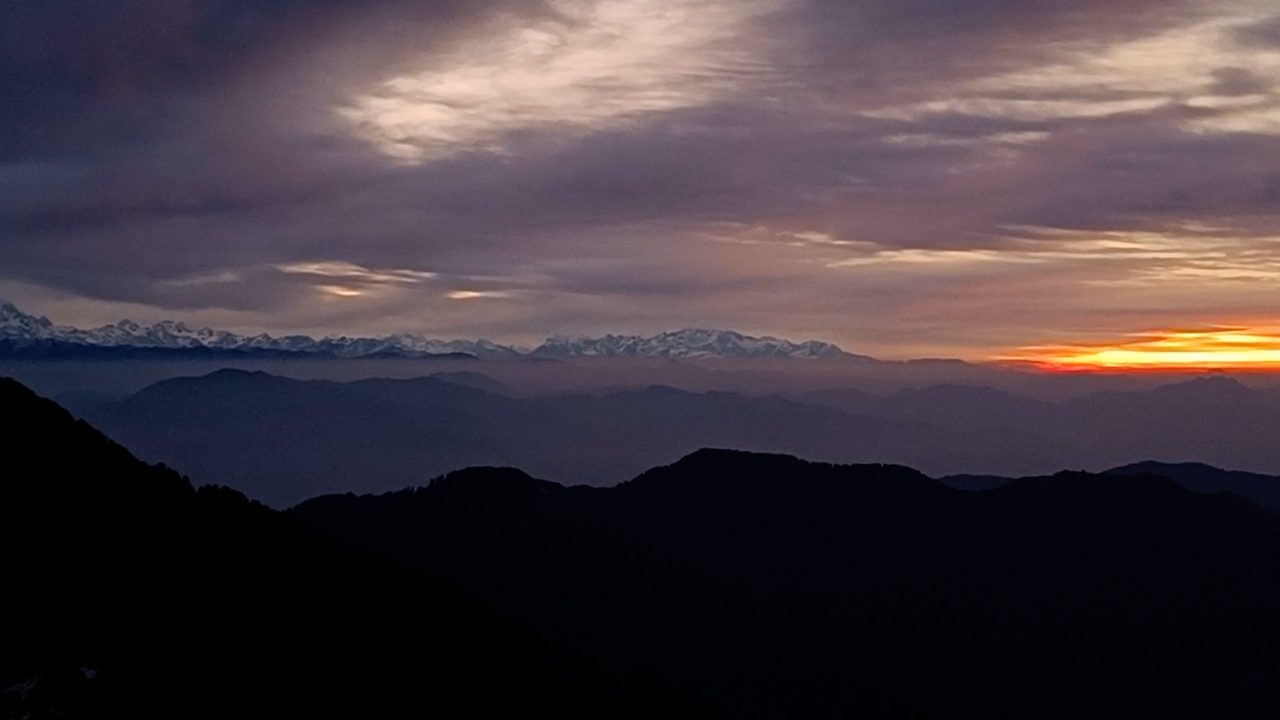
Nag Tibba Trek
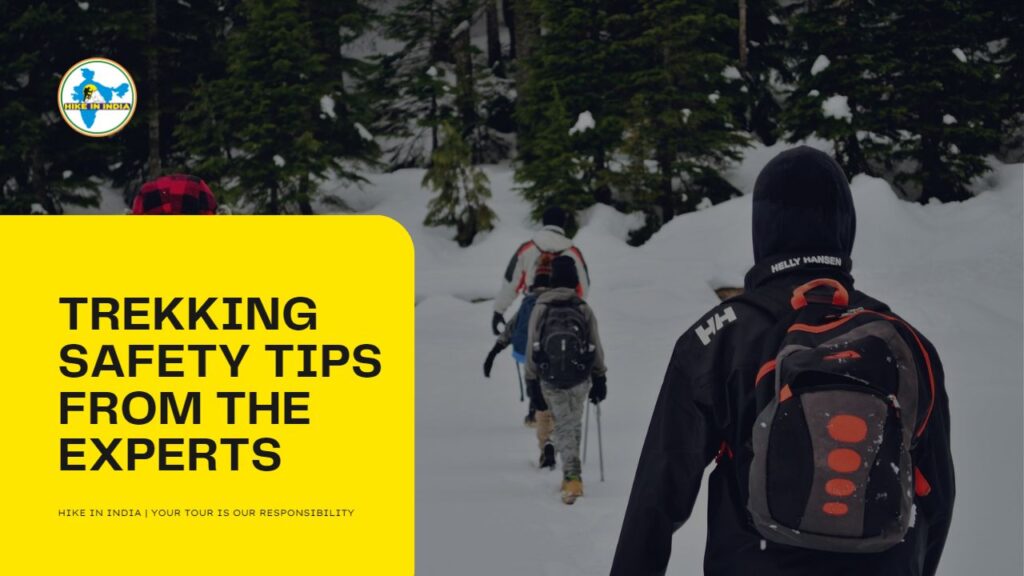
Trekking Safety Tips

Kedarkantha Peak Trek: A Complete Guide to Kedarkantha Trek
Kedarkantha Peak Trek stands out as a premier winter trek and hiking destination in Uttarakhand, India, boasting an elevation of 12,500 feet. This trek is renowned for delivering unparalleled satisfaction to trekking enthusiasts. What sets the Kedarkantha trek apart is its exceptional panoramic views, offering a breathtaking perspective of the entire mountainous landscape. The icy wind stung my face as I trudged up the snowy trail in the dim morning light. My legs were ready to give up but Kedarkantha Peak beckoned me for one final push. As the first rays of the sun peeked over the mighty Himalayan peaks, I scrambled over boulders and reached the summit. The vast vista that unfolded took my breath away – I had conquered Kedarkantha! This challenging yet immensely rewarding trek changed my life forever. Let me take you through how…
All About Kedarkantha Peak
Nestled high up in the Garhwal Himalayas, Kedarkantha Peak stands tall at 12,500 ft. This pristine snow-clad beauty offers stunning views, mystical campsites, and diverse landscapes that enthrall your senses. Its moderate difficulty makes it suitable for beginners undertaking their first high-altitude trek. Yet the sense of achievement upon summiting Kedarkantha entices even the seasoned trekker.
This definitive guide covers everything I learned through my life-changing trek to conquer Kedarkantha Peak. From permits, gear and safety to vivid descriptions of the sublime Himalayan beauty surrounding Kedarkantha, I share my experiences to help fellow trekking enthusiasts plan their dream journey.
The Allure of Kedarkantha Peak
Part of the Govind Pashu Vihar National Park in Uttarkashi district, Kedarkantha lies flanked by famous peaks like Swargarohini, Bandarpoonch and Ranglana. I could recognize these giants during my trek by their unique shapes and heights.
The mountain is named after Lord Shiva and called ‘Shiva’s throat’ due to its throat-like formation when viewed from certain angles. At 12,500 ft, it makes for an ideal summit climb – tough yet attainable with a moderate fitness level.
Nothing quite prepares you for the vast Himalayan spectacle that unfolds at the top. It was difficult to draw my eyes away from the endless vistas spanning Himachal Pradesh, Gangotri group, Badrinath, Nepal, and Tibet! Such enthralling 360o views make all the pain worth it.
The Mesmerizing Kedarkantha Route
Total Distance: 28 km Duration: 5-6 days
The trek starts from Sankri (6,455 ft), a quaint village bursting with lush greenery. The route winds through verdant forests and wide meadows before culminating at the Kedarkantha summit. Some highlights along the trail are:
Juda Ka Taal: An Idyllic Lake
Imagine waking up to mist floating above a pristine emerald lake framed by mighty snow-clad peaks. That’s Juda Ka Taal for you! Camping on its gravelly banks with the stars as the company was an ethereal experience.
Hargaon Camp: Rejuvenation Amidst Nature
Hargaon camp with its vast meadows and views of the Swargarohini massif was an oasis of respite. The peaceful setting and warm hospitality helped rejuvenate my sore limbs after days of arduous trekking.
The itinerary with distances and altitudes is:
- Day 1: Sankri to Juda Ka Tal – 4 km, 9,100 ft
- Day 2: Juda Ka Tal to Hargaon Camp – 6 km, 8,950 ft
- Day 3: Hargaon Camp to Juda Ka Taal – 6 km, 9,100 ft
- Day 4: Juda Ka Tal to Kedarkantha Base – 4 km, 11,250 ft
- Day 5: Kedarkantha Base to Summit; Descend to Hargaon – 8 km, 12,500 ft
- Day 6: Hargaon to Sankri – 12 km, 6,455 ft
The final climb is undoubtedly the most challenging yet rewarding stretch. Reaching the top as the sun rises made all the hardship absolutely worth it!
Best Time for Kedarkantha Trek
Kedarkantha can be trekked year-round but December to April is the best season. These winter months see heavy snowfall, turning Kedarkantha into a pristine white wonderland! Although extremely cold at night, sunny days made for perfect snow trekking.
Summers can be wet with leech infestations on the trail. I’d advise avoiding the monsoon months when there’s heavy rainfall and risk of landslides.
How to Reach Kedarkantha Peak?
- By Air: Jolly Grant Airport in Dehradun located 250 km from Sankri was my gateway. Regular taxis and buses connect Dehradun to Sankri in 8 hours.
- By Rail: Dehradun railway station, 200 km from Sankri, was the nearest railhead for me. Shared cabs are available to cover the onward journey.
- By Road: To enjoy the full journey, I road tripped from Dehradun to Sankri, stopping at charming hill stations like Mussoorie on the way. The 200 km drive takes about 8-10 hours by bus or private taxi.
Acclimatization Hacks for High Altitude
As a first-time trekker, acclimatizing to the high altitude was crucial. Here are some tips that helped me:
- Take a day’s rest in Sankri before the trek to get used to the climate
- Climb slowly and steadily without overexerting initially
- Stay hydrated and avoid smoking or drinking alcohol
- Look out for tell-tale signs of altitude sickness
- Pop a Diamox if feeling breathless but consult a doctor first
Following these kept altitude sickness at bay and helped me adapt to the low oxygen levels.
Things to Carry for Kedarkantha Treks
Based on my experience, here are the essentials I’d recommend carrying in your 40-60 liter backpack:
- Sturdy trekking shoes with good traction
- Woolen layers, a down jacket, and warm gloves
- Waterproof jacket and snow pants
- LED torch, sunglasses, and sunscreen
- Hydration bottles and energy bars
- Trekking pole for uphill climbs
- Medicines, first-aid kit, and emergency cash
- Do carry light snacks to munch on in case meals aren’t sufficient to provide energy for the long trails.
X Dog Trekking offers Trekking gear for Rent like backpacks, trekking poles, camping equipment, etc. at reasonable prices in Bangalore.
Detailed Kedarkantha Trek Itinerary
Based on my experience, here’s a detailed day-wise itinerary to plan your journey:
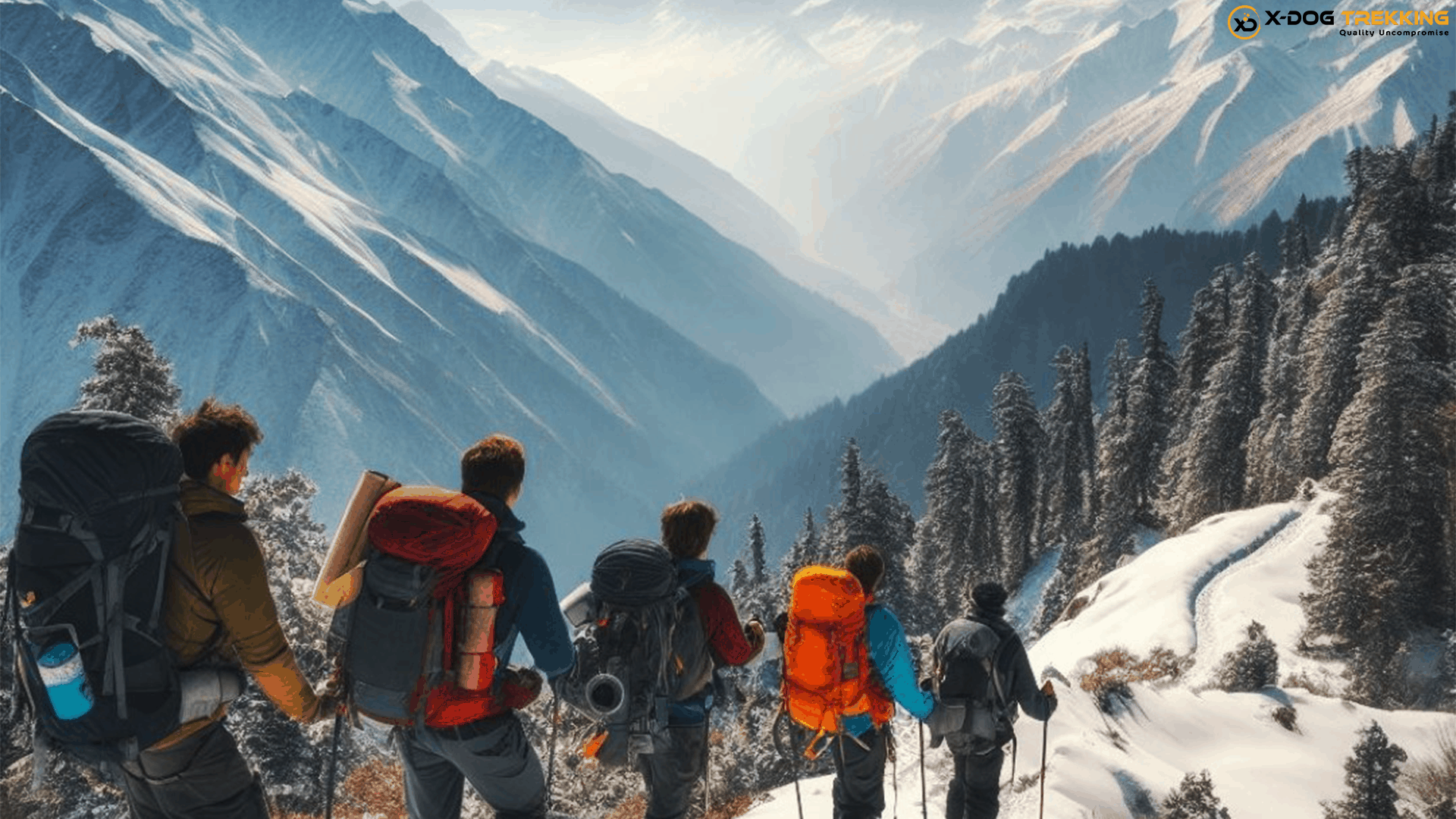
Day 1: Dehradun to Sankri
The road trip from Dehradun took me about 8-10 hours to cover the 200 km distance. Reaching Sankri by evening, I checked into my guesthouse and took an acclimatization rest.
Day 2: Sankri to Juda Ka Tal
Distance: 4 km Altitude: 9,100 ft Time: 4 hours
After a hearty breakfast, I commenced my trek, crossing over gushing streams and dense forests before catching first glimpses of Juda Ka Taal. After setting up camp, I relaxed by the lake as the sun set behind the imposing peaks.
Day 3: Juda Ka Tal to Hargaon Camp
Distance: 6 km Altitude: 8,950 ft Time: 6 hours
Descending into a valley, the trail transitioned from forests to rolling grasslands with breathtaking vistas. I spotted some exotic Himalayan birds before arriving at the sprawling meadows of Hargaon by late afternoon.
Day 4: Hargaon to Kedarkantha Base
Distance: 4 km Altitude: 11,250 ft Time: 4 hours
This short yet steep climb took me through boulder sections and snow-covered slopes. Reaching the base camp, I caught first glimpses of the magnificent peak that I was about to summit.
Day 5: Base to Summit and Back to Hargaon
Distance: 8 km Altitude: 12,500 ft Time: 8 hours
With bated breath and a racing heart, I began the final ascent in darkness armed with my torch. The sun rose just as I reached the top and the views left me spellbound! After some celebration, I climbed down to Hargaon for rest.
Day 6: Hargaon to Sankri
Distance: 12 km Time: 5 hours
The last day was spent descending via the Supin valley back to Sankri where our trekking adventure had begun. Refreshing hill-station vibes and hot running water rejuvenated my tired body after the long trek!
Kedarkantha Trek Cost and Permits
- Forest Permit: INR 150-250 per person
- Camping Charges: Around INR 800 per person
- Guide Fees: As per group size
- Trek Cost: INR 10,000 – 12,000 per person excluding transport
- Take travel insurance just in case of any uncertainties
- Keep valid ID proof and permits handy for random checks along the way.
Food and Accommodation on Kedarkantha Trek
- Modest guesthouses in Sankri provide hot running water and clean linen
- Alpine tents are set up at campsites on a sharing basis
- Wholesome satvik vegetarian fare is served throughout the trek
- Pack your own snacks if you need a quick energy boost
- I’d advise avoiding alcohol or smoking at high altitudes to aid acclimatization.
Difficulty Level of Kedarkantha Peak Trek
For first-timers like me, Kedarkantha is an ideal beginner-level high-altitude trek of moderate difficulty. Here are some tips I’d recommend to prepare:
- Start easy cardio like jogging and build higher stamina
- Complement with strength training – squats, lunges, planks
- Get used to walking long distances with your backpack
- Work on speed and agility to improve trek pace
- Carry out simulated treks to test fitness
With some targeted preparation, Kedarkantha is an achievable dream summit even for novice trekkers like me!
Snow Trekking on Kedarkantha Trail
In winter, expect heavy snowfall on the trails leading up to the peak. Walking through fresh powdery snow was an otherworldly experience! Here are some tips I learned:
- Waterproof trekking shoes with ankle support work best
- Layer up with multiple woolen and windproof clothing
- Trekking poles with snow baskets provide balance and grip
- Apply sunscreen and lip balm to prevent sunburn and chapping
- Stay hydrated and watch out for frostbite or hypothermia symptoms
Kedarkantha covered in snow is incredibly beautiful albeit challenging. But the trick is to prepare well and the rewards are unmatched!
Safety Tips for Kedarkantha Peak Trek
Based on my lessons, here are some key safety pointers:
- Acclimatize adequately before attempting long hikes
- Always trek with an experienced guide familiar with the route
- Check weather reports and avoid poor conditions
- Stick to the trail and never trek alone, especially at night
- Maintain a steady, slow pace to avoid altitude sickness
- Keep emergency numbers and medical history accessible
- Follow eco-friendly practices to sustain the fragile mountain environment
Staying aware and alert is key to an incident-free trek.
Why Kedarkantha Trek Should Be On Your Bucket List?
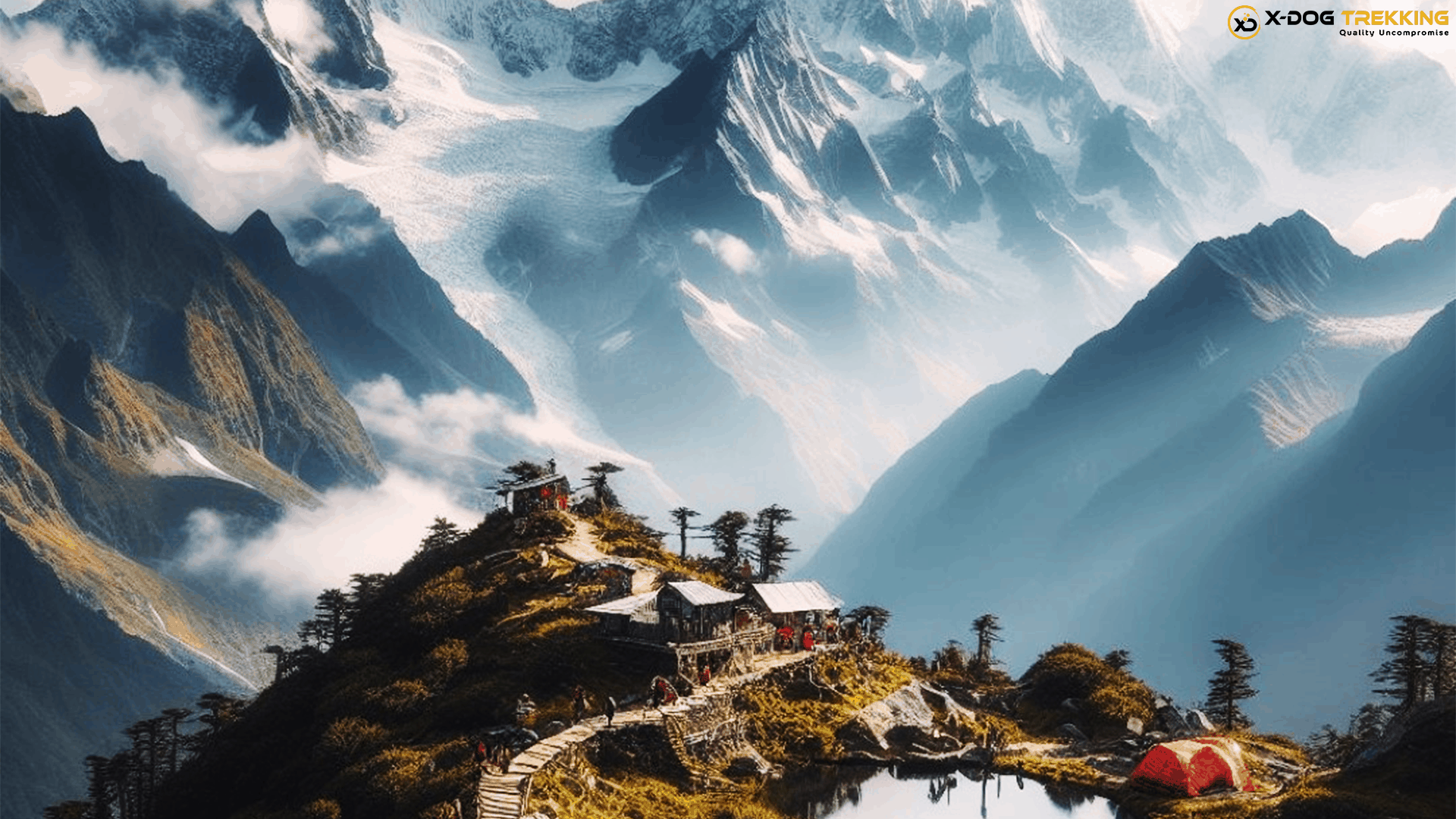
Here are key reasons why Kedarkantha trek makes for an unmissable Himalayan adventure:
- Scenic Landscapes: From verdant meadows and forests to an icy wonderland near the peak, the diverse scenery is breathtaking! Camping under starry skies next to the divine Juda Ka Taal is an ethereal experience.
- Chance to Summit a Peak: The sense of triumph upon summiting a 12,500 ft peak is surreal, especially for beginners! Kedarkantha is just the right blend of challenge and rewards.
- Gateway to Himalayan Trekking: For first-timers like me, conquering Kedarkantha opens doors to attempting more difficult Himalayan treks in the future. It’s a perfect beginner-level peak.
- Diverse Flora and Fauna: The Govind National Park trail offers sights of unique Himalayan flowers, exotic birds, and rare fauna amidst lush greenery.
- Sheer Sense of Achievement: The unparalleled joy of completing a high-altitude trek, proving your grit and stamina, stays with you forever. Kedarkantha gave me immense confidence and self-belief.
These rewarding experiences make the Kedarkantha trek an absolute must-do Himalayan adventure!
How to Plan Your Dream Trek to Kedarkantha?
After my life-changing experience, I hope this guide helps you plan your own journey to conquer the magnificent Kedarkantha peak. Although challenging, few adventures can match the sheer sense of achievement you feel at the summit.
Relish the lush green meadows, icy landscapes, quaint villages, and fun camping experiences along the way. Let the quiet wisdom of the Himalayas transform you into a stronger, wiser version of yourself.
So get set for the trip of a lifetime. Gear up, pack up, and prepare to be mesmerized! The mountains are calling – it’s time to conquer Kedarkantha!
Frequently Asked Questions About Kedarkantha Peak Trek
1. how can i reach kedarkantha for the trek.
The nearest airport is Dehradun, from where taxis, buses or trains can be taken to reach Sankri which is the starting point of the trek.
2. What is the best time to visit Kedarkantha?
The ideal time is winter (December to April) when the peaks are snow-covered. Summers can see some rainfall while monsoons must be avoided due to the risk of landslides.
3. What’s the level of difficulty of this trek?
Kedarkantha is a moderate trek suitable for beginner-level trekkers. Reasonable fitness is required to summit the peak. It’s achievable with some preparation.
4. How cold does it get on the Kedarkantha trek?
In winter, temperatures can range from 10°C during the day to -5°C or lower at nighttime. Carrying proper woolen and windproof jackets is essential.
5. What type of shoes should I buy for the trek?
Waterproof trekking shoes with good ankle support and traction are ideal. They prevent slipping on snow or streams along the way.
6. Is it safe for a solo woman traveler?
It is absolutely safe if you trek with a certified tour organizer having experienced guides and proper arrangements. Do not trek alone, especially at higher altitudes.
7. What is the level of fitness required?
Having a moderate fitness level with the ability to hike 5-6 km daily without exhaustion is recommended. Work on building stamina before the trek.
8. How to prevent altitude sickness on the trek?
Ascend slowly, hydrate adequately, and avoid alcohol. Don’t overexert yourself. Take proper rest and acclimatization breaks. Descend if symptoms persist.
9. What is the ideal backpack size for this trek?
A 40-60 liter backpack is recommended to carry all your essentials comfortably. Avoid carrying unnecessary items to minimize weight.
10. What is the best source of water during the trek?
It is safer to use boiled or filtered water available at campsites. Also, carry your own packaged water during the trek for emergencies. Avoid stream water due to contamination risks.
Final Tips for an Epic Kedarkantha Peak Trek
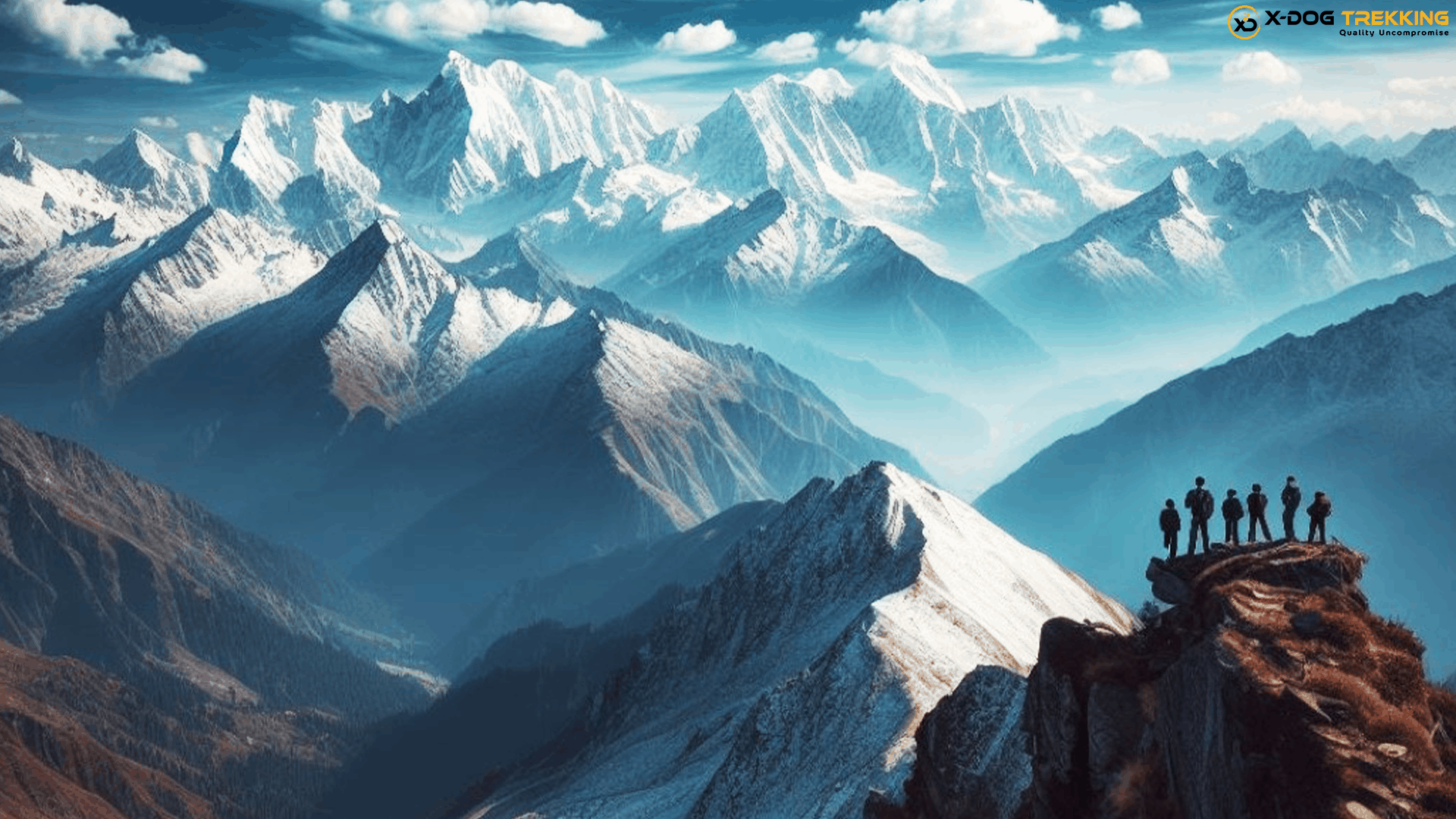
Here are some final tips to ensure your Kedarkantha trek is memorable, fun, and safe:
- Get sturdy trekking shoes, poles, and clothing well in advance
- Pack light with only essentials to avoid load on your shoulders
- Prepare physically through strength training, cardio, and simulated treks
- Have energy snacks handy for quick glucose boosts when tired
- Follow the itinerary and don’t rush the acclimatization days
- Take care of knees and ankles during steep climbs & descents
- Drink ginger lemon tea to ease nausea or headaches due to altitude
- Budget for contingencies like landslides causing route changes
- Carry sunscreen, shades, and lip balm to prevent sunburn
- Sleep early after dinner since next day’s hike starts before dawn
- Enjoy the sights but don’t let your guard down regarding safety
- Share photos but do not litter or pollute this fragile environment
- Follow these tips and you are sure to have the most epic trek of your lifetime at Kedarkantha! Just wear a smile, take a leap of faith, and set forth to create magical memories.
Read this for more information about Kedarkantha Trek ➢ 30 Things To Carry For Kedarkantha Trek
Conquering the magnificent Kedarkantha peak trek is a truly life-changing experience for any traveler seeking adventure in the Himalayas. With its stunning landscapes, rewarding summit views, and moderate difficulty, it makes for an ideal introduction to high-altitude trekking. This comprehensive guide with tips and information aims to help fellow outdoor enthusiasts plan their dream trek to Kedarkantha. Do share it with anyone planning their first Himalayan summit. I hope it helps them create beautiful memories in the abode of snow, just like my unforgettable journey to the top of Kedarkantha did for me!
Related Posts

Bike Riding Gear for Rent in Bangalore at the Lowest Price
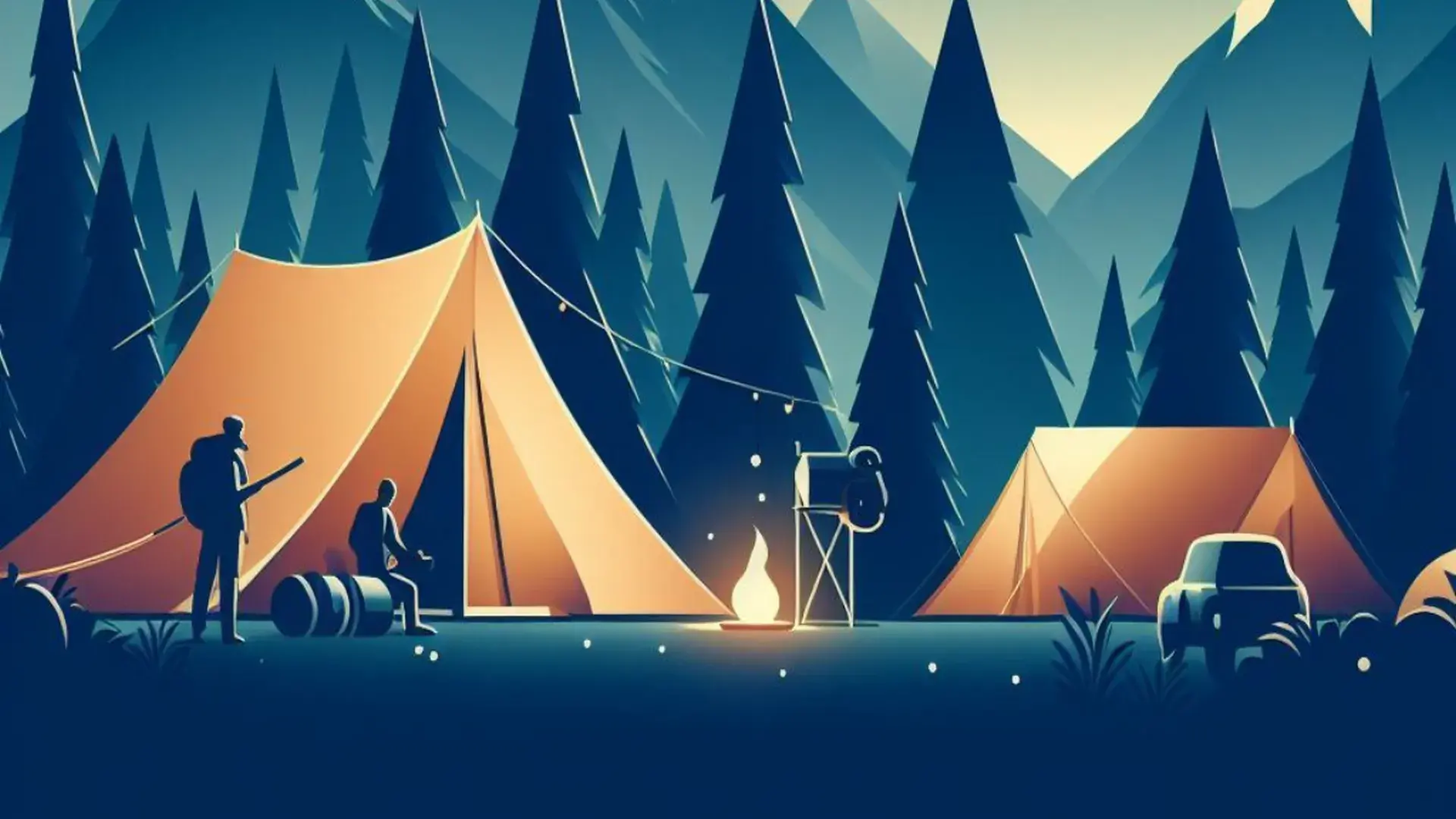
How to Choose the Right Trekking Tents for Rent?
Leave a comment cancel reply.
Your email address will not be published. Required fields are marked *
Save my name, email, and website in this browser for the next time I comment.
- Weekend +91 87 6262 3333
- Himalayan +91 9886 444 809
- International +91 84968 85968
- [email protected]
- One Day Treks
- Two Day Treks
- Himalayan Treks
- International Treks
- Private Treks
- Group Adventures

- Trek to Kedarkantha Peak
- Secure & Easy Booking
- Best Price Guaranteed
- 1000+ Happy Customers
- Winter Treks 2023 & 2024
The minute you think of snow trekking in India, one of the most gorgeous treks that come to mind is the Kedarkantha summit trek. This trek is all about introducing you to a winter wonderland unlike any other. This trek is all about exploring the fun side of trekking and is a perfect fit for anyone who's trying their hand at Himalayan trekking for the first time. This trek is easy and comfortable for a novice summiter and gives you every Nomad an opportunity to summit a snow-laden peak in Uttarakhand.
Perfect for a Beginner
The total Kedarkantha trek distance is around 25km. The kedarkantha trek route is easy and just as breathtaking, the trail that this trek has is usually most meant for hardcore trekkers but Kedarkantha is an exception. With the Kedarkantha trek, you can experience an adventure like no other with a thrilling summit climb in a frozen fairyland. Kedarkantha trek height is 3810 m (12,500 ft).
You'll Fall in Love With The Campsites
The best part about the Kedarkantha trek is that the summit is one of the highlights of the trek, other highlights include dramatic campsites with the best-known views in the entire Indian Himalayan region. You'll see that the campsite is surrounded by a forest of snow-capped pine trees and abandoned huts of local shepherds. The sunset seen from the Kedarkantha base camp would be one of the best experiences of your life. Kedarkantha trek best time is in the winter season.
Mind-Bewitching View from the Kedarkantha Summit
It's a known fact that any summit in any part of the world can be extremely rewarding, the Kedarkantha summit is no less. The trail may be extremely beautiful, but the view that you get after your climb to the top is unbelievable. Kedarkantha trek height is 3830 m (12,500 ft). You will notice that some of the mighty Himalayan peaks will be clearly seen from here. From Swargarohini to Black Peak and Bandar ki Poonch in the Gangotri and Yamunotri ranges to Har Ki Dun and glimpses of the Kinnaur Ranges from Himachal Pradesh, the view from the summit is fulfilling, gratifying and unforgettable. Best time for Kedarkantha trek is from December to March.
The Legend of Kedarkantha
Another thing that pulls Nomads to trek to Kedarkantha peak is the deep-rooted mythology that makes this trek extremely mysterious and revered. Kedarkantha is also called "Kedar Khand" which loosely translates to "Section of Lord Shiva", which also happens to be a historic name in the local community. The meaning of Kedarkantha however, is Throat of Lord Shiva . The mythology is that Kedarkantha was where Lord Shiva used to meditate before moving to Kedarnath.
The very famous and beautiful Juda Ka Talab is where the water droplets fallen from Lord Shiva's hair turned into a small pond. The sighting the revered and sacred Swargarohini peak is one of the rewarding attractions of the trek. Swargarohini translates to " Stairway to Heaven " and is the same peak where the Yudhishthira, the eldest of the Pandavas along with his dog reached heaven from this godly peak. Kedarkantha trek price is mentioned below.
Are you interested for Kedarkantha winter trek? Get in touch with us today!
- 3 nights stay at a 3-star hotel in Mussoorie
- 2 nights stay at a resort in Sankri
- 3N camping stay along the trail of Kedarkantha
- The majestic view of Swargarohini, Kinner Kailash, Yumnotri, Gangotri, and other Himalayan ranges is a divine pleasure. Kedarkantha gives a 360-degree view of Himalayan ranges.
- Day 1: Arrive at Mussoorie
- Day 2: Travel from Mussoorie to Sankri
- Day 3: Trek to Juda ka Talab from Sankri
- Day 4: Trek to Kedarkantha Base Camp from Juda ka Talab
- Day 5: Trek to Kedarkantha Peak from then back to Kedarkantha Base Camp
- Day 6: Trek to Sankri from Kedarkantha Base Camp
- Day 7: Travel from Sankri to Mussoorie
- Day 8: Sightseeing at Mussoorie
- Day 9: Travel back to home.
Detailed Itinerary for Kedarkantha Trek:
Day 1: Mussoorie
Altitude: 6,170 ft (1880 m)
On Day 1 you arrive in Mussoorie, you will now check-in to a 3-star hotel spend some time unwinding. Later, you meet your fellow Nomads for a quick introductory session after which you will have a short briefing on tomorrow's trek with your trek lead. You will stay the night in Mussoorie.
Day 2: Sankri
Altitude: 6,455 ft (1,920 m) Travel Duration: 7-8 hours
On Day 2, you start traveling towards Sankri from Mussoorie. The beautiful drive takes you through banks of Yamuna river and later Tons river. You will also see picturesque pine trees on the route today. As you arrive in Sankri, you will notice that the air is crisper and extremely fresh, making this a refreshing change from your city life. You check in to a resort in Sankri post-arrival and spend some time relaxing. Sankri, is as gorgeous as can get giving you brilliant photo-opportunities. A good evening stroll around the village is perfect to fill up your Instagram feed & to get yourself warmed up for the trek the next morning. Stay the night at the resort in Sankri.
Day 3: Juda ka Talab
Altitude: 8,858 ft (2,700 m) Trek Duration: 3-4 hours
Today you wake up early, freshen up and after a hearty breakfast, start your trek. The trail today is mostly uphill and takes you through a beautiful forest section for the most part of the trek. To start with, you walk from Sankri to Saur village and from here is where the actual climb starts. Towards the end of today's trek, you reach the famous Juda Ka Talab, the pond that freezes during winters and this is where you will be camping tonight.
Day 4: Kedarkantha Base Camp
Altitude: 11,253 ft (3,430 m) Trek Duration: 3-4 hours
The trek from Juda Ka Talab to Kedarkantha base camp is not long but is definitely steep. The trail gives you good views of the Rupin & Supin valley and goes through the abandoned huts of villagers and shepherds. Post the steep stretch you will walk through pine forests and into a clearing, a meadow surrounded by rich oak and Rhododendron forests on one side. This is the Kedarkantha Base Camp and this is where you will be camping the night. You will be given an early dinner and asked to go to bed quite early after prepping you for the summit climb the next day.
Day 5: Kedarkantha Summit Day
Altitude: 12,500 ft (3,810 m) / 11,253 ft (3,430 m) Trek Duration: 7-8 hours
Today is the day of the summit and you start the trek at 3 AM in the morning. The climb to the summit is about 4-5 hours long and depending on the amount of snow, the trek lead and guide will decide on the best possible way to reach the summit. If all goes well, you will reach the summit just in time for sunrise. From the peak the sunrise is extremely rewarding and astounding. From the peak, you can get a clear view of the Kinner Kailash ranges in Himachal Pradesh. Kedarkantha winter trek offers mind blowing views of the snow clad mountains. You will also see various mountains from the Yamunotri & Gangotri region such as Swargarohini, Black Peas, Bandar ki Poonch etc. and you can also see the Har Ki Dun peak and some other underlying valleys. You will spend some good amount of time on the peak before heading back down to base camp. Upon reaching base camp, you can unwind for the rest of the day and stay overnight in the Kedarkantha Base Camp.
Day 6: Sankri
Altitude: 6,455 ft (1,920 m) Trek Duration: 4-5 hours
On Day 6 you start your journey back to Sankri passing the Juda Ka Talab and finally arriving in Sankri. You can choose to relax in the resort or you can head out for a beautiful walk and catch the glimpse of sunset in the vallet. Stay the night in Sankri.
Day 7: Mussoorie
Altitude: 6,170 ft (1880 m) T ravel Duration: 7-8 hours
Today you start traveling towards Mussoorie. You can expect to arrive in Mussoorie in late afternoon. Check in to your hotel and rest for the day.
Day 8: Mussoorie
Altitude: 6,170 ft (1880 m)
On Day 8, you can roam around the streets of Mussoorie and visit places like Sir George Everest's House, Happy Valley, Kempty Falls, etc. Stay the night in Mussoorie.
Day 9: Your City
Travel back to your city.
To checkout Kedarkantha trek package, Click here .
Trek Insurance
Trekking in the Himalayas comes with its own set of risks. While adventure is fun and can be extremely thrilling, nature can be unpredictable, and to help secure you during your trek, it is of utmost importance that you are covered with insurance.
We've gone a step ahead and made sure that you don't have to worry about scouting for the best insurance option out there. When you trek with us, your insurance comes as a part of your inclusions. To know more about the benefits covered and sum insured, click here .
Risk and Liability
We will endaevor to make your program smooth and as pleasant as possible. However, the entire course of trekking depends on the ranges of the mighty mountains, physical health, and environmental conditions. Therefore, TrekNomads shall not be responsible for any changes in the itineraries due to unavoidable circumstances and natural disasters such as landslide, road blockage, flood, snowing, cancellation of flight and delay, any type of sickness including altitude sickness.
Fitness Criteria
This trek requires a good level of fitness.
If you're not already following a fitness regime, you would need to follow the regime that will be shared with you. The training routine is spread over four months and you would be expected to work out at least 4 times a day. The regime is designed to help you climb smarter even in higher altitudes. The regime consists of a good combination of exercises that works on all parts of your body including - Upper Body, Core, Endurance, Lower Body, Shoulder strength and along with streamlining your breathing pattern. When followed religiously, you can rest assured that you will be ready for the trek. Not only does this regime help you with the trek, but it will also help you inculcate a sense of fitness in your day-to-day life.
Do’s and Don’ts:
- We believe in leaving the mountains in a better condition, which is why we follow a no-litter policy on our treks. Each trekker will have to bring back the waste that is created during the trek.
- Trekking is best enjoyed when you’ve worn comfortable clothes. Try and avoid wearing Jeans, bright colours and heavy apparels as much as possible.
- A lighter backpack always helps you have a better trek, try and carry just as much as needed.
- Always be in sight of your trek lead, if you feel the need to stop for any reason at all, please keep the trek lead informed.
- If you do come across any reptiles, animals or even insects during the trek, please keep your calm and let it patiently pass by. Any kind of noise and panic will scare them as well.
- Do not venture out into the forest/waterfalls on your own as it may be dangerous.
- Trekking is a good adventure, having said that, it is our primary responsibility to take good care of ourselves and be compassionate towards fellow trekkers
- If, at any point, during the trek, you feel uneasy or unwell, please inform the trek lead immediately
- Tune in to the sounds of nature while on a trek and avoid carrying speakers or playing music during the course of the trek
- To help you enjoy the trek to the fullest, we avoid smoking and consumption of alcohol, and other intoxicants during the course of the trek
To know more about Kedarkantha trek details and Kedarkantha trek cost, click here .
What is included in the tour
- Transportation to & fro from Mussoorie to Sankri
- 3 nights 3-star hotel stay at Mussoorie
- 2 nights resort/hotel stay at Sankri
- 3 nights tented accommodation during the trek
- Trek equipment: Sleeping bags, Mattresses, Utensils, Ropes
- Tents: Trekkers tent (twin/triple sharing), Kitchen & Dining tent, Toilet tent
- Entry Permit Fee, Guide Fee & Driver Bata
- Standard vegetarian food for breakfast, lunch, snacks, and dinner during trek days
- 1 Mountaineering qualified & professional trek Leader
- Local Guide (Number of guides depending on the group size)
- 1 High Altitude chef & support staff
- Porters for carrying common equipments (like rations/tents/utensils/groceries)
- The facility of keeping extra luggage at Mussoorie when leaving for the trek
- Personal accident insurance
- Insurance, meals, transportations daily salary of guide & porter
- Basic First aid Kit
- All government, local taxes and service charges
- TrekNomads Fee, Trek Captain support and expertise
- 10% discount on Fast&Up products
- Personalized Dri-Fit T-Shirt
- TrekNomads goodies
What is NOT included in the tour
- The cost to reach Mussoorie and back
- Airport Pick up and Drop Off
- Personal trekking gear
- Tips for guide, chef, porter, etc (calculated per person)
- Excess baggage/porter charges
- Local sightseeing and entrance fee, camera fee, etc
- Mineral water or any type of soft drinks
- Hot water for shower, etc, during the trek
- Extra meals apart from inclusions
- Food during travel days
- Lunch and dinner at Mussoorie 4-star hotel stay
- Any other expenses incurred apart from inclusions
- Any other tickets like cable chair, cable car, etc.
- All personal, medical, evacuation and emergency expenses like extra day stay or vehicle charges due to delays, landslides, evacuation
Other Details:
- Trek Gradient: Easy-Moderate
- Trek Distance: 25+ Km
- Assembling Point: Mussoorie
- Travel Distance: 200+ Km
- Best Months to trek: January, February, March, April, May, June, From Mid September, October, November, December
Loading the map...
- TREKNICAL DETAILS

Recognitions

OTHER POPULAR TOURS
![Valley of Flowers Trek and Hemkund Sahib [Premium] - Tour Valley of Flowers Trek and Hemkund Sahib [Premium] - Tour](https://vl-prod-static.b-cdn.net/system/images/000/326/464/f004eeac1383bb5aea2b18eb9400c343/x400gt/VOF_Banner.png?1684915067)
Valley of Flowers Trek and Hemkund Sahib [Premium]
![Everest Base Camp Trek [Premium] - Tour Everest Base Camp Trek [Premium] - Tour](https://vl-prod-static.b-cdn.net/system/images/000/352/493/2f06596a5543585d0f67bc5c9eabe2dd/x400gt/Everest_Base_Camp.png?1684317973)
Everest Base Camp Trek [Premium]
![Kashmir Great Lakes Trek [Premium] - Tour Kashmir Great Lakes Trek [Premium] - Tour](https://vl-prod-static.b-cdn.net/system/images/000/414/735/bed5a46f080cd0e89659ed19c0c6d7aa/x400gt/TrekNomads_Website_Banner__13_.png?1684931452)
Kashmir Great Lakes Trek [Premium]
OTHER ACTIVITIES

- Testimonials
- Customized Private Treks
- Corporate Outings
- Cancellation Policy
Online booking system by Vacation Labs | © 2024 TrekNomads

- Southeast Asia
- North America
- Central & South America
- Middle-East
- Australia & South Pacific
- Luxury Awards
- Family Travel
- Solo Travel
- Beaches & Islands
- Zodiac Travels
- Wellness & Spas
- Accessories
- Points and Miles
- #TheGreenEdit
- T+L Tastemakers
- Sustainable Travel
- T+L Experiences
Conquering Kedarkantha: A Beginner's Guide To India's Popular Winter Trek
Planning an unforgettable winter excursion in india here is everything you need to know about the kedarkantha peak trek..
By: Preeti Kulkarni Published: Jan 28, 2024 04:00 PM UTC
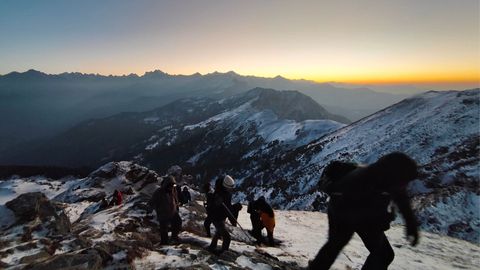
Endless acres of frosted pine and oak trees dotting the snow-capped mountains of the mighty Himalayas in Uttarakhand have the power to captivate, heal, exhilarate and humble you simultaneously. As you approach the summit of the Kedarkantha trek, a breathtaking sight awaits – a bright sunbeam piercing through towering, white hills, slowly turning the landscape into a dreamy wonderland. Suddenly, the challenging cold and the treacherous path leading to this point seem justified, making the journey worth every trial and hardship. Planning an unforgettable winter excursion in India? Here is everything you need to know about the Kedarkantha Peak trek.
What makes Kedarkantha a popular winter trek in India?

The Kedarnath Trek offers an immersive snowfall experience . The trek path leading to the summit ensures not only a full view of the snowfall in its glory but also panoramic views of the milky skyline framed by the snow-clad edges of the Himalayas. A highlight of this trek is the brilliant sunrise and the picturesque route winding through an apple field, a frozen lake, and the Govind National Park near Sankri village.
Kedarkantha trek: How to get there
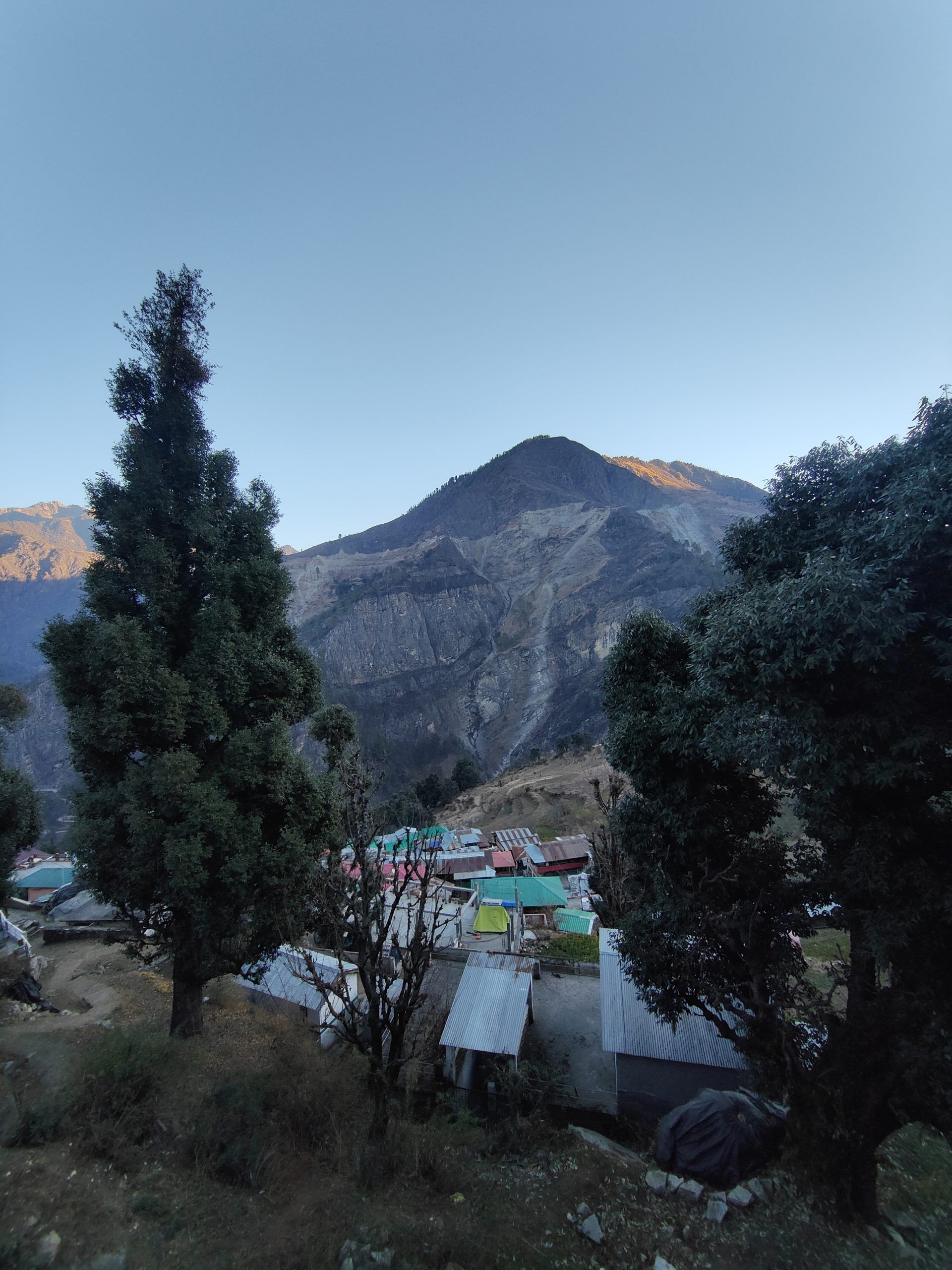
The trek’s base camp is situated in Sankri village, approximately 200 kilometres from Dehradun. The most convenient mode of transportation is a bus or car. Regular transportation is available from Dehradun to Purola, a village located approximately 54 kilometres from Sankri. Cabs can be hired from Purola to Sankri.
Sankri, located in the Uttarkashi district, not only serves as the base camp for Kedarkantha but also for Har Ki Dun and Bali Pass Trek. The journey to this base camp is known for its scenic beauty, featuring dense forests and the sparkling Tons River flowing through the village of Mori to Sankri.
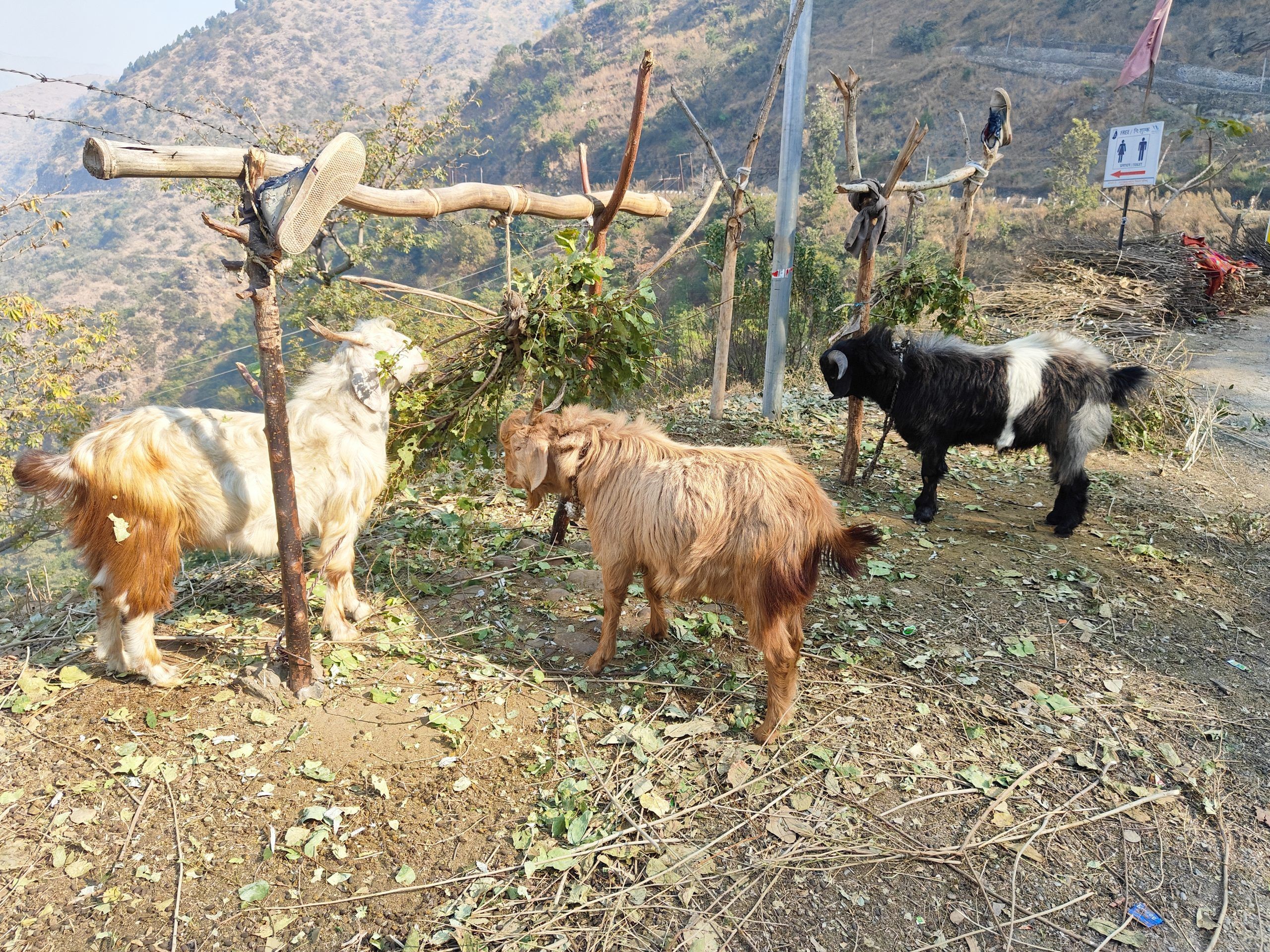
Consider staying in one of the many local homestays before embarking on your trek. Also, trekking gear, including trek poles, fleece jackets, caps, ponchos and trekking shoes, can be rented in Sankri.
Best time to summit Kedarkantha
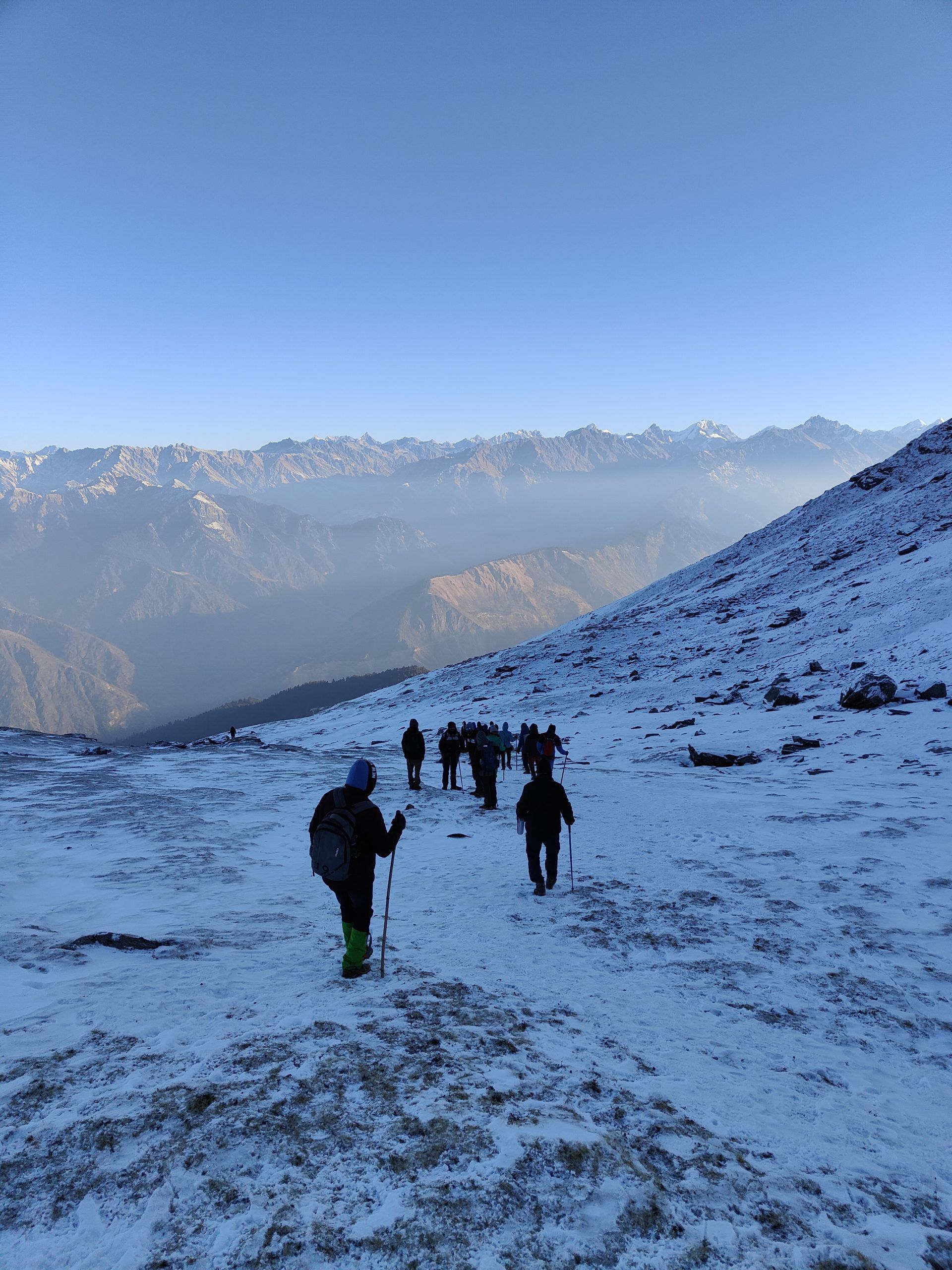
This trek is primarily a classic winter adventure , with the best months to travel spanning from December to February. The period from mid-January till mid-February offers peak snowfall. Despite being promoted as an easy-to-moderate trek for beginners, it poses a moderate to high difficulty, reaching an altitude of 12,000 feet. The trek spans three nights and four days, starting from the Sankri base camp.
Kedarkantha trek – a beautiful route
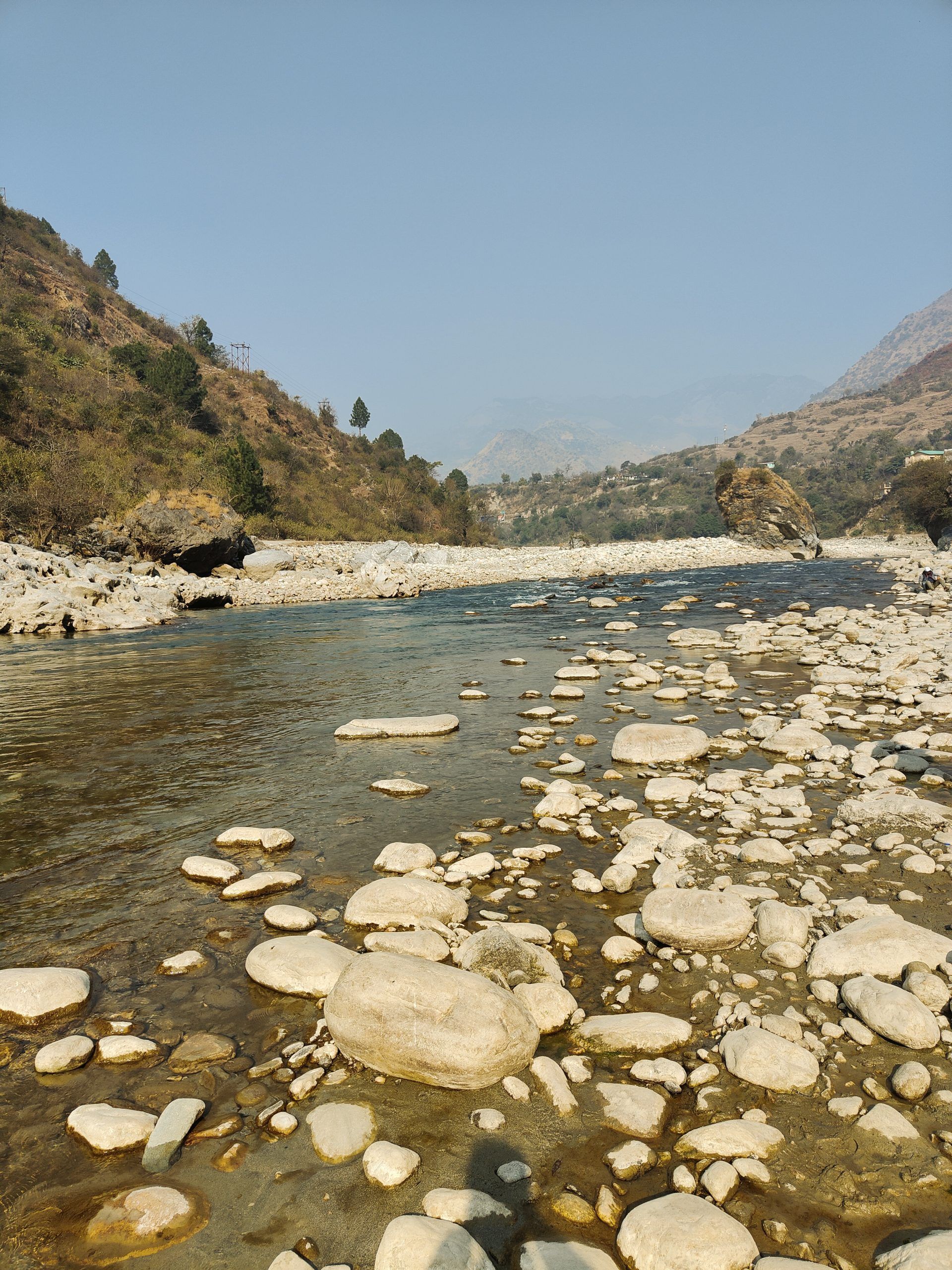
The journey begins from Govind Balabh Pant Wildlife Sanctuary in Sankri, navigating through rocky, winding paths that lead to the jaw-droppingly beautiful frozen lake of Juda Ka Talab. Although the distance from Sankri to Juda Ka Talab is only four kilometres, the ascent takes about five to six hours due to the steep trail and chilly winds. Expect temperatures dropping below zero degrees post-noon, offering a pitch-dark, star-filled sky – a treat for stargazers.
Related Stories
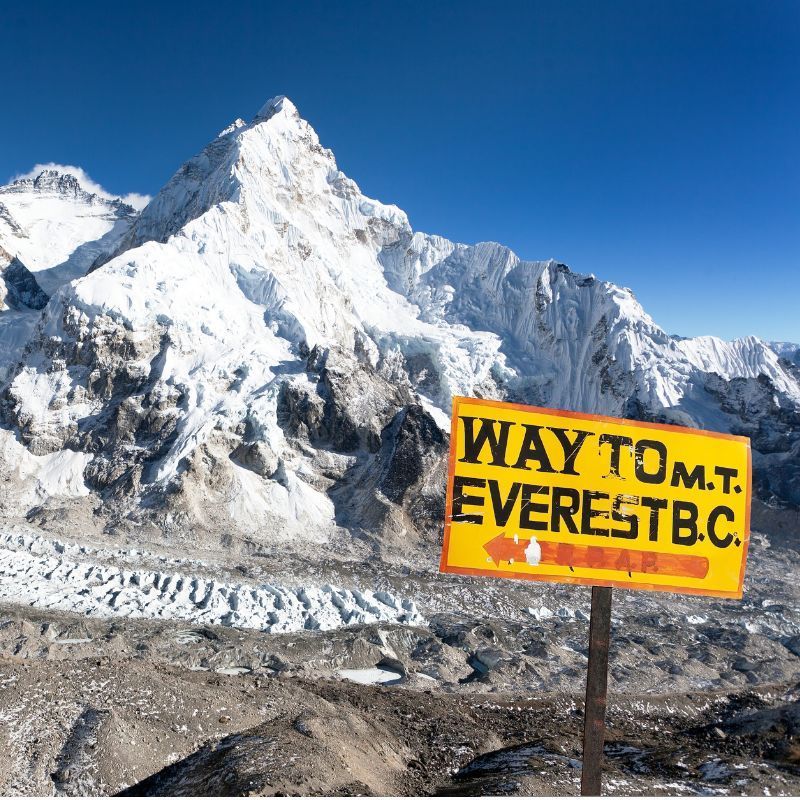
Everything To Know About Everest Base Camp Trek: Route, Essentials, Cost And Other...
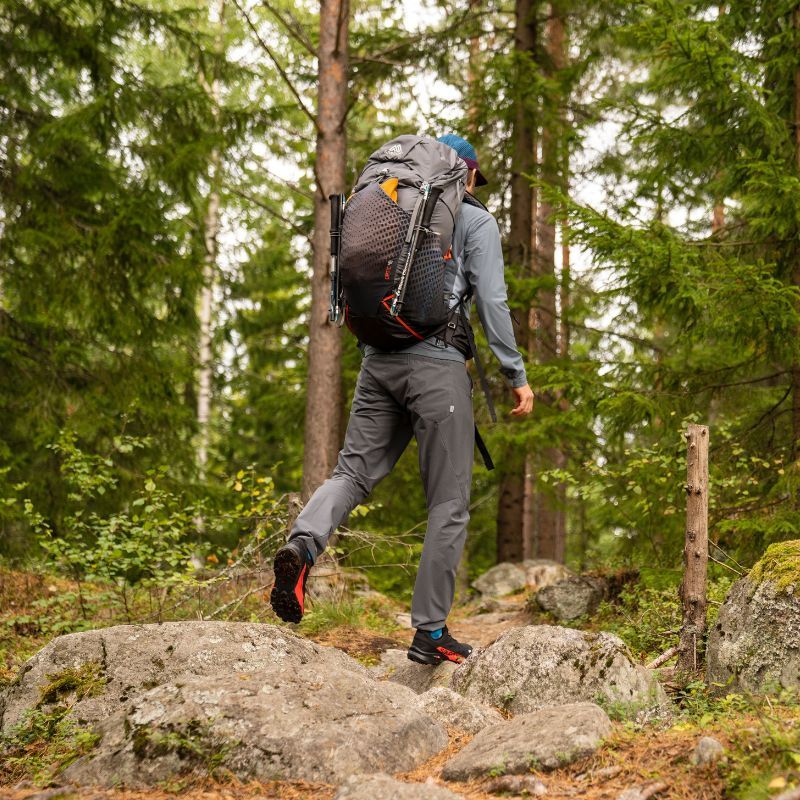
Pack These Winter Trek Essentials For A Smooth Trekking Experience
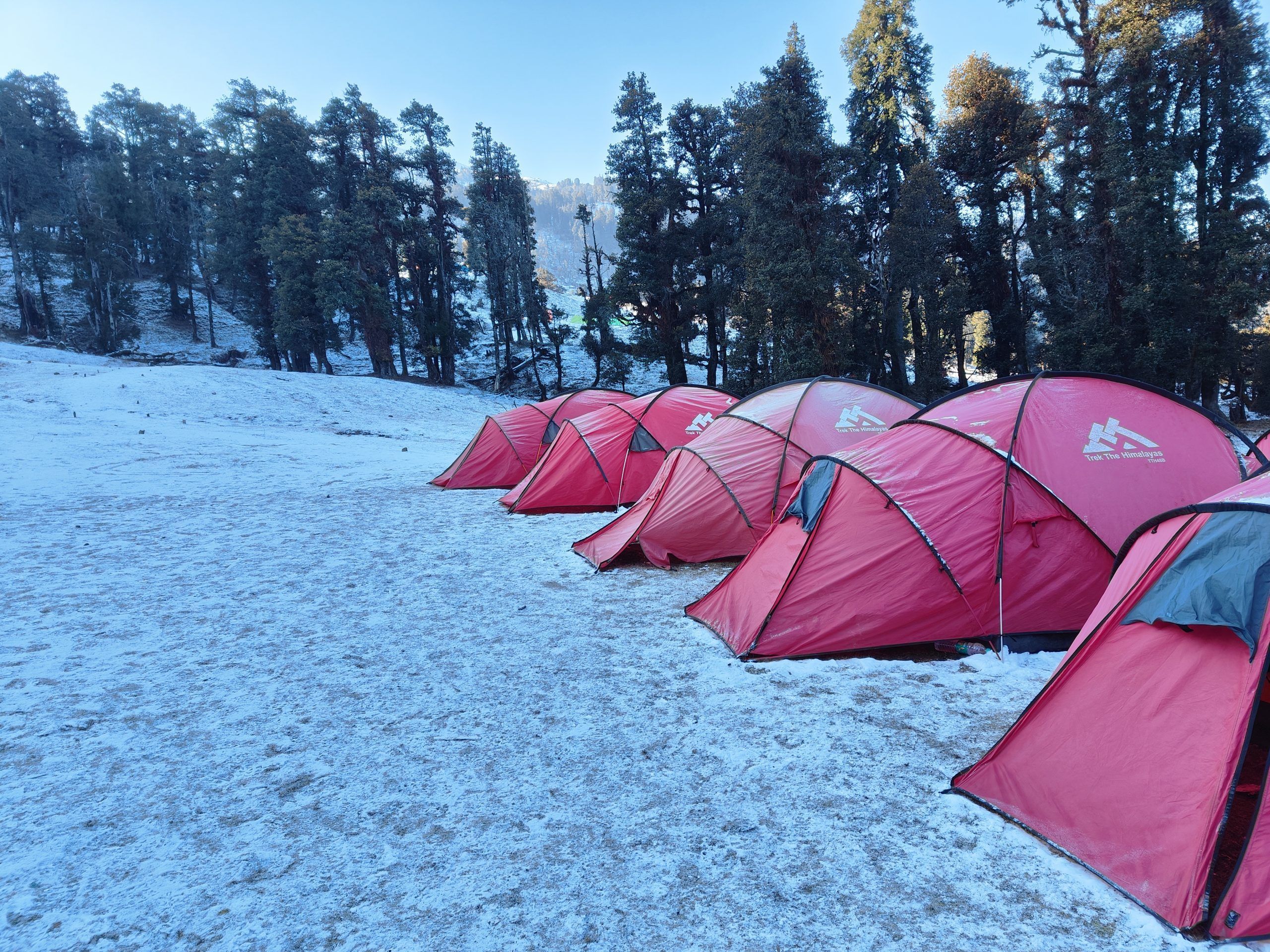
The next stop is the Kedarkantha base camp, located about 10,000 feet and around two kilometres from the village of Har Ki Dun Valley. The last leg of this trek is challenging, beginning in the early hours at around 2.00 am. The goal is to climb 1,000 feet in altitude and cover four kilometres in five hours. Steep valleys and snow-covered paths make up for a challenging yet thrilling experience. The summit rewards trekkers with a beautiful golden sunrise and gorgeous views of the Yamunotri, Gangotri, Black Peak, Bandarpoonch and Sawargarohini peaks in the Himalayas .
The descent to the base camp is comparatively easier and can be completed in around three to four hours with non-stop walking. Alternatively, trekkers can choose to camp at the lush village of Hargaon before resuming their journey back to Sankri.
Kedarkantha trek essentials: Gear, cost and more
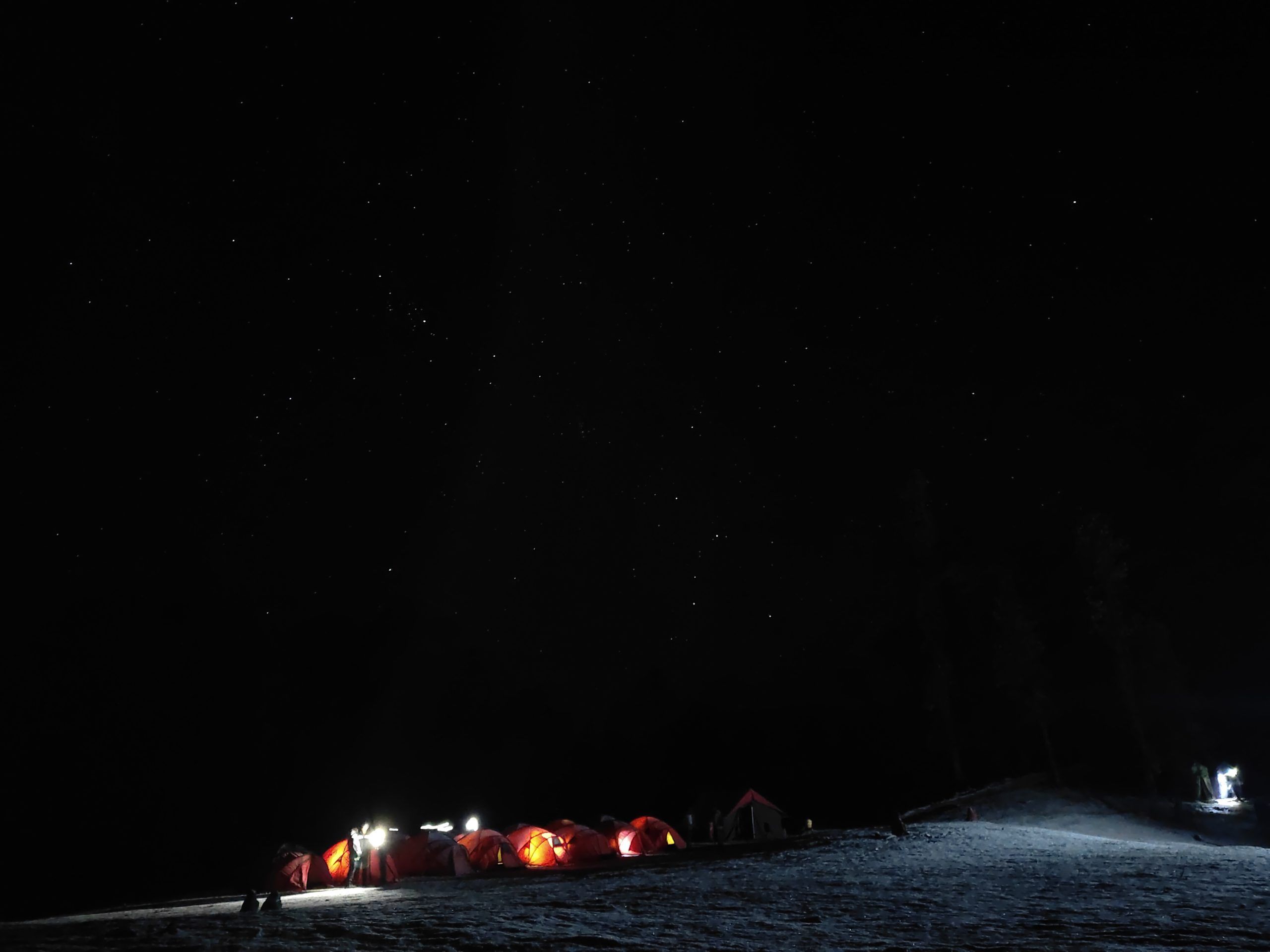
Essential gear
For beginners, mental and physical fitness is crucial to endure the cold weather and cover around four kilometres in half an hour without breaking a sweat. Winter gear, including a woollen cap, muffler, snow googles, high-quality thermal wear, waterproof t-shirts, fleece jacket, snow jacket, trek pants, woollen socks, knee-high trek shoes with anti-skid spikes, a snow pole, a small backpack containing one-litre water bottle, protein bars, ski gloves, ORS powder and a poncho for rain, are essential.
Cost and best packages
Packages for this Himalayan trek typically range from Rs 5,000 to 10,000, covering all meals, tent accommodation and sleeping bags at the camps. Additionally, one can opt to pay around Rs 2,000 for a mule to carry their backpack.
Tips and tricks for a successful trek
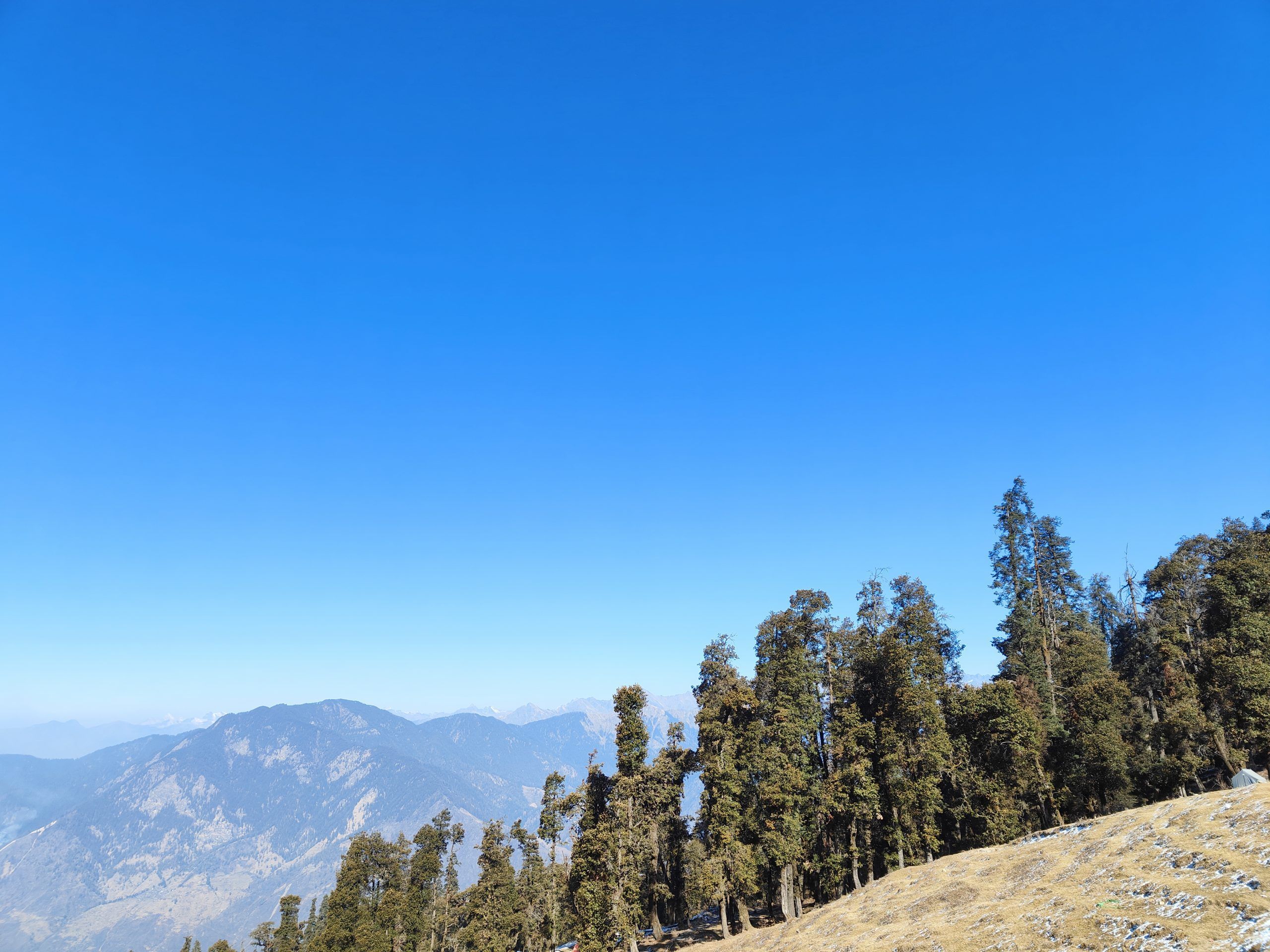
Embarking on a successful summit requires more than just enthusiasm; it requires a commitment to a healthy lifestyle and avoiding habits like smoking and drinking well in advance. To ensure a smooth journey, it’s essential to maintain a pulse rate between 60 to 90 beats per minute and a respiratory rate not exceeding 20 breaths per minute. Optimal blood pressure and good heart health are prerequisites for tackling this trek.
While on the trek, it is important not to consume excessive hot water to allow the body to acclimatise to the cold weather effectively. Staying hydrated and consuming food at regular intervals is essential to maintain good energy throughout the journey.
To prevent the onset of Acute Mountain Sickness (AMS), it is important to keep your ears open while climbing mountains and maintain proper hydration levels. Being attentive to your body’s signals and taking appropriate breaks are key strategies to ensure a safe and enjoyable trekking experience.
Shop the best travel experiences here
(Feature image credit: Preeti Kulkarni)
Related: Annapurna Base Camp: Your Guide To A Successful Trekking Experience
Frequently Asked Questions (FAQs)
-How difficult is the Kedarkantha Trek? The Kedarkantha trek is considered moderate to difficult for beginners.
-When is the best time to do the Kedarkantha Trek? The winter months from December to February are the best for this trek.
-What is the trekking duration? The trekking duration is three nights and four days from the base camp in Sankri.
-What is the starting point of the Kedarkantha Trek? The starting point of the trek is Sankri village in Uttarkashi district of Uttarakhand.
-What is the maximum altitude of the Kedarkantha Trek? The maximum altitude of the trek is around 12,000 feet.
-Do I need prior trekking experience for the Kedarkantha Trek? Prior trekking experience is recommended as the last leg of the summit could be described as difficult.
-What should I pack for the Kedarkantha Trek? Trekking gear, including appropriate clothes for sub-zero temperatures, protein bars, dry fruits, a two-litre water bottle and a good quality, lightweight backpack are some of the prerequisites for this trek.
-Is it necessary to hire a guide for the Kedarkantha Trek? This is a guided trek and it is best to go with an experienced trekking organisation that provides medical support, food and trek guides.
-Are permits required for the Kedarkantha Trek? A permit is required to enter the Govind National Park, the starting point of the trek.
-Can I trek Kedarkantha independently or should I join a group? Solo trekkers are recommended to join a group of experienced trek leaders for this expedition.
-Is there mobile connectivity on the trek? Only BSNL connectivity is available here.
-How can I reach Sankri, the base camp for Kedarkantha Trek? Sankri is around 8 to 10 hours away by road from Dehradun.
-What are the accommodation options during the Kedarkantha Trek? One needs to set up tents at Juda Ka Talab, Kedarkantha base camp and Hargaon village as there are no homestays available here.
- solo travel in India
- trek destinations in Uttarakhand
- Trekking in Uttarakhand

Preeti Kulkarni
After completing her PG in New Media from the Asian College of Journalism, Preeti worked in a daily and a magazine before finding her calling in digital journalism. A lover of single malts and an avid pop culture junkie, you can catch her at the movies on weekends or binge-watching the latest shows on OTT when she is not busy preparing her toddler for .. Read More his Hogwarts letter. Read Less
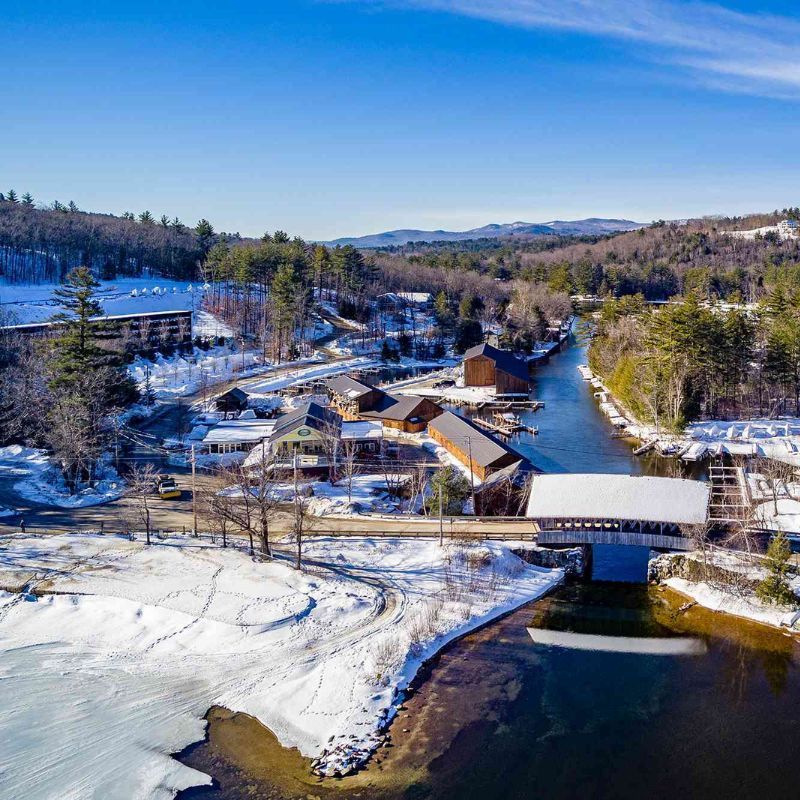
Heading To The US? Visit This Town With The Calmest Camping Spot
By Stefanie Waldek
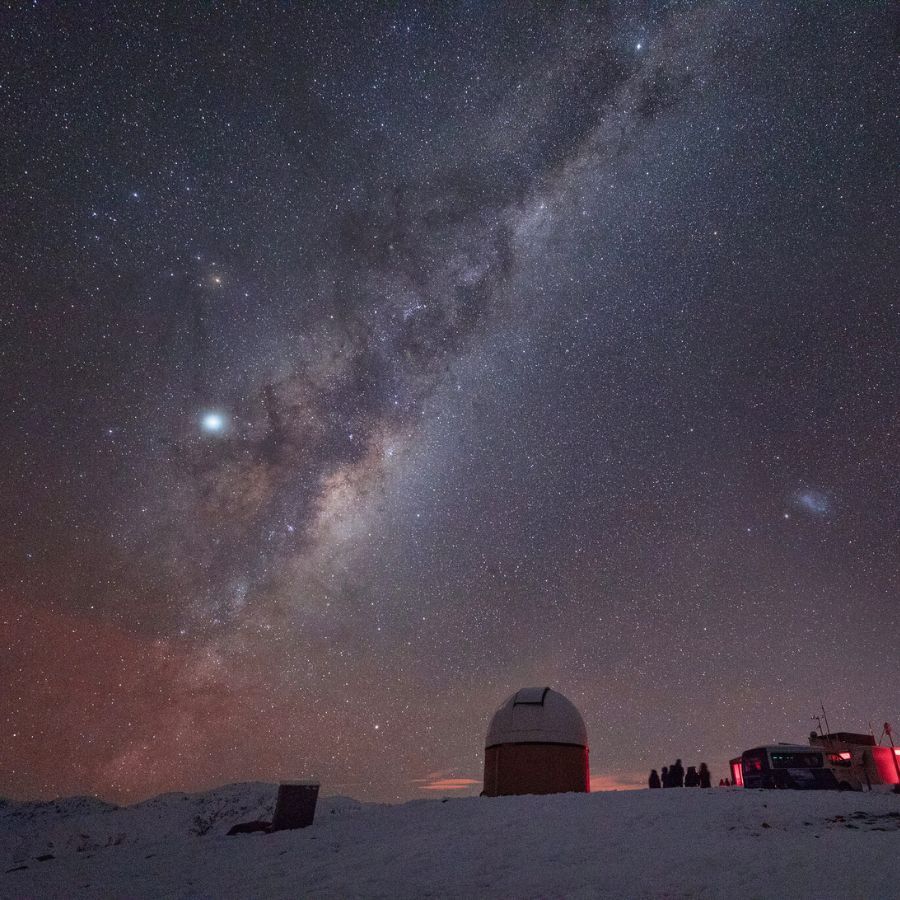
After This Masterclass in Maori Astronomy, Stargazing Will Never Be the Same
By Matt Brace
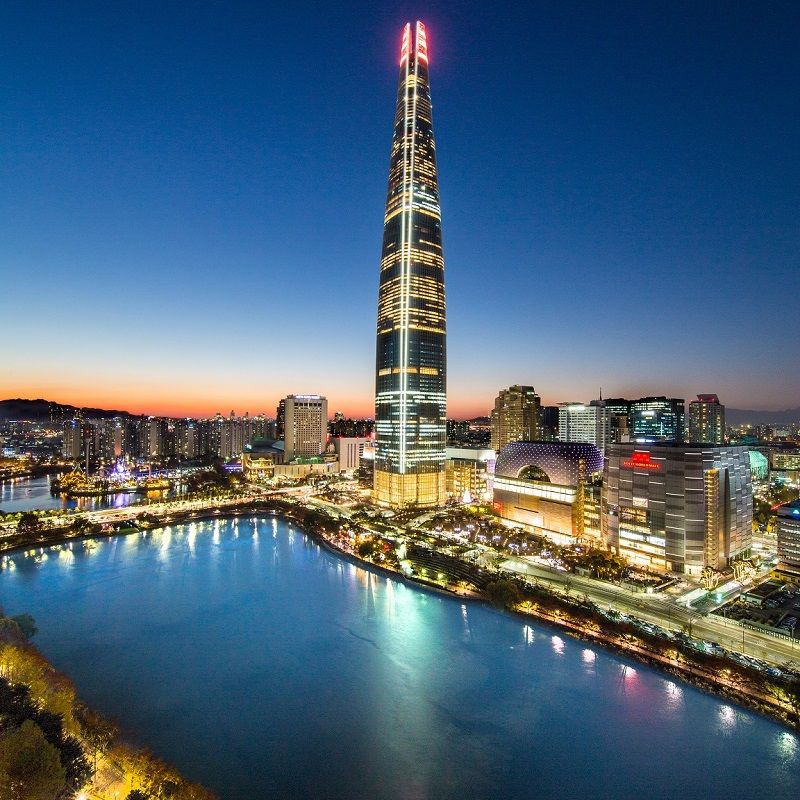
Lotte World Tower To IFC Seoul: Explore Tallest Buildings Of South Korea
By Pyusha Chatterjee
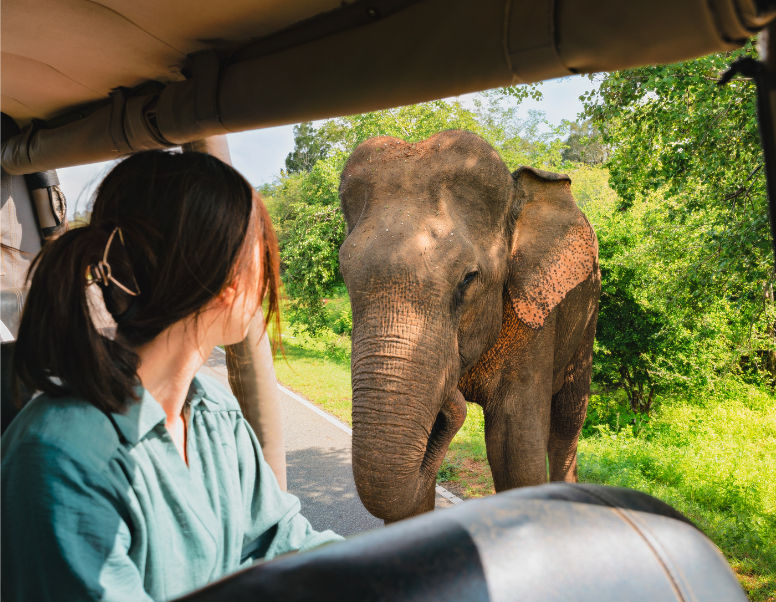
This New Jungle Hotel Puts Sri Lanka's Yala National Park (& Its Wildlife) at Your Door
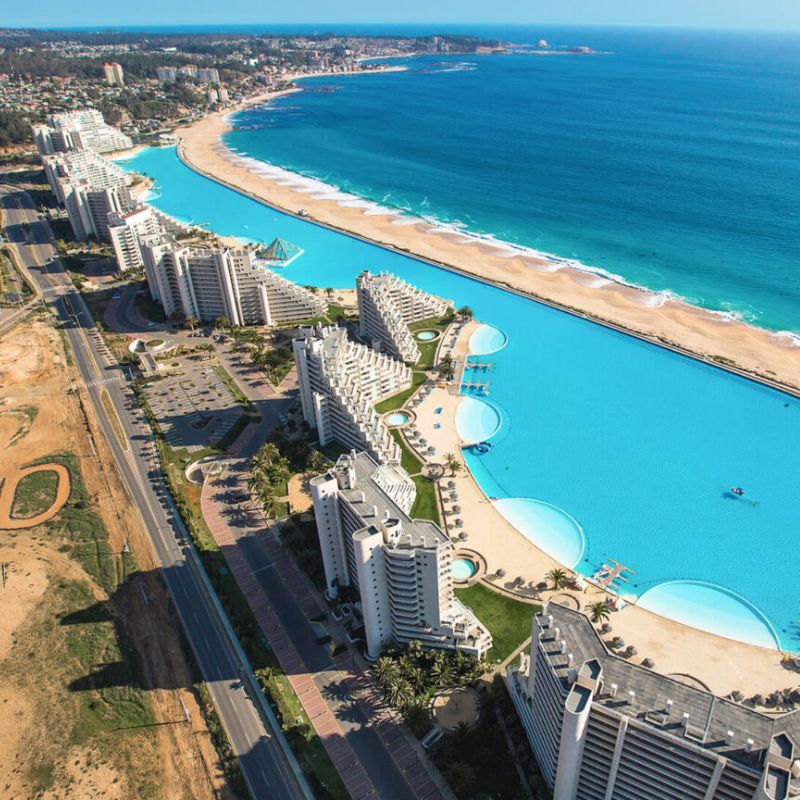
Explore The World's Largest And Most Magnificent Swimming Pools
By Aman Joshi
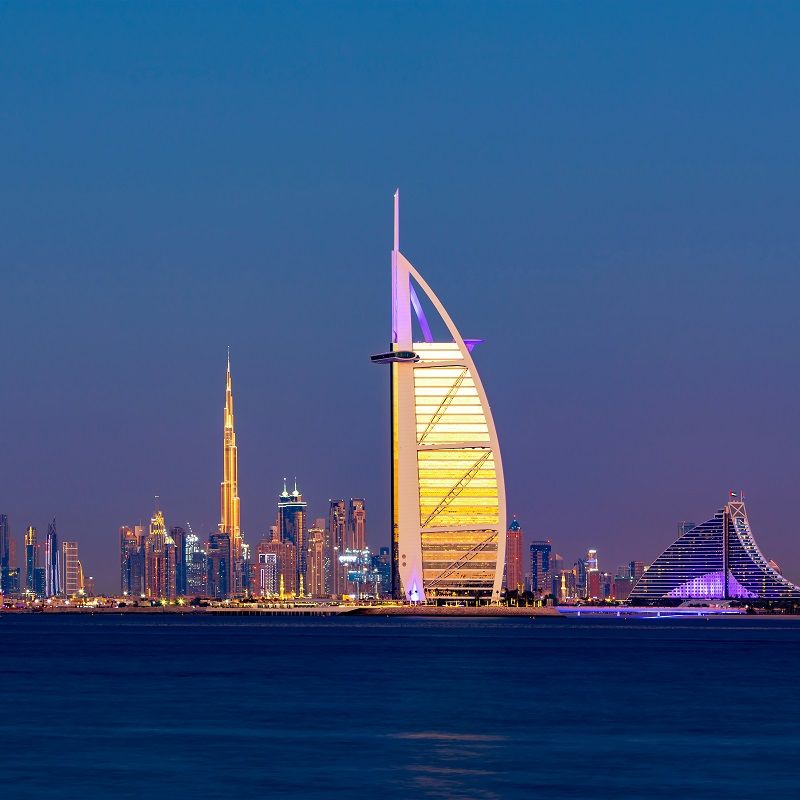
Journey Through The World's Most Spectacular Skylines
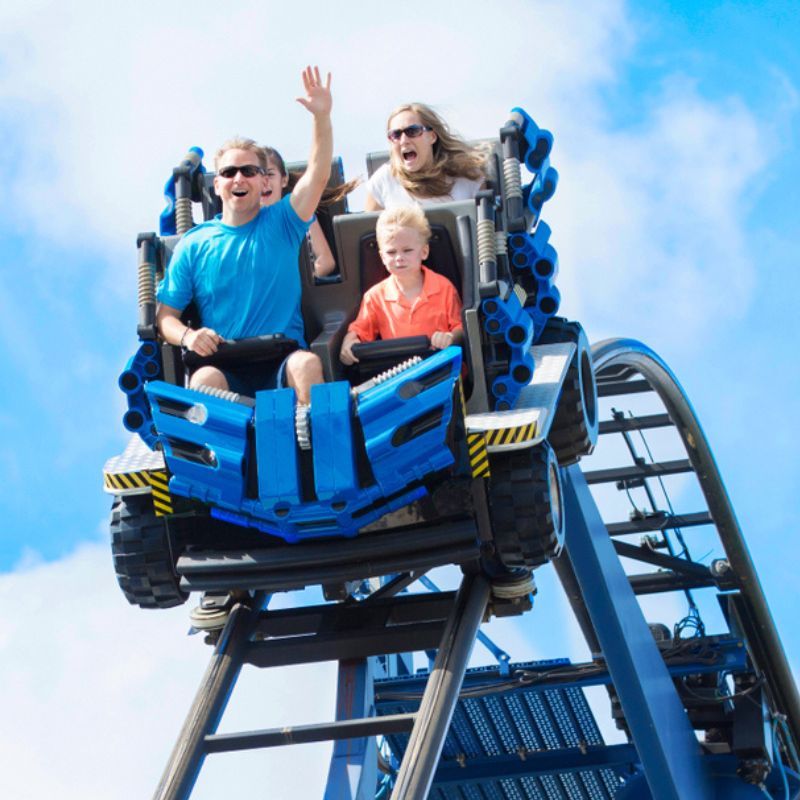
Soar To New Heights With The World's Tallest Roller Coasters
By Priyaja Bakshi
Subscribe to our newsletter to get the latest on travel, stay & dining.
You’re all set
Thank you for your subscription.

- Group Tours Calendar
- Planning, Sightseeing & Routes
- Preparing for Ladakh Trip
- Stay, Eat, Permits & Others
- Taxis, Self-Drives & Bike Rentals
- Public Transport & Budget Travel
- Preparing for Spiti Valley Trip

Kedarkantha Trek – A Comprehensive Backpacking Guide for Trekkers
Kedarkantha trek is in one of the most significant religious areas, especially in the Hindu Mythology. The Temple of Lord Kedarkantha (Shivji), which sits at the base of the summit, has stood the test of time and is revered amongst spiritual believers. Millions of pilgrims move mountains to offer their prayers and seek blessings of the Hindu Deity each year.
The temple itself lies at the base of the Kedarnath Peak, facing the Kedar Parvat. A beginner level trek , Kedarkantha is especially beautiful in the winter months. One of the most remarkable crests in the Himalayan region, both nature lovers and ardent trekkers tend to enjoy the experience.
Let's quickly dive into the details:
History of Kedarkantha
In general, Uttarakhand is splattered with great religious sights . Lord Shiv’s Bull avatar wandered in the region. He attained the form to escape from the Pandavas and meditated in the valley in his disguise. But, once his peace was disturbed due to the locals, he fled from Kedarkantha to Kedarnath.
Also, local hearsay says that the Trishul of the Lord, erected in the valley, keeps the place safe from destruction. There was ample proof in their belief in 2013 when the valley suffered great losses due to the massive floods in the region, but the Kedarnath temple was not harmed .
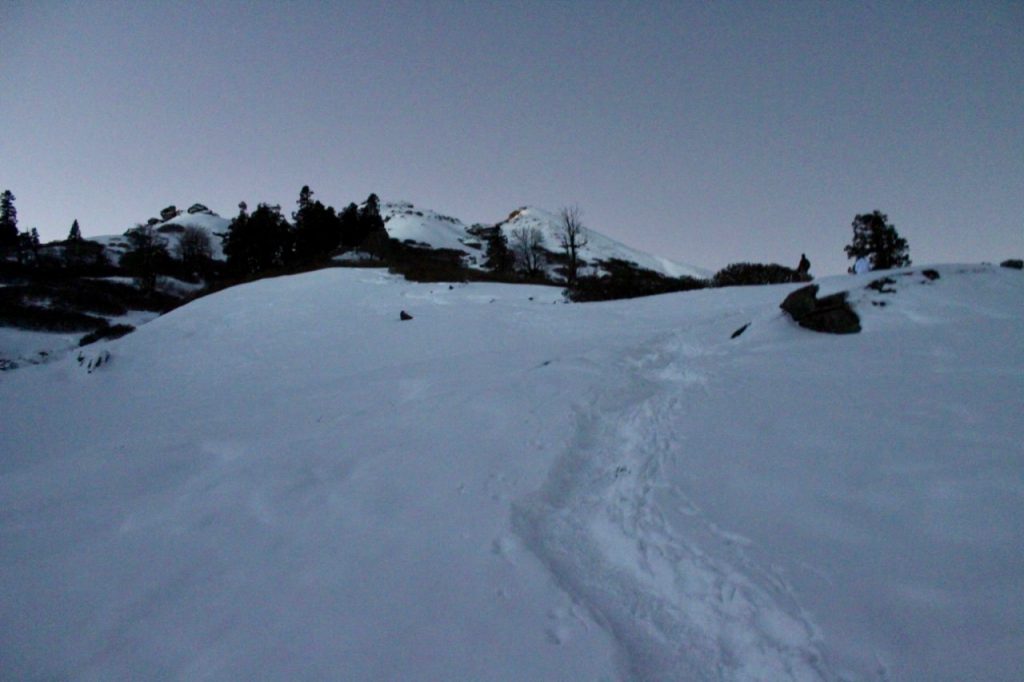
About the Kedarkantha Trek
This is one of those treks where you can climb the summit in the harsh winters. It’s a four-day beginner trek in Uttarakhand , which takes you to the frozen Juda ka Talab and the snow-clad paths. The magical sunrise from the 12500 ft Kedarkantha summit seems like heaven. You can also get the views of various peaks like Pangarchulla and Har Ki Dun from the summit.
The need to connect with your greater purpose and the belief in faith is such a connecting factor that even if you’re not a Hindu, you can feel the faith all around you. It sets the mood for when you start your climb.
The forested floors of the massive mountain peaks, with meadows of Pine Trees and possible snow kissing the hills, makes for a stunning backdrop to your communal journey. Also, right after the base camp, you’ll start witnessing stunning panoramic views all round of famous mountain summits along with the river Tons, which is fed by glaciers.
Kedarkantha Height / Altitude
Kedarkantha is an altitude of 3800 meters in height and offers a 360-degree view of Pangarchulla, Har ki Doon and Swargarohini peaks of the high Himalayas.
Best time to visit Kedarkantha trek
Although Kedarknatha trek can be done at any time of the year, it’s preferred in the winters from January to March as the trek is covered in the blanket of snow and offer some stunning snow-packed views.
It is one of those treks in India where you can easily find snowfall near Delhi in winter . Also, the trek has the most gorgeous campsites. Hence, do not forget to take your own camping gear and camp in the wild on this trek.
In the summer months of April – June, the temperature varies from 3°C to 8°C in daytime and -5°C to -1°C at night. Post monsoon season of September to December witnesses’ temperature of -4°C to 6°C in daytime and -8°C to -15°C at night. For January till April, the weather is -6°C to 2°C in daytime and -10°C to -18°C at night
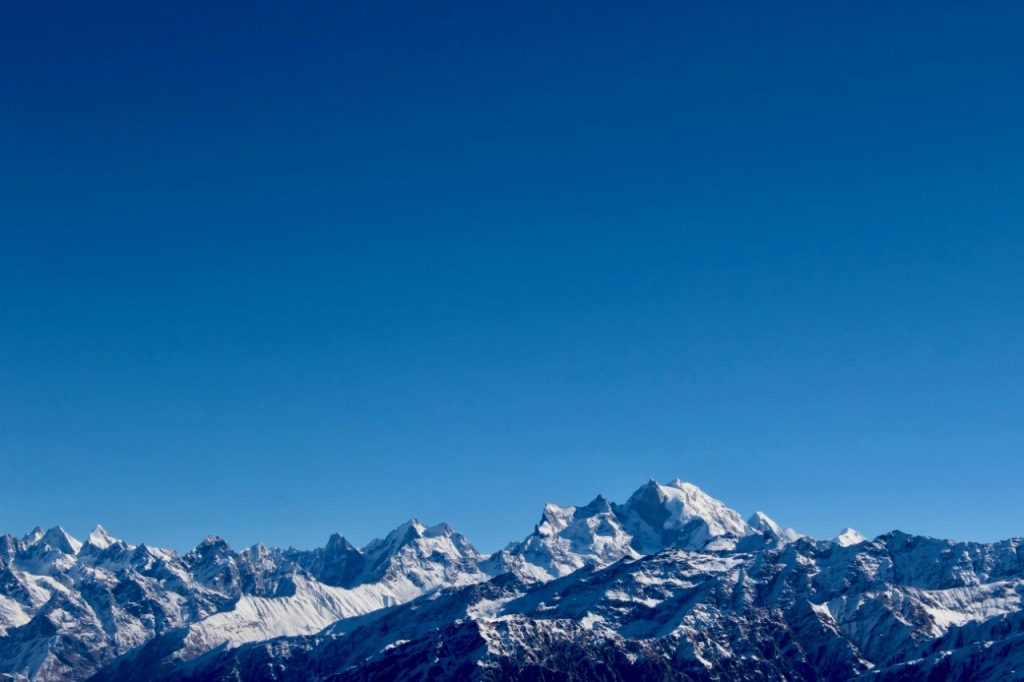
The Beginning Point – Sankri Village
You’ll have to first reach Dehradun from Delhi either by bus, train, flight, or personal transport. After that, you head to Sankri – from where the trek begins. The overall distance of the trek from Sankri to Kedarkantha peak is approximately 25 Kms, covered in a total of 4-5 days along with Juda Ka Talab.
Delhi to Sankri by road
Sankri is a small village 200 km away from Dehradun where trekking for Kedarkantha, Har Ki Dun Trek, and Rupin Pass starts. The route from Dehradun to Sankri is Dehradun – Purola – Mori – Naitwar – Sankri. The journey takes approximately 7 hours by road.
The drive is a very scenic route. Sankri village itself is steeped in natural beauty and a night stay here is a requisite. Enjoy the small hamlet!
By Public Transport
Of course, you might want to take public transport to begin your trek – for the same, there are multiple options to reach your starting point.
Dheeraj Sharma
Two buses run directly from Dehradun to Sankri, one at 5 AM and one at 8 AM from the Mussoorie Bus stands in Dehradun. Bus fare is around Rs 300/- and takes around 10 hours to reach Sankri from Dehradun. Buses run from the Mussoorie Bus Stand, which is 4 km away from ISBT and a half km away from the railway station. Dehradun is well connected with Delhi by buses anyways.
The Nearest airport is Dehradun from Sankri and then you can book a private cab or follow the bus options as mentioned in this article.

A cab costs around Rs 5500/- and can accommodate four to five people. You can book a cab from Dehradun.
You can take a direct train from Delhi to Dehradun in the night and then catch a bus to Sankri in the morning. The best option is to take Nanda Devi AC Express which leaves at 11:50 PM and reaches at 5:40 AM in Dehradun.
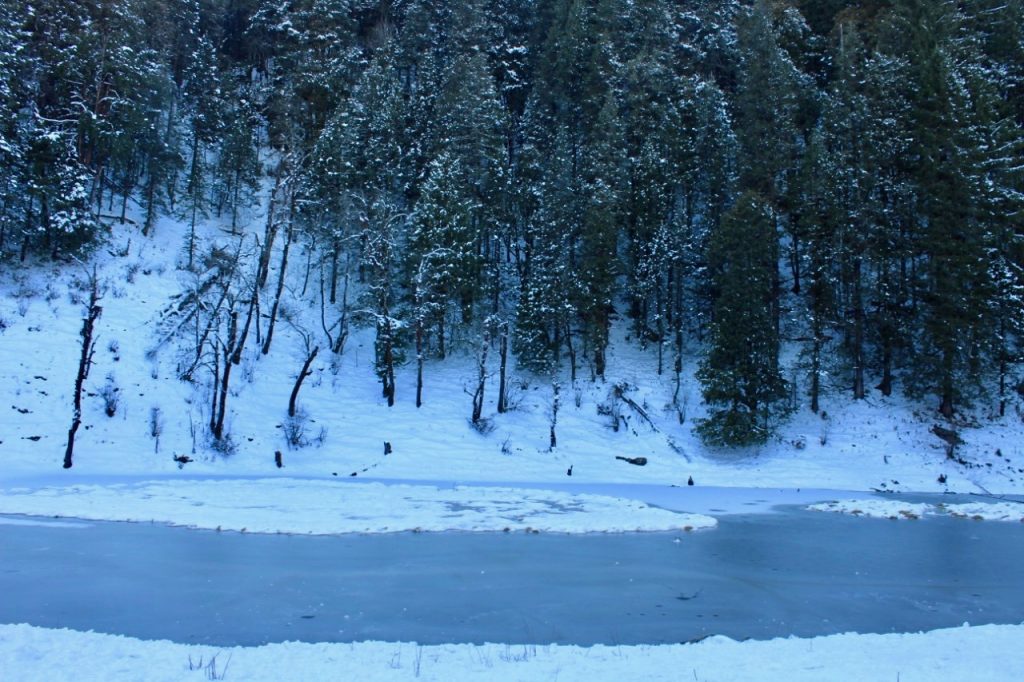
Suggested Itinerary for the Kedarkantha Trek
The best way to experience a trek is with a plan that has some room for movement. The Kedarkantha Trek ideally takes around 4-5 days and encompasses some of the greatest views and the most magnificent campsites along the way.
On most days you won’t be trekking longer than 4-5 hours, giving you ample time to relax and enjoy the beauty along with bonding with your friends. Of course, I would strongly recommend getting a guide for easing your planning requirement.
If you’re not traveling through a package tour – you might also need to carry your own camping gear . However, the Kedarkantha Trek is fairly doable, and beginner-friendly. So, dear trekkers, don’t fret and take one step forward!
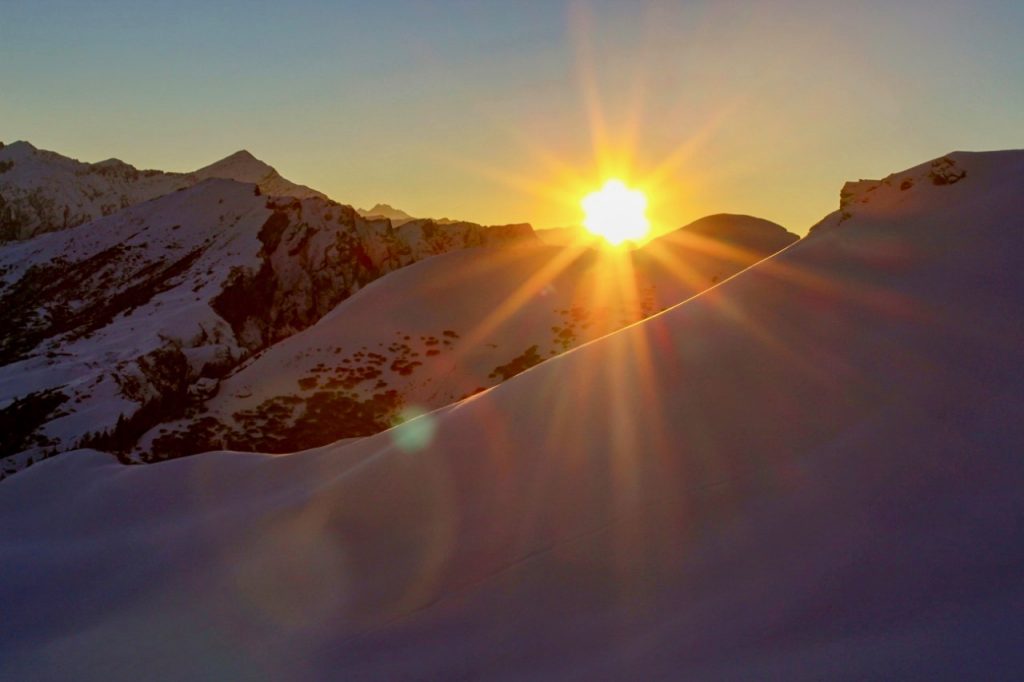
DAY 0 – Starting off
Take an overnight bus from Delhi to Dehradun in the night and reach Dehradun as early as you can in the morning. You can choose to spend some time exploring Dehradun – but honestly, there is so much awaiting you that it is best to push for Sankri. Try reaching before sunrise (taking into consideration your pitstops and leisure time in between). A must is to have your lunch/snack break in Mussourie . The views are insanely green and purely perfect.
DAY 1 – Reaching Sankri
Take the first bus/ drive over to Sankri, which will take around ten hours to reach. If you miss the first bus, then you can take a bus to Purola or Mori whichever is available and then take shared cabs to reach Sankri. There is a forest permit that is needed before you enter Sankri. You’ll have to fill up the details and have a photocopy of your ID. After reaching Sankri, get a room or find a whole package for the trek as per your choice.
You should also check the Trek to Gaumukh – A Step by Step Guide
Day 2 – Sankri to Juda ka Talab
The first campsite is Juda ka Talab which is around 4 Km from Sankri. The starting point of the trek is local Sankri road, through an extension called Sor and then entering into the local trails. This path is the road leading up towards Kedarkantha. Initially, the climb will test you by making you climb multiple bridges through a densely forested area.
From the sharp contrast of your city life, this view will be guaranteed to have you mesmerized. The trail is a little steep at certain points before ultimately entering into the dense forests of Himalayas. A common sight, especially in the remote villages along the way, is of local folks carrying wood & dry leaves on cattle for domestic usage.
Juda ka Talab is based at an altitude of 9100 ft, and the total time it would take you to achieve this milestone is ~4 hours. Around here, you will also sport Langoors swinging about in the trees. They often like to keep to themselves and might vanish before you register their presence. While winter will have a deeply majestic brown & snow around the region, summer months will witness lush greenery and hilly flowers unique to the region.
There are two tea shops between the trek where you can have breakfast. Juda ka Talab campsite is frozen in the winters and gives some astounding views. It takes around 3 hours for a fit person to complete this part of the trek.
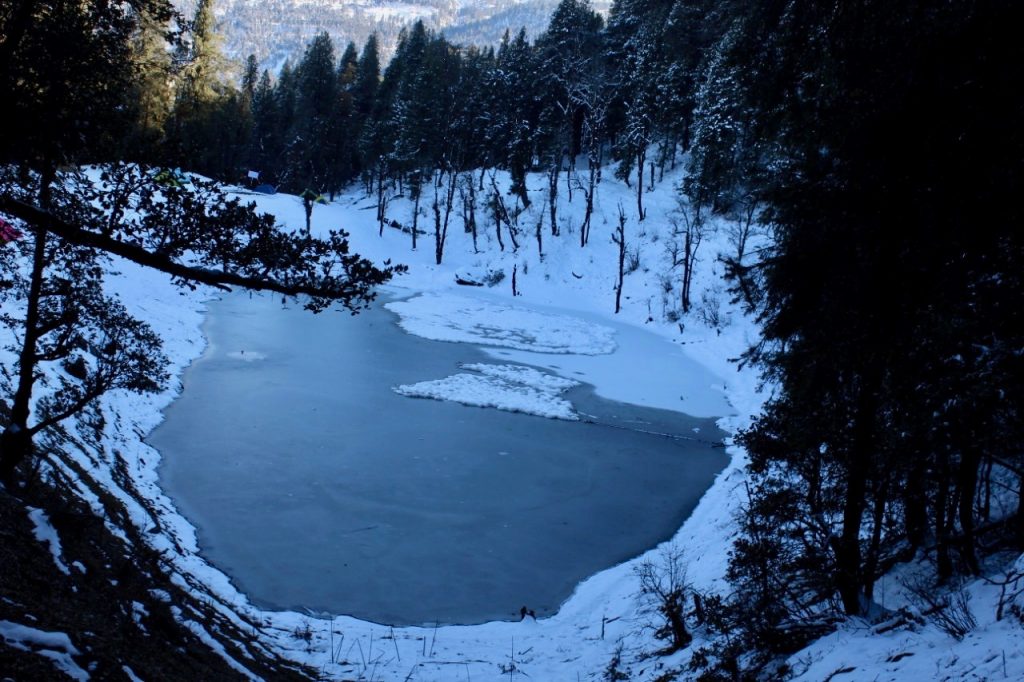
Day 3 – Juda ka Talab to Kedarkantha Base camp
Kedarkantha base camp is also four km away from Juda ka Talab and takes roughly around 3-5 hours to trek, depending upon your fitness and skill. The trek starts from pine and oak trees and then enters into the open mountains. The trail is wide and visible, making for great sightseeing and daydreaming (Can you daydream about what you’re currently experiencing?).
At some points, you will cross some deeply dense forests and steep ridges. With views of shepherd huts in stretched out meadows, and now becoming a common fixture of the views, you make your way towards the base camp. Views include Bandarpoonch, Swargarohini , Kala Nag, and Ranglana – be prepared to be mesmerized.
Kedarkantha peak is visible from the base camp. Kedarkantha base camp is at the height of 11,250 ft in open highlands. This campsite is the finest in the region and gives picturesque views of Dhaulandhar ranges. Since you’ve gained considerable elevation in your three days, it is important to rest and acclimatize yourself as the next day is the summit day.
You should also check the Tungnath – Chandrashilla Trek – A Step by Step Guide

Also, it is mandatory to stargaze – the sky to crystal, the night will enchant you no bounds. However, remain cozy and bundled up throughout and spend the night INSIDE your tents to ensure fully-swinging health.
Day 4 – Kedarkantha Base to Summit; back to Hargaon campsite
So, today’s the day – let’s conquer come mountain peaks, you all! You’ll be climbing from 11250 Ft to 12500 Ft today while reaching back to 8900 Ft at Hargaon Campsite. Since it’s a long day today, as you’ll have to make it to the summit and then back to the Hargaon campsite, you must start your day EARLY (some might argue it is not even the next day. But, oh well, such is the life of a traveler – next day begins when you wake up). Overall the journey is 6 km and should be covered in 7-8 hours.
The trek starts with the gradual ascent, which offers some magnificent views of the snow-covered mountains. You’ll have to cross three hillocks to reach to the peak, and the trek becomes around 75-80 steep at some points. This part of the journey is relatively easier in comparison to the previous days. However, near the end of your climb, you will find the trail becoming more challenging.

N ormally, in the winters sunrise takes place at 7 AM in the morning. Start early as can in the morning around 3 AM so that you can reach in time to witness the most beautiful sunrise of your life.
At the TOP of Kedarkantha!
Kedarkantha summit offers 360-degree arresting views of Himalayan ranges mixed with white and dark blue clouds. There is a small temple dedicated to Shivji and Goddess Parvati, with a small shrine for Lord Ganesh. Take your time, relax, and soak in the free views to your heart’s content – it is hard to describe in words the sights only your heart can capture.
You should also check the Trek to Deoriatal – A Step by Step Guide
After watching the sunrise and spending some time at the summit, get back to the Kedarkantha base camp and then trek down to the Hargaon campsite. It takes around 1:30 to 2 hours for a normal person to reach from base camp to Hargaon. The trek is further amplified thanks to the multiple clearings in the dense forests that lead you to breathtaking views all around.
I would suggest getting to your campsite at Hargaon and, if permissible, arrange for a bonfire to mark the end of your spectacular journey. Be a responsible traveler when making the bonfire and follow/respect the forest rules.
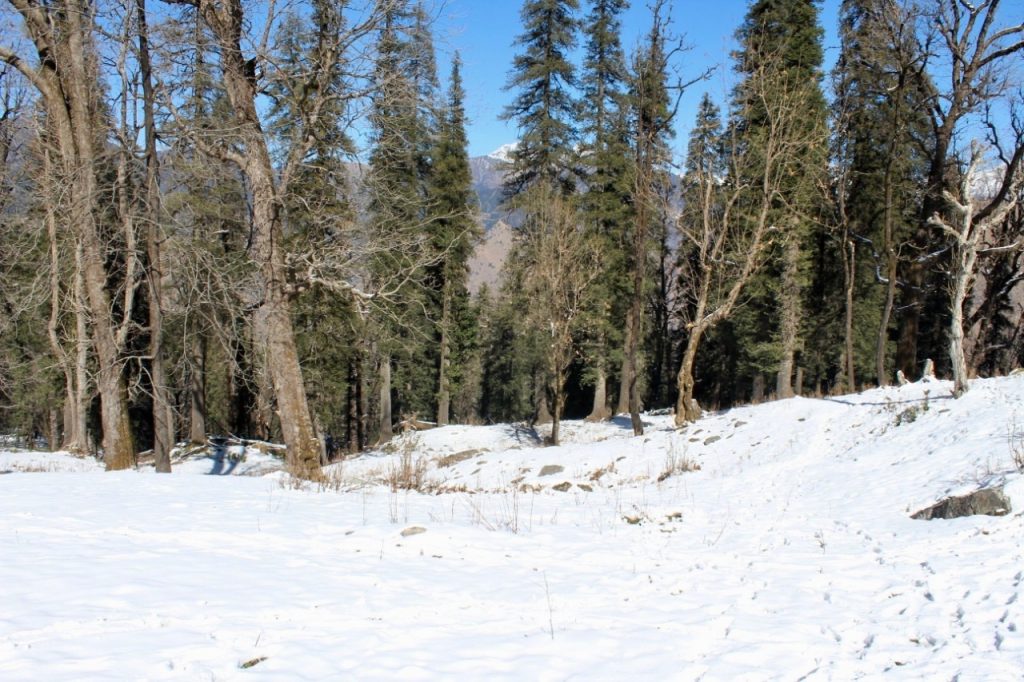
Day 5: Hargaon to Sankri
Sankri is 6 km from Hargaon campsite, but it does not take a lot of time as you’re mostly descending. The journey you can easily cover in 2-3 hours. This final leg will take you down from 8900 ft to 6400 ft. The trail is well marked paved route in between the beautiful nature.
In between the trek from Hargaon to Sankri, you get some splendid views of Har ki Dun valley. Your target should be to reach Sankri by midnight, And if you’ve booked a cab, then you can leave immediately for Dehradun. If you’d like the public transport option, then you can stay one more night and catch the bus in the morning for Dehradun. There are two direct buses from Sankri at 5 AM and 7 AM and take 10 hours.
Accommodation along Kedarkantha Trek
There are various cheap homestays which you can find easily on the trek. Most of the time homestays are easily available but there might be a problem in the peak season.
If you are taking any package, then that agency will provide you the stay itself, and if you are doing this on your own, it’s better to book it online. You can get rooms as low as INR 500s and high as INR 2000.
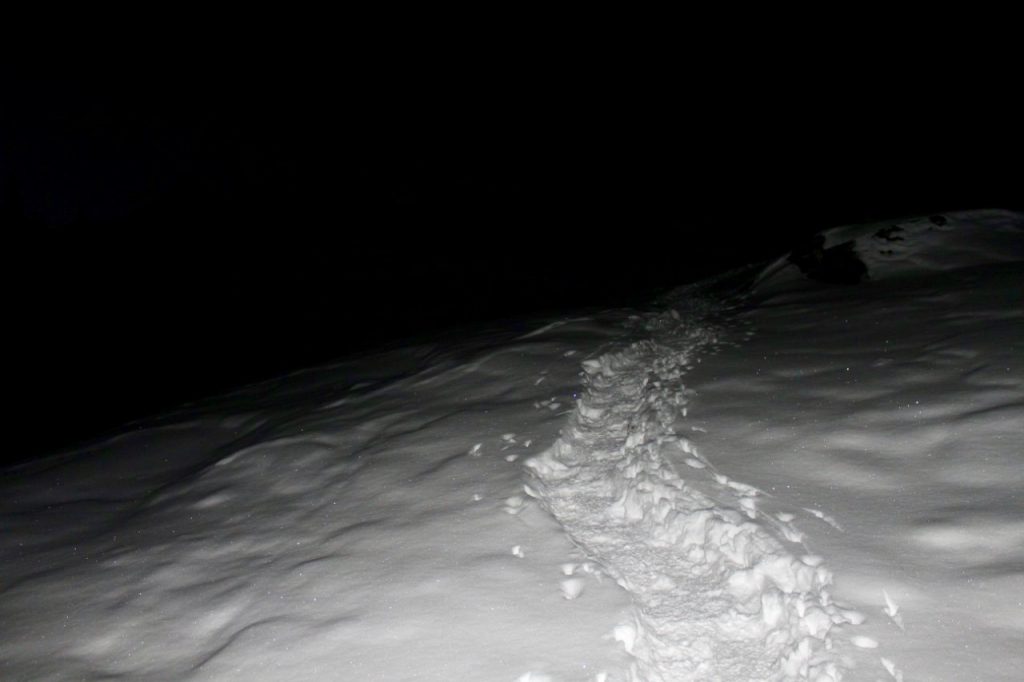
The trek is so beautiful because of the especially beautiful campsites that help you in rejuvenating. This beauty is a unique trait for the region. Walnut and pine trees surround the Akroti Thach campsite, and it is so alluring
Also, the Pukhrola campsite is literally in an open meadow with the summit in clear view – such an absolute delight. You’ll remember your sleepovers almost as much as your trek itself. Stargazing is a must in the meadow
Food options on Kedarkantha Trek
While there are various food options available in Sankri, on the trek, there are very few tea shops that provide basic food. There are two shops before the first campsite which provide tea and Maggi and one on the Kedarkantha base campsite.
If you are trekking on your own, carry food of your own. Also, ensure you carry your own water bottle (Let’s please note pollute the Himalayas- there are no cleaning crews climbing up our pristine hills – let’s vow to keep ‘em clean!) and fill it up when possible/available.
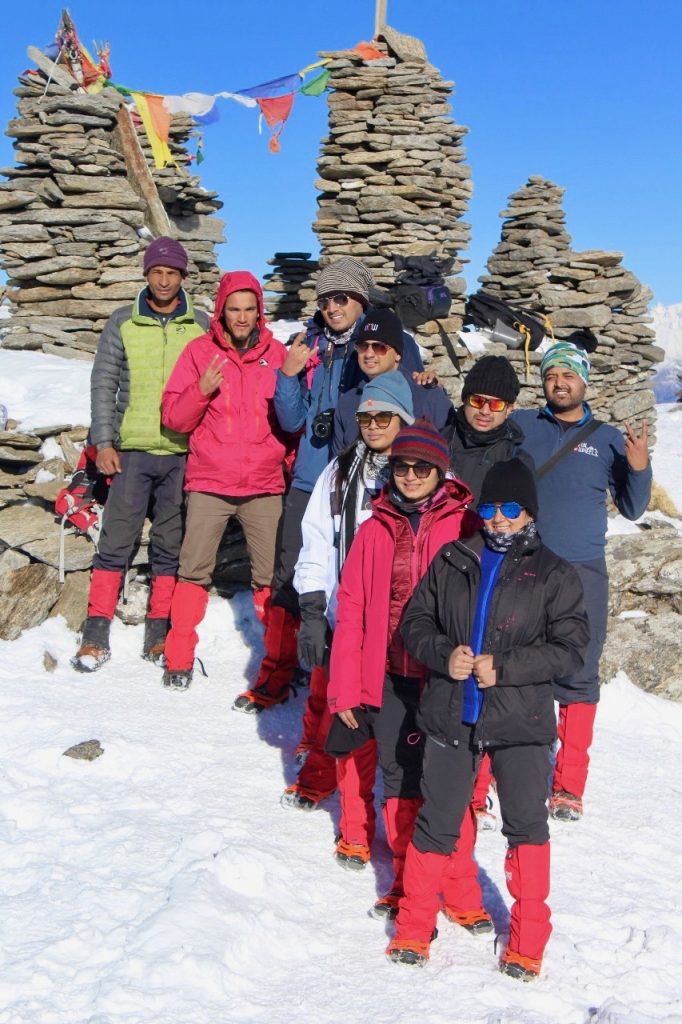
Other Important Tips
Of course, there are some other considerations for any travel we might be planning – some are as below:
ATM availability near Sankri
There are no ATM’s available in Sankri. The last place where you’ll find ATM is Purola. Hence, make sure you are carrying enough cash with you.
Mobile Network at Kedarkantha trek
There is only BSNL network available in Sankri, and as you move above on the trek, there are no networks available. Of course, I am a strong believer that this is how it should be – when you’re trying to connect with yourself/ nature and be more present – why do you need cellphones to distract you and unwarrantedly take your attention?

Other Things to keep in mind
- The availability of a guide is a must for the Kedarkantha trek unless you are a professional. Mountains can be harsh sometimes so, please take a guide with you.
- There are very few water sources on the Kedarkantha trek, and the chances are you might miss most of them. This reason is why the guide is most important on this trek.
- Do keep proper trekking gear for this trek. In the winters, temperature drops to -10 degrees C. Carry a lot of layers that can keep you warm in the high temperatures .
- Proper hiking trekking shoes are a must to do this trek. Forclaz 500 is one of the best shoes which I’ll suggest.
- Please take all your trash back with you to Sankri. Let’s keep these mountains clean for our future generations.
- Normally, travel agencies charge from INR 6000 to INR 9000 for four days of trekking for a roundtrip from Sankri, covering the Kedarkantha Trek and back to Sankri.
- You can get all the trekking equipment like tents, sleeping bags, trekking shoes also on rent from Sankri if you want. The shop is at the front when you enter Sankri.
- You’ll have to take your tent and food if you aren’t traveling with any travel agency.
- Crampons and Gaiters are must need for this trek in winters.
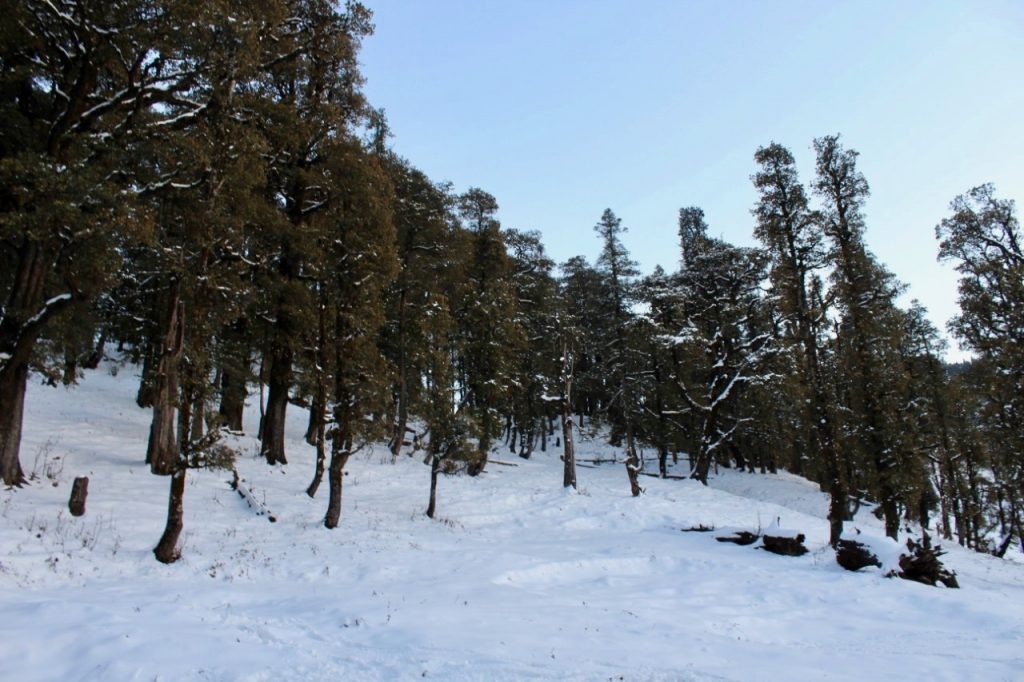
It is a magical experience, getting to complete the Kedarkantha Trek. I hope the above information will help you plan your trek to Kedarkantha. Be safe, and have an amazing trek. If you have any other questions about this trek, then you can ask them in the comments, and we’ll try to help you in every way possible.
Have a travel question?? You can subscribe to my YouTube channel and leave a comment to ask your travel questions on traveling to the Himalayas.
In case any of your friends or families are planning to undertake this trek, please feel free to share this article with them.
Happy Trekking!
Shefali spends most of her time day dreaming about her next big vacation. A happy-go-lucky personality, she is an amalgamation of all the places she’s lived in and experienced! She is always confused as to where to call home, having lived in Chandigarh, Shimla, Dehradun, Mumbai, Hyderabad in India and Vancouver, Abbotsford in Canada. Her love for travel is only challenged by her love for reading and eating delicious food! In order to sustain her dreams, she brought out her inner geek, got an MBA and has a job in the corporate world crunching numbers. Do follow @notravelplans on Instagram for updates on her next great adventure.
Related Posts
Sethan valley – the most complete guide, chindi & karsog – an offbeat place travel guide [himachal pradesh], garhwal in uttarakhand – most common itinerary [day by day plans].
Comments section gets closed in 90 days. To ask your travel questions, you can follow my YouTube Channel for a faster reply or for a much slower reply follow me on Instagram . :)
You definitely should!
An amazing journey I wish I could go there
Type above and press Enter to search. Press Esc to cancel.
Privacy Overview
Ad blocker enabled.
Beat the Heat - with the best summer destinations in Uttarakhand : Chopta - Nainital - Mussoorie - Kanatal - Dhanaulti - Chakrata - Auli - Kausani - Mukteshwar - Chaukori - Pangot
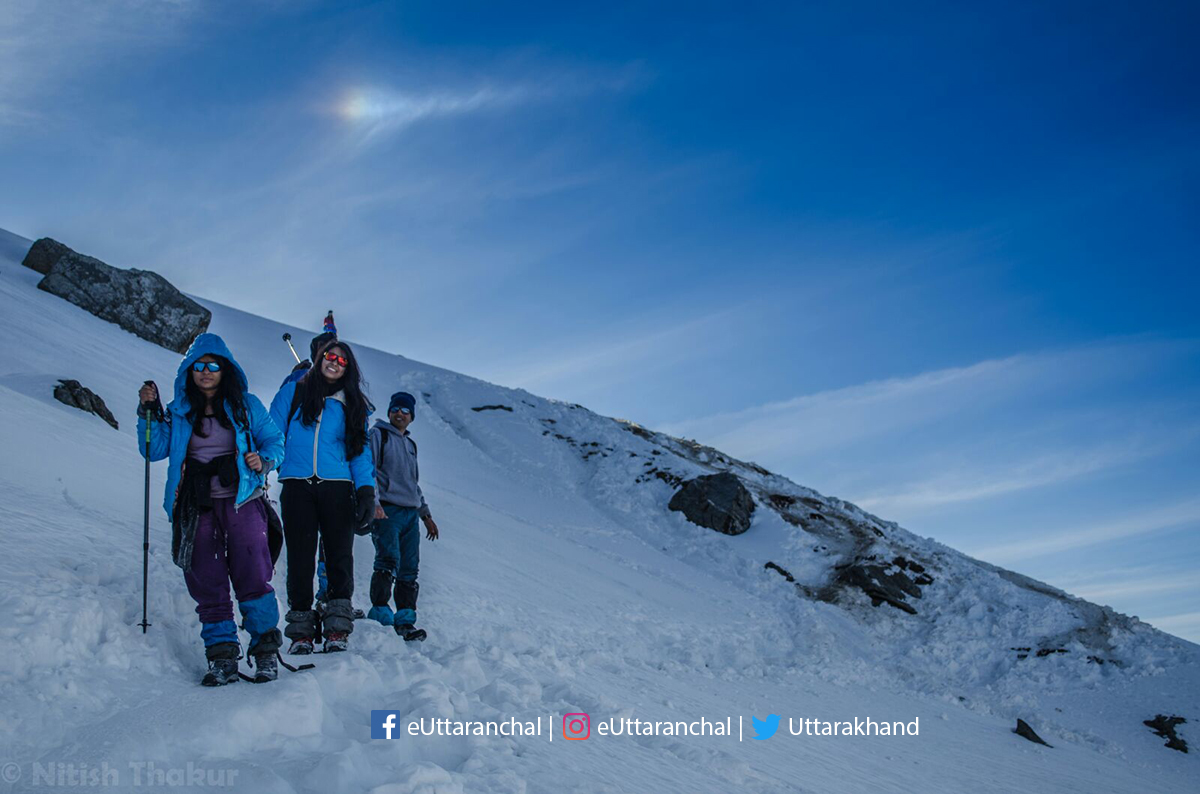
- Kedarkantha Trek
- Uttarakhand
- Uttarakhand Tourism
- 5 Places to See
- 10 Tour Packages
- Send Enquiry
Kedarkantha - Best Winter Trek
One of the most popular winter treks in Uttarakhand , Kedarkantha Trek is a trekker’s delight and rookie’s rite of passage due to its relative ease. Covered in sparkling snow during winters, this trek offers breathtaking view of the majestic Himalayan peaks.
Get Kedarkantha trek guide, Kedarkantha trekking route, winter travel tips
- Kedarkantha Trek Tour Packages
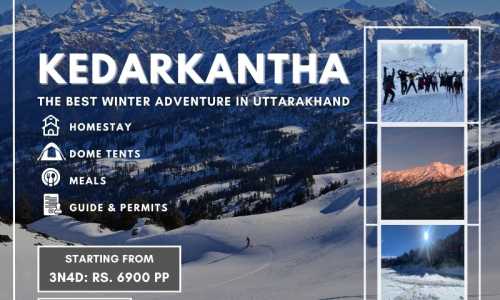
- Places to See
- Tour Packages
- How to Reach
Kedarkantha - Feel the Bliss of Lord Shiva
At a towering height of 3800 meters, Kedarkantha is a majestic peak located in Govind Wildlife Sanctuary of Uttarkashi district in Uttarakhand . Dedicated to Lord Shiva, Kedarkantha is one of the most popular treks in Uttarakhand due to its relative ease of access and gradual inclination.
Kedarkantha trek gives you the unsurpassed beauty, magnificent views of charming villages, meadows, snow paths, dramatic landscape dotted with lovely lakes, mountains, tranquil rivers and the great Himalayan peaks.
The Kedarkantha trek also provides a great opportunity to view the scenic beauty and feel the experience of the life of remote villages of Uttarakhand Himalayas. It also offers trekkers a unique opportunity to experience the life in the remotest of villages in dead winter!
About Kedarkantha Winter Snow Trek
The Kedarkantha trek is a sheer delight for the mountain lovers who wish to explore every inch of the terrains. Commencing this trek will be one of the best decisions of yours as the meandering trail will take you through the dense blue-pine forests that will soon open up to a gorgeous view of the alpine meadows, covered with fresh winter snow from December to April.
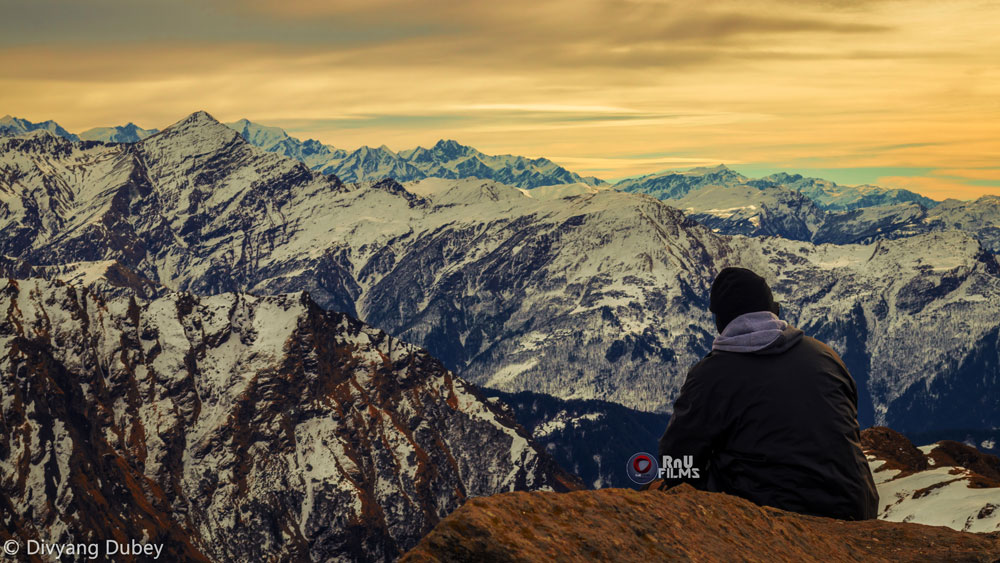
Kedarkantha has some of the scenic campsites including Juda ka Talab , Kedarkantha base and Hargaon where you can have a pleasurable stay. You can also feel the bliss of having a crunchy walk on the carpet of withered brown leaves. On conquering the summit, you can feast your eyes on the stunning mountains of Garhwal pecking the morning sky with their snowy peaks.

Why Kedarkantha is one of the best Winter Treks?
Kedarkantha is covered with snow from December to April, so it is one of the best winter treks in Uttarakhand. The meadows of the area are covered with the white blanket of snow and that's what makes it a mesmerizing trek in Uttarakhand. You can also check winter pictures of the Kedarkantha trek as well.
Being at an elevation, Kedarkantha receives snowfall is plentiful and is one of the best winter treks in Uttarakhand which offer a mesmerizing view of the Himalayan skyline.
Experienced trekkers would recommend the trek to Kedarkantha to anyone who is relatively new to the uncertainty of the wilderness but still want to explore. It is also one of the few treks that are open to visitors all year round. For trekkers who love snow, Kedarkantha trek in winters is a viable option.
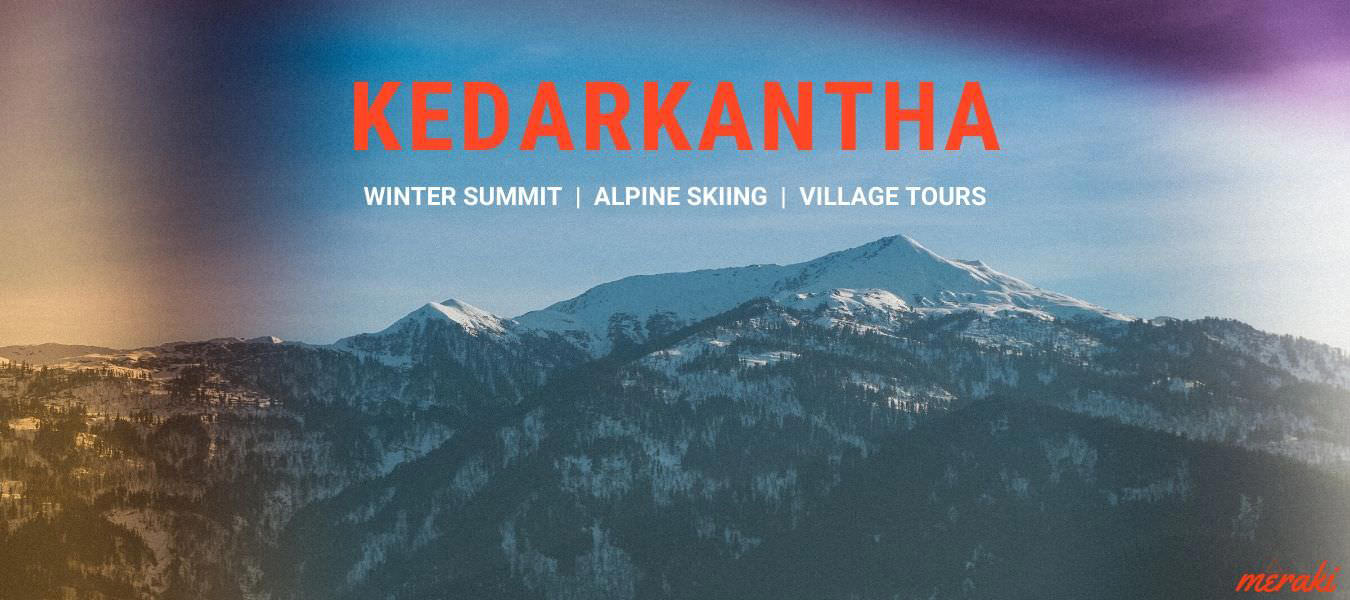
You can also enjoy skiing in Kedarkanta base camp and slopes over there during winters.
Short Itinerary of Kedarkantha Trek
Day 1: Arrive at Sankri. Night stay in Sankri. Day 2: Trek to Kedarkantha Base Camp via Juda ka Talab. Stay in Camps. Day 3: Trek to Kedarkantha Summit and back to base camp. Stay in Camps. Day 4: Trek down to Sankri. Stay in Sankri. Day 5: Departure from Sankri.
- Places to See in Kedarkantha Trek
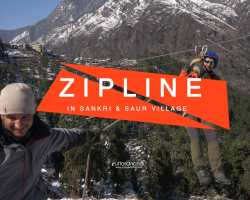
Kedarkantha Trek Travel Tips
- Kedarkantha is an easy to moderate difficulty-level trek and thus a perfect trek for amateur trekkers or novice adventurers trekking for the first time.
- Try to keep you backpack around 10-12 kg
- Explore the vast remote wilderness in the company of experienced professionals or certified tour guides only. With a vast experience under their belt, they would know how to tackle any adversity.
- Make sure to take a good camera with you as there will be vast opportunities to click photographs of snow-clad Himalayan peaks and verdant valleys. The dark, clear skies at Kedarkantha are also perfect for astro photography and capturing the Milky Way.
- Trekking in monsoon season should be generally avoided, especially by novice trekkers, as the region sees incessant rains which could lead to cloudbursts, landslides and roadblocks.
- Unless you have years of experienced under your belt, it is not advisable to venture all alone in the wilderness especially during long treks. Always trek in a group of two or more.
Staying in Kedarkantha Trek
As Kedarkantha is a popular winter trek, only adventurous trekkers visit this place. There are no hotels, resorts or guesthouses at Kedarkantha Summit or at Base camp. The trekkers take tents along with them and camp along the trail when they halt at night. Tents can also be rented from the town close to the base camp. The tour operators generally provide the camping equipment. The nearest market or roadhead is at Sankri . You can stay at Meraki Sankri Homestay during first and last night of your trek.
Kedarkantha Trek Food Guide
It is not possible for anyone to find a roadside dhabas en route to Kedarkantha as it is a place which is uninhabited by people. Though some shacks are open during few months of the year at 2 or 3 locations but you should not completely depend on them. Trekkers take the food supplies with themselves that they purchased at lower altitudes, preferably before starting the trek or a trekking company will take care of all your meals during the trek.
Mythology about Kedarkantha Trek
Any article on famous tourist destinations in Uttarakhand is incomplete without the mention of its mythological connotations associated with the place. Tourist attractions in Devbhumi Uttarakhand are smeared in mythological connotations and Kedarkantha is no different.
Kedarkantha – Lord Shiva’s retreat
Kedarkantha is also known as Bal-Kedar and according to a local legend; it was supposed to be the site of Kedarnath. It is said that when Shiva was wandering at Kedarkantha in his bull avatar, to hide from the Pandavas, the local dwellers disturbed his peace. Therefore, he fled to the present Kedarnath site. The villagers of Sankri believe that the trident of Lord Shiva, erected at Kedarkantha protects them and keeps the Himalayan Rivers replenished.
Christmas and New Year in Kedarkantha
As Kedarkantha is a popular winter destination, tourists and trekking enthusiasts flock to Kedarkantha in a large number during the Christmas and New Year. From the last 5 years, Kedarkantha has become one the best selling winter snow trek.
Detailed Suggested Kedarkantha Trekking Itinerary (4 Nights only) in Winters
Day 1: Dehradun – Sankri Distance: 200 Kms by road Time Taken: 8 - 10 Hours Sankri Altitude: 1967 Meters Highlights: Beautiful scenery, Tons river, Pine forests, Sankri village, HomeStays, Sankri Zipline
Reach at Dehradun and take an early morning bus or taxi to Sankri. The drive to Sankri will be a memorable one of most enchanting views. Overnight stay can be done at Meraki Sankri Homestay . If you stay somewhere else, you must visit the Meraki Cafe - Arthouse in the Himalayas, which offers the best food in the region. You can spend the evening strolling across the small village and enjoying the gentle sound of Tons river.
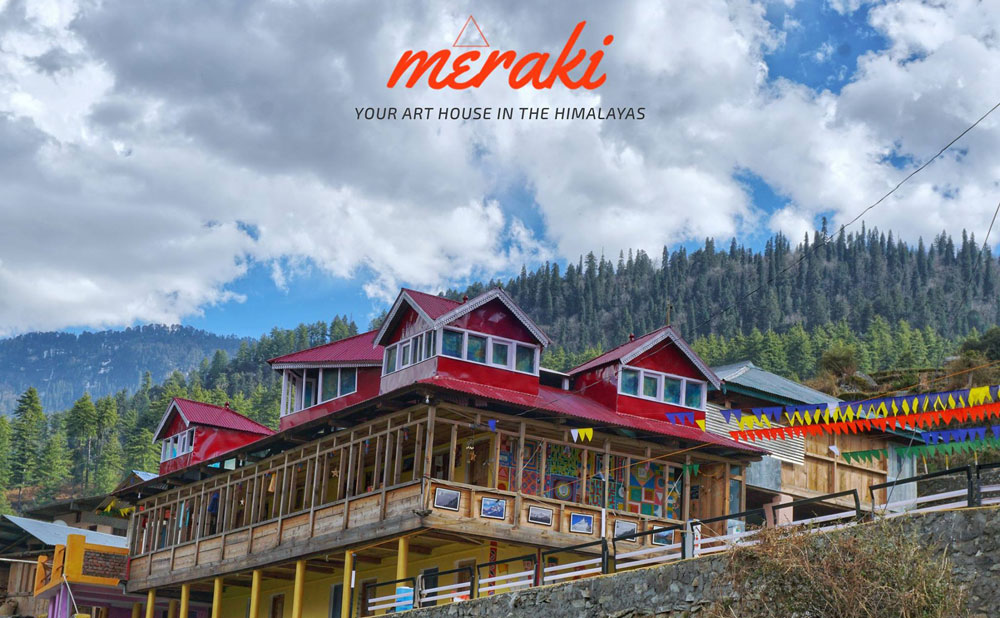
Day 2: Sankri – Juda Ka Talab - Kedarkantha Base Camp Distance: 8 Kms trek Time taken: 7 - 8 Hours Altitude: 3,430 Highlights: Small villages with wooden houses, bridges, diverse Himalayan flora and fauna
The trek commences today as we ascend towards Juda Ka Talab . The trial leading to Juda Ka Talab passes through beautiful forests of oak, birch, and deodar trees. Juda Ka Talab is one of the most sought after attractions in the Kedarkantha trek. It gains even more prominence in winters where it remains completely frozen. The trek will begin after a pleasant breakfast at Sankri. Sankri to Juda Ka Talab is a 4kms trek which will take around 3-4hrs to complete.
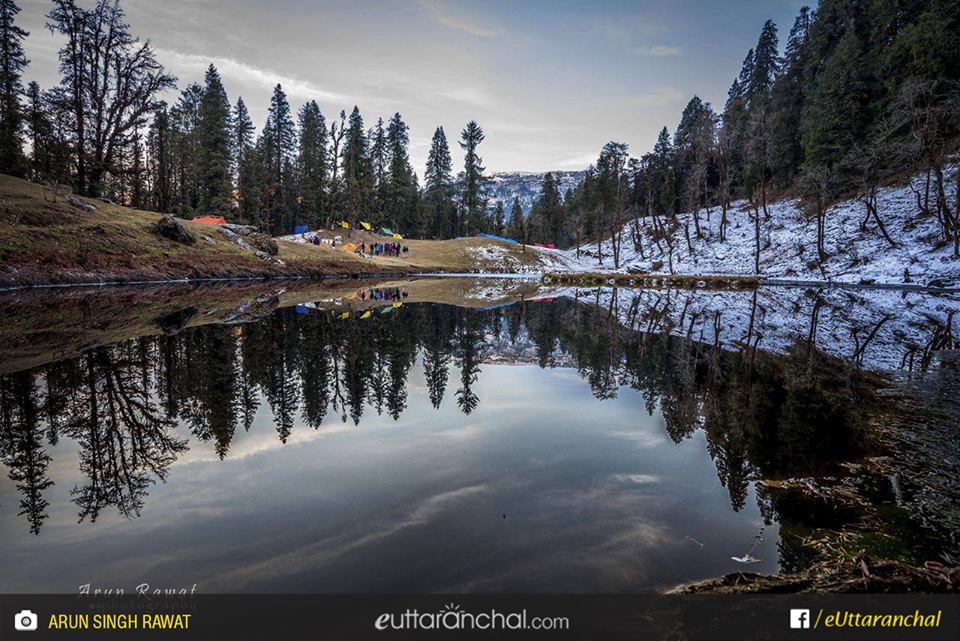
You’ll get your trekking gears and the instructors will give you information and tips for the journey ahead. The journey passes through beautiful villages and ascends as you go further. This is one of the most interesting parts of the journey. You’ll see women, men, and children going about with their lives, and short quick glances of Himalayan Languars, hares and boars along the way. There are small huts which serve tea, Maggi, and other eatables. You can stop for tea and have your lunch here.
As you ascend further, the beautiful Himalayan ranges come to view. You reach your destination- the mesmerizing Juda Ka Talab which is at an altitude of 2,700 mts. You’ll rest here for some time and take in the captivating scenery of the place. Swargarohini peak is visible from here. During winters, the entire lake remains frozen. You can walk and glide on the ice sheet.
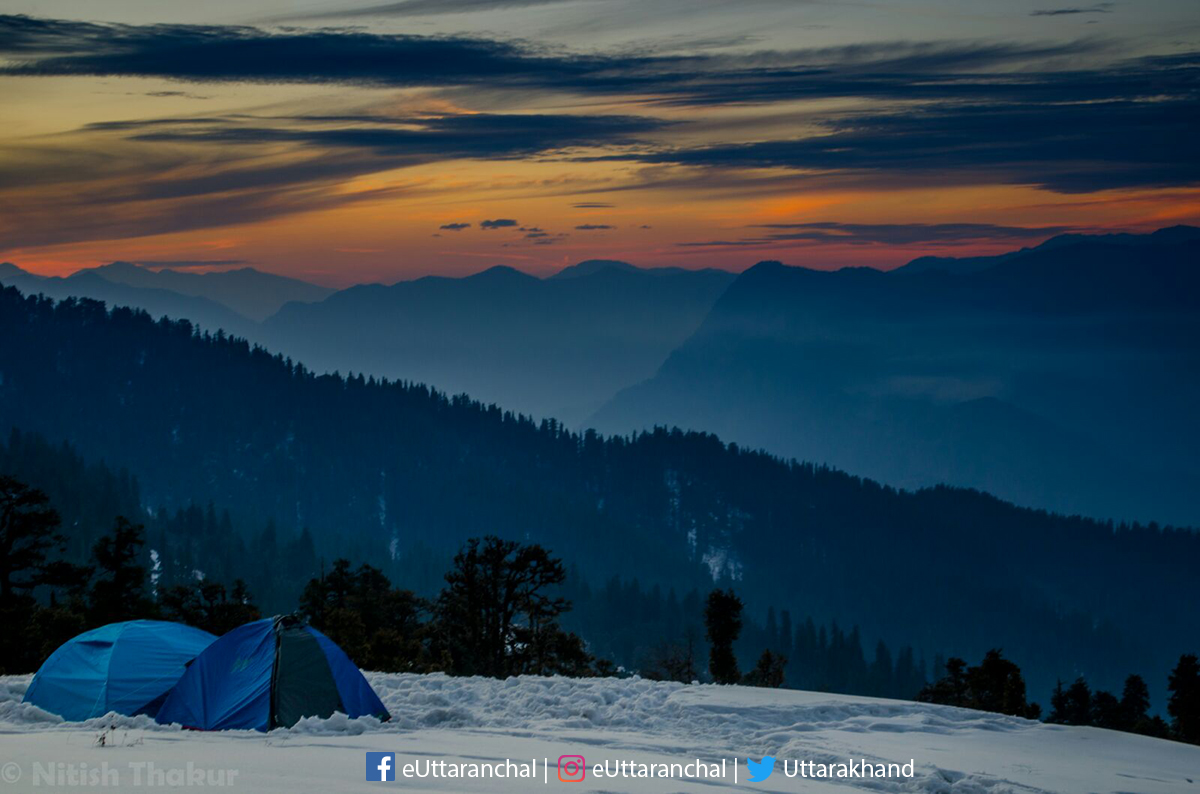
From Juda Ka Talab, the trek to Kedarkantha Base Camp follows a steeper gradient and dense forests of pine and oak trees. You’ll cover a distance of 4kms which will take about 3-4hrs to complete. You’ll camp here for the night. Kedarkantha Base Camp, at an altitude of 3,430m, has one of the best campsites. Every location offers spectacular views. Explore the place and sleep under the alluring stars. The Milky Way looks spectacular from here.
Day 3: Kedarkantha Base Camp – Summit – Kedarkantha Base Camp Distance: 6 Kms trek Time taken: 7 Hours Altitude: 3,430 mts - 3,800mts - 3,430mts Highlights: Early morning sunrise, 360° view of prominent mountain ranges and peaks, Kedarkantha peak
Today, you’ll start early (before dawn) after having a healthy breakfast and trek towards the summit. It’ll take around 2hrs to complete the trek.
The sunrise illuminates the meadows and the majestic peaks which leave you mesmerized. Walking along with the rising sun fills you with a refreshing energy and zeal. Take photos as you move forward for you don’t want to miss the views of the majestic Himalayas surrounding you.
The Kedarkantha summit looks breathtaking at an altitude of 3,800mts. Stones arranged in square with a Trishul pointing towards the sky mark the summit. A small beautiful temple dedicated to Lord Shiva and Parvati rises at the top of the peak along with a little temple dedicated to Lord Ganesha. All your tiredness gets washed away with the enchanting sight in front of you. Surrounded 360° by mountains, you’ll feel something unworldly altogether. The Gangotri and Yamunotri mountain ranges, Chansil pass, Kinnaur Kailash ranges, Har ki Dun and Rupin ranges are visible from the summit. Along with the mountain ranges, notable peaks like Swargarohini, Black peak, and Bandarpoonch peaks are visible from the summit.
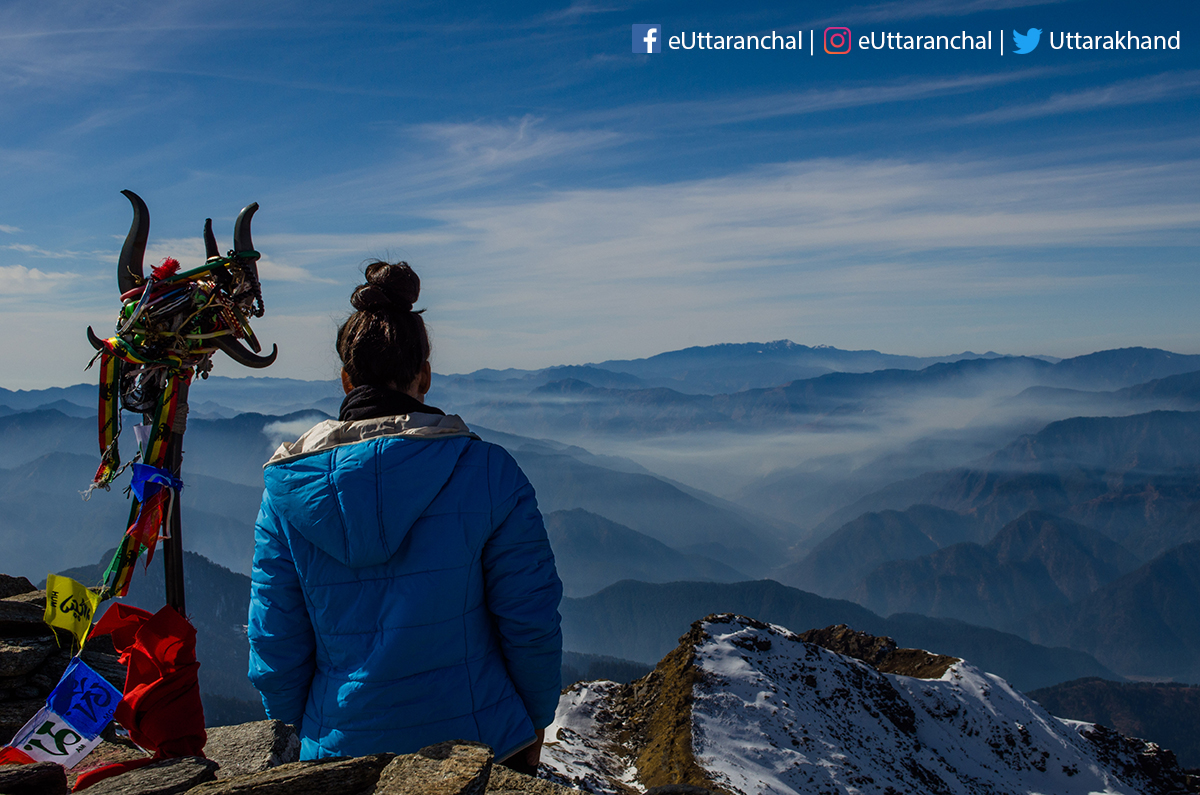
You can rest for some time here at the summit. Take momentous pictures and explore the sight. During winters, everything remains covered with snow and the contrasting beauty of the peaks amidst the snow captures the breathkating beauty of Kedarkantha.
We’ll head down towards the base camp on the same day. Walk carefully along the descent. You can have tea and light refreshments on tea huts. You’ll have your lunch at the campsite and spend the night there among the stars.
Day 4: Kedarkantha Base Camp - Sankri Distance: 6 - 7 Kms trek Time taken: 4 - 5 Hours Highlights: Early morning sunrise, pine and oak forests, Har ki Dun valley
Today you bid adieu to the majestic Kedarkantha and trek back to Sankri via Hargaon. Wake up early to capture the beautiful sunrise from Kedarkantha Base Camp. You’ll have your breakfast and get ready for the descent. Walking through the gorgeous pine and oak forests and the crystal clear streams where you can fill up your water bottles, makes the descent interesting. The clear summer streams remains completely frozen during winters. It’s a sight worth watching. The glorious Har ki Dun valley can be seen from the ridge.
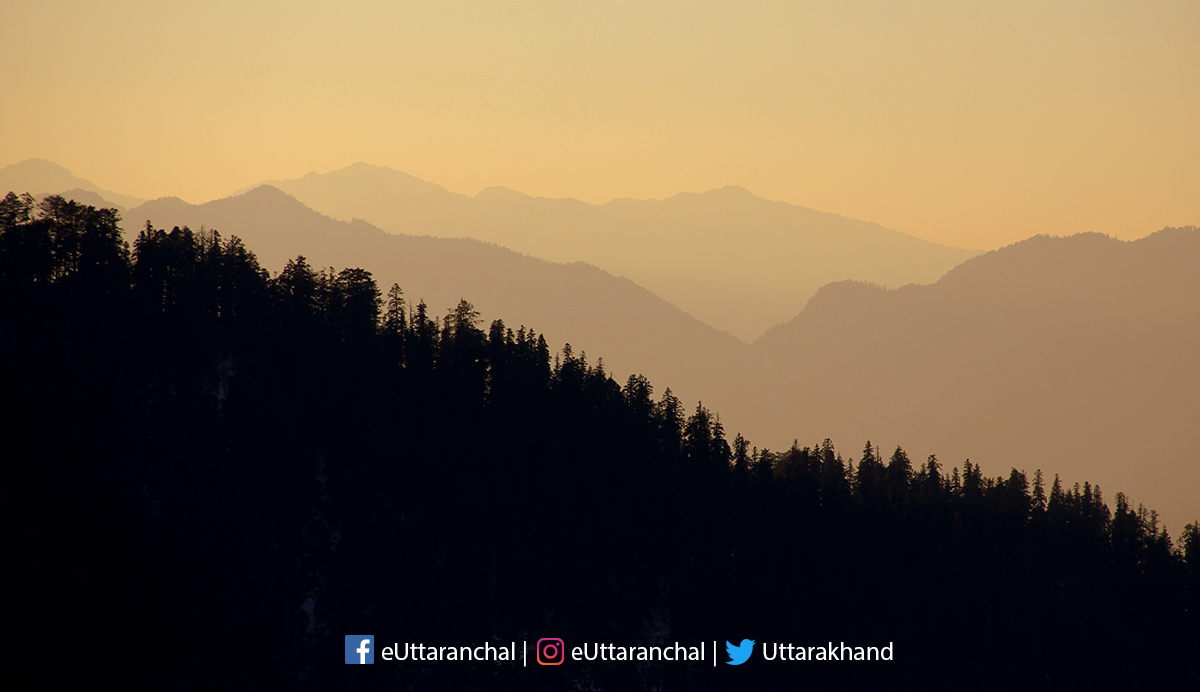
After trekking for 4-5 hours at moderate speed you reach Sankri, Since, you started the trek early in the morning, you’ll have a plenty of time to stroll around the villages in Sankri and explore the area. At Sankri, we’ll stay at Meraki Homestay .
Day 5: Sankri – Dehradun Distance: 200kms by vehicle Time taken: 8 - 10hrs Highlights: Scenic view of the route, Mori town , Purola , Tons River, Doon view from Mussoorie
Today, you’ll head back to Dehradun via Mussoorie . You can either drive back or take an early morning bus to Dehradun. It will take around 8-9 hrs to reach Dehradun. Halt at Mussorie or Kempty Falls and have your lunch there. You can visit places nearby Dehradun like Mussoorie, Rishikesh , or Haridwar .
Some Frequently Asked Questions about Kedarkantha Trek (FAQs)
Q. What is the height or altitude of Kedarkantha Peak (Summit)? Ans. Height of Kedarkantha Peak is 3810 mts (12500 feet) Q. What is the average trek cost for Kedarkantha Trek? A. The average trekking price for Kedarkantha from sankri vary from Rs 6000 to Rs 12000 per person for 4 nights tour and around Rs 7000 to Rs 14000 for 5 nights tour. The Kedarkantha trek cost depends on the services offered, group size, stay quality in Sankri, Season and off season time and other factors. Q Can we get trekking equipments, tents, shoes on rent for Kedarkantha trek? A. Yes, you can get trekking equipment, tents for camping, trekking shoes, gators and spikes during winter trek when snow is all around, trekking poles (sticks), jackets and other stuff for Kedarkantha trek. There are few shops which offers equipment for rent.
Q. We have a shoe string budget. Can we do Kedarkantha trek on low budget cost? A. If you are very tight on budget then you can plan for YHAI (Youth Hostel Association of India) Kedarkantha Tours. YHAI offers low cost and very basic trekking tour and programmes of Kedarkantha.
Check our more Frequently asked questions for Kedarkantha
Kedarkantha is also popular as Kedarkantha Trek, Kedarkantha Snow Trek, Kedarkantha Winter Trek, Kedarkantha Summit, Kedarkantha New Year Trek

Kedarkantha Trek Photo Gallery
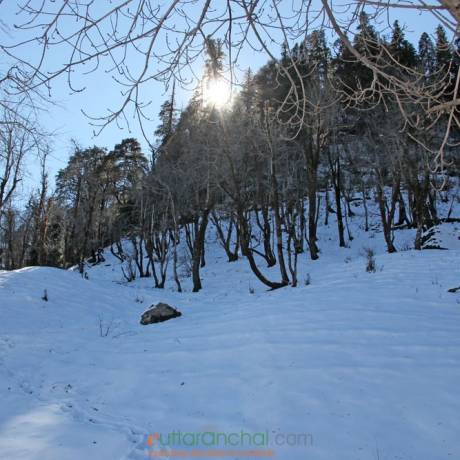
Tourist Map of Kedarkantha Trek
Map for representation only. Map NOT TO SCALE.
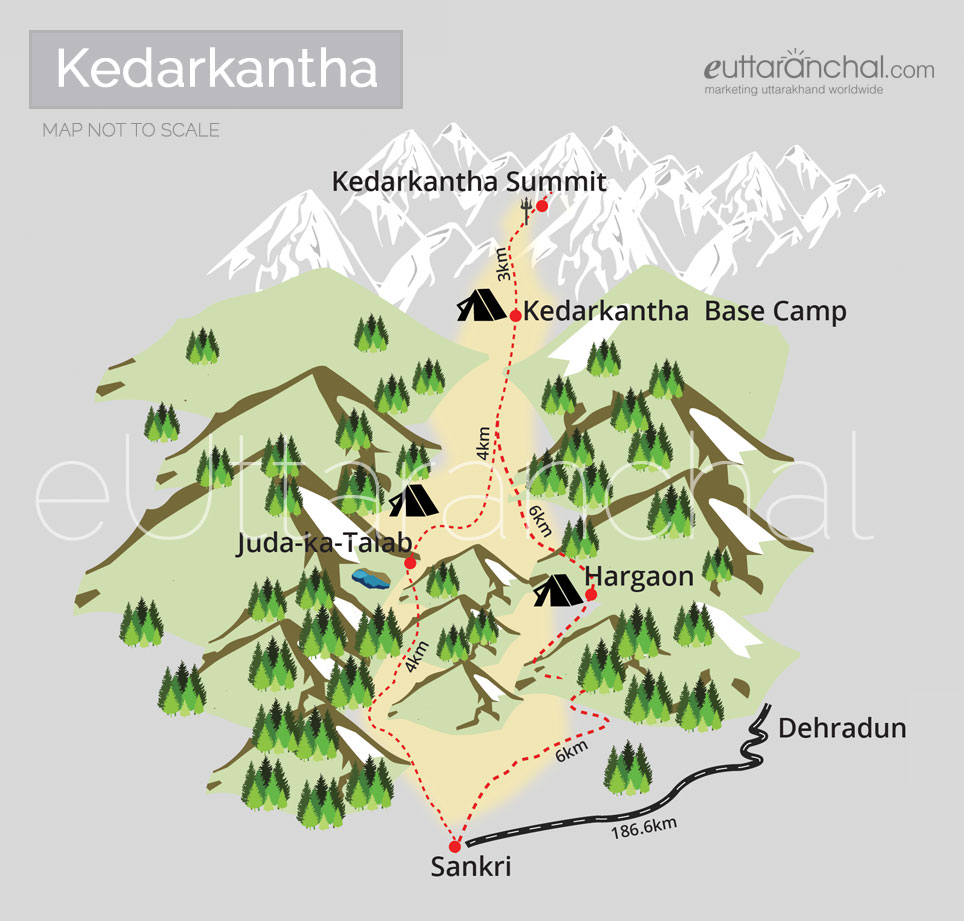
- Kedarkantha Trek Weather
Check out the Kedarkantha Trek weather report for April
Kedarkantha Trek Weather in April
The minimun and maximum temperature in April in Kedarkantha Trek is 0 ° C and 12 ° C respectively. The weather is generally pleasant and clear in April and you would feel pleasant throughout the day. Light Woolen clothes are recommended for Kedarkantha Trek in April.
- Kedarkantha Trek Travel Guide
- Kedarkantha Trek Tourist Map
- Kedarkantha Trek Hotels
- How to Reach Kedarkantha Trek
- Places near Kedarkantha Trek
- Kedarkantha Trek Blog, Articles, Travelogues
- Kedarkantha Trek FAQs
- Kedarkantha Trek Photos
Kedarkantha Trek Reviews
Kedarkantha trek travel tips, blogs & articles.
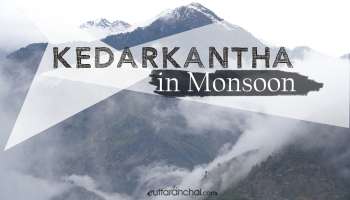
What is Kedarkantha Trek famous for?
Kedarkantha Trek is famous among tourist as Trekking, Winter Trek, Snow Trekking, Summit Trek, Frozen Lake, Camping, Adventure.
Kedarkantha Trek is recommended destination for Corporates, Couples, Foreigners, Groups, Solo.
Kedarkantha Trek is popular destination for following activities/ interests - Adventure , Camping , Christmas and New Year , Emerging Destinations , Meadows , Skiing , Trekking , Winter Treks .
Plan your Trip
Kedarkantha trek highlights.
- It is one of the most beautiful treks in Uttarakhand.
- Conquer a Summit around 4000 mts
- Majestic views from Kedarkantha Summit
- During your trek you will trek across some of the most beautiful sights with snow-capped mountains, verdant valleys and frozen ponds.
- Get a chance to witness the vivid flora and fauna of the region as you continue your trek.
- Explore Juda ka Talab (which is frozen during winters and heaven for bird watching during summers)
- Trekking through the lush meadows, dense pine forests, cascading beautiful streams, and gorgeous maple trees.
- The charming minion villages during the trek
Uttarakhand Travel Update
Char Dham yatra will start from 10 May 2024, Bookings Now Open! Check Char Dham Tour Packages - Hotels in Badrinath - Char Dham Yatra by Helicopter - Kedarnath Helicopter Booking Guide - Char Dham hotels
Char Dham Closing Dates: Gangotri , Yamunotri and Kedarnath dhams are closed now. Badrinath temple will be closed 19 Nov. Check out Char Dham Yatra tours : Char Dham News . Char Dham Registration is compulsory for visiting Char Dham Temples. Check Kedarnath Helicopter Ticket booking guide .
Traveling to Uttarakhand? Check out Uttarakhand Covid Stats , Uttarakhand Travel Guidelines and Uttarakhand Travel News
Char Dham Update: Gangotri , Yamunotri , Kedarnath and Badrinath are open for pilgrims. Check out Char Dham Yatra tours : Char Dham News . Char Dham Registration is compulsory for visiting Char Dham Temples. Check Kedarnath Helicopter Ticket booking guide .
Last Updated: 12 Apr 2024
Kedarkantha Trek overview
- Temperature in Apr 12 /0 °C
- Best time to visit Kedarkantha Trek Jan, Feb, Mar, Apr, May, Jun, Oct, Nov, Dec
- Starts from Sankri Village
- Trek Distance 20 kms / Entire Trek
- Trek grade Easy
- Trek duration 5 days
- Altitude range 3810 mts
- Located in Uttarkashi, Garhwal
- Recommended stay 3 days
- Railway Station Dehradun, 208 kms
- Nearest Airport Jolly Grant Airport, 225 kms
- Famous for Trekking, Winter Trek, Snow Trekking, Summit Trek, Frozen Lake, Camping, Adventure
Travelling to Kedarkantha Trek in 2024?
Contact us for planning your Kedarkantha Trek tour with best travel packages of as per your requirements!
- Sacred Yatra
- Char Dham Tours
- Chopta Tourism
eUttaranchal
- Uttarakhand Tour Packages
- Uttarakhand Hotels
Customer Service
- Return, Cancellation & Refund
- Privacy Policy
- Terms of Use
Business Connect
- List your Package
- List your Hotel
- Send Feedback
- Tourist Map
- Blog, Articles
Get Customized Tour Package
Discovery Hike

- Nepal Treks
- EXPEDITIONS

kedarkantha Trek
Kedarkantha trek.
When it comes to winter trekking, the Kedarkantha trek is the best choice because it features new powder-soft sparkling snow. It’s a year-round trek, but it’s particularly well-known and common in the winter. It is the best choice for winter trekking for trekkers who want to combine adventure with a straightforward approach. It is one of Uttarakhand’s most famous treks and is full of natural wonders. This trek is mythologically significant, and some claim it is linked to the ancient Indian epic “The Mahabharata.”
Lord Shiva’s alias name is Kedar, and the word Kantha means throat. There are several stories about it. Some people believe the rumors, while others do not, but one thing is certain: going on this trek will bring you inner peace. You will get closer to you if you follow the road. The Kedarkantha trek leads to the Kedarkantha Peak, which stands at an altitude of 12,500 feet. The trek takes place in Uttarakhand’s Uttarakashi district’s Western Garhwal. During the summer months of April to June, the temperature at Kedarkantha reaches 20 degrees. In the winter, however, the weather blankets the mountains in pristine white snow, making it an exciting destination for skiing or even trekking!
From November to February, the temperature will drop to -10 degrees, with the weather staying cold.
It is one of the few Himalayan treks that allows trekkers to witness snow before April! This is the trek’s main attraction. The Govind Ballabh Pant National Park, also known as Govind National Park, is where this trek takes place. This national park serves as a natural preserve for endangered Himalayan animals such as the snow leopard, Golden Eagle, Brown Bear, Moschus, Western Tragopan, and others. Even though the path began in a thick pine forest, it passes through it.
Short Itinerary
Dehradun - sankri (2000m) 9hr drive, sankri – shepherd camp (trek/3-4 hrs), shepherd camp – base camp kedarkantha (trek 4-5 hrs), base camp - kedar kantha peak (3800m) - shepherd camp, shepherd camp – sankri – dehradun (2 hr trek / 8 hr drive), detailed itenerary, day 01: dehradun – sankri (2000m) 9hr drive.
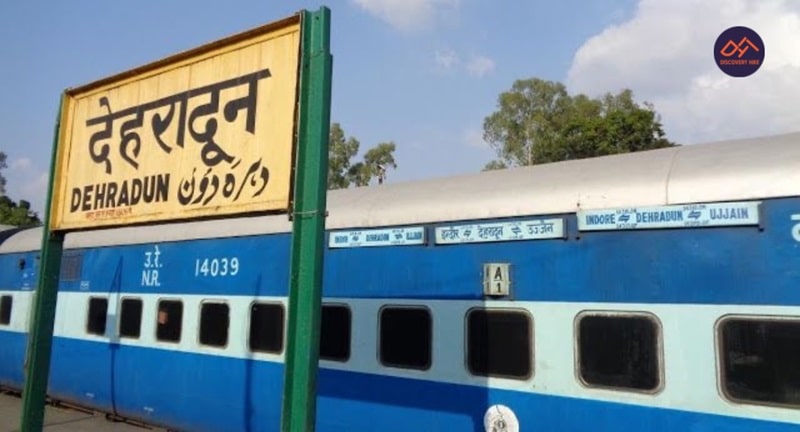
Meet us in Dehradun early in the morning. From here, we’ll begin the scenic drive to Sankri, where we’ll set up camp at an elevation of 6,400 feet. You’ll pass through beautiful towns like Mussoorie, Naitwar, and others along the way. To get to base camp, you’ll be on a scenic drive of a lifetime. Throughout the drive, you will be surrounded by nature, with beautiful scenery and the scent of pinewood and Himalayan flora and fauna. It will take about 7-8 hours to complete the journey. From the start, the stunning and majestic drive will steal your heart. You’ll be welcomed by pine and oak trees, and your route will pass alongside the raging Yamuna & Tons river.
When you arrive, check into your hotel and leave your luggage before taking a walk through the cute little hamlet of Sankri. This is a small Himalayan hamlet with a wealth of natural beauty. A location is well-known among hikers and nature lovers. Sankri is well-known for being a trekking hotspot. The most common treks are Kedarkantha Treks and Har ki Dun Treks, which are both accessible from the Sankri base camp. This location is also well-known among shutterbugs as a spot to quench their photographic thirst.
Day 02: Sankri (2000m) – Shepherd Camp (2900m, Trek/3-4 Hrs)

After breakfast, we’ll embark on a mild hike that will take us through the forest for the most part. We’ll walk to Saur village and then climb up to Juda-ka-Talab , a small pond that freezes over in the winter. This lake has a religious meaning & stunning views of snow-capped mountains. Its views have the ability to enchant travelers. You won’t be able to look away until you’ve seen it. You won’t be able to put into words how you feel. Only you will be able to sense it because the words will be short. We will get glimpses of the snow-capped Himalayan peaks as we continue climbing. After another hour of hiking, we’ll arrive at the meadows, where we’ll pitch our tents for the night.
Day 03: Shepherd Camp (2900m) – Base Camp Kedarkantha (3400m, Trek/5 Hrs)
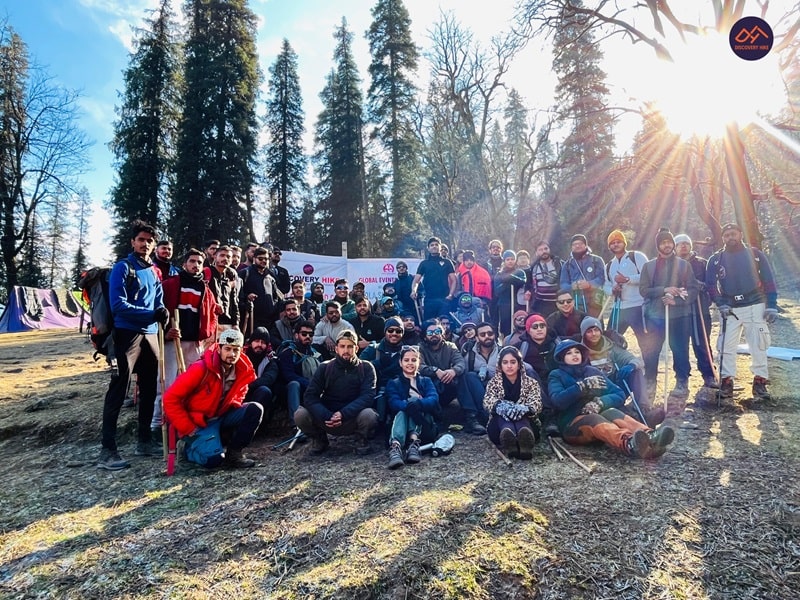
Start early and take in the magnificent sunrise. After a delicious breakfast, we will begin our trek to the Kedarkantha foundation, which is located at an elevation of 11,250 feet. With sufficient breaks, the trek should take about 4-5 hours to complete. The trail is almost level at first, and it follows a well-marked route. However, it soon reaches a thick pine and oak forest before opening into lovely meadows dotted with tiny shepherds’ huts. The imposing view of Bandarpoonch, Swargarohini, Kala Nag, and Ranglana, all of which are snow-capped Himalayan peaks, will take your breath away. These mountains are well-known for their breathtaking views.
When you look up at the tops of these hills, you’ll find that there’s no gap between them and the sky. Mother Nature’s wonders have produced these peaks. These are priceless natural treasures. The view will leave an indelible impression on your mind and soul once you’ve seen it. The view from these peaks will stay with you forever. Swargarohini Peak is 6,252 meters tall, Bandarpunch is 6,316 meters tall, Kalanag is 6,387 meters tall, and Ranglana is 5,554 meters tall. The Garhwal Himalaya covers both of these peaks.
You will enjoy your delicious dinner and your night by sharing your experiences with your travel partners in your cozy tents.
Day 04: Base Camp – Kedar Kantha Peak (3800m) – Shepherd Camp

Imagine what the view from the summit would be like if the Kedar Kantha base is that beautiful. The distance to the summit is not long, but the climb is steep, and we will choose the best route based on the snow conditions, which will take about 4-5 hours. You will be able to see all of the mountains in the Yamunotri, Gangotri, and Kinner Kailash ranges, as well as the valleys, from the peak. Then, depending on the route we take, we’ll descend the peak and trek all the way down to Shepherd Camp. We’ll spend the night in tents there.
Day 05: Shepherd Camp – Sankri – Dehradun (2 Hr Trek / 8 Hr Drive)

We have a short trek today before driving straight to Dehradun. Rise with the sun and enjoy your breakfast, in the splendor of the Himalayas. After that, we’ll begin our descent to Sankri, and it’ll be time to say our goodbyes to Kedarkantha Trek. you can arrive in Dehradun around 9 pm. This is where the wonderful journey comes to an end.
Altitude Profile Chart
The following graph will visually represent the altitude gains across the various campsites.
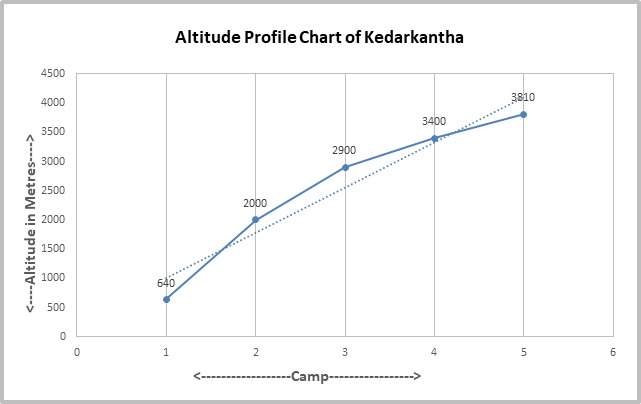
Here X-axis shows the following campsites listed below.
- Sankri Base
- Shephard camp (Juda ka taal)
The Y-axis shows the altitudes.
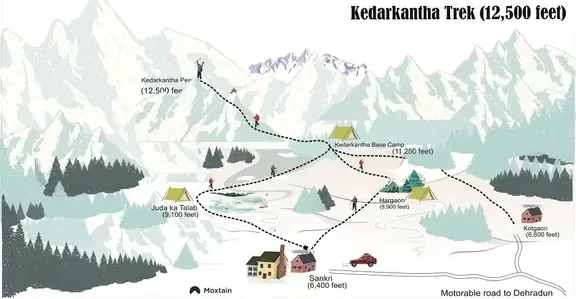
- Transportation: Dehradun to Sankri and back, by Bolero/Sumo/Traveller.
- Accommodation: Stay from Sankri to Base camp is included. Accommodations include a guest house or permanent camp at Sankri and camping tents at the campsites, all on a triple-sharing basis.
- Meals: All meals from afternoon snacks at Sankri on the Arrival Day to breakfast at Shepherd camp on the Last Day are included. We provide simple, nutritious, and healthy food daily on the trek. *Note: Meal variety is subject to change, depending on the availability.
Typical items included in the meals are:
- Breakfast: Wake-up Tea/Coffee, Biscuits, Aloo Paratha with Achaar, Boiled Egg, Bread with Butter/Jam, Fruit, etc.
- Lunch: Roti/Chapati, Rice/Chawal, Manchurian Rice, Salad, Dal (Rajma), Mixed-Veg, Kofta Curry, etc.
- Snacks: Tea, Coffee, Pakoda, Finger Chips, Veg Cutlet, Maggi, Soup, Popcorn, etc.
- Dinner: Roti/Chapati, Rice/Chawal, Matar Paneer, Mixed Dal, Salad, Papad, Sweets (Gulab Jamun, Jalebi), Fruit Custard, etc.
- Permit: Forest permit charges are included.
- Tent & Sleeping Bag: Quality tents, mattresses, and sleeping bags are provided in the camps, along with a liner.
- First Aid Kits: Carried by our trek leaders and guides. Emergency medical issues are addressed with utmost care.
- Specialized Search & Rescue Team: Our team is trained in advanced search and rescue operations. *Note: Rescue costs are not included.
- Adept Trek Leaders and Team Members: Our local Himalayan team includes professional trek leaders with mountaineering qualifications and familiarity with the local terrain. The team also includes well-trained guides, cooks, and helpers.
- Food During Road Journey: Meals between Dehradun and Sankri are not included.
- Backpack Offloading Charges: An additional charge of Rs-350/- per bag per day for offloading, with a maximum weight limit of 10 kg per backpack. *Note: Suitcases/trolleys/duffel bags are not allowed. Offloading during the trek is subject to prior arrangement.
- Stay & Unplanned Transport: Accommodation in Dehradun or any unplanned transportation, which is not mentioned in the itinerary.
- Personal Expenses: Any kind of personal expense is not included in the cost.
- Rescue Cost: Expenses for any trekker needing to be sent back or rescued.
- Others: Anything not listed in the inclusions.
Other Information
Weather and climate info:.
During these months, the temperature ranges between 6°C to 20°C, offering a comfortable climate for trekkers. The charm of trekking amidst the lofty pine and oak trees is unparalleled during this period, making summer an ideal time for sightseeing and exploration.
Despite the wet conditions, the temperature remains stable at around 12°C. The weather is predominantly cloudy and wet, offering a unique trekking experience with verdant greenery at every turn.
- Autumn (October – November) Autumn in Kedarkantha is a period of transformation. October and November see temperatures ranging from 0°C to 15°C, with the weather remaining mostly clear. The green leaves slowly turn dry, and the lush meadows gradually change to brown, offering a stark contrast to the previous seasons. This period is ideal for beginners, as the weather is pleasant and the landscape offers majestic sights of the Himalayas.
- Winter (December – February) Winter is when Kedarkantha truly comes into its own. The temperature drops to a range of -2°C to 12°C, and the landscape is enveloped in a thick blanket of snow. This season transforms the region into a surreal, dreamy world, attracting trekkers from across the globe. December sees the beginning of fresh snowfall, and January intensifies the experience with frequent snowfalls. February offers the most thrilling trekking experiences with high chances of snowfall, creating perfect conditions for skiing enthusiasts.
Summer (May – June): Day: 20°C, Night: 6°C Monsoon (July – August): Day: 17°C, Night: 4°C Autumn (September – November): Day: 15°C, Night: 2°C Winter (December – February): Day: 10°C, Night: -12°C Spring (March – April): Day: 12°C, Night: -5°C
Mountain Ranges, River Valley & Lake:
The Kedarkantha trek, nestled in the Uttarkashi district of Uttarakhand, India, is renowned for its mesmerizing natural beauty and diverse landscapes. This trek is a popular destination for those seeking a blend of adventure and scenic splendor. Here are some details about the mountain range, river valley, waterfalls, and lake in the Kedarkantha region:
- Mountain Range and Scenery: Kedarkantha, situated at an elevation of 3810 meters, is part of a stunning mountain range that offers spectacular views of several peaks, including Ranglana, Banderpooch, Black Peak, and Swargarohini. During winters, the area is covered in snow, adding to its allure. The trek itself is relatively easy and rewarding, suitable for those seeking mild adventure amidst natural beauty.
- River Valley and Water Availability: The trek is located in the lap of the river Valley, offering a serene environment. Water is available at camp houses along the trek, and trekkers also have access to clean water from the river Supin, which lies on the route. However, it is advisable to stock up on water as it may not be easily available between trekking points.
- Frozen Lake – Juda Ka Talab: A significant attraction along the Kedarkantha trek is Juda Ka Talab, a serene and picturesque lake. This lake was originally two separate lakes but has since conjoined into one. The trail to Juda Ka Talab passes through green meadows and dense forests of pine and oak, leading to this tranquil spot which is ideal for camping.
- Overall Landscape and Environment: The Kedarkantha trek is characterized by its thick oak and pine forests, wide-open green meadows, serene lakes, and panoramic views of the majestic Himalayan peaks. This diverse landscape makes the trek not only a journey through different terrains but also a visually captivating experience.
In summary, the Kedarkantha trek offers a rich tapestry of natural elements, from towering mountain peaks and lush valleys to tranquil lakes and dense forests. It’s a journey that combines physical challenge with the reward of unparalleled natural beauty.
Flora and Fauna:
- Flora: The Kedarkantha Trek in India is renowned for its diverse and enchanting flora and fauna. As you trek through the region, you’ll encounter dense forests of pine, oak, and rhododendron trees, creating a verdant canopy above. In spring, these forests are transformed with colorful rhododendron blossoms in shades of red, pink, and white, infusing the air with their sweet fragrance. The area also boasts a variety of Himalayan wildflowers, including the sacred Brahma Kamal, and is a haven for botanists and photographers.
The region hosts a rich avian population, including species such as:
Black Francolin, Koklass Pheasant, Kalij Pheasant, Brown-fronted Woodpecker, Himalayan Woodpecker, Scaly-bellied Woodpecker, Great Barbet, White-throated Kingfisher, Crested Kingfisher, Slaty-headed Parakeet, Himalayan Swiftlet, Snow Pigeon, Oriental turtle Dove, Black Kite, Lammergeier, Himalayan Griffon, Common Buzzard, Black-headed Jay, Eurasian Jay, Yellow-billed Blue Magpie, Red-billed Blue Magpie, Red-billed Chough, Large-billed Crow, Common Raven, Spotted Nutcracker, Yellow-browed Fantail, Bronze Drongo, Brown Cipper, Blue Whistling Thrush, Blue-capped Redstart, White-capped Water Redstart, Plumbeous Water Redstart, White-cheeked Nuthatch, White-tailed Nuthatch, Eurasian Treecreeper, Rusty-flanked Treecreeper, Rufous-Vented Tit, Spot-winged Tit, Grey-crested Tit, Green-backed Tit, Black-throated Tit, Black-lored Tit, Great Tit, Yellow-browed Tit, Winter Wren, Himalayan Bulbul, Red-vented Bulbul, Black Bulbul, Striated Prinia, Lemon rumped Warbler, Tickells’s Leaf Warbler, Mountain Chiffchaff, Oriental White-eye, White-throated Laughingthrush, Streaked Laughingthrush, Black-chinned Babbler, White-throated Shrike Babbler, White-browed Fulvetta, Whiskered Yuhina, Rufous Sibia, Russet Sparrow, Citrine Wagtail, Alpine Accentor, Plain Mountain finch, Red-mantled Rosefinch, Rock Bunting, Chestnut-eared Bunting.
The forested areas provide a home to Himalayan langurs, wild foxes, Indian Crested Porcupines, Yellow-throated martens, Wild boars, Black bears, Ibexes, Blue sheep, and the elusive leopards.
Photography Tips:
- Understand the Light: The Himalayas offer dramatic lighting conditions. For the best photographs, capture early morning and late afternoon scenes when the light is soft and golden. Midday light can be harsh, but it can also highlight the stark contrasts of the landscape.
- Capture the Flora and Fauna: Kedarkantha is home to a rich array of flora and fauna. Capture the vibrant rhododendrons in spring, the lush greenery in the monsoon, or the snow-blanketed trees in winter. For wildlife, carry a zoom lens to capture distant birds or animals without disturbing them.
- Landscape Photography: The panoramic views of the Himalayas are breathtaking. Keep your wide-angle lens handy to capture a wide range of the landscape. Try incorporating elements like a trekker or a tent in the foreground to give a sense of scale.
- Experiment with Perspectives: Try to observe the scenic moments from different angles and perspectives. For instance, a low-angle shot of a trail leading into the mountains can add depth and intrigue to your photos.
- Utilize the Rule of Thirds: This basic principle of photography helps in composing balanced and interesting shots. Divide your frame into nine equal segments and place the important elements along these lines or their intersections.
- Capture the Local Culture: Kedarkantha trek passes through quaint villages. Capture the local architecture, people, and their daily lives. Always take permission before capturing people.
- Night Sky Photography: The clear skies at high altitudes are perfect for astrophotography. Use a tripod and long exposure settings to capture the stars and perhaps the Milky Way.
- Be Prepared for Weather Changes: The weather in the Himalayas can change rapidly. Protect your camera equipment from rain and snow. Keep batteries warm in cold weather as they can drain quickly.
- Travel Light: While it’s tempting to carry all your gear, remember you will be trekking at high altitudes. Prioritize and take only what you need.
- Respect the Environment: While photographing, be mindful of your surroundings. Don’t damage the natural environment or disturb wildlife.
Bonus Tip: Practice Patience Sometimes, waiting for the right moment, light, or movement can make all the difference in a photograph.
Things to Carry:
Hiking shoes.
- Type : We recommend that you look for water-resistant shoes with a deep yet flexible sole to sustain on Himalayan terrains.
Note: Dynamic rough terrains hold uncertain threats. The pair of shoes that has the advantage of overcoming those threats will help you to maintain your confidence in balancing.
- (15-20) litres will be ideal for short treks of (1-3) days.
- (40-60) litres will be ideal for long treks of (3 – 10) days.
Note: A backpack comes under very essential for the activity like trekking. You will have a requirement of your Backpack throughout the journey for your belongings and all the essentials you need. We recommend you test the bag and choose it according to your height, the Trek where you are taking it & comfort it provides.
- Type: A (10 – 15) litres waterproof daypack is all you need to have with you for the Summit.
Note: Your Daypack will be for those Summit days and shorter days when you just need your essentials (wallet, small water bottle, sunglass, power bank, etc.) with you.
- Collared T-shirts – Carrying 2 – 3 units of collared T-shirts will be ideal. The collar will help you to keep your neck away from direct sunlight and not too exposed to the Sun and getting sunburnt.
- Padded Jacket – Ensure that the jacket is wind-resistant & capable of keeping you warm at -10 °C to -12 °C temperature.
- Fleece Jacket – Fleece jackets are made of very soft and cozy material. It helps you to maintain a comfortable body temperature. Keep 2 Fleece Jackets with you.
- Thermals – You will have a requirement of only 1 pair of this in the Winter, For Summer it could be under consideration. It is made of pure cotton and designed in such a way that body heat is blocked between its layers. It will keep you warm during the nights when the temperature falls.
- Trek Pants – You will have a requirement of 2 units of Trekking Pants with you always. Between them, one must be convertible. Ensure it is made of Cotton or windproof light material & provides maximum durable comfort.
- Sun Caps –The Sunlight might be harsh at higher Altitudes and the direct exposure of sunlight to your head is harmful to your skin. Carry Sun Caps to keep your head cool.
- Woolen Caps – You will need woolen caps during the nights to keep your ears and head warm from the very cold breeze.
- Waterproof Gloves – You will require waterproof gloves for cold and wet sections of the Trek. Always keep your hands clean & warm, and avoid letting your hands wet to get the supporting grip and balance.
Trek Accessories
- Trekking Pole: The Trekking/Hiking Pole saves 60% of your energy for conquering a steep slope at a higher altitude. It is advisable to carry a trekking pole with you for the treks.
- Head-lamp or Torch: A head-lamp is another important thing that also comes under mandatory items for our Treks. It will help you to deal with the dark. Headlamps become more effective to walk in dark cold weather without approaching through your hand. Featured Torch is also ok for uphill.
Daily essentials
- Toiletries: We recommend you carry all your Toiletries essentials and all other personal belongings by yourself to avoid borrowing. Here are some items you could take- tooth-cleaning paste, dental brush, lip moisturizer, skin hydrating cream, facial cleanser, a range of vital creams and items, bathroom tissue/toilet paper, menstrual pads, along with other important personal care items like shampoo, conditioner, deodorant, and shaving supplies.
- Containers & Vessels: It’s advisable to bring your water containers; we recommend two bottles each with a capacity of 1 litre. Additionally, for both ease and hygiene reasons, please carry your food containers to use for the meals we supply. The metal bottle comes in handy for hot water served in the camps.
- Recommended Medicines: Gauze 1 small roll, Dexamethasone one strip, Nifedipine 5 tablets, Band aid 10 strips, Avomine 4 tablets (motion sickness), Avil 25mg 4 tablets (allergies), Combiflam 4 tablets (Pain killer), Crepe bandage 3 to 5 meters, Disprin 6 tablets (headache), Crocin 6 tablets (fever), Digene 10 tablets (acidity), Omez/ Rantadine 10 tablets (antacids), Norflox TZ & Lomofen 6 tablets each (diarrhea), Diamox 10 tablets (to prevent AMS), Cotton 1 small roll
Essential Documents Required:
For the Kedarkantha trek, you must bring specific documents and submit those to the trek leader at the base camp. These include a copy of the Disclaimer, along with one photocopy and the original of a government-issued photo ID. Additionally, a doctor’s medical certificate confirming your fitness for high-altitude scenarios is required.
Risks and Precautions:
Here are the risks or challenges you might face on the Kedarkantha Trek.
- Risk of slip/skid: Kedarkantha is a moderate trek that tests the patience and challenges the skills of trekkers. It helps in developing confidence, patience, and strategic planning abilities. While trekking in the winter season there is a possibility of slip/ skidding as the trail is scattered with black ice, especially in December, and January, and in addition, weather is very much unpredictable in the Himalayas.
- Safety Precautions: To address these challenges, there will be a briefing session at the base camp about the risks of slipping or skidding. A trained trek leader will guide trekkers in maintaining body balance and show them how to use the trekking poles properly.
The Discovery Hike will provide crampons to the trekker for the snow-filled trails. These crampons are specially designed to hold a better grip on snow trails and minimize the risk of skidding up to 95%. The Trek leader shall accompany the team and shall aware the team members about the situation.
While choosing your shoe, remember that the shoe must have a good grip.
- High Altitude Risks: During the Kedarkantha trek, which ascends from 6,400 feet to 12,500 feet over 4-5 days, there’s a small risk of Acute Mountain Sickness (AMS), High Altitude Pulmonary Edema (HAPE), and High-Altitude Cerebral Edema (HACE), especially at higher camps like the Kedarkantha campsite.
- Safety Precautions: To prevent these conditions, trekkers can start taking DIAMOX from the first day, as it significantly reduces AMS risk. Trekkers trained to recognize AMS symptoms should promptly report them to the trek leader. The leaders are prepared with a high-altitude medical kit and oxygen cylinders for safety. If conditions worsen, trekkers may need to move from higher to lower campsites.
- Dealing with Blisters and Cramps: Blisters cuts and cramps occur very often while we are walking or trekking on uneven trails.
- Safety Precautions: If a trekker experiences a blister or cramp, they need to quickly inform the trek leader, who carries a treatment kit. To prevent blisters, it’s recommended to use well-fitting trekking shoes that are breathable and have a good grip. For leg cramps, apply cramp spray, which both trekkers and the trek leader should have.
- Weather Risks at High Altitude: The weather at high altitudes, particularly in the Himalayas, is known for being unpredictable and can sometimes worsen quickly.
- Safety Precautions: The trek leader will make the call to either continue or wait for better weather. If the weather stays harsh and could worsen, the team might need to descend for safety. We provide all-weather tents to cope with different weather challenges.
- Communication Risks: As you go higher on the Kedarkantha trek, from 6,400 ft to 12,500 ft, communication signals weaken and eventually we might lose connection completely, isolating us from the outside world. But there’s no need to worry about this disconnection.
- Safety Precautions: To stay connected, we use walkie-talkies as an alternative way to communicate with people at different campsites.
- Emergency/ Immediate rescue: In case of severe health issues or other emergencies, immediate rescue might be necessary.
- Safety Precautions: If a serious situation arises due to AMS, cramps, illness, or breathing problems, the trek leader and staff will quickly use resources like porters and mules for rescue. A standby team at different campsites will assist, and airlifts are arranged in acute cases.
- Risk of low oxygen at higher altitudes: Oxygen levels decrease as altitude increases, which can cause breathing difficulties. Although low oxygen levels are rare on the Kedarkantha trek, it’s still possible.
- Safety Precautions: If anyone experiences problems related to low oxygen levels, we have plenty of oxygen cylinders with the trek leader and staff. Affected trekkers should inform the leader or descend to a lower campsite for immediate help.
Overall Safety and Cooperation:
Our main goal is your safety and enjoyment during the trek. We ask for your full cooperation and advice against using any objectionable substances while trekking.
Pre/Post Trek Services:
River rafting in rishikesh.
- Package Cost Rs. 2200/- per person per night on Double Sharing
- Package Cost Rs. 1800/- per person per night on Triple Sharing
- Package Cost Rs. 1500/- per person per night on Quad Sharing
- Package Cost Rs. 2300/- per person per night on Double Sharing
- Package Cost Rs. 1900/- per person per night on Triple Sharing
- Package Cost Rs. 1700/- per person per night on Quad Sharing
Package Inclusions:
- Stay in Cottages
- Food Plan- APAI Plan
- Evening Snacks
- Dinner (Veg-Non veg)
- Common Bonfire
- Bedding (double/triple/quad)
- River Trekking
- Nature walk
- River rafting 09 km
In-house Activities:
- Free use of the swimming pool
- Chess/Carom/fly
- Badminton etc.
Sightseeing in Dehradun
Itinerary of the trip.
Pickup at Dehradun around 8:00 AM
Drop back at your desired location in Dehradun by 5:30 PM.
Seasonal and Occasional Activities:
Seasonal –.
The Kedarkantha trek in Uttarakhand, India, offers distinct experiences across different seasons, each with its unique charm and set of activities:
- Winter (December to February): This season is ideal for experiencing the beauty of snow-capped mountains. The trek becomes a winter wonderland, with temperatures dropping as low as -5 degrees Celsius. It’s a popular time for those who wish to experience snowfall and enjoy the pristine white landscape.
- Spring (March to April): Spring brings the melting of snow and the blooming of flowers, transforming the landscape into lush green meadows and vibrant flower carpets. This season is perfect for those who appreciate the rejuvenation of nature and the fresh greenery of the forests.
- Summer (May to June): The daytime temperatures during summer are comfortable, ranging between 18-24 degrees Celsius. However, the blazing sun at noon can make trekking a bit uncomfortable. This season is less recommended for trekking due to the heat, but it’s still possible for those who can tolerate the warmer conditions.
- Monsoon (July to mid-September): The monsoon season brings risks of heavy rainfall and lightning, making the trek more dangerous. It’s advised to avoid trekking in Kedarkantha during this period. Trekkers might prefer to explore other trails that are safer in the monsoon.
- Autumn (mid-September to November): Autumn is another ideal time for the trek, offering views of crisp mountain tops and small waterfalls. The weather is more stable, making it a favorable time for trekking.
Each season in Kedarkantha presents a unique experience, from snow-covered trails in winter to blooming meadows in spring, offering trekkers a range of options based on their preferences and the type of adventure they seek.
Occasional:
- New Year celebration at Kedarkantha Peak: Welcoming a new year by summiting the peak at the mountains has now become a trend for mountain lovers and trekker communities. There is a religious belief too related to Lord Mahadev. They wish to worship the lord by going close to him on the very first day of the new year. The rush to the moderate level peaks on the year-end days remains high every year. That’s how an entire trail route becomes heaven-stairs and the witnessing of sunrise on the very first day of the year becomes Heaven-view.
Local Language Phrases:
Hello – “नमस्कार” (Namaskar)
How are you? – “तुम कसै छौ?” (Tum kase chau?)
My name is – “मेरु नाम …” (Meru naam …)
I am fine. How are you? – “मी ठीक छौं. तुम कसै छौ?” (Mi theek chaun. Tum kase chau?)
Please help me. – “कृपया, मेरी मदद करें.” (kripya, Meri madad karen.)
Tell me the route. – “मुझे रास्ता बता.” (Mujhe rasta bata.)
Where am I right now? – “मी अभी कख छौं?” (Mi abhi kakh chaun?)
Please rescue me. – “कृपया मुझे बचाओ.” (Kripya mujhe bachao.)
Do you have medical kits? – “क्या तुमरे पास मेडिकल किट छै?” (Kya tumre paas medical kit chhai?)
Will you join me? – “तुम मेरु साथ द्याओलु?” (Tum meru sath dyaolu?)
How long will it take to reach the summit? – “शिखर तक पहुंचण मा कती समय लगोलु?” (Shikhar tak pahunchan ma kati samay lagolu?)
Where is the next Maggi point? – “अगला मैगी प्वाइंट कख छ?” (Agla Maggi point kakh ch?)
Will there be too much cold? – “क्या ज्यादा ठंड ह्वालि?” (Kya jyada thand hwaali?)
What is the name of the nearest village? – “नजीकी गांव का नाम क्या छ?” (Naziki gaon ka naam kya ch?)
Is there any update of heavy snowfall? – “क्या भारी हिमपात कु अपडेट छ?” (Kya bhari himpaat ku update ch?)
Upcoming Batches
21st – 25th | 22nd – 26th 25th – 30th | 21st – 25th | 22nd – 26th | 25th – 30th | 21st – 25th | 22nd – 26th | 25th – 30th
Our Gallery
The Vehicle of Discovery Hike will pick you up from the Dehradun Railway Station around 06:30AM morning. The Vehicle will wait for maximum half an hour or more if the train is late or any genuine issue has been raised by the trekkers.
For experiencing snow, you can opt for December to late April. For greenery visit in between May to September.
In summer It varies between 5°C to 20°C and in winter the range changes to 4°C to -12°C.
Your trek ends in Sankri. From Sankri, Discovery Hike will arrange transport that leaves at 06:00AM at an additional cost of Rs. 6,000 which could be shareable if any other trekkers exist. You are expected to reach Dehradun by 18:30 and you can the catch your overnight train or bus to Delhi.
Tents are typically shared by three trekkers. However, you can opt for a two-person tent at an extra fee of Rs.2000 per person. Payment for this customization needs to be made through Cash/ bank transfer instantly.
Discovery Hike will arrange tents and sleeping bags. The tents are designed for harsh conditions, and sleeping bags can withstand temperatures as low as –15°C.
An experienced trek leader and qualified staff from Discovery Hike will ensure a safe and comfortable journey throughout the trek.
No special shoes are needed. Normal shoes with good grip and water resistance are sufficient. Crampons and gaiters are provided for snow trails.
Yes, it's suitable for beginners, categorized as Easy to Moderate. Good physical fitness is important for high-altitude treks like this.
Your poncho will keep you dry while trekking. Our tents, including camping, toilet, kitchen, and dining tents, are waterproof. It's advised to buy a rain cover for your bag.
Yes, trekking poles are essential. They reduce energy expenditure by 60% and are crucial for high-altitude treks.
Kuari Pass and Deoriatal Chandrashila are good alternatives, suitable for beginners. They offer snow till April and stunning views of mountains and forests.
Yes, it's suitable for children aged 8 and above, provided they are fit and can hike around 5 km daily. Adequate high-altitude preparation is important.
Generally, we accommodate with 3-4 toilet tents in every camp. We provide gender-specific toilet tents with dry pits. In Sankri, there are constructed toilets, but on trek days, dry pits are used.
Yes, for Rs.2,200 plus 5% GST for the whole trek. Last-minute requests cost Rs.350 per day plus GST. Backpacks must be under 9kg; suitcases/trolleys aren’t allowed.
You can fill your bottle from the natural resources like cascades. It's advisable to ask your Trek-leader before filling it.
Carry 2 liters daily to stay hydrated.
Good network of Jio and BSNL till Sankri; charge devices there as no points afterward. Bring spare batteries/power banks.
From December to April, wear three layers including thermals, sweaters, and jackets. Don't forget socks and a woolen cap. For May to September make it light accordingly.
Yes, there's a luggage room for storage during the trek.
Basic trekking gears, a declaration, and a medical certificate.
Yes, items like ponchos, poles, jackets, shoes etc. are available for rent. You can check our detailed specified column in the website for arrangements.
A balanced diet varying with altitude, including breakfast items like eggs and parathas, and meals with daal, rice, vegetables, chapattis. Meals variety is changeable and subject to availability.
Discovery Hike vehicles have portable toilet tents for emergencies.
₹ 8,750 5% GST Extra
Key highlights.
- ➧ Duration : 5D/4N
- ➧ Elevation : 12,500ft
- ➧ Best Time : Nov - March
- ➧ Pick Up & Drop : Dehradun
For Any Queries
+91-9458118063 | +91-7579480944, client's feedback.
Read More Reviews

₹ 8,750 / PP
* gst @ 5% extra.
WhatsApp us

Kedarkantha Trek – A Complete Guide (Best Snow Trek)
Ashish Verma
Are you an adventure enthusiast yearning for an unforgettable experience in the lap of the Himalayas? If so, the Kedarkantha Trek must be on your travel bucket list.
Located in the Garhwal region of Uttarakhand , this trek is renowned for its pristine snowscapes, enchanting forests, and serene mountain views.
Whether you’re a solo traveller seeking solitude or a group looking for an exciting escapade, the Kedarkantha Trek has something for everyone. In this complete guide, we’ll go through every aspect of this journey, providing information on the Kedarkantha Trek Distance and more.

Kedarkantha Trek Overview
Kedarkantha trek distance.
The Kedarkantha Trek covers a distance of approximately 20 kilometres. It’s a moderate trek, making it accessible for both beginners and experienced trekkers. The manageable length means you can enjoy the journey without feeling overwhelmed by the physical demands of a long trek.
Travelling for the Kedarkantha trek from Delhi
For travellers coming from Delhi, the Kedarkantha Trek is easily accessible. The journey from Delhi to Sankri, the starting point of the trek, takes approximately 12-14 hours by road. You can drive or take a bus to reach this picturesque village.
Kedarkantha Trek Itinerary From Delhi
The Kedarkantha Trek days will not take longer than 6. Let us explore a general Kedarkantha Trek itinerary for people looking for adventure:

Day 1: Delhi to Sankri (Drive)
Your journey begins in Delhi, where you’ll embark on a scenic drive to Sankri.
This drive takes you through picturesque landscapes, including charming villages and lush forests.
As you approach Sankri, you’ll notice a change in the terrain, with the Himalayan peaks becoming more prominent.
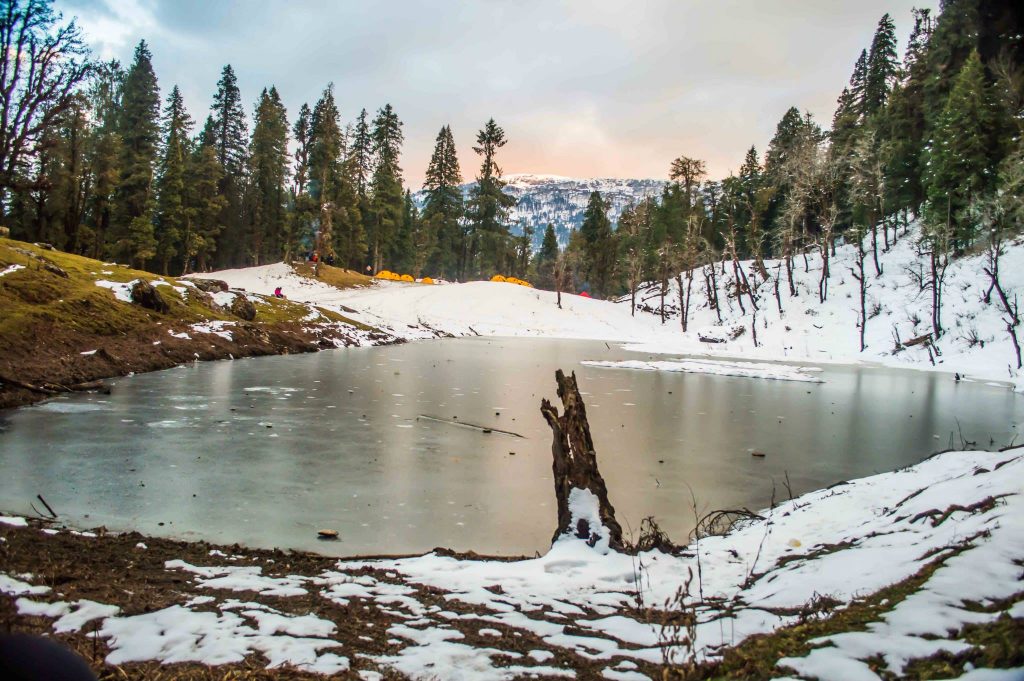
Day 2: Sankri to Juda Ka Talab (Trek)
The trek officially begins on the second day as you set out from Sankri to Juda Ka Talab.
The trail takes you through dense forests of pine and oak trees, and you’ll start to feel the crisp mountain air.
Juda Ka Talab is a serene campsite by a small lake surrounded by snow-clad peaks.

Day 3: Juda Ka Talab to Kedarkantha Base
You’ll continue your ascent towards the Kedarkantha Base on the third day.
The trail offers beautiful views of the surrounding mountains. As you gain altitude, you’ll begin to experience snow.
The Kedarkantha Base is where you’ll spend the night, preparing for the summit push the following day.

Day 4: Kedarkantha Base to Summit and trek back
This is the day you’ve been eagerly anticipating – the summit day.
You’ll start early in the morning, with your headlamp guiding through the snow.
As you reach the summit, the stunning views of the Himalayas will leave you speechless. You’ll have the opportunity to capture stunning photographs to cherish forever.
After savouring this moment, you’ll descend back to the Kedarkantha Base. Take the Kedarkantha trek photos from the summit, as it is once in a lifetime opportunity!
The Kedarkantha trek height at Summit is approximately 12,500 feet (3,800 metres) above sea level. This height provides a perfect blend of challenge and accessibility, making it suitable for trekkers of various skill levels.
Day 5: Kedarkantha Base to Sankri (Trek)
The journey back to Sankri is a delightful descent. You’ll retrace your steps through the snowy landscapes, passing by familiar landmarks. As you descend, you’ll have a chance to interact with fellow trekkers and share your summit stories.
Day 6: Sankri to Delhi (Drive)
On the final day, you’ll bid farewell to Sankri and embark on the return journey to Delhi. We are sure this trek will remain for life with you!

Best Time for Kedarkantha Trek
The best time to explore the Kedarkantha Trek is during the winter season. This time is from December to April , when the region is blanketed in snow. It creates a magical winter wonderland. The snow-covered landscapes, frozen lakes, and clear skies make this trek a unique and captivating experience.
Kedarkantha trek in winters (Dec – April)
The Kedarkantha trek in winter is a beautiful and moderately challenging adventure in the Indian Himalayas. Here’s what you can expect:
- The entire region is covered in snow during the winter months, turning it into a magical winter wonderland.
- While it’s not the most challenging trek, it’s not a cakewalk. The trail is moderately difficult and suitable for beginners with some fitness.
- You’ll trek through dense forests of pine and oak trees, and the snow-clad landscapes are stunning. The views of snow-capped peaks are breathtaking.
- You’ll spend your nights in cosy tents, huddled around a bonfire, which adds to the adventure and fun.
- Be prepared for cold temperatures, so pack warm clothing and gear. Proper planning is essential to ensure safety.
But many people consider the Kedarkantha trek best time as June– here’s why:
While the prime trekking season is in winter, it’s possible to do the Kedarkantha Trek in June . However, during this time, you’ll experience milder weather and less snow, making it a different experience compared to the snowy wonderland of winter.
June is suitable if you prefer a less challenging trek with more moderate temperatures.
What is the Kedarkantha Trek Difficulty Level?
The Kedarkantha Trek is considered a moderate trek. It’s suitable for both beginners and seasoned trekkers. The gradual ascent and well-defined trails make it accessible to many adventurers.
The trek provides an excellent opportunity for those new to trekking to experience the thrill of the Himalayas while still being manageable for more experienced trekkers.
What is the Kedarkantha Trek Height in Feet?
As mentioned earlier, the highest point of the Kedarkantha Trek is the Kedarkantha Summit, which stands at approximately 12,500 feet (3,800 metres) above sea level. This elevation gives trekkers a sense of accomplishment as they reach the summit and take in the awe-inspiring views of the surrounding peaks.
Take the best Kedarkantha trek photos and share the experience with your loved ones. The Kedarkantha trek difficulty level is suitable for all age groups (considering people with no minimal health issues.)
Kedarkantha Trek Days spans 6, including travel to and from Delhi. This allows trekkers to acclimate gradually to the increasing altitude and enjoy the journey comfortably.
The itinerary is thoughtfully designed to provide a balance of trekking, rest, and exploration, ensuring that you have a fulfilling and memorable experience.
Planning Your Kedarkantha Trek ( Things to Consider )
Before embarking on the Kedarkantha Trek, there are several essential considerations to keep in mind to ensure a safe and enjoyable adventure:
1. Fitness Level
While the trek is moderate, it’s essential to have a basic level of fitness. Regular exercise and cardiovascular workouts can help prepare your body for the trek. Consider incorporating hiking and jogging into your fitness routine in the months leading up to the trek.
2. Acclimatisation
Proper acclimatisation is crucial when trekking in high-altitude regions. The gradual ascent of the Kedarkantha Trek allows for acclimatisation.
However, listening to your body, staying hydrated, and being aware of any signs of altitude sickness is essential. Trekkers should be prepared for altitude-related challenges and be ready to descend if necessary.
3. Packing Wisely
Packing the right gear and clothing is essential for a successful trek. Pack warm clothing, including layers, waterproof gear, and insulated trekking boots suitable for snowy terrain. Don’t forget essentials like a good quality sleeping bag, a reliable backpack, and trekking poles for added stability.
4. Guided Trek vs. Independent Trek
Trekkers can choose between a guided trek and an independent trek. Guided trekking tours often provide experienced guides, porters, and logistical support, making your journey more comfortable and organised.
Independent trekkers should be well-prepared, knowledgeable about the route, and have the necessary permits and equipment.
5. Permits and Permissions
Ensure you have the necessary permits and permissions for the trek. Trek organisers typically arrange these or can be obtained from the local authorities. Having the required documents in order will prevent delays or complications during your journey.
Group and Solo Travellers
The Kedarkantha Trek caters to both group and solo travellers, each offering a unique experience:
Group Travellers
Group travel can be a fantastic way to bond with friends or meet like-minded adventurers. Group treks offer the camaraderie of fellow trekkers, opportunities for shared experiences, and the chance to make new friends. It also provides added safety and support, especially in challenging conditions.
Solo Travellers
Solo trekkers can enjoy solitude and the freedom to set their own pace. Trekking alone allows deep introspection and a more intimate connection with the natural surroundings. However, solo trekkers should take additional precautions, inform someone about their plans, and have emergency communication options in place.
Why Kedarkantha Trek?
So, what makes the Kedarkantha Trek a top choice for trekkers? Here are some top reasons:
1. Snowy Wonderland
The winter trek offers a magical experience with pristine snowscapes, making it one of the best snow treks in India. The trekking trail transforms into a glistening white paradise, creating a surreal and enchanting atmosphere.
2. Breathtaking Views
The Kedarkantha Trek rewards trekkers with stunning panoramic views of the Himalayas, including peaks like Swargarohini, Bandarpoonch, and Black Peak. The clear mountain air and expansive vistas make every step of the journey worthwhile.
3. Gradual Ascent
The trek’s gradual ascent allows for better acclimatisation and makes it accessible to trekkers of various fitness levels. Whether you’re a beginner or an experienced trekker, the Kedarkantha Trek provides a well-balanced challenge.
4. Rich Flora and Fauna
The trek takes you through beautiful forests adorned with pine, oak, and rhododendron trees. As you explore these forests, you may have the chance to spot a variety of wildlife, including Himalayan deer and leopards. The diverse ecosystem adds to the trek’s allure.
5. Local Culture
Along the trail, you’ll have the opportunity to interact with locals from the Garhwal region. This cultural exchange allows you to experience their traditional way of life, including their warm hospitality and delicious Garhwali cuisine. Sharing stories with the locals is an enriching part of the trek.
The Kedarkantha Trek offers an exhilarating journey through the snow-covered trails of the Garhwal Himalayas. Whether you’re seeking the thrill of a snowy adventure or the serenity of a summer trek, Kedarkantha has it all.
It has the best breathtaking views of the majestic Himalayan peaks, rich cultural practices and positive vibes. So, gear up, plan your adventure, and embark on this beautiful journey!
Leave a Reply Cancel reply
Your email address will not be published. Required fields are marked *
Save my name, email, and website in this browser for the next time I comment.
Recent Posts


Kedarkantha Trek
- Trek Grade Easy - Moderate
- Trek Distance 11 Kms
- Trek Duration 6 Days
- Highest Altitude 12,500 ft.
- Basecamp Sankari
Call Our Mountain Experts
- +91-7060032966 Adhish ( Mountain Expert) [email protected]
- Dehradun To Dehradun
Located in Govind Pashu Vihar National Park in Uttarakhand, the Kedarkantha trek is a 6-day journey that attracts both skilled trekkers and beginners. The expedition can be changed to last for six days, including travelling days from Dehradun to the base camp and back. Kedarkantha is a popular and beloved trekking destination in India, providing spectacular sights and memorable experiences for those who start it. The summit climb is the key reason that the expedition in the Indian Mountain range is highly preferred by several. Numerous elements add to its appeal. The ascent to the peak of Kedarkantha is a pleasing experience. From the starting point of the expedition, the summit towered above, biding travellers to dominate its snowy incline.
As the sunlight climbs, the journey begins, and with each step, the incredible scenery unfolds, disclosing a breathtaking view of the bordering landscape. The climb is challenging. The whole stretch is progressively steep. As you get closer to the summit, it becomes tricky, too. Yet the giant mountains of the upper Himalayas keep you firm up until you ultimately reach the summit. As you stretch on your own and absorb the views of the Mountain ranges from the summit, you feel a solid sense of contentment and success. This is an unrivalled feeling. A few trips supply the same experience, making it prominent amongst beginners for its finest summit climb. Outside the summit, the trek is also distinct for its lovely clearings. Exceptionally seldom will you locate spectacular clearings on a trek that gives way to some remainder spots and beautiful campsites. This expedition is loaded with clearings on all the various routes. Moreover, the cleanings are at the ideal places, giving you stunning vantage points to appreciate the expedition and its views.
Day 1: Dehradun to Sankari by Road
Day 2: sankari to juda ka talab by trek, day 3: juda ka talab to lohasu base cam kedarkantha, day 4: kedarkantha base camp to kedarkantha summit and back to hargaun, day 5: hargaun to sankari, day 6: sankari to dehradun, about kedarkantha trek.
Nestled within the Govind Pashu Bihar National Forest in Uttarakhand, the 6-day Kedarkantha expedition uses an attractive journey in the middle of the Mountain ranges. As you pass through varied terrains, you’ll witness breathtaking daybreaks and sunsets. Since Kedarkantha is a singular peak, several courses bring about the summit. Our journey will undoubtedly take us up via Sankri and down using Hargaon. Our Kedarkantha trip starts at Dehradun, where we will drive to Sankri town, situated at an elevation of 6400 ft. It takes around 10 hours to reach Sankri, so it’s a long journey, yet the road to the village is similarly enchanting. From Sankri, we will undoubtedly begin our trek the following early morning. Hiking from Sankri to Juda Ka Talab, our next outdoor camping place at 9100 ft, you will experience perfumed yearning and maple covers and detect some plunging streams on the way.
We will spend a leisurely day at the Juda Ka Talab campsite with terrific views of the Swargrohini group of heights. The following day, we will embark on an expedition to the base camp of Kedarkantha, located at 11,250 feet, covering a range of roughly 4.5 kilometres. Throughout the winter season, the route traverses extravagant Himalayan meadows buried in snow, using excellent vistas of the surrounding Himalayan heights. The complying with the day, we will undoubtedly make our trek to the Kedarkantha top. Magnificent views of snow-capped hills await you. When you reach the summit, you are getting on top of the world; you will see 360 sights of the Himalayan ranges. The summit is positioned at an elevation of 12,500 ft, and today’s route can be tricky compared to other days. The breathtaking views you receive from the top make up for the lengthy trek to the top. Enjoy the pictures in front of you, and after investing time, we will certainly start coming down toward Hargaon, our following campsite. Hargaon lies at an altitude of 8900 ft, and we will get to the camp by evening. The next day, we will trek back to Sankri with coniferous woodland covers. Staying the night at Sankri, we will drive back to Dehradun the following day, ending our lovely trip. From Dehradun, you can make further bookings for your journey.
What Mountain Expert Say
Preetam | Founder & C.E.O
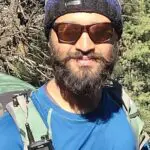
The founder of this trekking organisation and have almost 12 years of experience in mountain guiding with 6000-7000 meters peaks scaled by him.
Not only this, but the founder have also guided over 200 Himalayan treks like Bali Pass, Buran Ghati, Rupin Pass, Pin Bhabha, Stok Kangri, Black Peak several times.
Why You Should Do Kedarkantha Trek
Nestled at 12,500 feet, the Kedarkantha Optimal Expedition is a beloved winter journey that flaunts breathtaking views. With its moderate problem level, this trek deals with amateur and knowledgeable trekkers. The breathtaking panoramas from the summit are stunning and make the climb worth the initiative. Submerse on your own in the Himalayas’ charming elegance, characterized by lush fields, looming heights, snowy routes, frozen lakes, and a kaleidoscopic sky, in this unforgettable winter season excursion. The expedition also includes several of the most attractive campsites, near want covers and in the middle of the snow. You can witness sensational daybreaks and sunsets from your camping areas and indulge in the peace of nature. The view from the summit differs from anything you’ve ever seen before. You can watch the impressive Yamunotri and Gangotri come to a head together with the Black Height, Bandarpoonch, and the Swargrohini group of peaks. The Kedarkantha trip is ideally undertaken throughout December-January and March-April, when snowfall is plentiful, creating a charming environment that will astound both journey and nature lovers. The trek supplies an incredible experience, with the snow-covered landscape leaving you in awe. The expedition likewise showcases several of the most effective Himalayan flora. En route, you will cross spectacular Rhododendron, Oak, Pine, Walnut, and Chestnut covers.
The famous Red Rice is likewise organic in the Kedarkantha area. You also see the lives in remote towns throughout the cold weather, which is a unique experience. This expedition holds the hearts of many trekkers in the country. According to local ideas, the Kedarkantha Peak holds a mythical significance. It is said that Kedarkantha was initially intended to be the place of Kedarnath. The tale has it that when Lord Shiva, disguised as a bull, sought refuge in Kedarkantha to conceal from the Pandavas, the town’s inhabitants disrupted his peace. Consequently, Lord Shiva relocated to his existing house in Kedarnath. The residents of Sankri claim that the spear of Lord Shiva, located atop the Kedarkantha Height, safeguards the people and provides food to the Himalayan Rivers.
Best Time to Do Kedarkantha Trek
The optimum time to take on the Kedarkantha trek is throughout the winter, specifically from December to April. Throughout this duration, the trek is wholly immersed in snowy problems. As you embark on the trip from Sankri to Juda Ka Talab, you will witness the first snowfall on the extremely initial day of the trek.
Furthermore, Kedarkantha is among the unusual trips that can be done in the winter season. Throughout winter, a lot of routes in the Himalayas end up needing to be more inaccessible due to heavy snowfall and unmanageable weather conditions. Nonetheless, Kedarkantha offers the right amount of snow and allows accessibility to a summit at an outstanding altitude of 12,500 feet! Standing on the top at sunup is a charming experience, with impressive heights surrounding you and a thrilling gold light that feels classic. It is a view that opposes summary. So, if you want to hike the Himalayas throughout the Christmas holidays or begin your New Year at the summit, then enrolling in the Kedarkantha trip is a must.
Here are some quick details about the temperature possibilities:
In December, January and February, expect daytime temperature levels to vary from 13 to 18 degrees Celsius. Nevertheless, once the sun sets, temperatures can drop as reduced as -7 levels Celsius. Bear in mind that as you rise to higher elevations, it will also become colder. The Kedarkantha base camp is known for chilly winds, so pack adequate cosy garments.
From March to May, anticipate daytime temperature levels to range from 16 to 20 degrees. Nighttime temperatures may go down to 3 to 4 degrees, and if there is snow, it can reach zero levels. Since there will certainly be snow till April, the Kedarkantha trek is an excellent choice for the summer holidays. This expedition is considered easy-moderate, making it ideal for youngsters too.
Day Wise Detailed Itinerary of Kedarkantha Trek
Day 1: dehradun to sankari by road (210 kms).
- Altitude: 1,950 m/ 6,400 ft.
- Driving Range: Around 220 kilometres (approximately 10 hours).
- Pickup Point: Dehradun at 6:30 AM.
- Automobile Type: Tata Sumo/Tempo traveller or a comparable setting of transportation.
- Available Network: BSNL.
- Expected Arrival Time in Sankri: 5:00 PM.
- Lodging: Hotel with attached restroom and continuous supply of hot water
Our journey begins with Dehradun, where we will select you in Tata Sumo or comparable lorries at 6:30 AM. You are requested to report at the pickup point by the time. From Dehradun, we will drive to Sankri, which goes to a distance of 220 km from Dehradun. It may take around 8 – 9 hrs or even more to get to Sankri, as the mountain roadways can be pretty rough sometimes. However, the road to Sankri is rather picturesque. On your way, you will undoubtedly cross attractive places like Mussoorie, Mori, Naitwar, and so on. You will surely drive along the beautiful Yamuna and Tons River with evergreen lining the roadway.
The River is milky white in some locations and transparent green in others. The fragrance of pinewood and the elegance of nature will make up for the long trip to Sankri. The last stretch of the roadway, about 22 km from Sankri, is much more beautiful as you get into the Govind National Park, famous for being home to much exotic flora and fauna. On reaching Sankri, we will check in at our resort. After refurbishing, you can spend the evening in the charming district of Sankri at your leisure. You can head out for a walk in this enchanting town.
Sankri is a trekkers’ centre as it is the base camp for not one or two but 11 Himalayan expeditions, including prominent trips like Har Ki Dun. At Sankri, the BSNL network is readily available; however, it could be more regular. You can likewise see a stunning sunset at Sankri Village in the backdrop of the Himalayas, an excellent opportunity for photographers to capture all the appeal around. At night, you can have dinner at your hotel or in the regional town dhabas to get a preference for the regional flavours. Stay overnight at Sankri, and we will start our expedition complying with the day.
Day 2: Trek From Sankari To Juda Ka Talab (3.8 Kms)
- Elevation: 6400 ft – 9100 ft.
- Trek Distance: 3.8 kilometres
- Elevation Gain:- 800m/ 2,700 ft.
- An expedition with thick woodlands of maple and pine goes across a few streams and lovely meadows.
- Stay in tents on twin sharing.
Travelling for the Kedarkantha top starts at Sankri, our base village for the trip, and today, we will hike from here to Juda Ka Talab, a stunning towering lake. Start your day early, have your breakfast and go out straight in the direction of Juda Ka Talab. The lake is situated at an altitude of 9100 ft, and the trip distance is about 4 km. It will take around 5 hours to get to the Lake. As you start your trip out of Sankri town, you will undoubtedly venture right into the village expansion Saur, and from here, you will walk along a stream, and then we will deviate towards the forest of pine and maple, climbing sharply. We will go across numerous suspension bridges and little hill towns on our means to Juda Ka Talab. Today’s route is quite broad and ascends progressively for about 2-3 hours. Throughout the summer seasons, the route teems with greenery, and you will spot lots of wildflowers on your way. A rug of maple and want leaves covers the route and opens to lavish green meadows. During wintertime, the trail is covered in snow, and depending on the snow conditions, you may require gaiters to browse the course correctly.
As you hike uphill, you may detect wild animals on the trail, like the Himalayan Languors. While they are rather timid, they move swiftly, swinging from branch to branch, so it takes time to catch a proper glance at them. Apart from this, you might additionally detect boars, hares, and martens. The Juda Ka Talab camping site is lovely, with an alpine lake on one side and a pine woodland on the other; it nearly feels unique below. In the lap of hills and the centre of want and snow, the unique charm of Juda Ka Talab is just otherworldly. During peak winters, a sheet of ice forms on the lake, creating a picture-perfect view. The lake also has a natural passage that supplies water to nearby citizens. The residents consider the lake as spiritual and think that Lord Shiva practised meditation at Kedarkantha, and droplets dropping from his hair created the lake. We will camp right here for the evening. You can click some attractive photos below and take nature strolls. In the evening, a bonfire is an excellent concept to relish your supper and warm beverages, talking up with your fellow travellers. The evening skies are merely breathtaking, with an assortment of the brightest stars spectacular the skies. Rest overnight in your camping tents.
Day 3: Juda Ka Talab To Lohasu (Kedarkantha Base camp) 3 kms
- Stay – Overnight stay at the campsite.
- Meal – Breakfast, Lunch and Dinner
- Distance – 3 km
- Time Taken – approx. 3 hrs
- Altitude – 9,100 feet to 11,250 feet.
- Altitude Difference – 650 meters/ 2,150 feet.
- Trek Grade – Easy to Moderate
As the day dawns, we’ll start our adventure, beginning with a nourishing morning meal and a spectacular view of the sunrise. We’ll then reach the Kedarkantha Base Camp, positioned at 11,250 feet.
The distance from Juda Ka Talab to the base camp is approximately 4 kilometres, and the journey needs to take around 3 hours at a moderate rate. The path is well-marked, making it simple to adhere to. As we advance, the trail becomes progressively steeper; however, the landscapes become much more exciting, with looming Himalayan heights and extensive fields. The path passes through a dense forest of pine and oak, opening up to stunning areas where shepherd huts dot the landscape.
The scenic views of Swargrohini come to a head; Bandarpoonch, Ranglana, Kala Nag, and other stunning heights are mind-blowing. The snow-covered path in the winter season and the lavish environment-friendly landscape in summertime provide a unique and delightful experience for travellers. Upon getting to the campsite, relax, renew, and take in the beauty of your environment.
Take pleasure in a warm supper and look at the starry night skies, loaded with twinkling celebrities. Because of the high altitude, you must layer up and safeguard yourself from the cold. Retire to your camping tents early to remainder and get ready for the top trek the complying day.
Day 4: Lohasu - Kedarkantha Base Camp to Kedarkantha Peak Summit and return back to hargaon camp
- Distance – 7 km
- Time Taken – approx. 7 hrs
- Altitude – 11,250 feet – 12, 500 ft – 8900 feet.
- Altitude Difference – 700meters / 2,350feet
- Trek Grade – Moderate
On this day, we are going to embark on a trip to the Kedarkantha top, which stands at an elevation of 12,500 ft. Our trek for today will consist of hiking from the beginning indicate the Kedarkantha top, and afterwards making our way back to the Hargaon camping area. The total distance covered during this journey, from summit to Hargaon, is around 6 kilometres, and the estimated time it will take is around 7 hours. After a pleasurable morning meal in the morning, we will lay out for the Kedarkantha summit. The trip is a progressive slope, nevertheless, it gets rather high in the long run and may examine your abilities and health and fitness a little. Today additionally your expedition will begin by going across a forest of towering Oaks and Pines. The leaves strewn on the ground, scrunching your feet and you can additionally hear the faint noises of streams spurting by. Quickly the forests open up and you are much closer to the optimal currently and from here the path will certainly start to obtain hard as a sharp slope lies in front of you. However the struggle to arrive deserves it once you make it to the top and the spectacular views of the Mountain range await you. You will literally seem like being on cloud nine and filled with a sense of achievement and inner peace. The remarkable sights will certainly invigorate you after the difficult trip. There’s likewise a tiny temple of Lord Shiva, Siren Parvati, and Lord Ganesha at the summit. After enjoying the attractive views and indulging in nature’s abundance, we will start descending and expedition downhill to the Kedarkantha base camp where we will have our lunch, and post-lunch we will begin descending downhill, all the way to Hargaon. The descent is quite easier and faster and quickly you will certainly get to the campground at Hargaon, coming down to an altitude of 8900 ft. Reaching the Hargaon campground marks the end of our day, we will establish camps below, appreciate a great supper and retire in our camping tents for the evening.
Day 5: Trek from Hargaun to Sankari - 4.5 Kms
- Stay – Overnight stay at the hotel.
- Distance – 4.5 km
- Trek Grade – Easy
The last section of the trip involves a downhill trek from Hargaon to Sankri. Beginning at an elevation of 8900 feet, we’ll make our way down to 6400 feet, covering around 6 kilometres in overall distance. The descent itself covers around 4 kilometres. Beginning your day by viewing the dawn over the Mountain range, a captivating sight.
Adhering to breakfast, we’ll descend toward Sankri, travelling through charming forests and beside babbling streams. You can refill your canteen from the streams along the road. As we proceed, the woodland opens to expose an impressive view of the Har ki Dun Valley from a ridge. The verdant hills of the Valley are awe-inspiring. We’ll proceed with our journey, absorbing the pictures as we descend the incline. The forest will become more dense, and eventually, we’ll come to Sankri, where we’ll check out our holiday accommodations and have the chance to refresh ourselves.
In the evening, you’ll have the possibility to explore the enchanting village. Although there are few patronised Sankri, you can still buy wooden invention products, toys, and home designs as souvenirs of your journey. Connect with the locals and learn more about the local way of life. Life at Sankri is slow-paced, and the religion is solid here.
One hundred twenty family members in Sankri live in wood huts to safeguard themselves from the cool, and the staples are potato rice and apples. At Sankri, they additionally hold routine fairs or melas where amusement happens in singing and dancing to indigenous folk tunes. For supper, you can see the dhabas, which offer some tasty cuisines, or you can have dinner at the hotel properties. Stay overnight in the resort after a strenuous yet incredible journey.
Day 6: Drive from Sankari To Dehradun (210 kms)
- Meal – Tea, Coffee & Biscuits
- Distance – 210 km
- Time Taken – approx. 8 – 9 hrs
Today, on the final day of our wonderful trip, we will return to Dehradun, loaded with valued minutes. Bolero, Tata Sumo, Travller or similar cars will be provided from Sankri to Dehradun. It is recommended to look at the resort by 7:00 AM to guarantee a very early begin to our 10-hour journey covering a distance of 220 km. Beginning early will be helpful. We will again return via NH 123, delighting in the beautiful elegance. Value the nature around you with picturesque panoramas extending alongside everywhere. We will certainly get to Dehradun by 7:00 PM, so make your further reservations as necessary.
What should you pack for the Kedarkantha Trek
1. trekking shoes.
For any trek at high altitudes, it is necessary to have sturdy and trustworthy hiking shoes that offer outstanding traction, give ankle joint support, and are appropriate for snowy problems.
2. Backpack
For a week-long trek at high altitude, a 50-60 litre backpack is ideal. Try to find one with ample hip and shoulder assistance, along with practical pockets that enable fast accessibility to your fundamentals.
When travelling at high altitudes, the most significant challenge is the cold. One of the most reliable methods to handle the cold is by using several layers of garments. Layers offer the best protection and permit flexibility in the mountainous environment. Furthermore, given that the weather in the hills can change regularly, you can conveniently change your layers by eliminating or including them as required.
a. Base Layer: 3 Tee shirts
Use one T-shirt and bring two. Lug complete sleeve dry-fit T-shirts (ideally captured). Ensure among them is somewhat thickish. If you do not obtain full-sleeved dry-fit T-shirts, you can purchase full sleeves of various other products.
What is very important is that you get full-sleeved tee shirts. These prevent your arms and neck from becoming sunburnt. In the rarified air on an expedition, especially at high altitudes, UV rays can shed you in no time.
Dry-fit Tees quickly completely dry your sweat. They are simple to clean, and in case of a rainy day, they dry out quicker. Round-neck Tees are all right; however, grabbed ones are much better.
Maintain the 3-4-5 concept in mind. Three insulation layers in summertime, 4 in post-monsoon, 5 in winter.
The number of cosy layers you carry relies on the period you’re entering. If you’re going any time:
– From March to September (summer season), three layers
— Between September and November (post-monsoon), you will undoubtedly need four layers
— During the cold weather, which spans from December to March, you’ll intend to contend with at least five layers of cosy garments to keep you comfortable.
b. Outer Coat
It would help if you had coats and fleece coats that are light and can fold up right into small rolls.
To satisfy your need for an external garment, select a jacket with cushioning. It is not required for the product to be waterproof, yet it ought to properly block the wind and cold. Ensure your cushioned coat also includes a hood.
c. Two Trek Pants
Two pairs of trek trousers need to be sufficient for any Himalayan expedition. Use one set and bring one simply in case it rains. Trek pants with zippered cut-offs at the thighs are ideal for trips. Likewise, select quick-dry trousers over cotton. They run out quickly in case of small stream crossings/ rainfall.
Essential Things for a Successful Expedition
Before embarking on your experience, ensure you have all the necessary accessories. These products are vital for a secure and delightful expedition, so it is essential to prioritize them. While some trekkers may wait till the last minute to gather their gear, we advise taking an aggressive technique. Begin accumulating your devices early to guarantee a stress-free and effective expedition.
1. Sunglasses
Sunglasses are to prevent snow blindness. On any Himalayan trek, especially if you’re going in a snowy season, a slight overexposure to direct sunshine on snow can result in snow blindness (even about a half hour’s direct exposure). That’s because fallen snow is like countless mirrors that reflect direct UV rays. So you require sunglasses with UV security.
It’s vital to use a sun cap throughout your expedition. Failing to do so can result in extreme migraines, sunlight strokes, and fast dehydration. Make sure to shield your head and face from the sunlight’s harmful rays by wearing a cap or hat.
3. Hand Handwear Covers – Hand Gloves
If you go whenever there is snow, you’ll require handwear covers to hold something or to steady yourself in the snow. You also want the gloves to keep you warm. Get artificial hand handwear covers that have waterproofing outside and a padded cellular lining on the inside.
4. Woollen Cap or Balaclava
Make sure these cover your ears. In the chilly hills, you lose a great deal of warmth from your head. This is why you are required to keep your head protected, specifically when the sunlight is down. Mornings or late evenings. On a cold trekking day, you should wear your woollen cap even while travelling. Pass days are understood for this.
It is essential to secure your ears from the cold, so a headpiece that covers them is a must-have. A balaclava is a terrific alternative, as it not only protects your ears but also your neck and parts of your face. Make sure to pick a headpiece that includes ear protection instead of just a cap that covers the top of your head.
5. Socks (3 pairs)
“Pack three pairs of socks, including two pairs of sports socks, for included padding and warmth. Go with artificial or synthetic-blend socks instead of cotton, as they’ll dry faster and retain much less wetness. In addition to the sports socks, bring a pair of woollen socks for additional heat.”
For preserving warmth and cosiness throughout the night, specifically while sleeping, woollen socks are a superb selection. If woollen socks are unavailable, wearing two sports socks can help achieve the same function.
6. Headlamp
You need to obtain a headlamp because it frees your hands to do various other tasks. On a long expedition, you’ll need your hands cost-free to wash dishes, pitch outdoor tents and hold your trip posts.
7. Trekking pole
Trekking poles offer steadiness and assistance, minimizing the initiative required for your trip by almost 40%. When taking on high inclines and declines on Himalayan treks, a pair of posts will significantly enhance your experience, transforming a challenging hike into an extra leisurely one. While single seats are commonly utilized in India, two poles supply boosted equilibrium and stability, in addition to a visible increase in strolling rate.
8. Rainwear
On a trek, the weather conditions can transform quickly. A bright, warm day can develop into a downpour in an issue of minutes. Bring a poncho or a rainfall jacket to tackle this. A coat is a significant rainfall cover with openings for your arms and head. It is very effective because it covers both you and your backpack. It is very light and weighs next to nothing.
9. Rain Cover for Your Backpack
Keep your Backpack and its components secured from the elements with a trusted rainfall cover. Your knapsack is a necessary friend; bring all your vital products, such as dry clothes and cosy equipment. Your backpack must continue to be waterproof, and lots of contemporary designs come geared up with integrated rain covers to ensure your personal belongings remain safe and completely dry.
10. Daypack (20-30 litres, optional)
Some trekkers offload their bags on mules or porters on their treks. While we do not encourage this practice, in case you opt for emptying, carrying a daypack is mandatory. A daypack is a mini backpack, just smaller in size.
If your backpack does not have a rain cover, ensure you obtain a rainfall cover by either
- purchasing a rainfall cover
- Or cutting a large plastic sheet to the dimension of your knapsack. You can roll the plastic sheet around your backpack and maintain it in position with a string or elastic.
If you pick to have a concierge or burro lug your travel luggage throughout your trek, you must bring a daypack. A daypack is a smaller variation of a knapsack, usually ranging in dimension from 20-30 litres. This permits you to carry essentials like water, treats and added layers for the day while your bigger baggage is being moved for you.
In your daypack, you carry basics like water bottles, rainwear, emergency medicines, headlamps, some treats and a cosy layer. Your major knapsack with most of your tools is accessible only at the campgrounds.
A daypack is a smaller-sized backpack that is generally of 20-30 litre capacity. Laptop computer bags are not daypacks. Please do not get them.
Various Other Necessary Requirements.
1. a toilet kit..
Keep your toilet kit light. Carry simply the basics– toothbrush, toothpaste, tiny soap, bathroom tissue roll, a small moisturiser and lip balm. You will not be able to have a bathroom on any trek, so do not overload on soaps and hair shampoos.
When loading for a trek, consider bringing miniature versions of crucial products. This will help reduce unnecessary bulk and weight in your baggage. If you’re taking a trip with a team, consider sharing a single tube of toothpaste amongst yourselves. In addition, there’s no requirement to bring huge toilet paper rolls, as the tiniest size rolls are usually sufficient for a trip.
For ladies: If you are likely to have your periods on your trek day, do not fret about it. You can utilize your pads, tampons or menstrual mugs on a trek. There will undoubtedly be commode outdoors tents where you can obtain altered.
Guarantee that you have Ziploc bags handy to deliver your menstrual cycle waste. It is prohibited to desert hygienic litter in the hills, and it is also considered socially undesirable.
Personal Medical Set.
Lug these medications with you, quickly accessible at any time. Do not take any medication unless you have consulted your trip leader.
- Diamox (1 Strip): Get on a program of a fifty per cent tablet of Diamox starting from your home every 12 hours (125 mg). Continue the medicine up until you descend to the base camp from your trek. Being on a preventative course of Diamox considerably lowers the chances of Acute Mountain Sickness on a high-elevation expedition.
- Dolo 650 (5 tablets): This is a paracetamol. It aids in dealing with fever and light discomfort.
- Avomine (4 tablet computers): Bring this mainly if you are prone to motion sickness. Pop one-half hour before the start of your road trip.
- If you experience an abrupt leg twist or muscular tissue strain, take into consideration taking a combiflam tablet. Combiflam is made to ease pain and also consists of paracetamol.
- If you believe your food needs to be effectively digested, take four tablet computers of Digene. After that, sharpen your expedition leader immediately. This could be a sign of Acute Mountain Sickness (AMS), so it is essential to resolve it promptly.
- ORS (6 packs): Take a pack of ORS water a minimum of daily, normally mid-day when you are in the centre of your trip. It renews essential salts lost while hiking. Idea: It also makes cold water less complicated to consume alcohol.
- Think about bringing a knee brace with you if you have a history of knee concerns or are vulnerable to knee injuries.
Compulsory Documents to Carry.
These are papers needed for lawful functions by Trekup India and the forest division. With no of these, you will not be permitted to travel.
Government-issued ID: Please carry the original and a copy of a valid government-issued ID, such as a driver’s license, Aadhar card, or passport. This is called for by the forest division for identification purposes. and 2 passport size photos.
Trek Cost Exclusion
- Stay 3 Nights in tented accommodation at respective campsites of Trekup India on a sharing basis and 2 days in a hotel, guesthouse.
- Meals: Trekup India provided cooked meals during the trek, starting with Dinner on Day 01 to tea, coffe on day 6 (Meals are simple, nutritious, and vegetarian and non-repeated meals)
- Transport: Dehradun to Sankari and return on sharing jeeps
Trek Equipment’s:
- Sleeping bags, Sleeping tents, Kitchen tent, Dining tent, and Toilet Tents.
- Amenities: All utensils, sleeping mattresses (Black foam mats), Crampons, and Gaiters for snow.
- Health & Safety: First Aid Box, Oxygen Cylinders, Stretchers, Oxi meters, BP Machines, health.
- Permits: Forest Permits and Camping Permission Fee.
- Trek Crew: High Altitude Chef, Helpers, Trek Leader & Guides, and other support team.
- Potters & Mules: Potters and Mules to carry all trekking equipment, ration, and vegetables.
- GST 5% (it is Mandatory)
- Any insurance (Trekup India recommends each trekker to get insurance)
- Any Meals/accommodation beside the itinerary or not mentioned in the program.
- Any Bus / Airfare to/from trek start/end point
- Personal Medical expenses do carry your medication.
- Any personal services such as Laundry, phone calls, liquors, mineral water, etc.
- Any still / video camera fee
- Any Entrance fee Monuments, Monasteries, Museums, Temples – Pay directly on the spot.
- Mules or porter charges to carry private baggage (Offload Charges for bag 400 per day, per bag For those who pay 4 days pirior to trek date.(500 per day for offline). Note: Bag weight should not be more than 10 kg.
- Any emergency evacuation charges
- Any services that are not mentioned in the cost inclusion section.
How To Reach Dehradun?
How to get to Dehradun by Air
Playful Give Airport is Dehradun’s very own airport. It is additionally the biggest airport terminal in Uttarakhand. Routine trips from cities like New Delhi and Mumbai fly through this airport. This is 29.4 km away from the primary town of Dehradun. As soon as you land at the airport terminal, you can obtain a pre-paid taxi to the city quickly.
Nearest Flight Terminal: Dehradun
How to reach Dehradun by road
Regular bus solutions ply to and fro the city of Dehradun. They operate on an everyday basis, whether day or night. You can also take private or shared taxis for the very same route.
How to reach Dehradun by train
Dehradun railway station attaches Dehradun to the rest of India by the train network. Routine rail solutions operate from side to side in the city of Dehradun. The most renowned among them is the Dehradun Jan Shatabdi Express, which runs from the New Delhi train terminal, travelling at a maximum speed of 120 km/hr.
Other Treks Like Kedarkantha Trek
Rent trek gears.

- Summer Treks
- Winter Treks
- Offbeat Trails
- Expeditions
- South India Treks
- Western Ghats
- Find Your Next Adventure-->
- Latest Updates
- Contests & Giveaways
- Practicing Sustainability
- Practicing Safety
- Informative
- Our Book of Adventures
- The Opinion Corner
Picture Blogs
- Trekkers' Blogs
- Customize Your Trip
Kedarkantha Photo Story
Bikat adventures.
We all need to climb a mountain at least once in our lives. It changes us, inspires us and puts things in perspective. There is something about inhaling the wild carefree air that fills us up with positivity energy, hope, and dreams.
At the heart of Uttarakhand lies numerous proud peaks, one of which is Kedarkantha . It is perfect for all adventurous souls who love snow and high mountains. In just a matter of 4 days, you come back from what seems like a completely different planet. You get to walk in snow that sparkles like a million fallen stars on earth, you step foot on a frozen lake, watch snow clad peaks come to life after dark and watch the sunrise from the top of a mountain.
All this is better explained with some photos, so allow me to take you on a journey and show you why Kedarkantha is one of the most loved winter summit treks in the country.
Day 1: Gradual ascend and LOTS of snow
The starting point of the trek is a charming little village called Sankri . Life goes on at a different pace here. There are no bumper to bumper jams, no high rise buildings, no rush of any sort anywhere in the vicinity. Breathe in the peace that surrounds you and gear up to start your trek. The trail starts after a short 5 minute walk from the village.
And boom, all of a sudden you find yourself in a beautiful pine forest that welcomes sunlight throughout the day.
It's a short 4-5 hours hike today, but not at all challenging. You find yourself surrounded by knee-deep snow and have to wade through the zigzag path up the slope.
The forest is your companion today; you walk in and out of it, heading uphill throughout the way. Keep an eye out for woodpeckers and snow falling off tree branches, both are equally pleasant to experience.
There are two tiny restaurants midway that serve omelettes, maggie and hot beverages. Fill your bellies up, take in the sunshine, you are almost there now.
The rest of the way is a pleasant walk with beauty on all sides.
And just like that, you'll be at your first campsite. It’s hard to believe that you can reach such a beautiful place in a matter of hours. A slight change in altitude can do wonders.
I play a little game in my head every time I am at such places. I close my eyes and imagine myself back in the office stressed as hell and open my eyes and remind myself of where I am. And it always, always makes me smile.
Day 2: Frozen Lake. Base camp. Sleeping under the shadow of Kedarkantha
Day 2 is an exciting day.
The trail is easy, the distance is short, and we get to walk on a frozen lake. But remember we need to reach the basecamp today, so the journey is still uphill.
And here we are. Welcome to Juda Ka Tal, a small lake on the trail that freezes during winters. Your first walk on an ice sheet is almost as thrilling as your first walk ever!
The lake somehow gets you brimming with energy – splashing snow on each other and jumping around – is there a joy purer than this?! It is moments like these that make you realize the importance of taking time out for yourself. If the ocean within you is at peace and bubbling with joy at the same time, everything seems okay.
And, we’ve got the best seats in the world waiting for us at base camp. The best seats in the Himalayas. Of all the treks I have been on, I’ve never seen such an incredible campsite.
We can see Kedarkantha clearly from the basecamp. Admire the view, because it is going to shine brighter than the moon at night. We’ll be standing on top of that peak at sunrise the next day.
Day 3: Summit day. Epic views. Ice cold hands
The best thing about Kedarkantha is the expedition like feel. We wake up in the wee hours of the night to start our summit attempt (3AM to be precise). This is the exact same routine to summit higher peaks as well. Consider this a practice ground.
As the sun rises, the views steal our hearts. A 360 view of the Himalayas is a rare sight on treks, but here, the view is open and wide – waiting to be experienced, waiting to present itself as a reward to you. It is pretty intense and magical.
This is the only day that would feel strenuous not just because of the steep ascend but also because of the cold wind blowing in our faces and freezing our hands and feet. But by 7 or 7:30 AM, we'll be standing on top of Kedarkantha, witnessing the awe-inspiring beauty that surrounds us.
The views do not cease to amaze even on the way back down to basecamp. The sun comes up, the cold dissipates and everything starts to seem blissful.
Another highlight of the day is that we get plenty of opportunities to glissade in snow. Do remember to be careful though, these things have a way of turning into an accident very quickly.
The end calls for a celebration. Summiting a peak in winter is no easy feat!
Day 4: And it’s a wrap!
Picture of Hargaon campsite
Today is the easiest of all days. We have camped at Hargaon the previous night, which is just 2 hours away from Sankri. We wake up early to catch the sunrise at our last gorgeous campsite.
Then we make our way back to Sankri and enjoy the hospitality of the locals with a warm meal and endless stories.
So what say you? Are you up for the challenge? Four blissful days in the Himalayas are waiting for you. Get here before the snow melts.
Happy Trekking!
This article was originally written by Pooja Dhiman on 05-02-2018. It was edited and updated by Neeti Singhal on 4-10-2023.
Hi! Bikat Adventures is a learning-based Adventure Organization. Our endeavour is to make the out Read more
Want to Blog for Bikat Adventures?
Add a comment.
* Your email address will not be published. All fields are required.
Submit Enquiry
Choose Trek
Customise Trek
Suggest me a trek
Rent a gear
Volunteer Program
Blogs & Articles
Discounts & Offers
- Kedarkantha: A dream trek
I always wanted to go on a Himalayan trek since my college days. However, the plan never materialized due to my ever-busy group of friends. The idea of going solo on a Himalayan hike was far too daunting for me. Finally, my flatmate and I decided to take some respite from the boring corporate life.
The next task was not very difficult as I had already heard about Kedarkantha being the best winter trek for beginners . After seeing the beautiful photos and reading about the trek, we decided to book Kedarkantha Trek for early march. We booked with Trek The Himalayas for the 7th March 2020 batch.
Prepping for the Trek: Since this was my first winter trek , I had to buy a lot of stuff as the weather in the mountains is quite unpredictable. Decathlon is a one-stop solution for everything you need. If you don’t want to buy it, you can always rent the gear, but my suggestion would be to buy it if you plan to go for 3–4 treks in a span of a few years. And I am sure you will as one who goes to the mountains keep coming back. Our journey started from Mussoorie. The drive from Mussoorie to Sankri had some stupendous views.

We stopped for breakfast near Kempty falls and had delicious Aloo Parathas. This was also a time to interact with our fellow trekkers as we had missed the introduction session at Dehradun station. There were 26 of us. All boys! We stopped for Lunch at Purola. Mobile network is not available after Purola, and that is when you instantly disconnect from the rest of the world. After crossing Purola, we started getting glimpses of snow-clad peaks. The tempo driver pointed out one such majestic peak as Kedarkantha . The sheer magnificence of it filled us all with awe and excitement.

We reached Sankri in the evening. Sankri is a quiet and beautiful village in the Govind Pashu Vihar National Park . After reaching Sankri, we were allotted rooms at the hotel Wild Orchid Inn. The rooms and bathrooms were clean, and there was a geyser for the hot water supply. We were served tea with hot pakodas before the briefing began. It was freezing even in Sankri with a temperature ranging between 2–3 degrees. After the briefing, we collected our rental gear, had dinner, and retired for the night.
We started our trek at 9 am after a hearty breakfast. As soon as the road disappeared, we encountered muddy trails. We never thought we would have to walk in ankle-deep mud on what was supposed to be a snowy winter trek . The trail was easy but very muddy, and it took us around 5 hours to reach our campsite.

Juda ka Talab is a frozen lake at 9600 feet, and luckily for us, we had our campsites right in front of the lake.
Juda ka Talab is a frozen lake at an altitude of 9600 feet.
In the evening, we were informed about the idea of acclimatisation walks in the surrounding areas. It is essential to get acclimatised to higher altitudes to avoid any misadventure or AMS during the trek. When we reached the campsite, we were greeted with a pleasant surprise: hot delicious Momos on a chilly evening at 9600 feet. The tents were on twin sharing basis, and we were provided sleeping bags for the night. It was my first experience sleeping on a snowy surface, and as expected, it was not a pleasing experience. I woke up at around 4 am as my toes were freezing badly. The next morning, our trek leaders were ready with colours as it was Holi. We celebrated Holi at Juda ka Talab .

Today we were going to trek on snow, and our trek leaders advised us to wear microspikes and gaiters. We were to gain an altitude of 1500 feet over a distance of 2–3 km. The trek today was fairly easy, and the Microspikes made trekking on snow a cakewalk. The weather was pleasant, and we had an entire day for ourselves. The views from the Kedarkantha Base camp were surreal.

This certainly is the most beautiful thing about treks. You have these stunning, sky-high mountains with alluring snowy peaks all around you—beautiful blue skies with clouds just a touch away. We spent the day witnessing the beautiful landscapes nature has to offer.

Kedarkantha Base Camp 11500 ft. I sat alone for some time to behold the captivating scenery around me. Mountains, I feel have a sense of permanence about them. They are unaffected by time and space. They teach you a great many things but the most important of them is humility. You realise your insignificance and your mental prowess at the same instant. They stand tall with all their grandeur yet are humble enough to let you conquer them. They teach you to be humble and kind.

Soon, the sun started hiding behind a mountain as if it was returning to its home somewhere in that faraway mountain. It was one of the most beautiful sunsets of my life. Slowly, the sky bustling with vibrant colours started smoothly fading away into deeper shades of night. As it started getting cold outside, we went into the dining tent and started playing games eagerly waiting for our trek leaders to brief us about the summit day. We were told that we would be starting early at 3:30 am the next morning. In the night I woke up to the sound of rainfall, it was midnight. For a moment I thought that we wouldn’t be able to summit and I slept again only to be woken up at 2:30 am by our neighbouring tent mate. Tea and breakfast were served exactly at 3 so that we can move by 3:30 as decided. I was both nervous and excited. It was my first summit trek, and the idea of witnessing the world from a mountain peak was exhilarating. The weather was clear, and we could see a lot of people from other groups starting on their way to the summit. Trekking in the moonlight was an altogether different experience. With our head torches on, we set out on moonlit snow. The glittering rays from the moon fell on the shimmering snow, illuminating our path to the summit. The trail unexpectedly felt easy with gradual ascends. It got very narrow, allowing only one trekker to pass through. After trekking for 2 hours straight, we stopped at a tea stall for some refreshments. The tea stall seemed like an oasis in the middle of the desert. After some hot honey lemon ginger tea, we set out for the climax of our Himalayan summit quest. As the trail to the summit was unfolding itself, we began to witness mighty Himalayan peaks. I stopped for a few minutes to capture the breathtaking views surrounding us.

It began getting very cold and windy as we were climbing. The summit seemingly near was still far away. It was getting challenging to climb further as the trail had gotten very steep, and it was difficult to maintain balance because of the strong chilly winds.

I stopped at a rock, hoping I can wait here till my trek mates come back after summiting. Most of the members of our group were ahead of us, and that’s when our trek leader Rishabh bhai came to us and asked us to keep going. The next sentence from him “ Vaapas jane ka rasta summit ke uss side se hai ” filled me initially with fear and the very next moment with vigorous energy and willpower to reach the summit. I started climbing much faster and stopped only to find a traffic jam on the last 100m patch leading to the summit. I was completely blank when I finally stepped onto the summit. I had been waiting for this very moment for the past 4 days, yet there I was standing with uncharacteristic calmness. We just got enough time to click some spectacular pictures before the inclement weather forced us to descend.

After the beautiful summit with TTH Trek Group, It started snowing just before we reached the campsite. What more could one have asked for? It turned out to be a dreamy trek. After scaling my first summit, I was treated to my first snowfall. It was beautiful beyond words.

After resting for a while, we descended to Juda ka Talab . It was still snowing, and we were all inside our tents after a long day of the trek. The TTH team always exceeded our expectations. But this was unexpected. We were given crispy hot SAMOSAS with tea for snacks. Since it was snowing, our guide, Dinesh Bhai tent-delivered it to us. This gesture by our trek staff filled me with overwhelming gratitude for the mountain people.

I hoped to sleep soundly that night, but nature had other plans. It was continuously snowing from the afternoon, and we had to shake our tents and clear the snow sitting over them else they would fall. Our trek staff cleared the snow from our tents the entire night to make sure we could catch some sleep. I could not thank them enough for this very kind gesture.
The next morning when we woke up, the landscape had turned truly majestical. The silvery snow settled itself on the leaves of trees, and branches adorned with snow. These are the trees you read about in storybooks but witnessing them for real made the last day of our trek more beautiful.

Pine trees covered with snow I will get a better poncho next time:)
It took 4 hours for us to descend. I had completed Kedarkantha summit trek. At that moment, I felt that I had accomplished something priceless. I am going to cherish the memories of this trek for a lifetime. There were times during the trek when I promised myself that I would never return to the mountains, but as they say, the mountains keep calling you back. As I write this, I have already planned my next Himalayan Hike 🙂
Written By: Siddhant Jain
- Search for:
A little something about you, the author. Nothing lengthy, just an overview.
About Kedarkantha Trek
Kedarkantha trek is everything a trekker can dream about; crystal clear mountain, the verdant expanse of rich flora, unexplored mountain terrain of Uttarakhand, jaw-dropping campsites, the serenity of mountain villages, and a glimpse into the distinct culture of locals, the trek is a wholesome package of fun and adventure.
Experiencing the local culture and feasting on local meals is another attraction of the Kedarkantha trek. The warm hospitality of locals is such a rewarding experience that it leaves you wondering at their magnanimity.
A glance at some amazing facts about Kedarkantha
- Region- Uttarakashi, Uttarakhand
- Trek Altitude- 12,500 feet
- Trek Difficulty Level- Easy to Moderate
- Trek Duration- 6 Days
- Trekking Distance- 20 km
- Temperature- Average day temperatures vary degrees Celsius to 20 degrees Celsius and average night temperatures hover between -10 degrees Celsius to 3 degrees Celsius.
- Nearest Railway Station- Dehradun
- Nearest Airport- Jolly Grant Airport, Dehradun
- Last ATM- Purola near Sankri has the last ATM
Trek Details
- Pickup Point on Day 1- Dehradun Railway Station
- Departure time from Dehradun Railway Station on Day 1- 7 am
- 2nd Pickup Point on Day 1- Kitab Ghar bus stand, Mussoorie
- Pick up time from Mussoorie- 7:45 a.m.
- Drop Point on Day 6- Dehradun Railway Station
- Arrival time on Day 6 at Dehradun Railway Station- 6 pm
- Base Camp- Sankri
- Distance from Dehradun to Basecamp, Sankri- 210 km
- Cloakroom: There is no separate cloakroom available. You can hand over your luggage to our team and collect it while returning. We will be keeping it safely at Sankri in the same Homestay.
- The shared vehicle will be a Tata Sumo, Bolero, or so and may be shared with a few other local passengers. The cab will be arranged from Dehradun to Sankri and Sankri to Dehradun.
- We charge Rs.1200/- per person each side .
- The cab is a 7-seater.
- The whole cab costs 7500/- from Dehradun ( one way ).
- Trekkers may choose to travel by bus or local cab to reach Sankri.
- The forest permits for international clients will be as actual and are to be paid by the trekker at the base camp only.
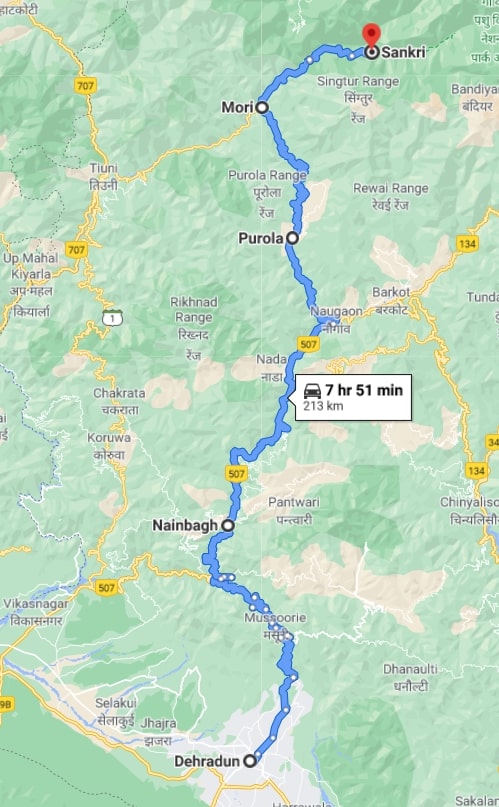
About Kedarkantha
Kedarkantha, a spectacular Himalayan peak in Uttarakhand, stands towering and formidable at an altitude of 12,500 feet, Govind Wildlife Sanctuary and National Park is home to it. Regardless of whether you are trudging on icy wintry routes or crossing your path amid lustrous verdant pine woods, the Kedarkantha journey will thrill you with a diverse assortment of vegetation and animals.
The name Kedarkantha conjures up fantastic images in your head. One of the first pictures that enthrals you is Lord Shiva seated over an enormous Himalayan peak, bestowing his benediction on the earth below. Standing at a height of roughly 12,500 feet, the Kedarkantha pinnacle is the magnificent mountain peak lodged in the Himalayas of Uttrakhand.
Even though Kedarkantha Trek is an ideal destination during all seasons, it is one of the most sought-after winter treks in India. Trekkers marvel at this amazing trek which flatters you with snow till the end of April. The snow-capped peaks encompassed by tall trees offer mesmerizing views from altitudes as low as 10,000 feet.
How to reach Kedarkantha
Sankri is the starting point for the Kedarkantha trek. To go to Kedarkantha from Dehradun, you must first travel to Sankri. Sankri is around 200 (197) kilometers from Dehradun, and it takes about 8 to 10 hours to travel this mountainous path. To go to Kedarkantha from Dehradun, use the government bus, which departs from Mussoorie Bus stand at 8:00 a.m. After about the 7th hour from the starting point, the bus will leave you off in Sankri.
If you by chance miss the morning buses then you can also board the Hanol bus which travels via Mussoorie. According to the route availed by this bus, you have to get down at Mori, and from there you can book a private taxi to Sankri.
You can travel to Dehradun from Delhi by Nandadevi Express which departs at 11:50 pm and reaches Dehradun by 5:40 am. From Dehradun again, you can take a taxi or board a bus to Sankri.
Board a flight from Delhi to Jolly Grant Airport in Dehradun. It will take about 1 hour to reach. From here again, you can follow the directives as mentioned above.
MYTHOLOGY SURROUNDING KEDARKANTHA
Kedarkantha trek is steeped in mythology and that’s what makes it all alluring. The place gets its name from “Kedar Khand” which translates to “Section of Lord Shiva”. It is the historical name of this region. Kedarkantha translates to Throat of Lord Shiva. Legend has it that Lord Shiva once meditated in Kedarkantha and then relocated to Kedarnath.
According to Hindu mythology, Juda Ka Talab owes its origin to the water droplets that fell from Lord Shiva’s hair. Synonymous with its name, a lake (Talab) was formed where water from Lord Shiva’s bun (Juda) touched the ground.
The Godly peak of Swargarohini, one of the glittering attractions of this trek is said to be the stairway to heaven. It is believed that Yudhishitra along with his dog reached heaven trudging up this sacred peak.
The journey to this beautiful abode starts at Sankri which is located at a distance of around 197 km from Dehradun. It takes around 7 hours by road from Dehradun to Sankri and the journey takes you along zigzag roads in the backdrop of lofty mountains with mountain rivers bubbling effervescently nearby. En route, you cross Mussoorie, Damta, Nain Bhag village, Purola, Harsaadi, and Natwad before reaching the remote village of Sankri. Throughout the route, you are treated to the magnificent views of Mussoorie, and awe-inspiring views of high-altitude mountains and rivers such as Yamuna, Ganga, Kedarganga, Supin, and Tons rejuvenate you with their sparkling waters.
At an elevation of about 6,400 feet, Sankri is a quaint village located in the foothills of the Himalayas. It serves as the base camp for the Kedarkantha trek. The trekking route from Sankri takes you to Juda ka Talab, the sacred mountain lake, as you journey along local trails and dense forests.
You are treated to the magical panorama of amazingly beautiful campsites en route to your trek to Kedarkantha.
Juda Ka Talab, the first campsite, is a picturesque campsite located at an altitude of about 9,000 feet. Juda Ka Talab captivates with a beauty so serene that you blink twice to see if the place exists. A thicket of mighty oak and tall pine trees with colossal mountains in the background surround the glacial lake imparting the look of a protective shield. Juda Ka Talab weather ranges from -12 to -1 in winter months, 15 to 17 degrees in spring and summer months, and -2 to 8 degrees in the fall season.
From Juda ka Talab, you trek around 4 km through pine and oak trees to reach the open highlands just below the Kedarkantha summit. Just as the forest ends, you reach a wide meadow which is Kedarkantha base camp. Located at an elevation of 11,250 feet, Kedarkantha base camp is the second campsite in the Kedarkantha trekking trail.
From Kedarkantha base camp, you take a challenging uphill trek of 3 km to reach the Kedarkantha summit located at an elevation of 12,500 feet. The 360-degree view of colossal mountain ranges from the Kedarkantha summit leaves you awestruck.
It is an ideal trek for that it journeys you through a beautiful vista of Himalayan beauty. Kedarkantha trek base camp leading to the majestic summit treats you to a magical panorama of open highlands, expansive meadows, steep slopes, and lofty mountain ranges.
At the summit, a 360-degree view of mountain peaks sweeps you off; not just the famous peaks like Bandarpoonch, Swargarohini, Kalanag, Gangotri, Yamunotri, and DhaulaDhar ranges but also hundreds of other untouched and untainted virgin mountains welcome you with a warm embrace. This picture-perfect scene is absolute bliss, each frame looks like a postcard image; it is a sight that stays with you for a lifetime.
Kedarkantha Trek is one of the easiest and most alluring treks in the Uttarakhand Himalayas. This all-season trek is one of the best and most comfortable treks in India. But the beauty of the trek is at its best in the winter.
Kedarkantha Trek Length
The Kedarkantha trek length is 20 Km which is covered in 6 days. Kedarkantha Trek is an easy to moderate-grade trek that can be done by beginners or first-timers also if they have a basic fitness level. The trek from Sankri to Juda ka Talab is approx 4km and from there another 4km trek to the Kedarkantha base camp. The next day you will be trekking 6km in total from basecamp to summit and summit to Hargaon. On your return to Sankri, you will be trekking to a length of 6km from Hargaon.
Kedarkantha Trek in Summer
Kedarkantha is one of the most favored treks and the summer season also brings an opportunity for adventure seekers to experience this trek with the awe-inspiring landscape and the dense forest cover of oak and pine. The summer months of April, May, and June are the times when the temperature varies from 0 degrees Celsius at night to 12 degrees Celsius in the day.
Kedarkantha in April: It is a time when the leftover winter snow can be encountered throughout the trek route, melting and revealing the beautiful landscape beneath. It is the best time for those who want to experience the pleasing breeze with the perfect amount of bearable chill. Woolen clothes are recommended if you plan to trek in April.
Kedarkantha in May: This is the time when you can witness vast green landscapes throughout with a variety of sweet blossoming flowers. During this month the trek is easiest to perform as there are no thick sheets of snow or the monsoon to make it slippery and difficult to carry out. The temperature during May is generally around 5 degrees to 15 degrees.
Kedarkantha in June: To experience the multitude of vibrant blooming flowers and the freshness of the beautiful Kedarkantha valley this is the perfect time for the adventure enthusiast and nature lovers. The chances of rain are slight during this month but the valley is at its best to enliven you.
Kedarkantha trek in Winters
During the wintertime, the pastures of Kedarkantha are blanketed in heavy snow, giving the area a dreamlike appearance. The snowfall begins in early December, and the terrain remains snow-covered until April. Because of the frost, the path turns a bit more challenging, but with due caution and safeguards, even amateurs may attempt a winter trek in Kedarkantha.
During the cold season, the streams stay iced due to the hostile weather conditions and heavy snowfall. The bewitching Juda ka Talab turns utterly immobile. The beguiling campground positions allow you to enjoy the imposing panoramas against the starry night sky to your heart's content.
Kedarkantha Trek Best Time
Kedarkantha is an all-season trek that captivates you with a distinct beauty in each season. Spring and summer boast clear skies and fresh landscapes that treat your senses with the fragrance of blooming flowers. The glossy green pine forests look inviting and the green landscape allures you with a magical freshness that is simply irresistible. The fall season offers a unique experience; trekking on the trail bedecked with dried multi-hued leaves is an amazing experience.
However, winter is still considered the best time to visit Kedarkantha . The snowy trails lined with tall snow-drifted trees, frozen mountain lakes incandescent in the moonlight, and snowy peaks glittering at dawn and dusk in amazing hues of golden and red; the panorama of winter landscape leaves an indelible impression on your mind. Kedarkantha Peak at an elevation of 12,500 feet shimmers beautifully in the winter sun and at night the moonlight casts a magical glow to the lofty mountain. The panoramic view of the stunning mountain ranges of Swargrohini, Bandarpoonch, Kalanag, Gangotri, Yamunotri, and DhaulaDhar from the Kedarkantha summit looks ethereal in winter.
The beautiful slopes covered with snow during winter make Kedarkantha a wonderful ski destination as well.
Kedarkantha Weather and Temperature
Trek to Kedarkantha is an all-season activity. However, you can better plan your trip if you visit it during the season that best suits you. You might love to explore Kedarkantha in its greenest glory when the meadows, trails, and campsites are fresh with new leaves and blooming flowers. The region gets enough rainfall during the monsoon months and you witness pretty waterfalls sprout up in the hills. The dark and grey clouds hovering over the mountains make for a beautiful sight. However, heavy rains may cause a lot of landslides during the monsoon months.
If you are seeking a snowy rendezvous then you might want to trek Kedarkantha in the winter months. Kedarkantha trek in December is the beginning of winter when the falling snow transforms the landscape into a wintry fairyland. Snow remains on the trail till the last week of April. The temperatures vary from -10 to 8 degrees in winters and you might face harsh weather conditions such as slippery slopes and severe winds. Trudging your way through thick snow is also a divine experience offered by the Kedarkantha winter trek .
- Summer months of April-June- 6 degrees to 20 degrees
- Monsoon months of July-August- 3 to 16 degrees
- Fall/Autumn months of September-November- 2 degrees to 15 degrees
- Winter months of December-March- -10 degrees to 8 degrees
Difficulty Level Of Kedarkantha Trek
The difficulty level for Kedarkantha Trek is easy to moderate. Kedarkantha Trek is best done in the winter season which is from mid-Dec to the end of April. During this time the temperature can drop to -10 degrees as the weather in the Himalayas is highly unpredictable. One has to carry proper clothing for protection from the rough weather. So, for beginners, the Kedarkantha trek in winter can be a bit challenging if not properly taken care of. For the summer months, from April to June, the temperature varies from 0 to 20 degrees Celsius. During these months, the weather is cool, breezy, and pleasant which makes the trek easy to do as compared to the wintertime.
The difficulty of the Kedarkantha Trek can be decided on the basis of weather and terrain.
- On the Basis of Weather: The best time to do Kedarkantha Trek is in the winter season as you get to experience ample snow throughout the trek. From the base camp, Sankri to the Kedarkantha summit you come across a thick blanket of snow that whets the sense of adventure that trekkers are looking for. The trail during winter becomes somewhat tough but with proper gear and fitness, one can easily reach the summit. Good health is mandatory with no pulmonary or cardio-vascular difficulties to carry out the Kedarkantha Trek. The view of peaks like Gangotri, Swargarohini, Yamunotri, Dhauladhar Range, and many virgin mountain ranges welcomes you for a lifetime experience. On the other hand, Kedarkantha Trek in summer becomes an easy trek for both beginners and experienced trekkers.
- On the Basis of Terrain: The trail throughout the trek is easy, surrounded by thickets of oak and pine treks. The campsites are mesmerizing. Be it the snowy winter trails or the crackling brown leaves covering the forest. One has to trek a maximum of 6-7 km a day. With proper physical fitness to trek the ups and downs, this distance is easy to trek in summer as the trails are non-slippery as compared to treks in winter.
Is Kedarkantha Trek Safe?
One of the easiest treks of the Uttarakhand Himalayas, the Kedarkantha trek can be your best bet if you are a beginner. It is a 6-day trek that requires you to trek 4-6 km every day. Kedarkantha is a safe trek to undertake in all seasons except monsoons. The rains are unpredictable and there might be a lot of landslides.
Fitness Required for Kedarkantha Trek
Some basic preparations are required for undertaking the Kedarkantha trek. You should be physically fit, have the endurance to walk 6 km daily, and have no medical issues. You can prepare for the trek by doing a brisk walk every day for 30 minutes and then increasing your speed each day. This should be done a minimum of 2 weeks before the trek.
Trekking is always fun, it takes you back in time. With the right attitude and adequate preparation, you can conquer the invincible. The trick is to be well-equipped so that you undertake your trek with utmost confidence and conviction.
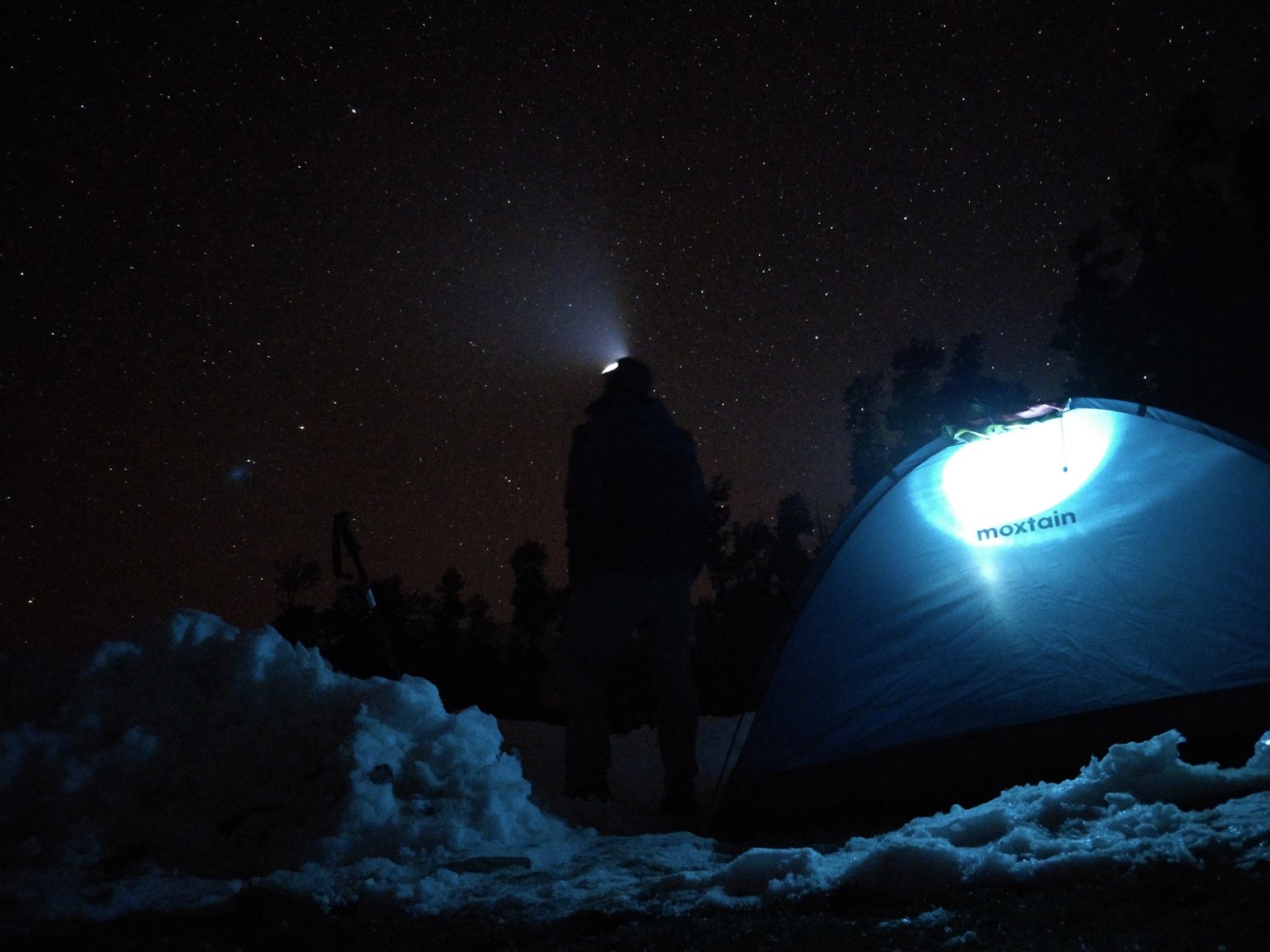
Day 1 : Arrival at Sankri From Dehradun
- Early start from Dehradun in the morning at 7:00 a.m.
- Altitude 6,400 feet.
- 210 km drive
- 10 hours of Travelling, Expected arrival time at Sankri – 5:00 pm.
- Accommodation and food in Guest House.
The drive from Dehradun to Sankri is an enchanting hill drive of 10-11 hour stretching over approx 210 Km ride via Mussoorie, Damta, Naugaon, Purola, Mori and Naitwar. A pick up will be arranged at Dehradun and the pick-up points and timings will be coordinated by email prior to your bookings of the trek. The booking excludes the lunch for the day and the transportation from Dehradun to Sankri. And from Sankri, we will be taking care of your fooding and lodging.
Day 2 : Start from Sankri to Juda ka Talab
- Altitude Gain From 6,400 feet to 9,100 feet.
- 4 kms Trekking
- 5 hours of Trekking
- Camping at Juda Ka Talab
- Accommodation & Food in tents.
Your second day will start with a chilled morning, locals doing their daily works, mules passing by and lots Himalayan Bhutia dogs trying to get friendly with you. Post breakfast trek starts from the local Sankri road entering into the local trails and then dissolving into the forest of broad leaves trees. The path goes through Saud village and it is a gentle climb. A lot of locals, mostly women and children will be seen on the way carrying wood and dried leaves for their cattle. Walking trails of this day will be steep sometimes and sometimes it will be levelled grounds with green and dense forests running alongside you. End of the day we will be setting up our campsites which is located near to Juda Ka Talab and is a closed camping site surrounded by tall pine and oak trees and mountain slopes. We will be reaching the campsites by afternoon and staying in camps enjoying the serenity scattered around this place with evening sunset and glittering sunrise in the morning.
Day 3 : Juda ka Talab to Kedarkantha Base Camp
- Altitude Gain From 9,100 feet to 11,250 feet.
- 2.5 hours of Trekking
- Camping at Kedarkantha Base Camp
We start post breakfast from JUDA KA TALAB and trek through the pine and oak trees to reach the open highlands below the summit. As you move forward into the forest suddenly at the end forest trails you start to see a wide meadow stretching in front of mighty Dhauladhar Ranges. This camping site has excellent picturesque views and is the main highlight of the trek. There are green pastures nearby and the views towards Himachal are unending. You can roam around this place easily and soak all the fresh tidings of nature's gift .We camp here for the night.
Day 4 : Kedarkantha base to Kedarkantha peak then descend to Hargaon
- Altitude gain from 11,250 feet to 12,500 feet, then descend to 8,900 feet
- 6 kms Trekking
- 7 hours of Trekking
- Reach the summit and then return to the base camp for lunch.
- After lunch, descend down to Hargaon.
- Reach Hargaon by evening.
- Accommodation & Food in tents.
It's a long day today as we are climbing on steep slopes from the west ridge of the mountain and then after reaching the summit, we return back to the basecamp and post lunch we move to Hargaon campsite. We will start early in the morning post breakfast and try to reach the top by the next morning to experience the sunrise. As we move forward slowly dense forest trails surrounding by Pine trees start to disappear. It's a rigorous and tiring uphill climb of over 2 hours but the scenic views around you will keep your adrenaline rush high in anticipation of the view from the top. At some point of this walk you will be awestruck by the 360-degree view and once everyone reaches the top, believe us it's a win-win situation for everyone. Panoramic views of mighty Himalayas range mixed with dark blue and white clouds scattered like a painting sketched by nature just for you. After spending some time on the top we head back to our campsite, have lunch at a mid point of the downwards journey from the basecamp and head towards Hargaon. Stay for the night in tents.
Day 5 : Hargaon camp to Sankri
- Altitude: 8,900 feet to 6,400 feet.
- 6 kms trek, approx 4 hours
- Descend 2500 feet through dense pine forests.
Today we will be heading towards Sankri from where it all started approximately 6 kms long trail counting about 4 hours. After breakfast, we will descend through a more marked well paved route, laden with stones. A trail further leading to a ridge from where you get a splendid view of Har ki Dun valley. And by the evening we reach Sankri. Small handmade goods, wooden toys and wooden home décor items can be bought from here. Local delicacies can be tasted here for a memorable experience. Overnight stay at the hotel.
Day 6 : Sankri to Dehradun
- 210 km drive, approx 10 hours.
- Travel Back From Sankri to Dehradun
- You will be dropped at Dehradun station in a pre-booked vehicle or cab.
We will be arranging a vehicle for you to drop at Dehradun.
Kedarkantha Trek
₹ 6999 /- ₹ 8499 /- (₹ 1500 off), payment secured by.

Talk to our Adventure Expert
Trek packages, kedarkantha trek ( 6 days / 5 nights ), trek highlights, trip length, aprox 20 km, max altitude, difficulty level, uttarakhand, pickup location, droplocation, start point, november to march, cancellation policy, health and saftey.
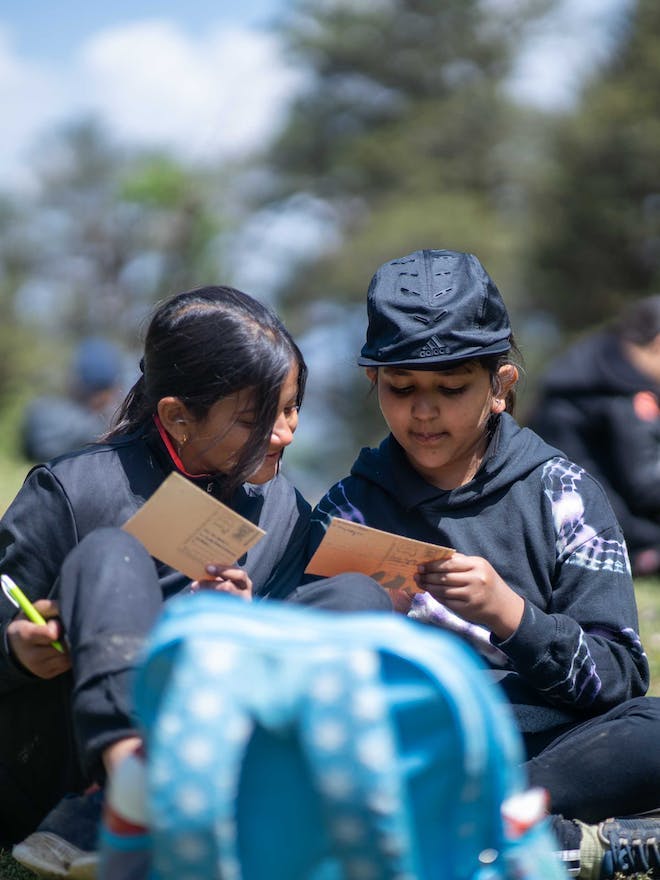
Kedarkantha Summer Camp
Adventure & Camping In The Himalayas For 10-14 Year Olds
Kedarkantha (not to be confused with the popular Temple Kedarnath) is in Govind Pashu Vihar National Park in Uttarakhand. Kedarkantha is easily one of the most popular treks in India — popular amongst seasoned trekkers and beginners alike.
There are many reasons why it is a very popular trek to do in the Indian Himalayas. The most important of them is this — the summit climb .
The summit climb of Kedarkantha is a very rewarding one. Right from the base camp of the trek, the summit looms large. As you start your trek in the early hours of the morning and steadily climb up the steep slope of snow, the world opens up around you.
The climb is not easy. The entire stretch is steadily steep. As you get closer to the summit, it gets tricky as well. But the big mountains of the upper Himalayas keep you company until you finally reach the summit.
As you stretch yourself and take in the views of the Himalayas from the summit, you feel a strong sense of satisfaction and accomplishment. This is an unparalleled feeling.
Very few treks offer the same adventure, making it popular among beginners for its finest summit climb.
Outside the summit, the trek is also unique for its beautiful clearings . Very rarely you will find stunning clearings on a trek that makes way for some rest spots and beautiful campsites . This trek is filled with clearings on all the different routes. What's more, the clearings are just at the right locations, giving you beautiful vantage points to appreciate the trek and its views.
The third biggest reason this trek is unique is its beautiful forests . All three routes have beautiful diverse forests that will immerse you. If you are not careful, you will get lost in them (in a good way).
Ever since Indiahikes explored and opened up Kedarkantha as a winter trek in 2011, many other organisers have followed suit. Having explored and trekked this route for over a decade, we know every nook and corner on the trail. Read more about this Untold story behind the trek that transformed Indian Trekking
Registering for the summer camp trek: Registering for a summer camp trek is slightly different from other treks. We are working on making the process easier for you; meanwhile, refer to these steps.
Complete Information on the Kedarkantha Summer Camp
We have always wanted trekkers to be well-informed before they go on a Himalayan trek. Knowledge is the difference between a safe trek and a dangerous one. It’s also the difference between a wholesome experience and a superficial experience.
Use this section to learn about the Kedarkantha trek. It has in-depth information about each day of the trek, what to expect, and how you need to prepare for it. Many years of expertise have gone into this content. Trekkers find that extremely useful.

Quick Itinerary
Get the summer camp itinerary

How Does Each Day Look
Complete day-wise guide
Kedarkantha Trek difficulty and safety
How we ensure children's safety

Packing List
Things you must take on the trek

Details of the Chaperone Service
Plan your child's travel

Frequently Asked Questions
Get your questions answered here
Kedarkantha Videos
Recommended Videos Before Going For The Trek
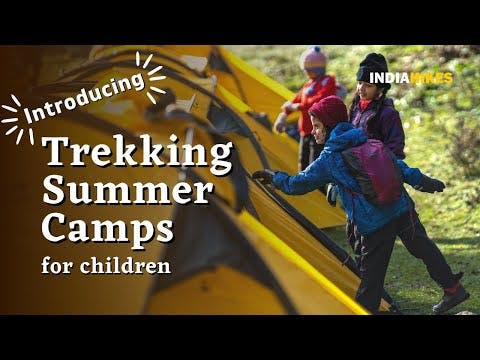
Photo Gallery
Summer Camp Photos
Trek Photos
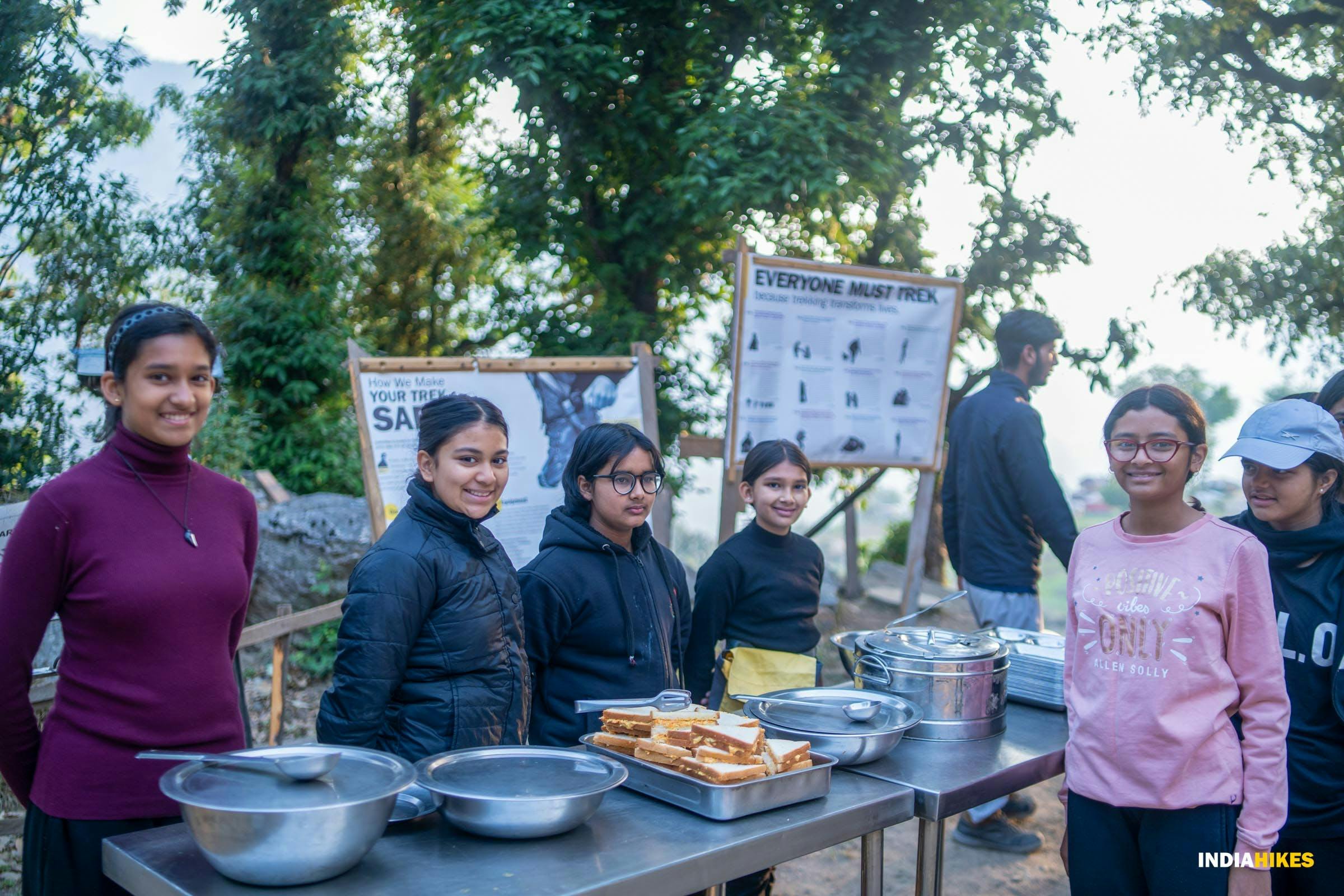
What Children Learn
- Trekking and camping skills
- Nature skills
- Sustainability skills
- Life skills and behaviours

Our summer camps are a mix of fun, adventure and learning. Through the course of the trek and the program design, children learn the basics of trekking, camping and wilderness survival.
- Building a shelter out of bare minimum resources
- First aid skills through mock drills
- Navigation skills using maps and GPS tools
- Skills to identify and set up campsites in the outdoors
- Cooking in the wild
- Learning to cross streams
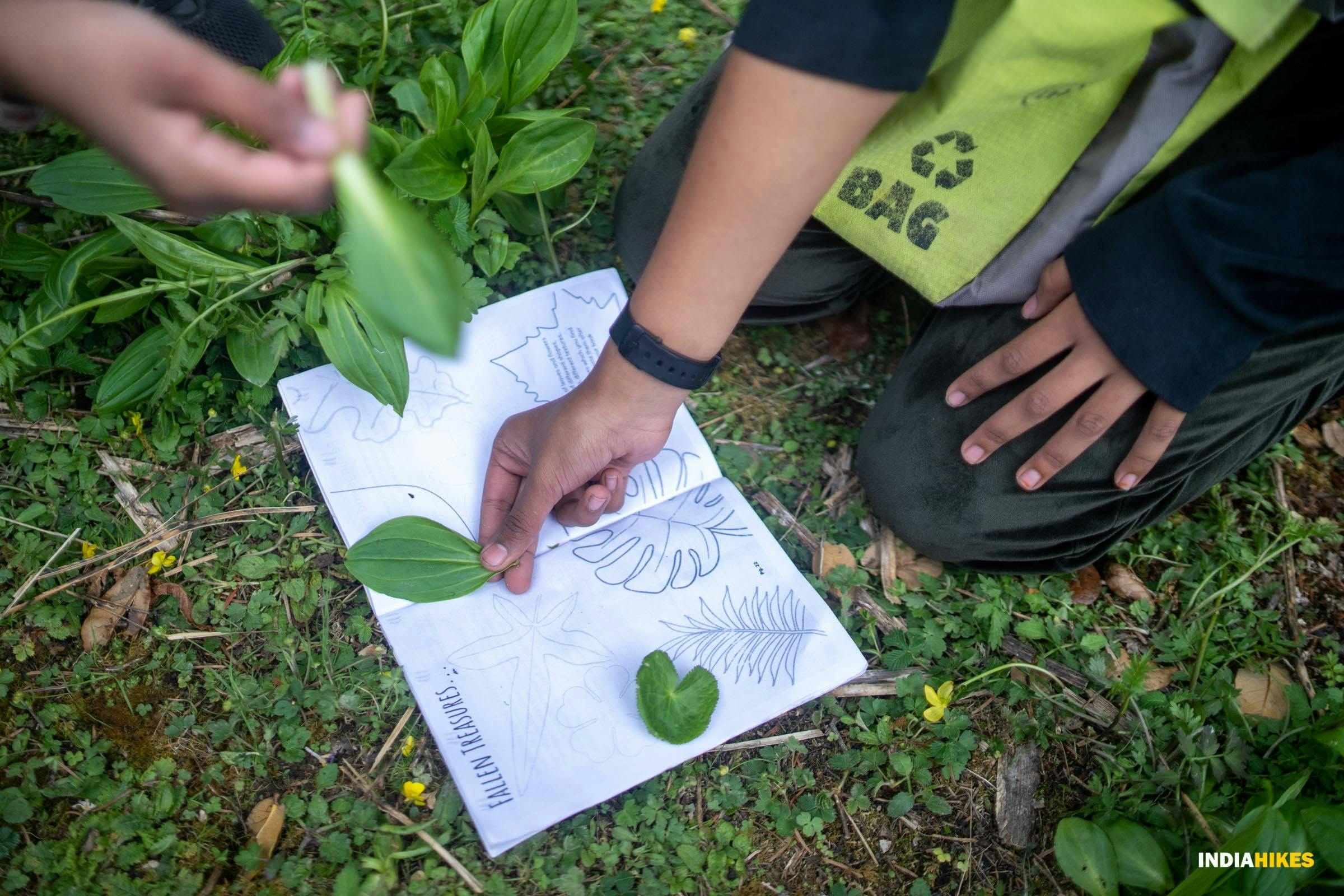
Given that children are in the heart of some of the richest biodiversity in our country, they learn first-hand about forests, plants, birdlife, animals and all natural elements around them.
- See and feel the rich biodiversity of Himalayan forests
- Learn about birdlife and animals endemic to the region
- Learn about the stars and the Milky Way by experiencing it in real-life
- Nature journaling
- Experiencing the forest
- Witness big Himalayan ranges at close quarters and learn the stories associated with them

At Indiahikes, we are very conscious about how we trek and how we treat the outdoors. There’s a certain spirit of trekking we believe in — a minimal and sustainable way of trekking. These are imparted by our Green Trails initiative, which inevitably has a big impact on children.
- Learn a minimal way of living by exploring lifestyles in remote villages in the foothills
- Clean trekking trails and leave mountains better
- Understand the importance of saving natural resources
- Learn the basics of waste management — segregating and composting waste
- Understand how to make composting toilets in the outdoors
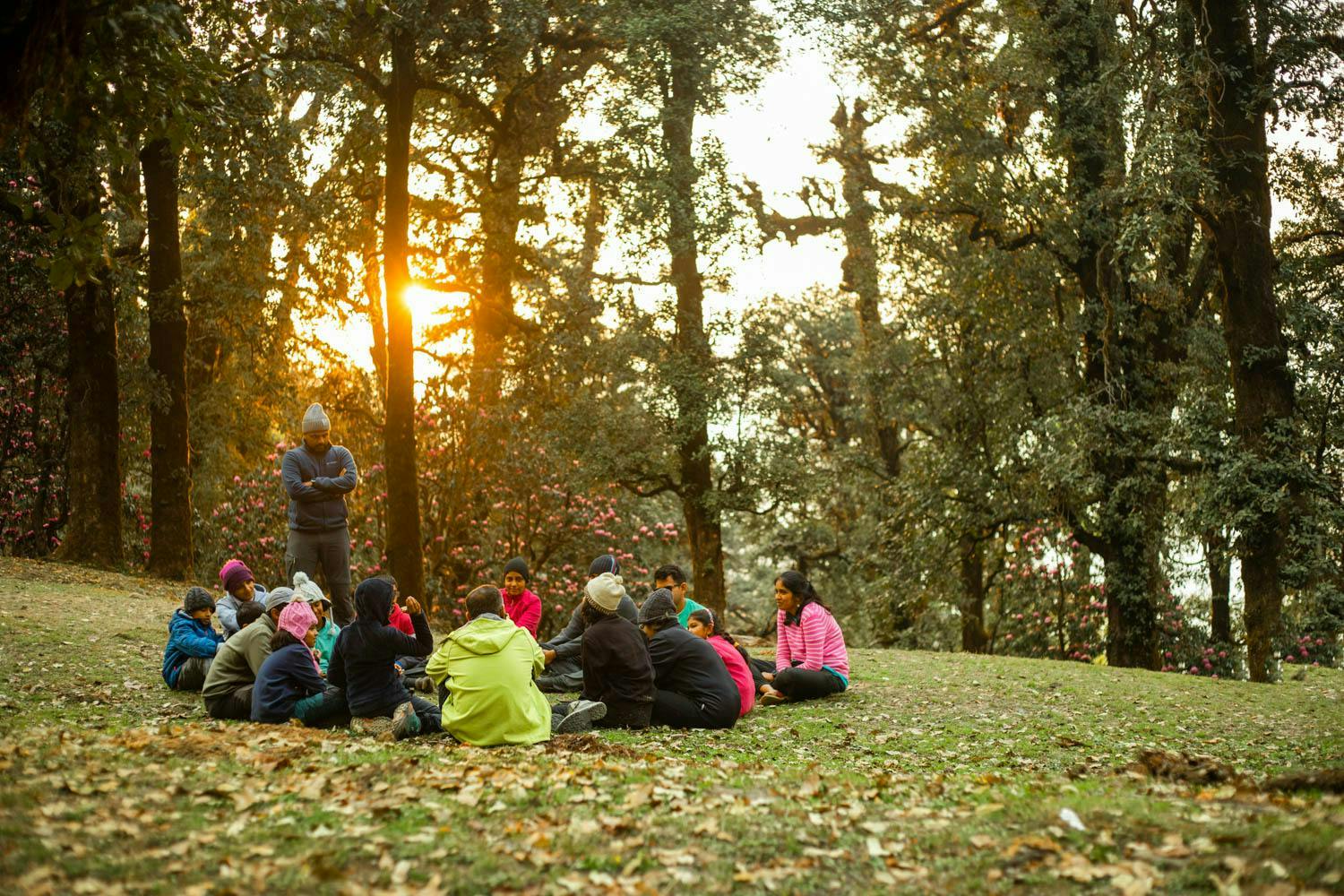
5 Reasons Why Indiahikes
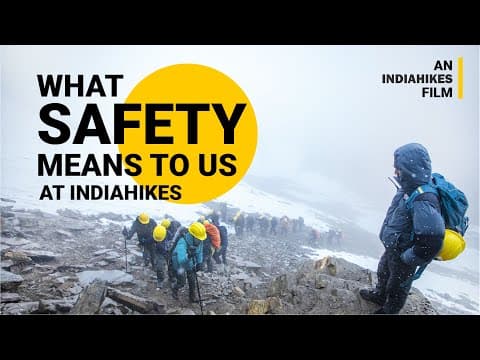
When we brought out new trails in Indian trekking, safety came with us. Back in 2012, we were the first to introduce microspikes, and two years later, pulse oximeters became standard thanks to us. Nobody does safe treks like Indiahikes. In the mountains, emergencies don't care who you're with – everyone knows that when trouble hits, you look for the yellow tents of Indiahikes.

We are pioneers in trekking. Since 2007, we have brought out treks that have become India's most famous treks: Roopkund, Rupin Pass, Buran Ghati, Kedarkantha, Kashmir Great Lakes, Tarsar Marsar, Brahmatal, Phulara Ridge—the list goes on. In 2023 alone, we brought out five new treks in Indian trekking. We know treks better than anyone . This comes directly from the reason why Indiahikes was born: to bring out trek information and enable trekkers to trek on their own.
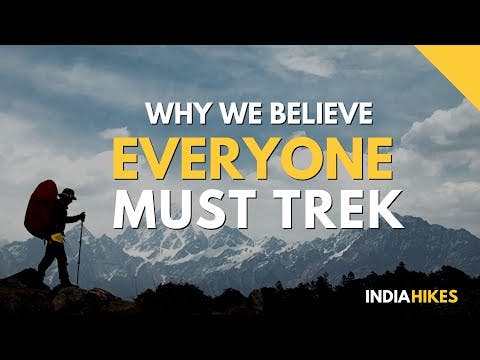
More than 25,000 people trek with us every year. We are the largest trekking organisation in India. 24% of our trekkers come back to trek with us every year. Over 4,000 students from the top educational institutions trek with us every year. Aside from this, families with children choose to trek with Indiahikes knowing that our treks are the safest. We have taken over 8000 children trekking so far, and the number continues to grow.
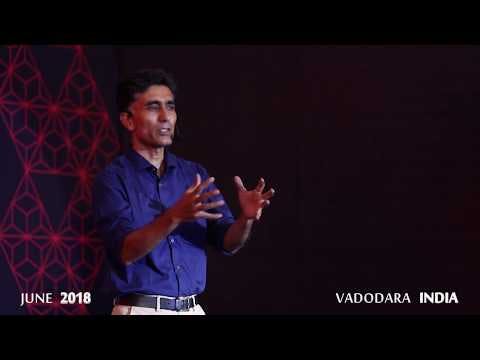
We focus on designing transformative experiences. Our trek leaders conduct thought-provoking exercises that help you reflect and contemplate. This impact stays with you for a long time. Trekkers return feeling energised, more confident, or developing abilities to deal with difficulties. Many have changed careers, rethought their core values, become more humble, shown gratitude to others, or started a new fitness journey.

Since 2012, we have pioneered sustainable practices that have become standard in trekking. Using eco-bags, our trekkers have cleared over 120 tonnes of litter from the mountains. We do not carry packaged foods; instead, we serve freshly made food. We do not light campfires; we carry coal to light angethis to keep you warm. Our bio-toilets not only keep our toilets odour-free but also enrich the soil. When you trek with us, you leave mountains better.
Indiahikes Features
You’re guarded with our trek again philosophy
If you are unable to complete a trek, or if you love a trek, you can repeat it with us anytime. You don’t have to pay us for it. See our thoughts behind this here .
Daily 3-time health checks keep you safe at any altitude
Our thrice-a-day oxi-metre checks keep altitude sickness at bay, never allowing you to reach a point where you need evacuation.
Join any group, they are all women-friendly groups
With around 30% of our trekkers being women, all women, including those travelling solo are comfortable to join any of our groups.
Request Jain/Vegan-friendly food
Our kitchen teams understand your needs as a vegan (or a Jain). We will take special care of your food, even in the remote Himalayas.
Be comfortable and sustainable with bio toilets
We have specially designed bio toilets to ensure you have no sight or smell in toilets, at the same time making sure the toilets cause no harm to the fragile ecosystem we trek in.
Fresh, nutritious food at every camp
We’ll admit it. Our love for food surpasses our love for minimalism. Expect freshly cooked, multi-cuisine food at all camps, designed to meet your nutritional requirements and keep your taste buds happy!
Other summer camp treks
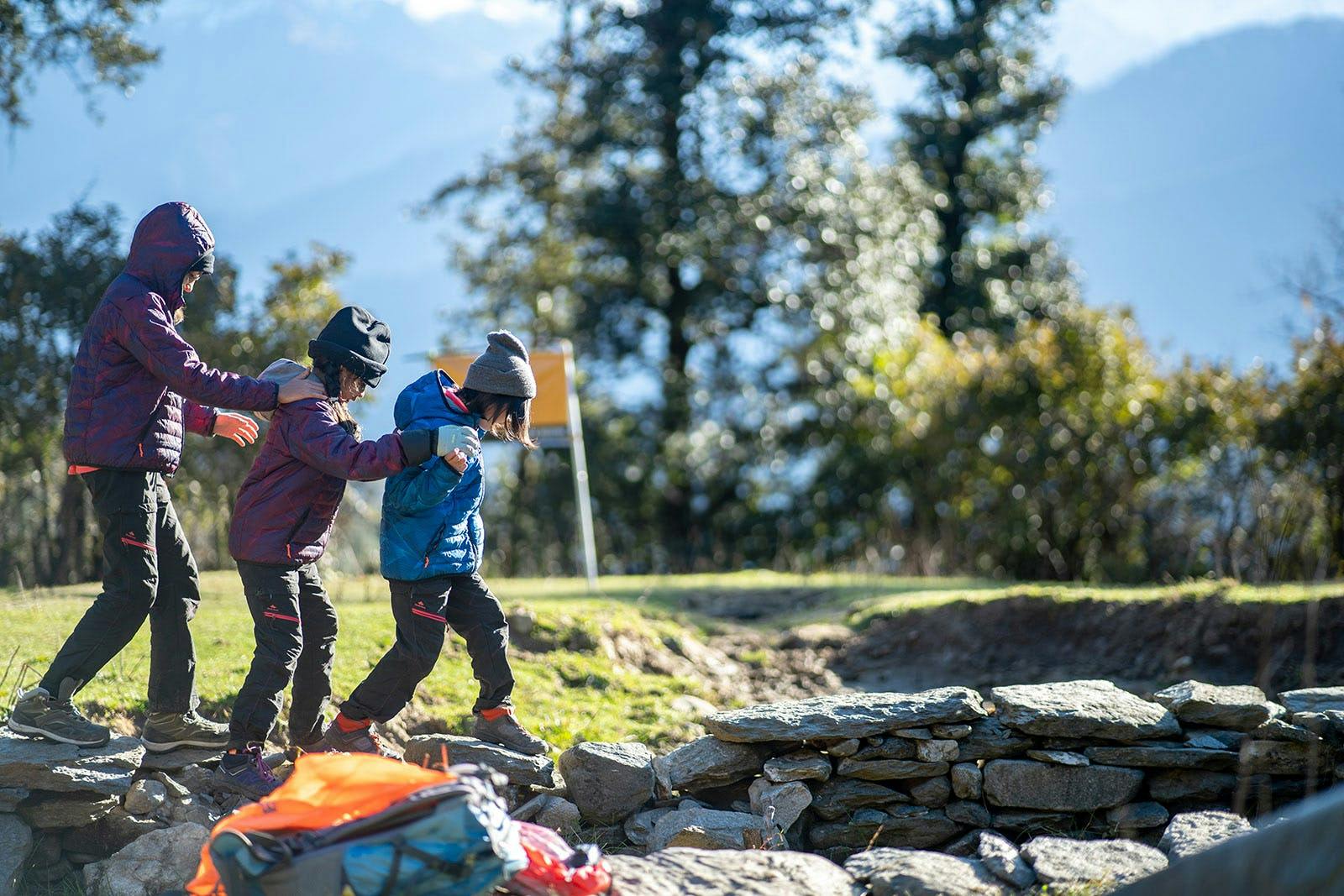
Easy-Moderate
Dayara Bugyal Summer Camp
Get Trek Info
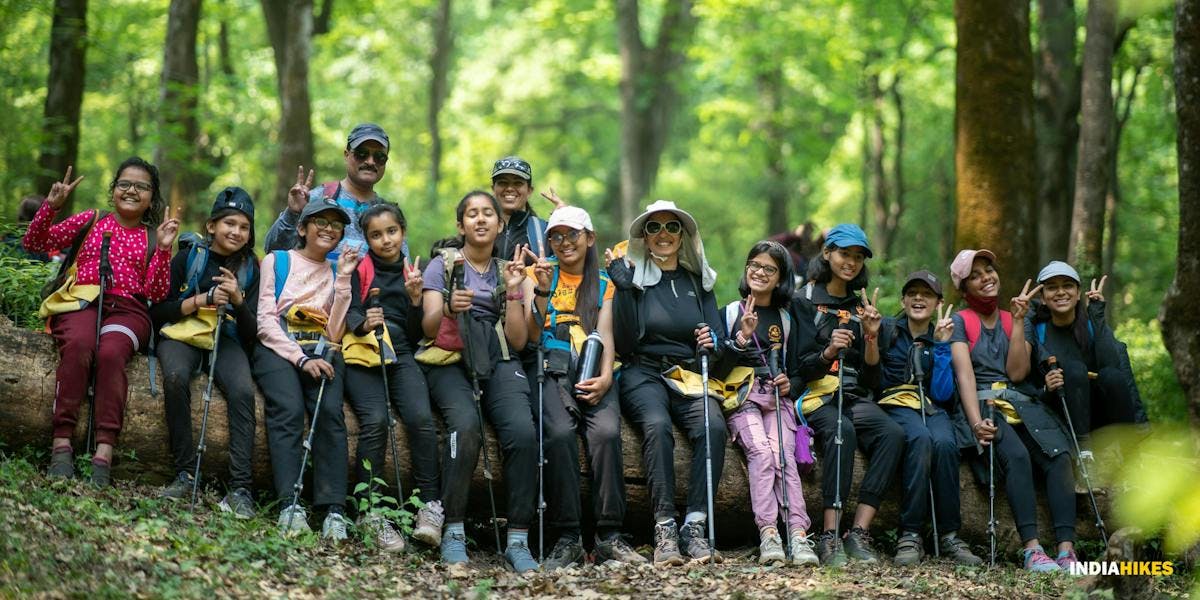
Youth Camp on Ali Bedni B...
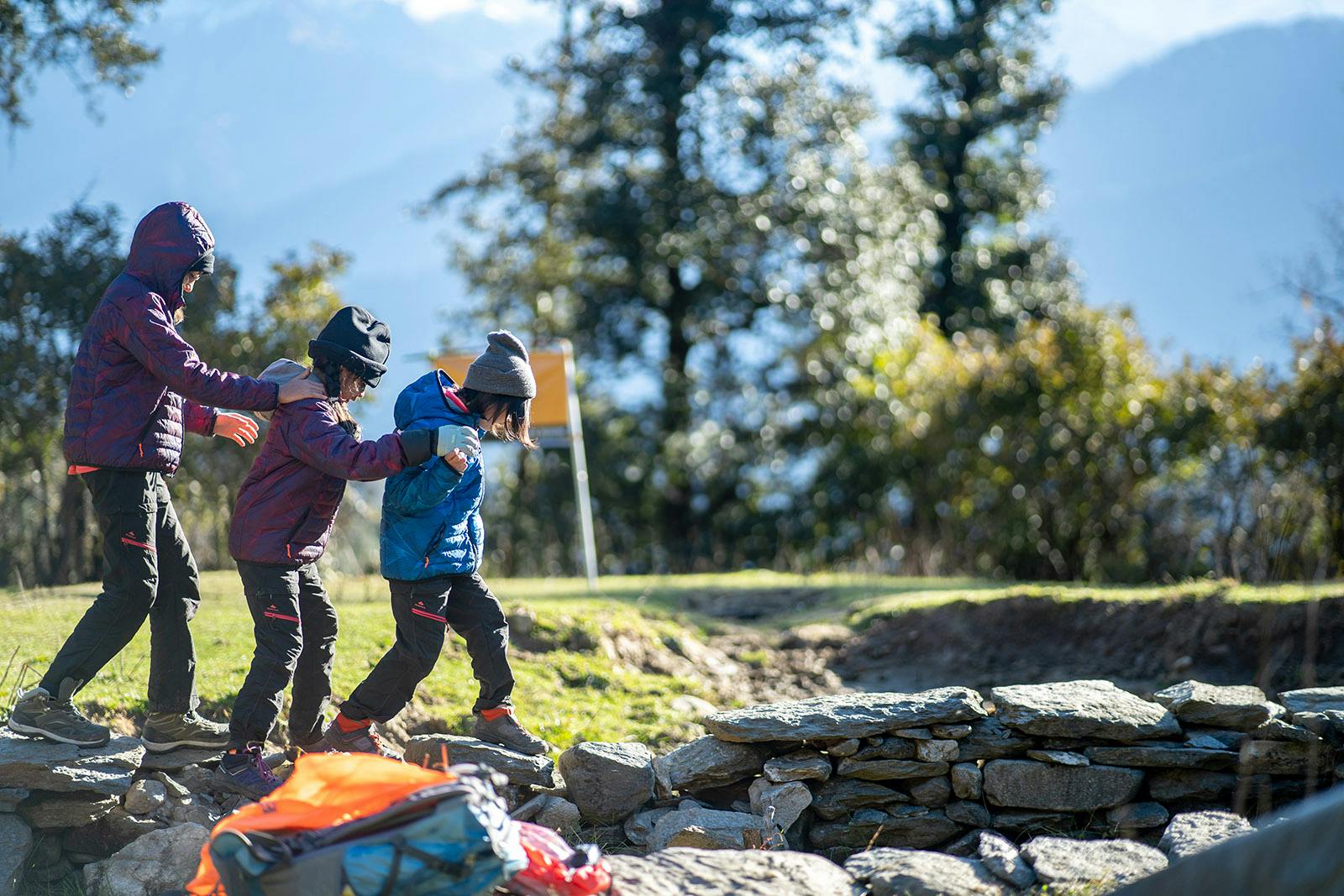
Dayara Bugyal Summer...
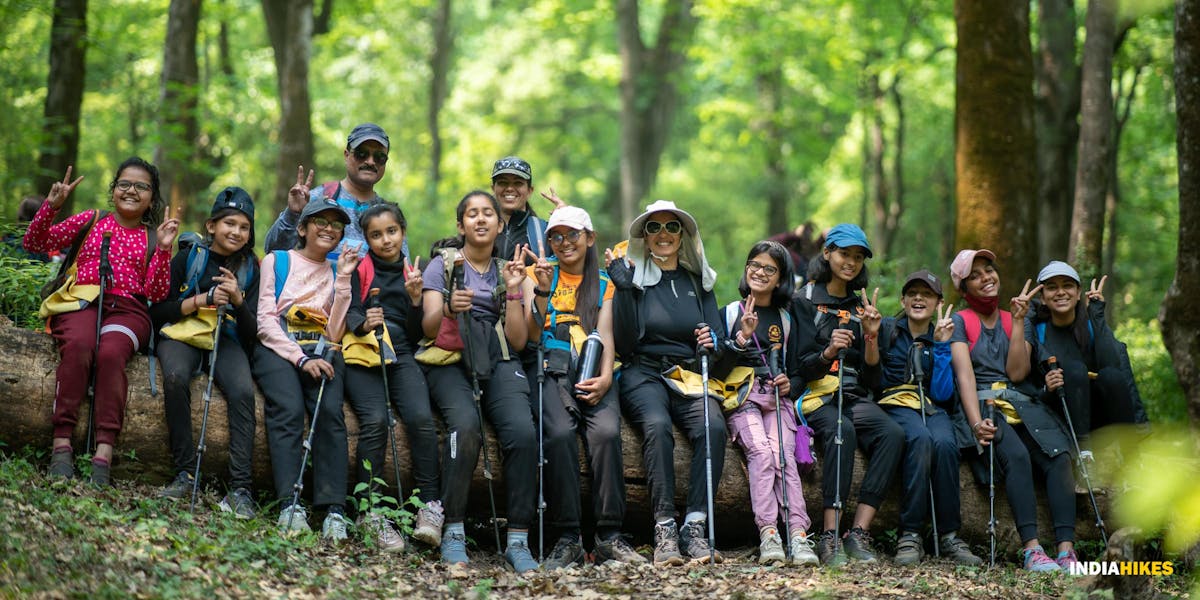
Youth Camp on Ali Be...
Adventure & Camping In The Himalayas For 15-16 Year Olds
Sign up for our much loved Weekly Mailer
We have terrific trekking tips, trek updates and trek talks to look forward to
Treks by Categories
Treks by season, treks by month, treks by duration, treks by difficulty.
- Easy - Moderate
- Moderate - Difficult
Treks by Region
- Uttarakhand
- Himachal Pradesh
- Lahaul and Spiti
- Jammu & Kashmir
- West Bengal
- Chhattisgarh
Treks by Experience
- Family Treks
- Stargazing Treks
- Senior Treks
- Adventure Therapy
- Summer Camps
- Youth Camps
- Cancellation policy
- Work with us
- Our sustainability practices
- Privacy Policy
- Terms & Conditions
080 468 01269 Mon to Sat - 9.30 AM to 7.30 PM Sun - 9.30 AM to 6.30 PM
Bengaluru Office
139, Defence Colony Road, Defence Layout, Sahakar Nagar, Bengaluru, Karnataka 560092
Dehradun Office
No.85/10, Neshvilla Road, Dehradun - 248001
© 2024 Indiahikes Private Limited
All images are copyrighted by their respective authors.

IMAGES
VIDEO
COMMENTS
Kedarkantha Trek Photos/images: Kedarkantha Trek is one of the most beautiful winter trek in Uttarakhand. It is a snuggly retreat beautifully concealed in the heart of Uttarakhand. Base Camp of Kedarkantha Trek 'Sankri' is famous for offering trekking and camping expeditions to the novice travellers, who like to taste the flavour of Himalayan air.
Kedarkantha Trek latest travel photos and image gallery with real pictures of Kedarkantha Trek, Kedarkantha Trek Places to see and activities photos. Browse through the best high quality Kedarkantha Trek images and photos to plan your trip. Kedarkantha Trek pics from professional photographers, tourists and Team eUttaranchal.
We are pioneers in trekking. Since 2007, we have brought out treks that have become India's most famous treks: Roopkund, Rupin Pass, Buran Ghati, Kedarkantha, Kashmir Great Lakes, Tarsar Marsar, Brahmatal, Phulara Ridge—the list goes on. In 2023 alone, we brought out five new treks in Indian trekking.
Every year, in the last week of December alone, thousands of trekkers flock to the Kedarkantha peak. What trekkers are missing out on is that the winter continues in January and February as well. In fact, the trek looks more beautiful and dreamy in these months compared to December. The trekkers who venture in the months of January and February ...
Kedarkantha Trek with Trek The Himalayas: Your Safest Adventure Partner in India with Award-Winning Excellence and 4.8 Google Rating over 5400 Reviews. ... You can click some beautiful pictures here and also take nature walks in the area. At night, a bonfire is a great idea to relish your dinner and warm drinks, chatting up with your fellow ...
The Kedarkantha Trek distance can vary depending on the specific route taken and the starting point of the trek. On average, the total trekking distance for the trek is around 20 to 24 km (12.5 to 15 miles) throughout 4 to 6 days, including both upward and downward. ... Kedarkantha Trek Photos:
The Kedarkantha trek is a paradise for trekkers and adventure enthusiasts in the Uttarkashi District of Uttarakhand state of India. With its awe-inspiring landscapes, pristine wilderness, and the opportunity to witness the raw beauty of the Himalayas, this trek has become a favorite among both beginners and seasoned trekkers.
The itinerary with distances and altitudes is: Day 1: Sankri to Juda Ka Tal - 4 km, 9,100 ft. Day 2: Juda Ka Tal to Hargaon Camp - 6 km, 8,950 ft. Day 3: Hargaon Camp to Juda Ka Taal - 6 km, 9,100 ft. Day 4: Juda Ka Tal to Kedarkantha Base - 4 km, 11,250 ft.
How difficult is the Kedarkantha Trek? Kedarkantha Trek is an easy to moderate-grade trek. However, embarking on the Kedarkantha trek in December or other winter months presents enthusiasts with a unique blend of adventure and challenges. While the trek is renowned for its accessibility to a wide range of trekkers, the winter conditions add an ...
The total Kedarkantha trek distance is around 25km. The kedarkantha trek route is easy and just as breathtaking, the trail that this trek has is usually most meant for hardcore trekkers but Kedarkantha is an exception. With the Kedarkantha trek, you can experience an adventure like no other with a thrilling summit climb in a frozen fairyland ...
Previous123456Next. Download and use 300+ Kedarkantha Trek stock photos for free. Thousands of new images every day Completely Free to Use High-quality videos and images from Pexels.
Kedarkantha Trek Duration: 4 days (Sankri - Sankri) Best Season for Kedarkantha Trek: December to April; The Kedarkantha trek starts from the quaint village of Sankri in Uttarakhand located at a height of 6,000 feet. With panoramic views of snow-clad peaks almost all throughout the trail, the Kedarkantha trek takes one through dense pine and ...
This trek is primarily a classic winter adventure, with the best months to travel spanning from December to February. The period from mid-January till mid-February offers peak snowfall. Despite being promoted as an easy-to-moderate trek for beginners, it poses a moderate to high difficulty, reaching an altitude of 12,000 feet.
Delhi to Sankri by road. By Public Transport. Suggested Itinerary for the Kedarkantha Trek. DAY 0 - Starting off. DAY 1 - Reaching Sankri. Day 2 - Sankri to Juda ka Talab. Day 3 - Juda ka Talab to Kedarkantha Base camp. Day 4 - Kedarkantha Base to Summit; back to Hargaon campsite. Day 5: Hargaon to Sankri.
Kedarkantha - Feel the Bliss of Lord Shiva. At a towering height of 3800 meters, Kedarkantha is a majestic peak located in Govind Wildlife Sanctuary of Uttarkashi district in Uttarakhand.Dedicated to Lord Shiva, Kedarkantha is one of the most popular treks in Uttarakhand due to its relative ease of access and gradual inclination. Kedarkantha trek gives you the unsurpassed beauty, magnificent ...
Day 03: Shepherd Camp (2900m) - Base Camp Kedarkantha (3400m, Trek/5 Hrs) Start early and take in the magnificent sunrise. After a delicious breakfast, we will begin our trek to the Kedarkantha foundation, which is located at an elevation of 11,250 feet. With sufficient breaks, the trek should take about 4-5 hours to complete.
Experience the thrill of summiting the Kedarkantha peak in Uttarakhand, one of the most popular trekking destinations in India. This beginner-friendly summit trek stretches over 20 km across 5 days, and offers glorious 360-degree views of the Swargarohini, Bandarpoonch, Black peak, Ranglana, and Kalanag. The Kedarkantha Base Camp provides lovely 180-degree views of the snow-capped ranges while ...
Take the best Kedarkantha trek photos and share the experience with your loved ones. The Kedarkantha trek difficulty level is suitable for all age groups (considering people with no minimal health issues.) Kedarkantha Trek Days spans 6, including travel to and from Delhi.This allows trekkers to acclimate gradually to the increasing altitude and enjoy the journey comfortably.
Kedarkantha Trek. Located in Govind Pashu Vihar National Park in Uttarakhand, the Kedarkantha trek is a 6-day journey that attracts both skilled trekkers and beginners. The expedition can be changed to last for six days, including travelling days from Dehradun to the base camp and back. Kedarkantha is a popular and beloved trekking destination ...
All this is better explained with some photos, so allow me to take you on a journey and show you why Kedarkantha is one of the most loved winter summit treks in the country. Day 1: Gradual ascend and LOTS of snow . The starting point of the trek is a charming little village called Sankri. Life goes on at a different pace here.
After seeing the beautiful photos and reading about the trek, we decided to book Kedarkantha Trek for early march. We booked with Trek The Himalayas for the 7th March 2020 batch. Prepping for the Trek: Since this was my first winter trek, I had to buy a lot of stuff as the weather in the mountains is quite unpredictable. Decathlon is a one-stop ...
Located at an elevation of 11,250 feet, Kedarkantha base camp is the second campsite in the Kedarkantha trekking trail. From Kedarkantha base camp, you take a challenging uphill trek of 3 km to reach the Kedarkantha summit located at an elevation of 12,500 feet. The 360-degree view of colossal mountain ranges from the Kedarkantha summit leaves ...
Since 2007, we have brought out treks that have become India's most famous treks: Roopkund, Rupin Pass, Buran Ghati, Kedarkantha, Kashmir Great Lakes, Tarsar Marsar, Brahmatal, Phulara Ridge—the list goes on. In 2023 alone, we brought out five new treks in Indian trekking. We know treks better than anyone. This comes directly from the reason ...